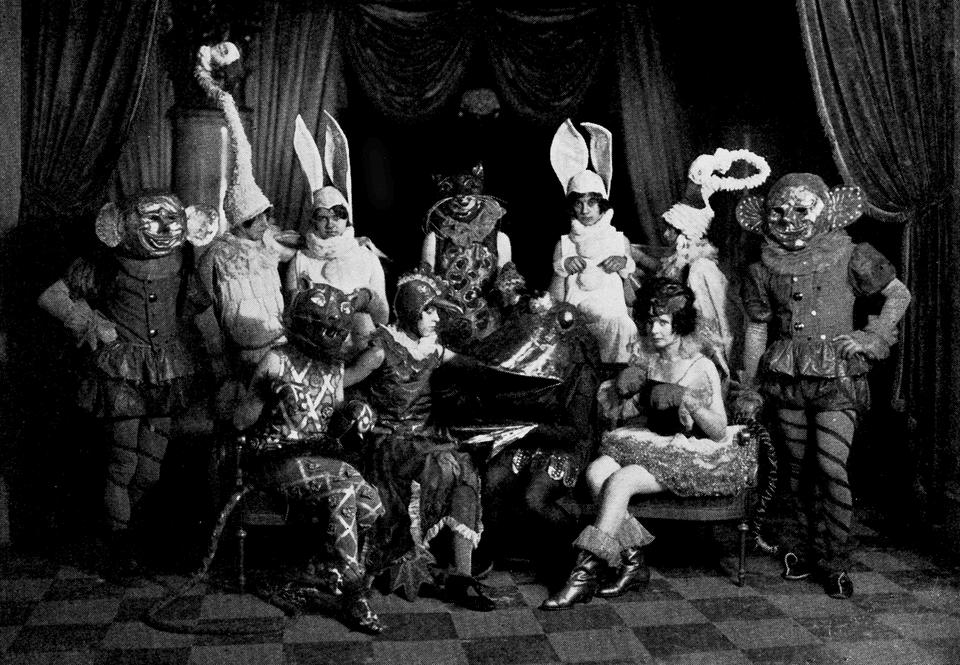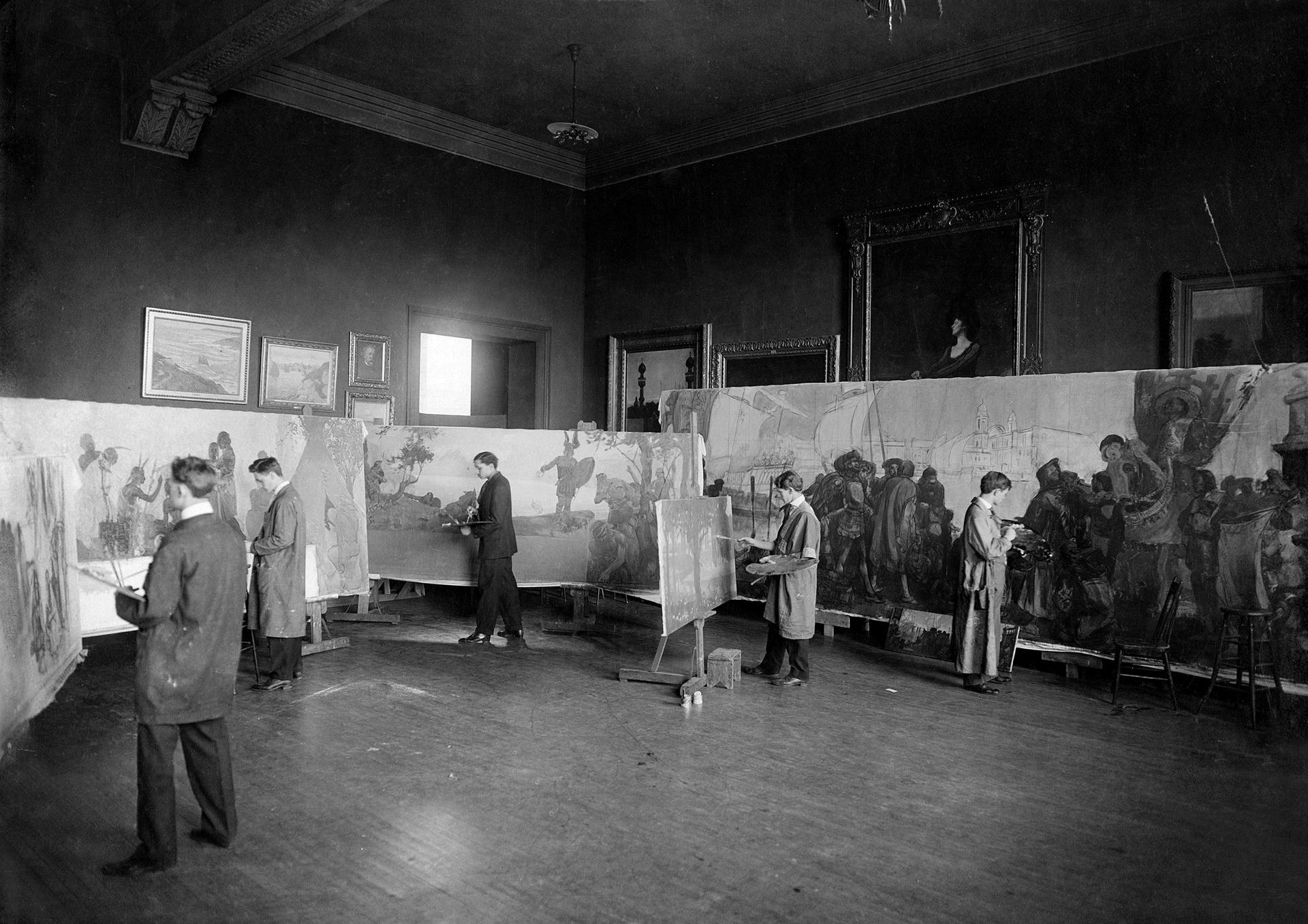

MASTER CLASS
Inside the Last American Museum School with SAIC Alumni
April 19- June 21, 2025
Co-Curated with Lisa Wainwright and Elissa Tenny
Essays by Lisa Wainwright and Michelle Grabner with contributed writing by:
Giovanni Aloi, Carol Becker, Ionit Behar, Silvia Beltrametti, Jeremy Biles, Steven Bridges, Romi Crawford, James Elkins, Eileen
Favorite, Brian Leahy, Margaret MacNamidhe, Matt Morris, Allison Peters Quinn, Daniel Ricardo Quiles, Patrick Lynn Rivers, Pia Singh, Francesca Wilcott, Mechtild Wildrich, David Raskin, Barbarita Polster and John Yau
Photography by Nathan Keay

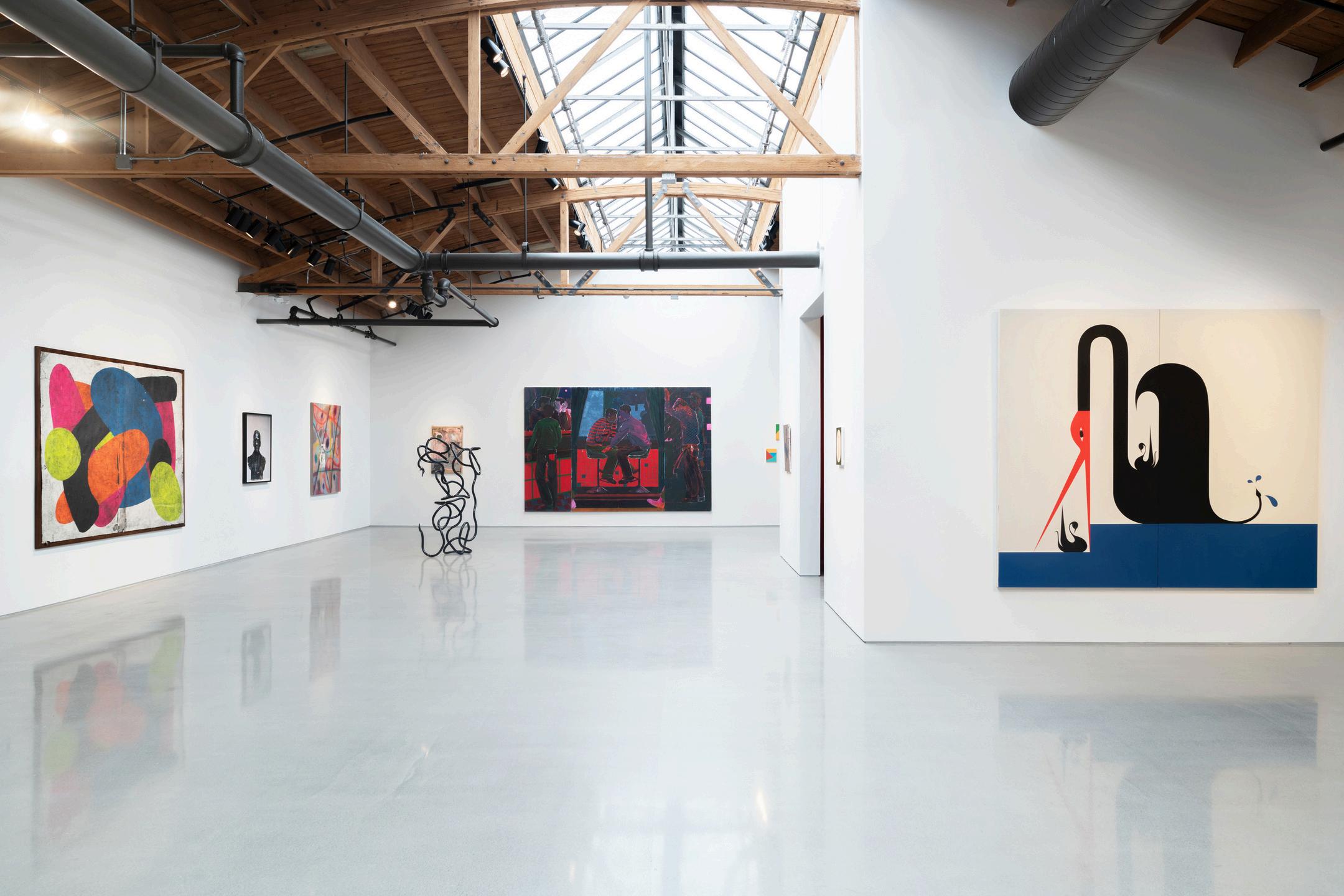



Lindsay Adams MFA ‘25
Noelle Africh MFA ‘22
Luke Agada MFA ‘24
Alberto Aguilar MFA ‘01
Latifa Alajlan MFA ‘23
Cecilia Beaven MFA ‘19
Aviv Benn MFA ‘18
Samantha Bittman MFA ‘10
Elijah Burgher MFA ‘04
Robert Burnier MFA ‘16
Nik Cho BFA ‘22, MFA ‘24
Alex Bradley Cohen BFA ‘14
Jeane Cohen MFA ‘18
Paula Crown MFA ‘12
Chelsea Culprit BFA ‘07
Tavin Davis MFA ‘23
Dana DeGiulio MFA ’07
Austin Eddy BFA ‘10
Stephen Eichhorn BFA ‘06
Peter Fagundo MFA ‘02
Nicola Florimbi MFA ‘24
Howard Fonda MFA ‘01
Jae Ford MFA ‘16
Jonathan Gardner MFA ‘10
Magalie Guérin MFA ‘11
Antonia Gurkovksa MFA ‘11
Efrat Hakimi MFA ‘19
Andrew Holmquist BFA ‘08, MFA ‘14
Mika Horibuchi BFA ‘22
Patrick Dean Hubbell MFA ‘21
Steven Husby MFA ‘03
Omair Hussain BFA ‘18, MFA ‘25
G.D. Johnson MFA ‘25
James Kao MFA ‘06
Em Kettner MFA ‘14
Minami Kobayashi MFA ‘18
Meredith Kopelman Post-Bacc ‘20, MFA ‘22
David Leggett MFA ‘20
Tony Lewis BFA ‘10, MFA ‘12
MJ Lounsberry MFA ‘23
Wangari Mathenge MFA ‘21
Kristoffer McAfee BFA ‘20
Rodney McMillian Post-Bacc ‘00
Isabella Mellado MFA ‘23
Emily Miller MFA ‘25
Jeffly Gabriela Molina MFA ‘16
Aliza Nisenbaum MFA ‘05
Angel Otero BFA ‘07, MFA ‘09
Ruth Poor MFA ‘22
Kaveri Raina MFA ‘16
Pedro Trueba Ramírez MFA ‘25
Autumn Ramsey BFA ‘05, MFA ‘13
Celeste Rapone MFA ‘13
Josh Reames MFA ‘12
Clare Rojas MFA ‘02
Sterling Ruby BFA ‘02
Charlotte Saylor MFA ‘25
Claire Sherman MFA ‘05
Sumakshi Singh MFA ‘03
Cameron Spratley MFA ‘21
Keer Tanchak MFA ‘03
Sebastian Thomas MFA ‘23
Alice Tippit MFA ‘13
Orkideh Torabi MFA ‘16
Cody Tumblin BFA ‘13
Omar Velázquez MFA ‘16
Jonathan Worcester MFA ‘24
Hiejin Yoo BFA ‘14, Post-Bacc ‘15
Molly Zuckerman-Hartung MFA ’07
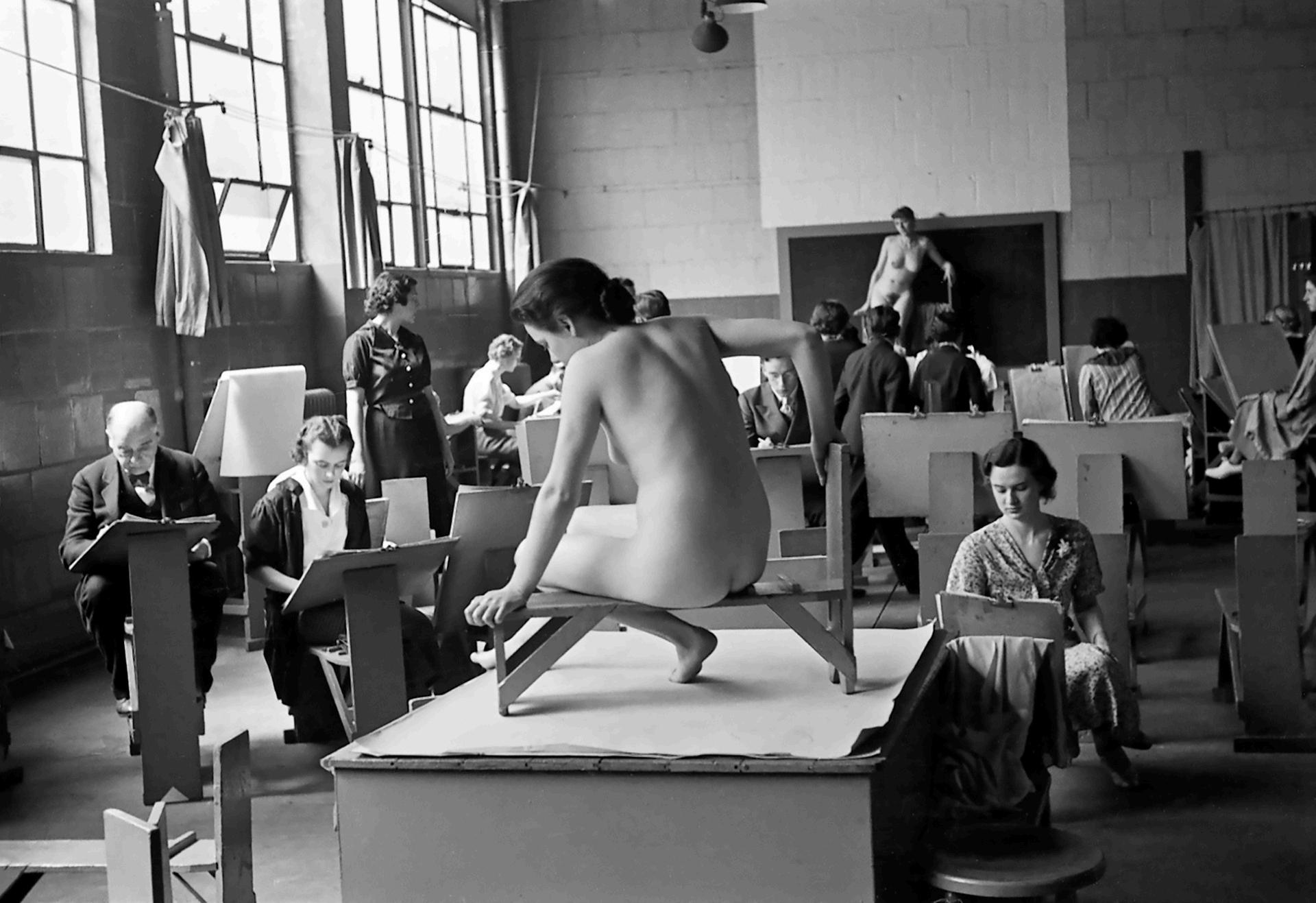
Home Court Advantage
by Lisa Wainwright
“Power in art is not like that in a nation or in big business. A picture never changed the price of eggs. But a picture can change our dreams; and pictures may in time clarify our values. The power of artists is precisely the influence they wield over the fantasies of their public.”
Alan Kaprow, 1953
It is not commonly understood that the founding of the Art Institute of Chicago was hatched by a small band of resourceful artists in 1866. When 35 painters and sculptors met at the Reynold’s Block building on Dearborn and Madison streets to found the Chicago Academy of Design, their mandate was to create “ a free school of ‘life’ and ‘antique’ drawing and to run a gallery that

would sponsor literary, musical, and dramatic events.” Tragically, the Academy’s first building at Adams and State: its classrooms, galleries of paintings, and hundreds of plaster casts for copying, were destroyed by the infamous Chicago fire of 1871 But three years later, in 1874, the school was back up and running in different digs, and by 1879 with support from a new board of trustees, and a seemingly grander set of aspirations, the institution renamed itself the Chicago Academy of Fine Arts. In 1882, the name was again changed to what we all fondly recognize as the Art Institute of Chicago. As programs
developed and the galleries grew, the school and the burgeoning museum were so intertwined that by the late 19th century into the early 20th, the first few Deans of the School simultaneously held positions as Directors of the Museum. And ever since this propitious beginning, the museum and the school have been linked by the shared civic vision emblazoned on our earliest logo, Artem Fovemus: “Let us encourage the Arts.” This founding legacy, the proposition that creating the new while dialoguing with the past, an idea initiated by artists, continues to inform all who study in our studio/museum spaces Master Class: Inside the Last American Museum School with SAIC Painting Alumni showcases the results of such an exceptional model of learning, of how rooting in the visual, material, and physical arena of a museum collection is to learn one ’ s practice from an array of eminent teachers across time and place
The School of the Art Institute of Chicago is the only remaining museum school in North America, where the proximity of making to great works of art is our pedagogical lodestar. The SAIC Painting and Drawing Department, in particular, thrives in this milieu, as the riches of world-class paintings are just down the hall from our studio classrooms This geography is our home court advantage, that our artists behold great works of art while studying their métier They know the playing field well The 69 artists in "Master Class" reveal many variations of contemporary painting expressions, but all are grounded in a remarkable history of art and art instruction that only a museum school affords
All the major genres of painting parade through Master Class with landscapes, still-lives, figurative works, and abstractions a testament to the inexorable examination of our human condition represented in the museum ’ s rich holdings. Slippages between genres are in evidence as well, for the show illustrates an admixture of styles and subjects that continue to reflect the nature of our pluralistic tendencies in contemporary art since the 1970s (if not before). And painting’s obsession with the interplay of representation and abstraction in the same field abounds. There’s both gestural and hard-edge abstraction here, expressive handling of paint, of the body and the gut, as well as exacting congregations of crisp shapes that offer up myriad formal plays. In the former, we seem to dip into aura, sentiment, or a turn towards authenticity in defiance of this age of digital numbing. This affect also describes some of the abundant figurative work in the show with almost half of the exhibition given over to figuration. The intensity of identity politics that captured the attention of the art world is still in play, albeit less formulaic Interiority, if not alienation, seems to drive these representations which makes more and more sense as the world drifts into terrifying socio-political terrain Similarly, Surrealism has a strong foothold here, as if the real is now so fractured by disinformation and untruths that fantasy becomes our only lingua franca Chicago is also home to important collections of Surrealist art and the museum is renowned for its key holdings in this area It is therefore no surprise that for those who studied in its galleries, the example of Surrealism, with its strange correspondences of motifs and ideas, seeped into these artists’ thinking and into the work.
While the “ museum as muse ” is a longstanding paradigm for artists and a conceit Kynaston McShine entertained in his exhibition of the same name at MOMA in 1999, the School of the Art Institute of Chicago’s homecourt advantage is its ability to put this concept squarely at the center of its operations. As such, each of the artists in Master Class was asked to identify a work from the Art Institute collection that inspired, informed or has affinities with their work. In the artists’ selections, the OGs of modernism or their precursors dominate: Turner, Bonnard, Monet, Degas, Gauguin, Seurat, Matisse, Miro, and O’Keeffe appear (interestingly O’Keeffe for three artists) And there are the heavy hitters of the 1950s: Pollock, de Kooning, Mitchell, Katz, and Rauschenberg How curious that along with the de-centering of the canon in our recent efforts towards diversity, the avant-garde moves of these famous painters still beckon, even for the BIPOC artists in the show, many of whom chose canonical works Luke Agada’s Unstill Life (Elegy in Blue), 2025 tracks back to his selection of Arshille Gorky’s elegiac The Plow and the Song, 1946, another immigrant story, for Agada left Ethopia while Gorky fled Armenia Both convey unstable presences through biomorphic forms that slither into just the edge of being Omair Hussain’s
Hussain’s bold abstraction, Untitled, 2024, more commanding than would be indicated by its modest scale, curiously takes its cue from the palette of Jackson Pollock’s The Key of 1943. Pollock’s break with Renaissance perspective through a cubist, then surrealist detour speaks to Hussain’s perceptual plays, but Pollock’s content is emptied out here, a source of freedom, I imagine, Hussain thoroughly enjoys The Art Institute’s magnificent collection of Monet landscapes spoke to Lindsay Adams in her work, A thousand lights of sun, 2025, albeit Adams’s spaces often arise from musings on Black historical sites, rather than the sheer light and color afforded by Monet’s pleasant gardens; even so, both beautifully capture ephemeral traces of time Finally, the queer eye of Elijah Burgher’s Head of Orpheus, 2025 finds strange resonance in
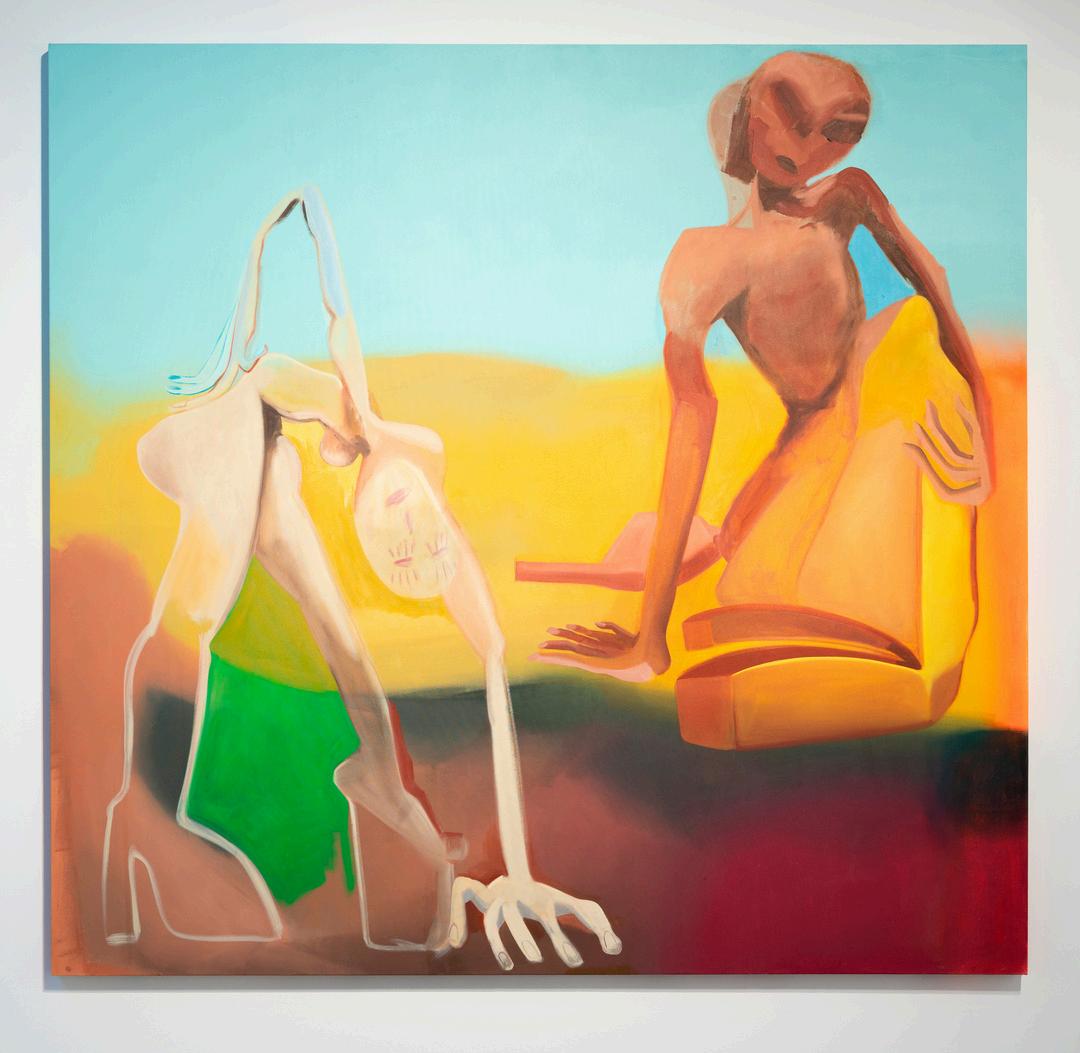
operations, or that the museum institution itself has been a periodical turn-off for activist student-artists (let us recall that “Monsieur Matisse” was burned in effigy on the front steps of the museum in 1913), we have seen a return to the museum and to modernism, in particular, given the rapid stylistic advances of this period that forever changed painting and still informs makers today In our age of fulsome appropriation, imitation and copying, the museum remains a stalwart source.
So, if only we could hang Chelsea Culprit’s Devil's Garden Escalante, 2023 back in the museum ’ s gallery next to his choice of Paul Gauguin’s The Day of the Gods from 1894 Both deploy the water’s surface as an opportunity for indulging in decorative shapes and patterns, and the languid, nude figures signal the simmering eroticism in which both artists traffic But again, it is a symptom of this moment, that Gauguin, an artist who goes in and out of fashion in the academy given his objectification of non-Western women and, frankly, girls, is here recognized as an important source “Love the art, hate the artist,” seems to be a workable theme these days, and the Art Institute has such a huge collection of gorgeous Gauguins that his imprint on our painters has been and continues to be inevitable. Notwithstanding the idea that modernism emerged, in part, from a series of colonial
her choice of the small Edgar Degas’ The Star, 1879-1881, for I want to compare their performing bodies, their similarly gesturing limbs and cocked heads. In Culprit’s hands, there’s more aggressive contortion as if she seeks to expose the true manipulation of the female form by so many male artists before her. The fluttering, sweet, pastel scopophilia of Degas’s ballerinas gives
gives way to a stark feminist reprisal here. And while we are at it, let’s place Peter Fagundo’s Bone Machine, 2024 up in the museum too, next to his selection of Henri Matisse’s Bathers by a River, 1909–17. Fagundo’s commingling of tropes a grisaille rectangle of a soft-porn image inserted into the middle of a colorful abstraction serves up that postmodern gambit where pictorial dissonance echoes the delusional nature of our oversaturated semiosphere Matisse also situates bodies against abstracted grounds, with a similar atemporal effect, for one
of modernism’s subjects was a rapidly changing world. And why can’t we put Minami Kobayashi’s In a room on a high floor, 2024 next to Pierre Bonnard’s Earthly Paradise, 1916-20. It would be so easy on the eyes to move from Bonnard’s landscape of delicious hues and sensual shapes over to Kobayashi’s similar expanses of lovingly painted surfaces and bucolic charm Finally, Hopper’s iconic painting of The Nighthawks 1942 would be wonderfully renewed by hanging Wangari Mathenge’s Our Time, 2024 next to it Mathenge’s close-up of a resting figure rendered in the exact palette as Hopper’s, exudes the same elegiac loneliness that haunted those figures sitting quietly at the counter in Hopper’s night painting nearly 100 years before.
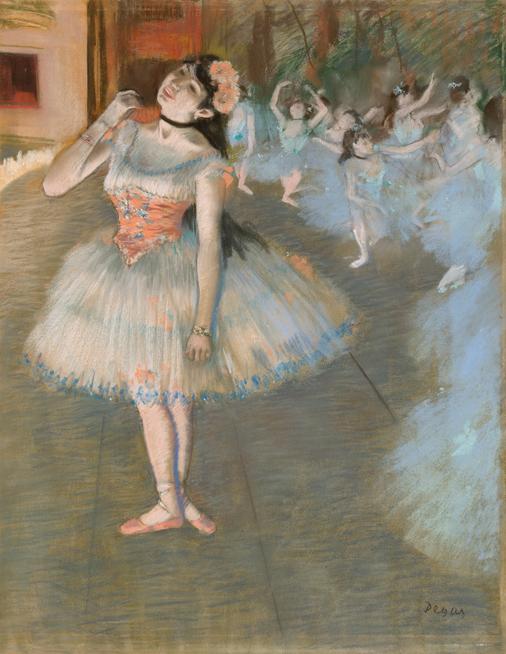
The ease at which the museum examples resurface in many of these artists’ works in Master Class says something about the power of the museum as a repository of sustaining sustaining knowledge Indeed, some of the chosen pairings by the artists are quite direct, as if the significance of the original bears repeating. Sebastian Thomas borrows the format of decorated medieval panels from the Art Institute’s Retable and Frontal of the Life of Christ and the Virgin, 1396 for his playfully heraldic piece, The Nocturne Knights II, 2024. Omar Velásquez lifts the iconic rock straight out of Georgia O’Keeffe’s Black Rock with Blue Sky and White Clouds, 1972 to rest amidst his rebus of surrealist motifs in Ocaso, 2024. Mika Horibuchi Curtain Drawn III, 2018 is a copy of Adriaen van der Spelt and Frans van Mieris’ Trompe-l’Oeil Still Life with a Flower Garland and a Curtain, 1658, only she isolates the mysterious curtain that had framed the original floral scene in a virtuosic display of illusionism. Howard Fonda’s rhythmically patterned surface is also a still-life composite of the Art Institute’s Ming dynasty vase (1368–1644), the Sorrowing Virgin (c 1490) painted by the workshop of Dieric Bouts, an 1864 seascape by Édouard Manet, and a striped, aubergine-colored bit of wallpaper (c 1915) by the Austrian designer Dagobert Peche together a kind of democratizing effort in the manner of André Malraux’s “ museum without walls ” And Patrick Dean Hubbell points to a Navajo rug from 1800–1890, in his deconstructed 6
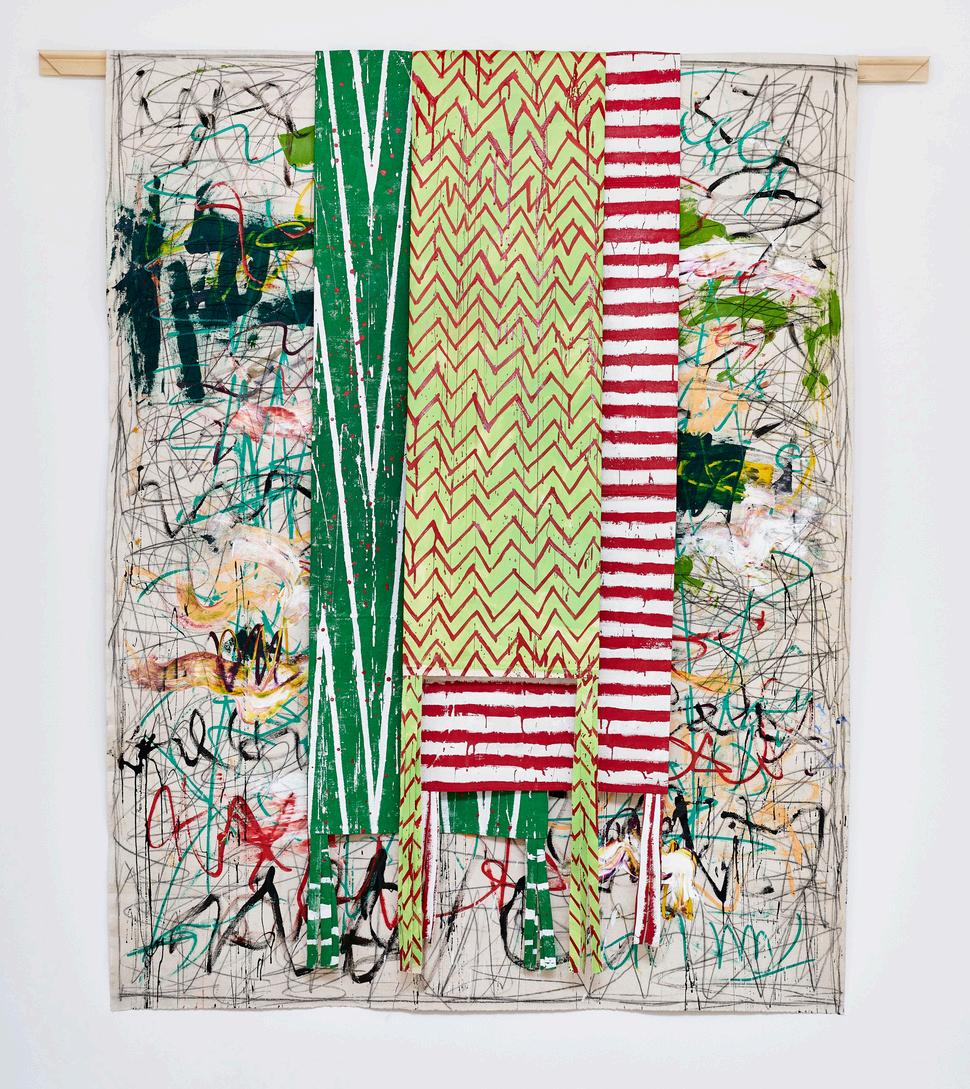
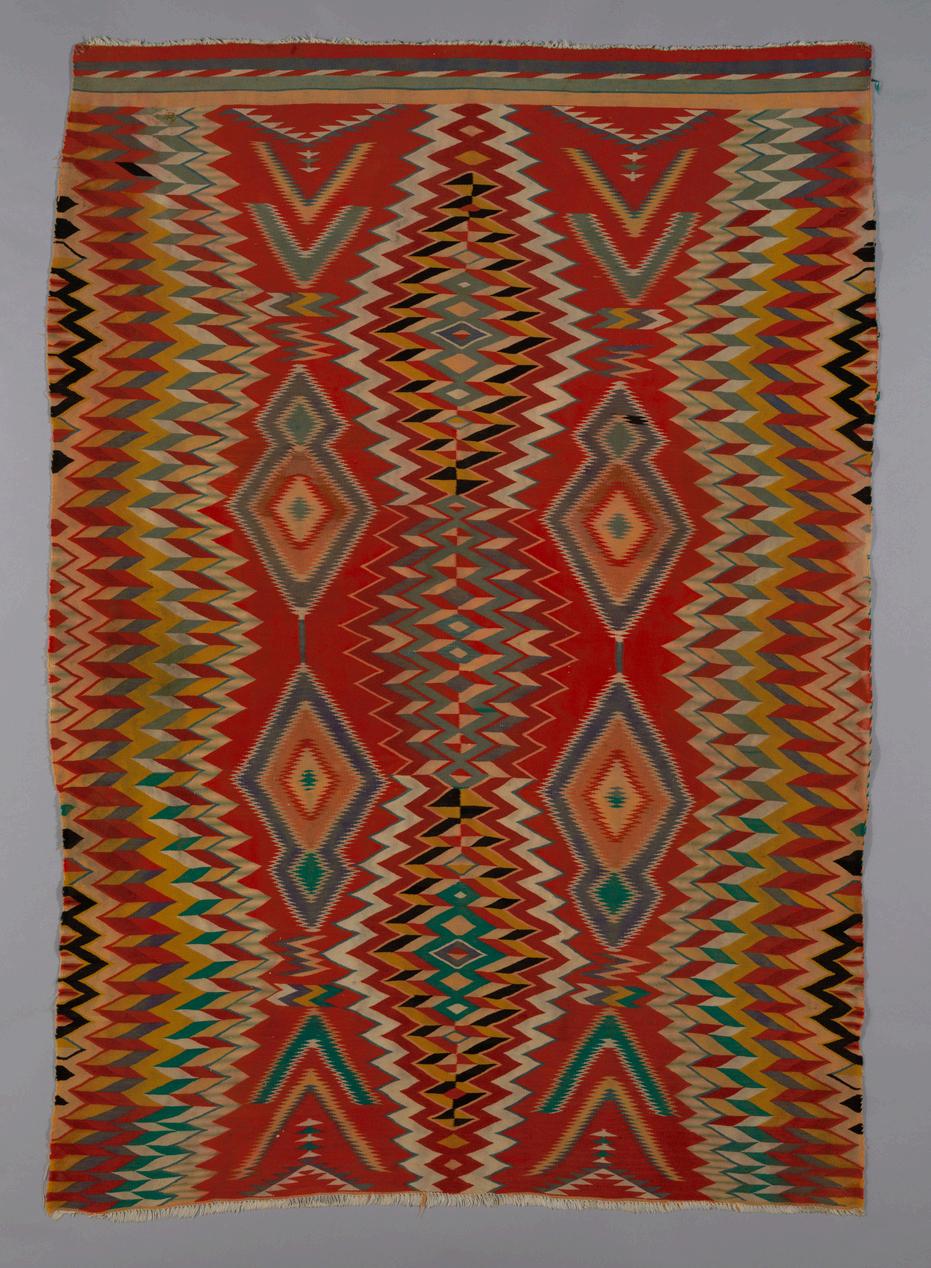
Patrick Hubbell, Your Clarity Rises Above All Of My Faults, 2023
“Germantown Eye-Dazzler” Rug (detail) Made 1800 - 1890, Navajo (Diné) deconstructed exegesis on the value and circulation of traditional Diné crafts.
Still other selections by the artists in the exhibition are more unexpected, if not curiously weird Robert Burnier turned to the example of Matteo di Giovanni’s The Dream of Saint Jerome, 1476 with tempera giving way to painted aluminum in Burnier’s Matene Mi estos en Ordo, Mia Amiko (Ho Sinjoro), 2022 The autonomy of Burnier’s pure abstraction seems hardly adjacent to the Judeo-Christian undergirding of the Matteo di Giovanni But hey, all that pleated and folded drapery here, and throughout the history of painting, no doubt stimulated Burnier’s aesthetic maneuvers, not to mention the relatively new perspectival plays of the 1476 panel in its own time. Jeffly Molina’s figurative work (Feelings, 2023) might seem distinct from the pure abstraction of Agnes Martin (Untitled #12, 1977), and yet both share a profound still and quiet pathos. Similarly, Noelle Africh’s process-based Flood, 2024 juxtaposed with Luc Tuyman’s Angel, 1992, emphasizes Tuyman’s earthy marks and subdued palette, or is it the reverse? Tuyman’s ghostly angel is really incidental to the painting’s read, and while Africh, in contrast, leaves out images altogether, there is something numinous hovering inthe elusive variations of the surface of this painting. George Johnson’s awkwardly elegant composition, There is a buzzing/my foot feels strange, 2025 look back to the somewhat obscure American painter, Morris Kantor, whose work, Haunted House, 1930, is a melancholy scene of human despair, with the same masculine ennui that inhabits much of Johnson’s work And Josh Reames goes to Bruce Nauman as his museum pick, an interesting choice in that both Reames’ Under the Bright Light, 2022 and Nauman’s Clown Torture, 1987 are wry engagements with the pernicious power of the mass media’s manipulative control, today once again, dangerously relevant Reames’ choice of a video is also an example of the painters in the show who singled out non-paintings as their AIC selection Like Reames,
Cameron Spratley turned to David Hammons’ historic piece Phat Free, 1995-99, with its banging metal bucket kicked down a dark street, as a meditation for his own rendition of deliciously treacherous accoutrements in Dust2dusT, 2025. Interestingly, two of the six Latina women in the show, Isabella Mellado and Cecilia Beaven reached back to ancient Roman sculpture, as the weighty classicism of these objects grounded their otherwise wildly inventive forms Clare Rojas took her inspiration from a Ceremonial Knife (Tumi), 1100-1472 from Peru, whose sharp curvilinear shape and forceful mythic creature gets updated in her Protective Mother, 2022 And Efrat Hakimi’s array of collaged tokens in Protective Amulet against Miscarriage (1), 2021 finds formal resonance in her choice of a beautiful Moroccan textile, a man ’ s cape (Akhnif) from 182575, an item with a darker history as it was sometimes worn inside out to mark the wearer as Jewish.
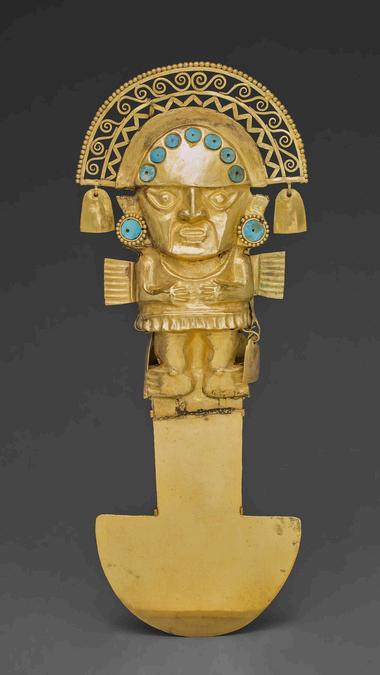
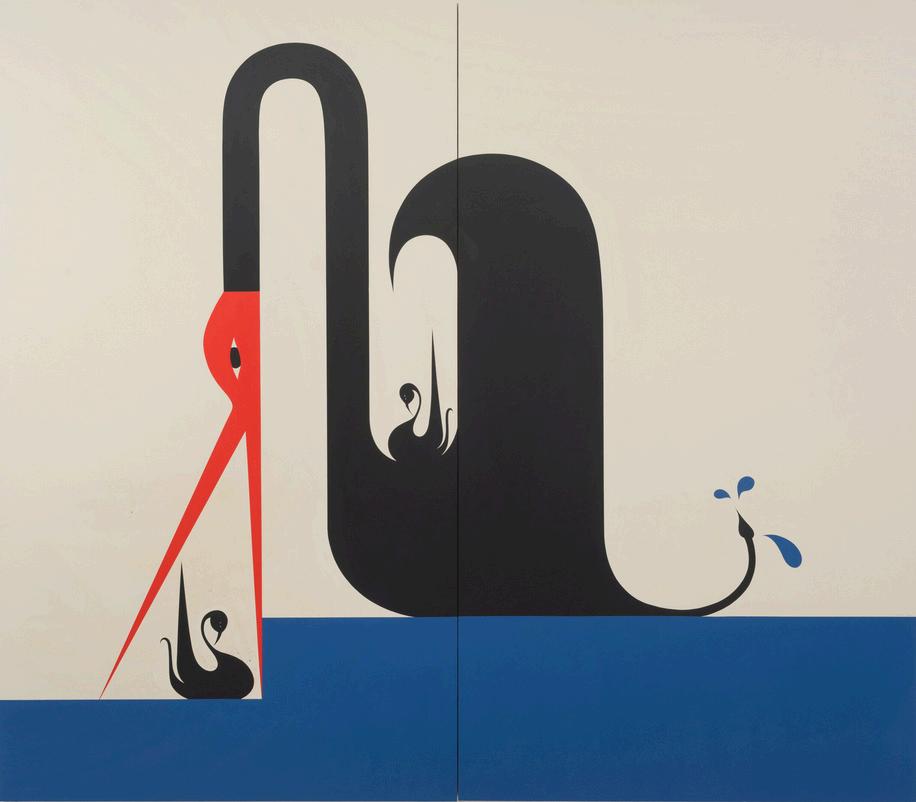
Master Class positions the last 25 years of painting alumni in relation to the museum, and what emerges is a renewed commitment to a tenet of modernism that prized freedom above all else. The avant-garde, to which many of these 69 artists still clearly relate, boldly broke new ground, upsetting the status quo again and again to assert new means of making and by extension, thinking And all of it paralleled the relatively new political climate of democratic revolution When the artist Albert Oehlen proclaimed that artists “ are technicians of freedom,” at the School of the Art Institute’s 2015 commencement address, where the Director of the Museum at the time, Douglas Druick, was also receiving an honorary doctorate, he was speaking to artists in a museum school For to be free is to know one ’ s past, in order to reinvigorate one ’ s present.
There seems to be a return to medium specificity in this show, where facture, color and shape slow us down to the pleasure of pure painting again. Has painting returned to its roots in an attempt to counter the onslaught of so many pulsing digital screens? It does appear that the wonder of painting, its visceral, palpable materiality, its chromatic buzz and sensual luminosity holds our visual attention again despite the cacophony around us We live in what some have observed as an ‘atemporal’ moment, a collapsing of eras in an all-consuming internet space, a kind of perpetual present that seems to cannibalize all in a schizophrenic fashion But our museum school still continues to find a kind of historical mapping useful, even if it means productively disrupting some of the narrative The museum collection serves as a means of anchoring one ’ s practice to a system of shared traditions, whether in the form of thoughtful resistance or emphatic embrace, or an admixture of both. It does so not ironically, that postmodern stance, but as an ethic of heroic experimentation. The different frequencies of painting on offer in the Secrist | Beach show are all beautiful to behold and thoughtful to consider. They offer new perspectives on that which is familiar, subtly adjusting and modifying and making it fresh. These material propositions executed through the individual voices of artists remain a hallmark of a democratic society. We must never take for granted the freedom we enjoy to produce what we will, to make our independent claims through deliciously formal means, and for such aesthetic gestures to “influence the fantasies of the public,” as Allan Kaprow suggested many years ago.
7
FOOTNOTES
1
Allan Kaprow, “The Artist as a Man of the World,” Essays on Blurring of Art and Life, Jeff Kelley, ed (University of California Press) 53
2
Thomas C. Buechele and Nicholas C. Lowe, The Campus History Series: The School of the Art Institute of Chicago (Charleston: Arcadia Publishing, 2017), 7
3
4
Thanks to Dr. Kevin Carney for the apt metaphor of a ‘home court advantage.’
Kynaston McShine, The Museum as Muse: Artists Reflect (Museum of Modern Art, 1999)
6
Nairobi artist, Michael Armitage’s deep interest in Gauguin speaks to the global allure of this artist
5 André Malraux, Museum without Walls (New York: Doubleday and Co , 1967)
See the seminal text: Frederic Jameson, “Postmodernism and Consumer Society,” The Anti-Aesthetic, Essays on Postmodern Culture, Hal Foster, ed (Seattle, Washington: Bay Press, 1983) 111-125

Work
by Michelle Grabner
“Actual work in a discipline requires one to recognize how much others know and one doesn’t, a loss in ego that brings a gain in skill.”
Jonathan Kramnick, Criticism & Truth, 2023
Master Class: Inside the Last American Museum School with SAIC Alumni for Chicago’s Secrist | Beach Gallery, is a luminous and rigorous teaching exhibition It foregrounds the enduring value of sustained engagement with art objects of close and iterative looking, of contemplative study, and of critical interrogation. It revels in deep formal and conceptual analysis, and in the gravitational pull of the aesthetic sphere.
The exhibition comprises a diverse array of contemporary works that traverse cultural histories, temporalities, geographies, and artistic sensibilities. While resolutely contemporary, Master Class is philosophically aligned with George Saunders’ 2021 volume A Swim in a Pond in the Rain, a hybrid of literary analysis and craft pedagogy centered on canonical short stories by Chekhov, Tolstoy, Turgenev, and Gogol. Saunders’ text, like the Master Class exhibition is a tribute to the recursive nature of creative work to close reading, revision, and the ethics of form. While Saunders’ insights are drawn from literature, his convictions resonate profoundly with this curatorial project
Engaging interrelationships between artwork and artwork, artist and influence, past and present, the exhibition delights in the generative frictions of influence, inspiration, paradigm, and critical criteria Sixty-nine contemporary artists all alumni of the School of the Art Institute of Chicago’s Painting and Drawing Department selected a work from the collection of the Art Institute of Chicago as a tribute and a model in their own artistic development In placing new works in conversation with historic antecedents, the exhibition enacts a reverent yet vitalizing pedagogy, affirming SAIC and AIC sisterhood as a perpetually animated site of study and provocation.
Like Saunders’ approach to the short story, the exhibition Master Class insists on the ethical dimension of artistic practice. Saunders reminds us that every sentence must be earned, that writing is an act of ongoing revision, and that the relationship between writer and reader is one of profound and mutual investment. So too does this exhibition suggest that the act of looking of studying and re-studying is itself a form of dedication and a dialogue across time. We encounter
encounter works in the AIC in order to understand the physics of form. We are looking to see what we can steal. The artworks that we study at the AIC are the high bars from which to measure our own work. And while some historical works in the collection of the AIC are great in spite of certain flaws, we discover that many are great because of their flaws And we are often reminded in the presence of other work that we can’t know what our studio problems will be until we work our way into them and then, we can only work our way out
This exhibition reminds us that attachments to artwork is a galvanizing phenomenon Through repeated encounters looking, questioning, analyzing, quarreling the work becomes more than an object of study It becomes an object of tone, attitude, sensibility, ethos, and affect Such works may affirm or unsettle. They may surface the social, political, and economic frameworks within which art circulates. Or they may simply offer aesthetic pleasure. In entering into dialogue with the artwork from the AIC collection, artist confront its past, its institutional present, and its speculative future. The museum and its holdings are thresholds: sites of inquiry and curiosity, ethical engagement, and creative renewal.
For example, the conceptual rigor and procedural systems at play in Jack Whitten’s Khee II (1978) reverberates in Jonathan Worcester’s studio practice and is reflected in this exhibition through Ogive (2024). Worcester’s field of meandering moiré patterns, palpable paint body, and inscrutable layering extends Whitten’s linear composition into a dynamic, architectural and fluid abstract motif While Sol LeWitt and Ellsworth Kelly’s works inform the foundational visual vocabularies of Samantha Bittman and Alberto Aguilar, it is the intellectual provocation of René Magritte’s The Tune and Also the Words (1964) that animates Paula Crown’s text-based painting Where Does Time Go? (2016) Rumination on mathematical equations, language systems, and painterly intonation, Crown’s painting entangles Magritte’s metaphysics with the direct experiences of a Jasper Johns’ painting
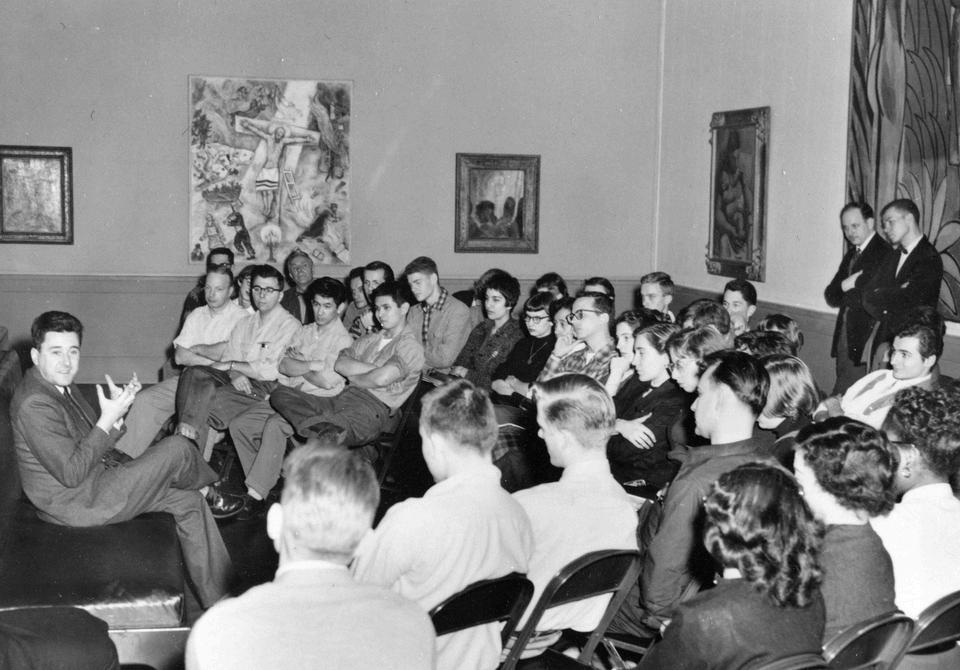
Perhaps not surprisingly, ardent, body-scaled gestural expression whether in Joan Mitchell’s much-cited City Landscape (1955) or Willem de Kooning’s seminal Excavation (1950) remain dominant touchstones for contemporary painters such as Latifa Alajlan, Jeane Cohen, and Angel Otero Meredith Kopelman’s Anything But (2024) similarly exemplifies excited brushwork, yet it is Fishing Boats with Hucksters Bargaining for Fish (1832–42) by J M W Turner that she scrutinizes and sources for turbulent, abstract energy within her seascapes
Genre paintings also abound in Master Class By bringing the viewer into thematic agreement, genre allows artists to anchor historical, stylistic, and narrative interpretations across painting’s known categories such as still life, portraiture, and landscape The codes that probe the sublime within these classifications find articulation in the contributions of Dana DeGiulio and Claire Sherman. Sherman’s Moss and Branches (2018) shares an uncanny luminosity with George Inness’s Afterglow (1893), while Man Ray’s moody, arcane Percolator (1917) informs DeGiulio’s painterly tactics. In DeGiulio’s still life, tussled dabs of paint choreograph a dispersion of cut white roses and contrasting green foliage. As in Man Ray’s work, it is the application of paint and directional brushwork not mere representational likeness that generates the allegorical potential. Representation also yields to color as an organizing principle in Tavin Davis’s numerous blue-sky landscapes, which channel the tonal abstraction of Georgia O’Keeffe’s The Black Place (1943).
Magalie Guérin’s Untitled (Gabriele) (2025) is neither a copy nor a study; rather, it is a muse on Gabriele Münter’s Still Life with Queen (1912) Guérin reworks Münter’s storybook arrangement through an array of contrasting of visual vocabulary that far outreach Münter’s expressionist lexicon Despite a textured surface, unrelenting color clashes, and the inclusion of super-flat graphic shapes, Guérin’s work still holds compositional equilibrium and retains the genre of “still life ” Conversely, Stephen Eichhorn’s Aloe Agave Aloe Bloom (2025) over-esteems the structural formalism of his benchmark, the photographer John Pfahl Eichhorn’s contribution instead distorts perspectival space through unnatural lateral symmetry and a digitally flattened visual field.
Given the Art Institute of Chicago’s rich holdings of Matisse and the enduring prominence of the figure in the contemporary cultural imagination it’s no surprise that Matisse’s linear contours echo in the works of Andrew Holmquist and MJ Lounsberry. Figurative works by Jim Nutt, Joan Miró, Tsuguharu Foujita, and Ivan Albright are also cited as impactful sources, suggesting that the abstracted body continues to reveal more than its academic counterparts. This is evident in Jonathan Gardner, Kaveri Raina, Autumn Ramsey, and Sterling Ruby works as they seek to convey humanistic qualities through the articulation of strange and unearthly bodies Nik Cho and Alex Bradley Cohen also deploy blocky, shape-driven nonrealistic depictions of the figure, but both of these artists ground their figures in social spaces Cho’s large-scale yet intimate depiction of men in a bar and Cohen’s vibrant library scene evoke familiar compositional painting contexts particularly David Hockney’s American Collectors (Fred and Marcia Weisman) (1968) while Cohen also finds resonance in Jacob Lawrence’s The Wedding (1948)
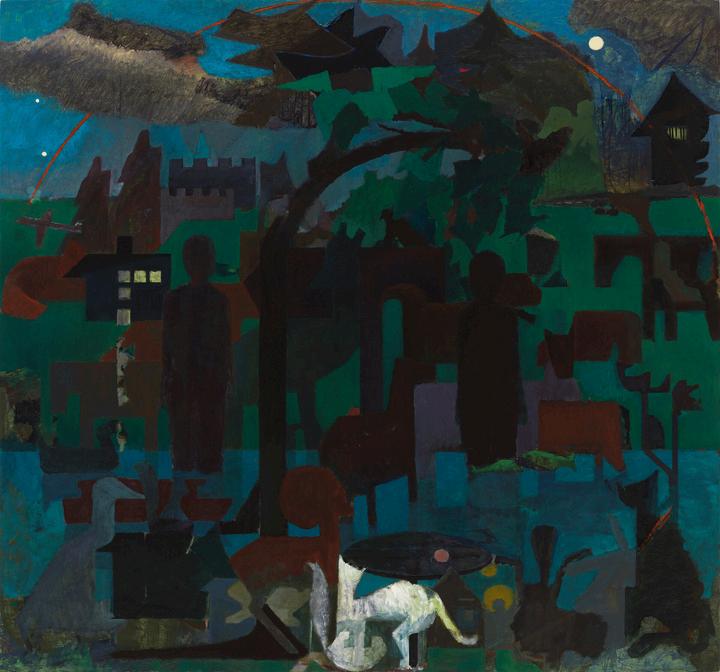
No study of AIC’s collection is complete without acknowledging the historical weight of its European Impressionists James Kao’s Starlight (2018) recognizes Georges Seurat’s A Sunday on La Grande Jatte (1884–86) as its driving influence, while Keer Tanchak’s series of oil-on-aluminum paintings gestures toward the warm, atmospheric sensibility of Édouard Vuillard’s Landscape: Window Overlooking the Woods (1899). Nicola Florimbi is likewise drawn to the exceptionality of the commonplace. In Measure Up (2024), a daunted figure stands in a classroom surrounded by instruments of learning measuring stick, laptop, open books, globe capturing the psychology of doubt in the routing of learning Though not Impressionistic in style, Florimbi’s composition is deeply influenced by

Jean-Baptiste-Siméon Chardin’s The White Tablecloth (1731–32), a still life life of bread, wine, and meat rendered with a quiet dignity that seeds the Impressionist ethos.
The irreverence of Neo-Dada is fully alive in Antonia Gurkovska’s abstract compositions from her Closed Circuit series (2024–25). Like Gurkovska, Charlotte Saylor explores this inheritance in Houseboat (2024), a folded and stained canvas textile embedded with found materials, including the artist’s own brushes Gurkovska explicitly references Rauschenberg’s Short Circuit (1955), while Saylor’s practice also embraces a gap between art and life
Simultaneously, Saylor draws on the vitality of surface and gesture found in Henri de ToulouseLautrec’s At the Circus: The Bareback Rider (1888), a rapid oil sketch on the vellum surface of a tambourine, where painting and the found object collide.
Formalism’s visual rhythms are embraced with perseverance and tenacity in works by Tony Lewis, Steven Husby, Austin Eddy, Alice Tippit, and Jae Ford. These artists perpetually investigate stabilities and disruptions, symmetry,
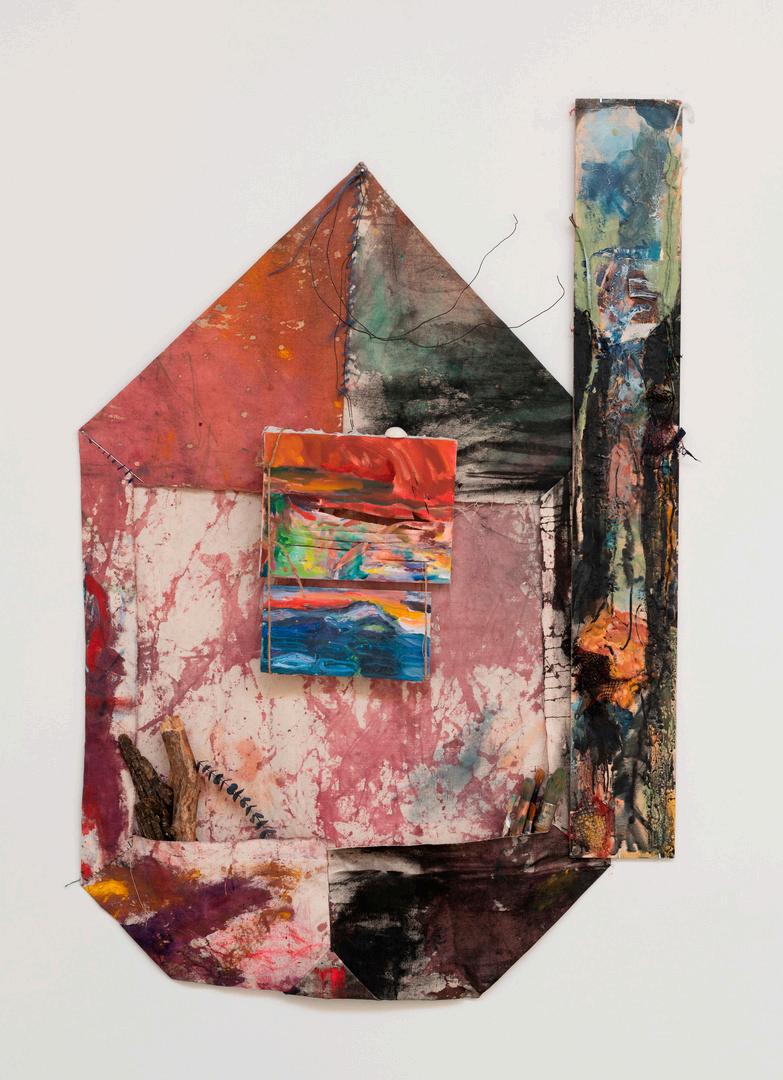
Saylor, Houseboat, 2024
asymmetry, dominant and residual structures reworking design tenants, prescribed orders, and value systems. Early modern abstraction in the AIC’s holdings, from Stuart Davis and
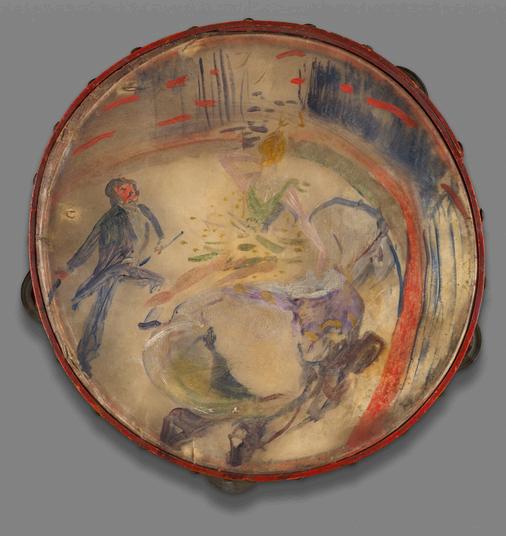
Georgia O’Keeffe to Minimalists like Frank Stella and John McCracken, offers formal and material vocabularies for artists to parse the temporal patterns embedded in social life, histories, and economies. While Alice Tippit’s Stone (2023) references Francis Picabia’s Untitled (Match-Woman 1) (1920), Tippit reorganizes Picabia’s portrait and its diagonal ground into a flat painting organized with perfect lateral symmetry Tippit’s Stone turns Picabia’s witty jab at portraiture into a universal sign that can circulate without origin or context. While Husby’s softly rendered acrylic shapes evoke architecture’s vertical predictability, Lewis’ dense clusters of graphite and colored pencil work probe messier entanglements each visualizing social metaphors: structure and faith for Husby, contamination and conflict for Lewis.
Less analogous but more politically explicit are works by Rodney McMillian, Kristoffer McAfee, David Leggett, and Molly Zuckerman-Hartung. While their work may not narrate endemic American histories like Horace Pippin’s Cabin in the Cotton (1931–37) or Kerry James Marshall’s Many Mansions (1994), they each share a commitment to revisiting historical injustices and the interrogation power Even Molly ZuckermanHartung’s reflexive One Lives Several Lifetimes in the Space if an Hour (2025) conflates notions of freedom with intervals of labor. While referencing Matisse’s Woman before an Aquarium (1921-23), a painting depicting a woman observing goldfish circulating in a fishbowl, Zuckerman-Hartung’s work, with its stitches, seams, and indirect printmaking processes cannot constrain the elasticity and subjective qualities of time.
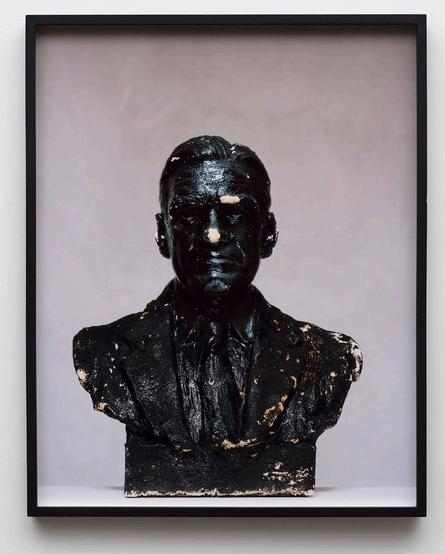
Many artists in the exhibition are drawn to specific specific works in the AIC’s collection not solely for formal or thematic alignment, but because they inspire deep attachments. These attachments may take the form of reverence, memory, admiration, or quiet devotion. For example, Sumakshi Singh acknowledges the contemplative arch
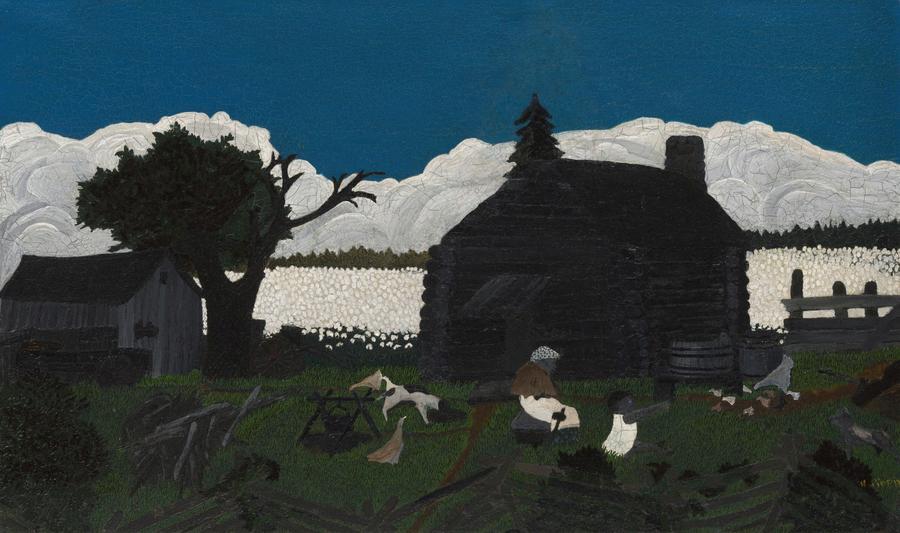
architecture of Tadao Ando’s 1992 gallery, a sacred space designed for reflection and aesthetic encounters. Em Kettner is moved by a pair of Coastal West African slippers (bata ileke, 1875–1925), Pedtro Trueba Ramírez by the Barcelona Chair for a canonical period in his move to Chicago, while Orkideh Torabi selects Katsushika Hokusai’s Self-portrait as a Fisherman (1835), and Cody Tumblin brings attention to Bob Thompson’s The Descension (1961) These references may not always map directly onto the artists’ formal practices, but they signal emotional kinships The same can be said for Aviv Benn’s selection of Charline von Heyl’s Interventionist Demonstration (Why-a-Duck?) (2013) or Celeste Rapone’s choice of Gertrude Abercrombie’s Selfportrait of My Sister (1941) While the connections between practice and referent may appear loose, they are rooted in sincere admiration Emily Miller is captivated by the surreal imagination of Remedios Varo’s Still Life Reviving (1963), while Hiejin Yoo engages Alex Katz’s iconic window motif, scaling it down to explore intimacy and containment. The psychological intensity of Aliza Nisenbaum’s subject in Marisol’s Nighttime Porch (2024) finds a spiritual counterpart in her chosen reference, Rufino Tamayo’s Woman with a Bird Cage (1941), just as Ruth Poor’s Francis (2020) echoes the devotional power of El Greco’s Saint Francis Kneeling in Meditation (1595–1600).
Saunders concludes A Swim in a Pond in the Rain with a story told to him by a student: “Robert Frost came to a college to give a reading. An earnest young poet stood up and asked a complex technical question about sonnet form, or something like that. Frost took a beat, then said, ‘ young man, don't worry: work ’” Saunders weighs in and says, “I love this advice It's exactly true to my experience We can decide only so much The big questions have to be answered by hours at the desk So much of the worrying we do is a way of avoiding work, which only delays the (workenabled) solution So don't worry work, and have faith that all answers will be found there ” In a footnote Saunders’ makes a correction to this student account by stating that, “A few years later, a frost scholar came up after an event and offered a gentle correction What Frost had actually said, (he said) was: ‘Young man, don't work: WORRY?’ Well, that's true, too (Maybe worry can be a form of work.) But if it’s true for you, I endorse that advice too. Go forth and don't work. WORRY.”
In the spirit of Saunders, and all who contributed to this exhibition, we are reminded that the work of others offers not only reference, but dialogue. These materials are not static artifacts they are active agents in our thinking and making. Engage them closely as they are among our most vital tools.
George Saunders, A Swim in a Pond in the Rain (Bloomsbury: New York, 2021) p 383
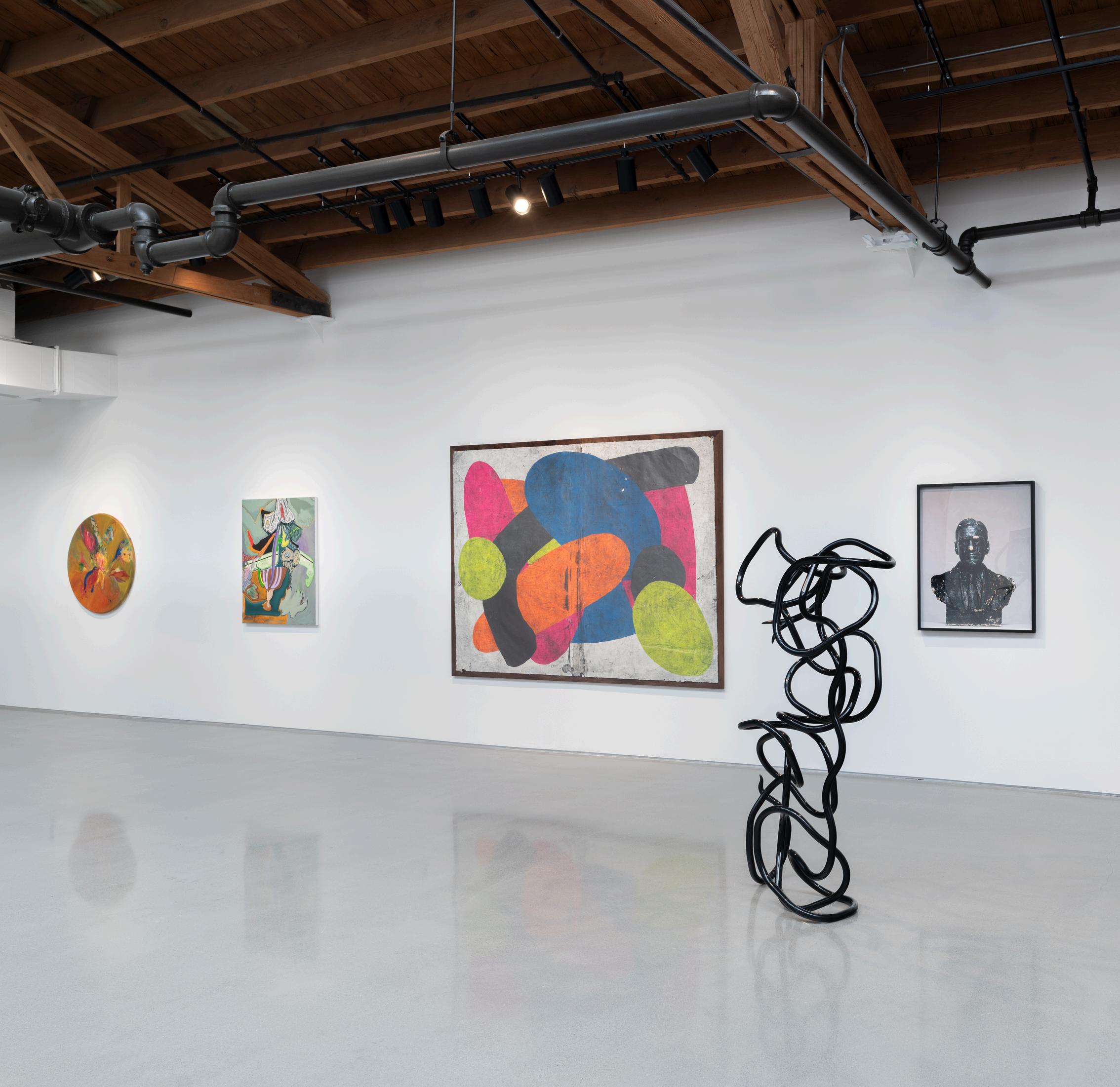

Lindsay Adams MFA ‘25
If it is possible to suggest flowers rather than represent them, that is how Lindsay Adams has painted A thousand lights of sun, 2025 There is some vestige of the traditional still-life, grounded in the implied horizontal of a table with shadowy hues of bluish grey beneath The upper background is vibrantly multicolored and expressive, reworked many times over by the artist Warm reds, ochres and streaks of light blue could denote an infinitude of flora reaching into deep space or something as inert as wallpaper Atop this color field, flashes of bright yellow, in the top half, and dark green, in the bottom, hint at petals shooting up or drooping forth Representation here takes its cues from the edgeless possibilities of the tondo format itself. The brushwork is free; pictorial space only just holds together.
For this exhibition, Adams’s selection from the Art Institute Collection is Claude Monet’s Irises, 1914-17, which, despite being twice the size, shares with A thousand lights of sun a delirious abundance of flowers painted in a manner halfway to outright abstraction, as well as an “allover” composition that fills the entirety of the frame. Monet did occasionally employ circular canvases, such as several entries in the iconic Nympheas (Water Lilies) series that date to 1908. In these, the curve of the tondo contrasts visibly with the many “horizons” implied by the water lilies as they recede into the distance This facilitates the Nympheas’ subversive deconstruction of landscape: reflections from the blue sky above produce an upside-down world that is in turn vivisected by the lilies, which remind us we are looking at the surface of the water detaching us from traditional perspective By Irises, we can no longer discern where the reflections end and the “real” flora begins, as the iridescent blues that perhaps correspond to the sky above extend well past any imaginable horizon into the foliage implied in the upper left half of the painting As Giverny was Monet’s experimentation sanctuary at the end of his career, Adams has spoken openly about her works corresponding to a safer, immersive Black space and time. The title quotes from a Langston Hughes poem:
“My hands!
My dark hands!
Break through the wall!
Find my dream!
Help me to shatter this darkness, To smash this night, To break this shadow Into a thousand lights of sun, Into a thousand whirling dreams Of sun!”
~ Daniel Ricardo Quiles
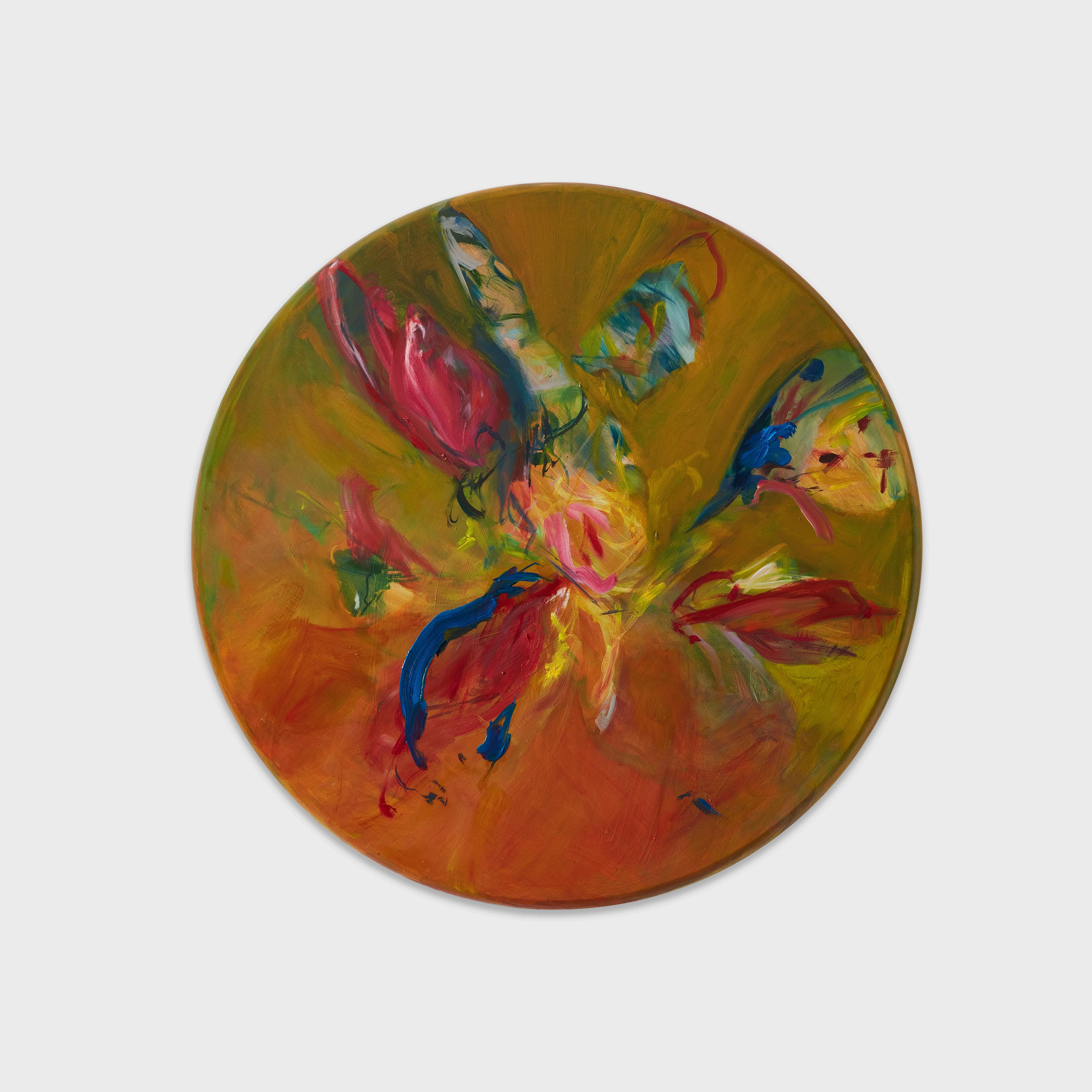


Noelle Africh
Africh’s paintings challenge our perception of what we sense and what we see, moving away from the idea of a single author imposing their will upon the material Subdued colors have seeped deep into the canvas, and the unstable components used by the artist pigment, calcium carbonate and animal glue (combined in a technique called distemper) grant the material its own agency. This resists simplistic definitions of abstraction or figuration, which is particularly striking in Flood from 2024, with its enormous depth of black and greenish colors. Despite their demanding presence, these works are fragile objects, subtly evoking their toxic predecessor (when lead was used instead of chalk), and are highly sensitive to temperature changes. Are we seeing figures, or is the material itself alive? How long will those works endure? There is a strange, even spiritual, quality to these pieces. This condition resonates with Luc Tuymans’ Angel from 1992, which also employs muted colors and ghostly presences. The seated angel’s face remains invisible perhaps only hinted at in shadow with wings that resemble stone, a harp in hands. What must have drawn Africh to this piece is Tuymans’ instinctive refusal to set boundaries between figuration and abstraction No light shines on or emanates from the angel; its meaning is elusive, and our gaze bounces back Are we the intended viewers, or are we merely witnessing a process initiated by the artists, but ultimately controlled by the materials themselves? In Africh’s and Tuymans’ works, appearance and disappearance seem governed by the painting, as if it decides what it will reveal This is both unsettling and captivating, drawing us deeper into an experience only the most skilled painters can accomplish
~ Mechtild Widrich
Selection from the Art Institute of Chicago collection: Luc Tuymans, Angel, 1992
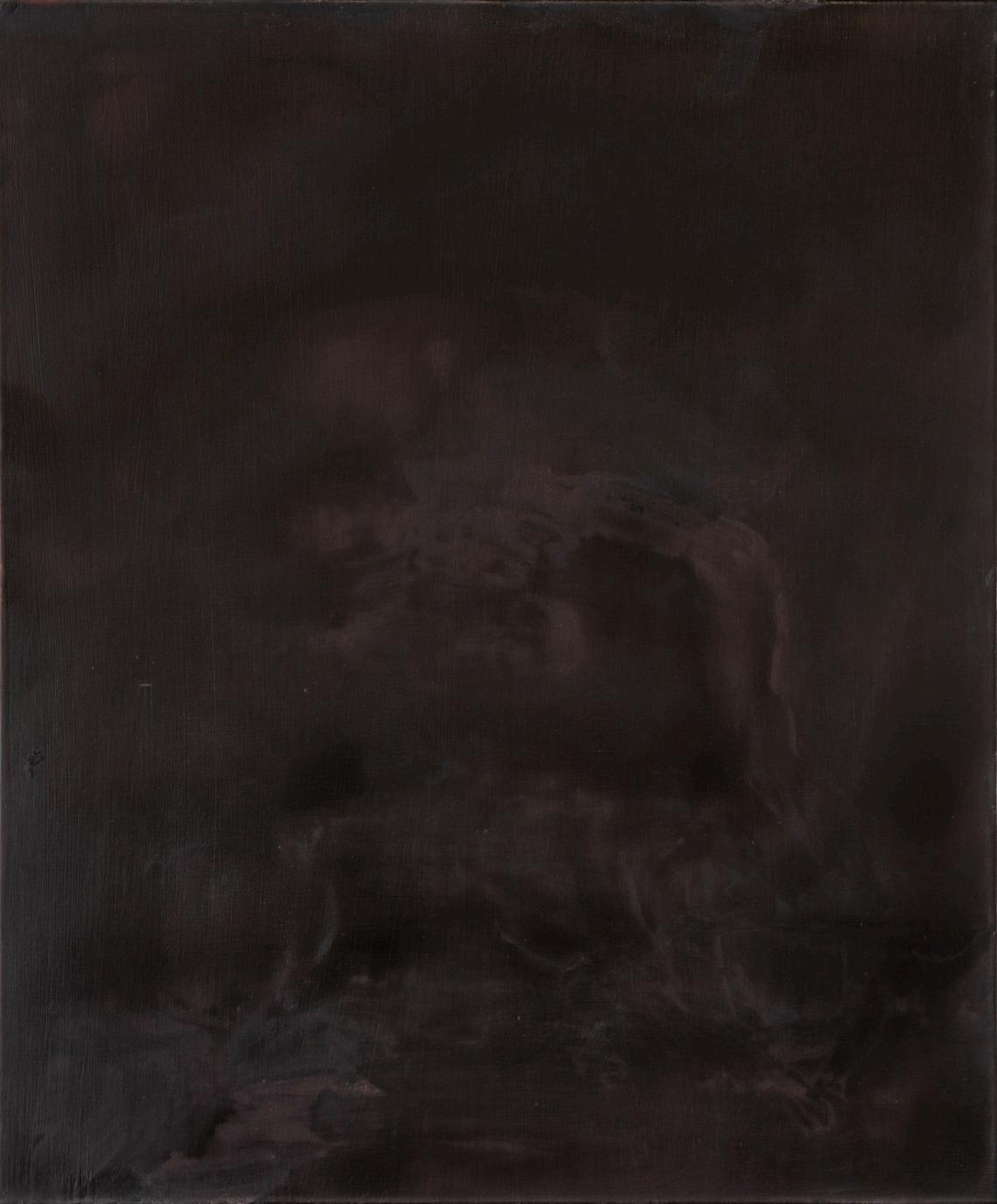
From left to right:
Not Yet, 2024
Distemper on linen over panel
12 x 9 inches
Worm in the Bud, 2024
Distemper on linen over panel
9 x 12 inches
Flood, 2024
Distemper on linen
23 5 x 19 inches
Sender, 2023
Distemper on panel
12 x 16 inches
Reliquary, 2023
Distemper on linen
20 x 14 inches
Hindsight, 2025
Distemper on linen over panel
20 x 16 inches
Loomer, 2023
Distemper on linen over panel
20 x 16 inches
Hindsight, 2025
Distemper on linen over panel
20 x 16 inches
Cruciform, 2024

Distemper on linen over panel
10 x 8 inches







Luke Agada
MFA ‘24
Broad ribbons painted in arresting colors stretch across Agada’s canvases. They loop into themselves or dwindle into tendrils. They’re not the only forms he paints: oblongs, ovals, and rounded-off rectangles appear too. I won’t call them biomorphic. This term doesn’t refer to color and has become a general descriptor of the kind of forms Agada paints. Alfred H. Barr, MoMA’s first director, introduced the word “biomorphic” into art history in 1936 The artists Barr had in mind were those who, like Gorky, were steeped in Surrealism’s heritage Acknowledging the unconscious; acknowledging memory that’s what Surrealist artists do A decade after Barr’s coinage, to paint The Plough and the Song, a nostalgic Gorky left his New York studio, returning in his memory to childhood, to Armenia, to the outdoors (farming’s yearly cycles of crops and harvesting) Agada’s Unstill Life: Elegy in Blue, however, stays indoors and attuned to color
That color is the blue the title promises. Where is it? Not in Unstill Life’ s upper third. Here, a warm, toffee brown (bounded in a large rectangle) dominates. Across it shoots a dark brown ribbon (it looks like a peacock’s feather). But the thick ivory band (the composition’s right-hand border) sends us back to that part of Unstill Life (its lower third) where we find the title’s color. A lightened-up ribbon of Prussian blue, slanted at an oblique angle, runs around an oval of dark brown the composition’s off-center focus.
All along, we discover, we ’ ve been exploring a room or more exactly, a “ room-space. ” The term is T.J. Clark’s, a British art historian drawn to oil paintings’ myriad effects. He coined “ roomspace ” in 2017 to describe the kind of interior that, he argues, became characteristic of the bourgeoisie and modernity For Unstill Life, I add to Clark’s identification of room-space a preference observed by the German critic Walter Benjamin among the same social class that fascinates Clark: the bourgeoisie of late 19th-century Paris Upholstery, lots of it, filled their room spaces Overstuffed, over-decorated, couches, armchairs, and cushions abounded They offer no “give ” Why not? Because they were defensive padding, Benjamin said, against what was outside To see such padding at work, look at the disgruntled youngster sprawled against icy turquoise seating American artist Mary Cassatt painted her (Little Girl in a Blue Armchair [1878]). In The Tea (1880), also by Cassatt, we see a couch used as a perch for two young women. To see what a room-space could provide, look again at Unstill Life’ s ribbon of blue.
The focus turns out to be a bed for a dog. The dog seems fast asleep: tiny curls of tan paint delineate closed eyelids. Creamy paint in Agada’s ribbons describe a long snout, elongated neck, shoulder, and just one descending front paw. Unlike the padding observed by Benjamin and depicted by Cassatt, this body makes a well in the cushion or mattress beneath. Agada does no more than evoke this: it’s where the ribbon of blue surrounding the dog deepens into shadow. That’s where the blue of the title is seen to give, is seen to welcome.
~ Margaret MacNamidhe
Selection from The Art Institute of Chicago collection: Arshile Gorky ,The Plow and the Song, 1946

Alberto Aguilar MFA ‘01
As a student and now faculty at SAIC, I have always found the museum to be a place of refuge. I have my favorite works and regulars I return to, but I'm more interested in making new discoveries As a resident artist at the museum in 2016, I created a video series titled "Formative Works," where I invited ten artists to take me to the piece that has most impacted their own practice I did this because I had become numb to the collection and desired to see it through new eyes
Through countless visits to the museum, I have been very aware of the work Red, Yellow, Blue, Black and White by Ellsworth Kelly. I could argue that it's not of particular influence to me, but that would be false since many things in the collection have subconsciously played a part in forming my artistic sensibility. Especially iconic works such as this. I really appreciate its simplicity, being made up of seven attached canvases painted in primary colors, black and white. In a way, it takes the ideas of Piet Mondrian even further by stripping painting of mark making altogether and minimizing certain decision-making aspects such as composition, thereby reducing elements of chance.
I was in Mexico City this past March and came across large sheets of colorful crepe paper which I used in a performance while there As this show approached I had the idea to hang sheets of this paper on the rafters of Secrist | Beach as a simple gesture that could also speak of my current location When I arrived at the papeleria on the final days of my trip to choose the colors for this installation, the work by Ellsworth Kelly came to mind I did a quick search and pulled up the image on my phone At that moment I decided I would mimic this painting This alleviated having to think about what colors to choose and allowed me to make a direct reference to a work in the museum Lately I have been thinking about the use of simple gestures to create maximal visual impact.
~ Alberto Aguilar
Selection from the Art Institute of Chicago collection: Ellsworth Kelly, Red Yellow Blue White and Black II, 1953
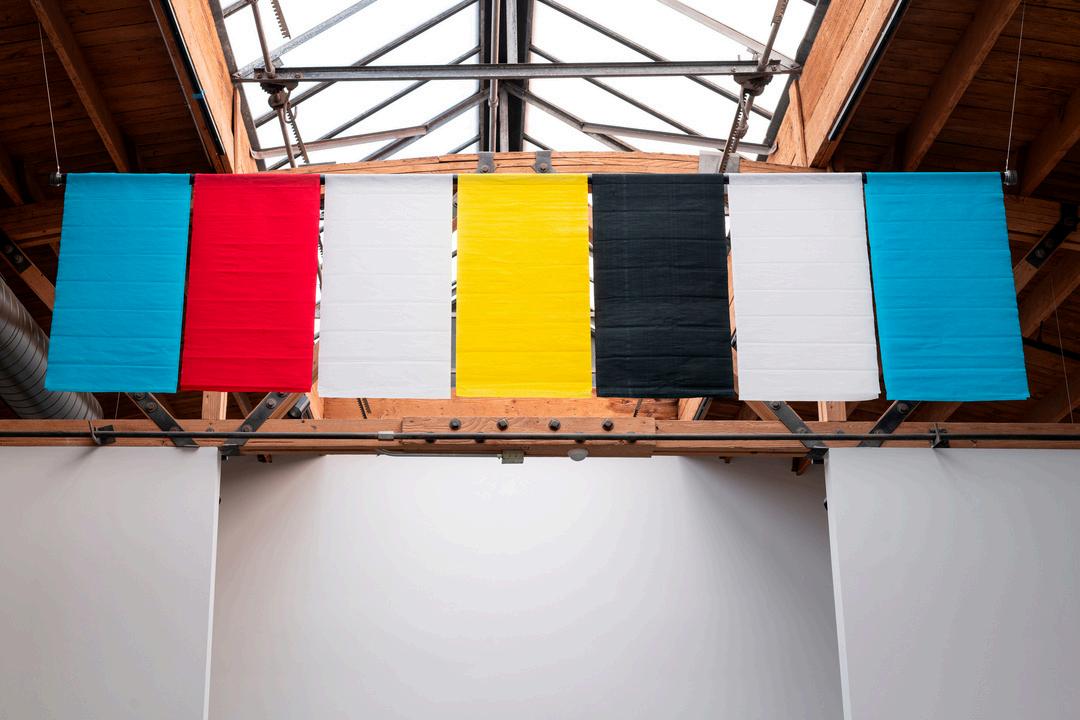
on March 31, 2025,
Latifa Alajlan MFA ‘23
Latifa Alajlan and Joan Mitchell are both actively resisting normative perceptions of gestural abstraction Though working many decades apart, the color choices of these two SAIC graduates represent only the surface of their shared approach. At a much deeper level, both artists craft a balance between physical engagement and conceptual exploration, carefully expanding the boundaries of gestural abstraction to reflect their unique cultural influences and individual positionalities.
Alajlan’s What the Wind Left Behind -
ﺎﻣ provides powerful evidence that the observation of the world around us along with the labor of converting these observations into painting are not only inextricably linked to emotions, knowledge, and personal experience, but also cultural influences seeping into our consciousness. The all-over use of the canvas with bright acrylic colors dominated by warm yellow and orange, and ranging to light green and blue, is deceptive: patterns, notably one in black resembling an Islamic star, suggest a deeper connection between the artist’s vocabulary and her cultural heritage These symbols heighten the tension between spontaneous expression and cultural memory, inviting reflection on identity and place
Mitchell’s City Landscape (1955), with bright, expressive colors at the center of the canvas and enveloped by stone-grey rectangular forms, references the rapid changes of the post-war American urban landscapes. The “outside world” referenced in the title is interpreted intuitively, with the artist’s meticulous process resisting the dominant male narrative of Abstract Expressionism at the time. Both artists, through different cultural contexts, disrupt and expand the boundaries of abstraction, offering a fresh and deeply personal perspective.
Mechtild Widrich
Selection from the Art Institute of Chicago collection: Joan Mitchell, City Landscape, 1955
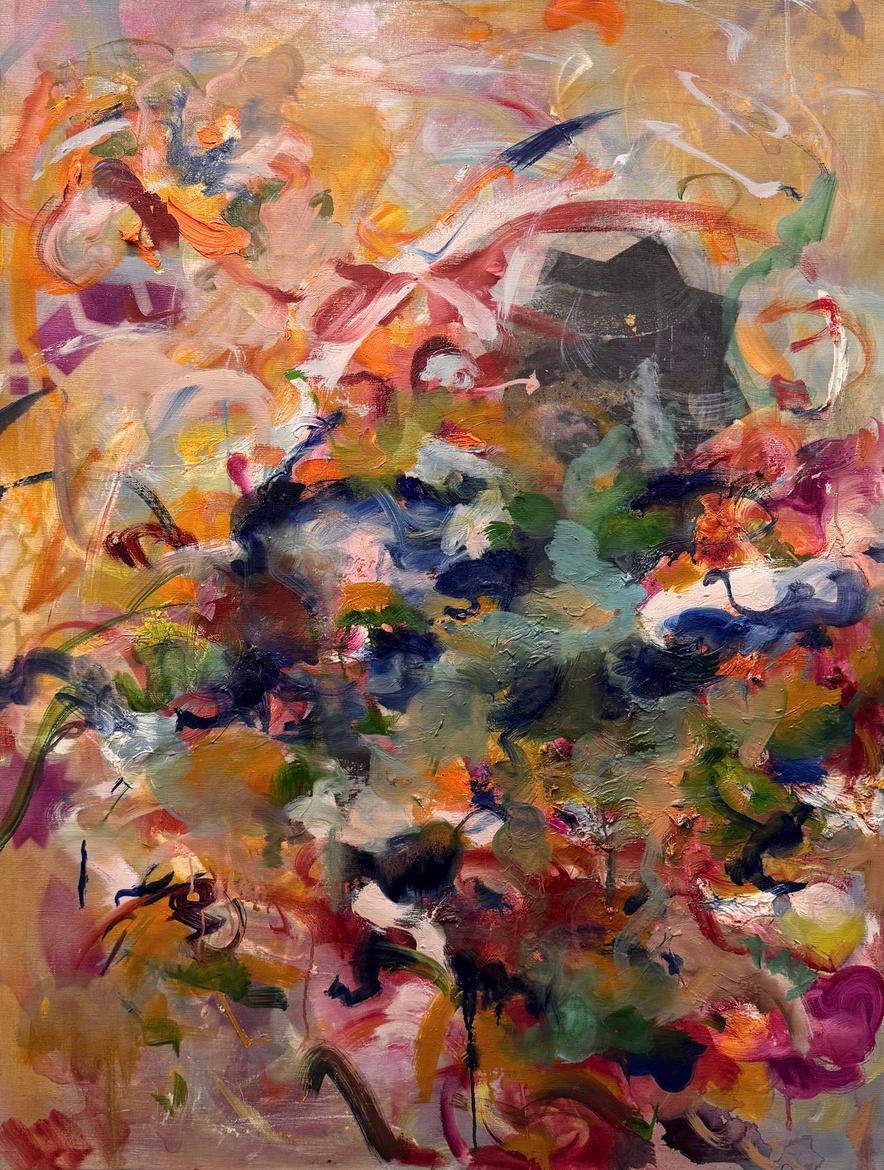
Cecilia Beaven MFA ‘19
Cecilia Beaven’s vibrant monotypes update a beloved sculpture in the collection of The Art Institute of Chicago. In Statue of a Young Satyr Wearing a Theater Mask of Silenos (1 CE–100 CE), a youthful arm reaches out of a gaping mouth. What has drawn this mischievous youth to the grotesque mask? We circle the marble, searching for clues. With his long, tendrilled beard, the mask of Silenos a companion of Dionysus, the god of wine and merriment wears life’s experiences on his furrowed brow We cannot know whether the young satyr is playing dress-up or if he finds himself entrapped within the old reveler’s guise
Born in Mexico City, six thousand miles from the marble’s origin, Beaven makes the ancient Roman sculpture her own In place of the young satyr posing as Silenos, Beaven has inserted a woman within the mask of Cipactli. An aquatic monster of Aztec mythology, Cipactli was an insatiable creature sacrificed by the gods and transformed into Earth, its green spine forming our mountain ranges. Like the young Roman satyr, the satyress plays with forces much greater than her, risking her innocence. In Beaven’s accompanying animation, the masked blue woman spins and spins, at once menacing and joyful. Even when viewed in the round, we are again left with more questions than answers.
Such creation stories lie at the heart of Beaven’s personal mythology. Across her multidisciplinary body of work, Beaven reveals what she calls “the fictional nature of the artist’s world.” Colorful humans costumed as imaginary animals inhabit her otherworldly landscapes. These hybrid forms reflect the artist’s diasporic identity, drawing from her experiences both in Mexico City and Chicago Like the Art Institute’s Statue of a Young Satyr Wearing a Theater Mask of Silenos, the connection between the inner and outer realms of Beaven’s creatures remains elusive Her masked figures underscore the ancient and enduring practice of identity performance After all, don’t we all wear a mask of some kind?
~ Francesca C Wilmott, PhD
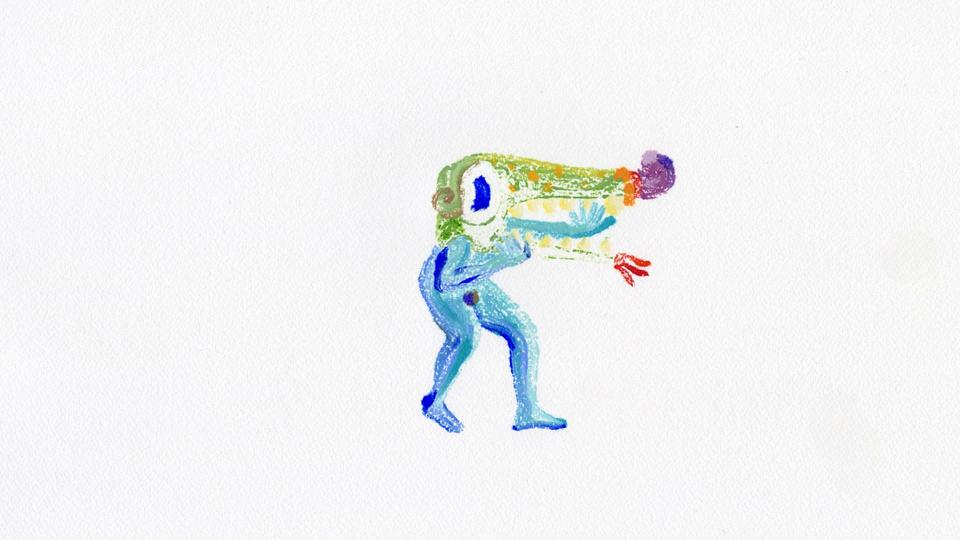
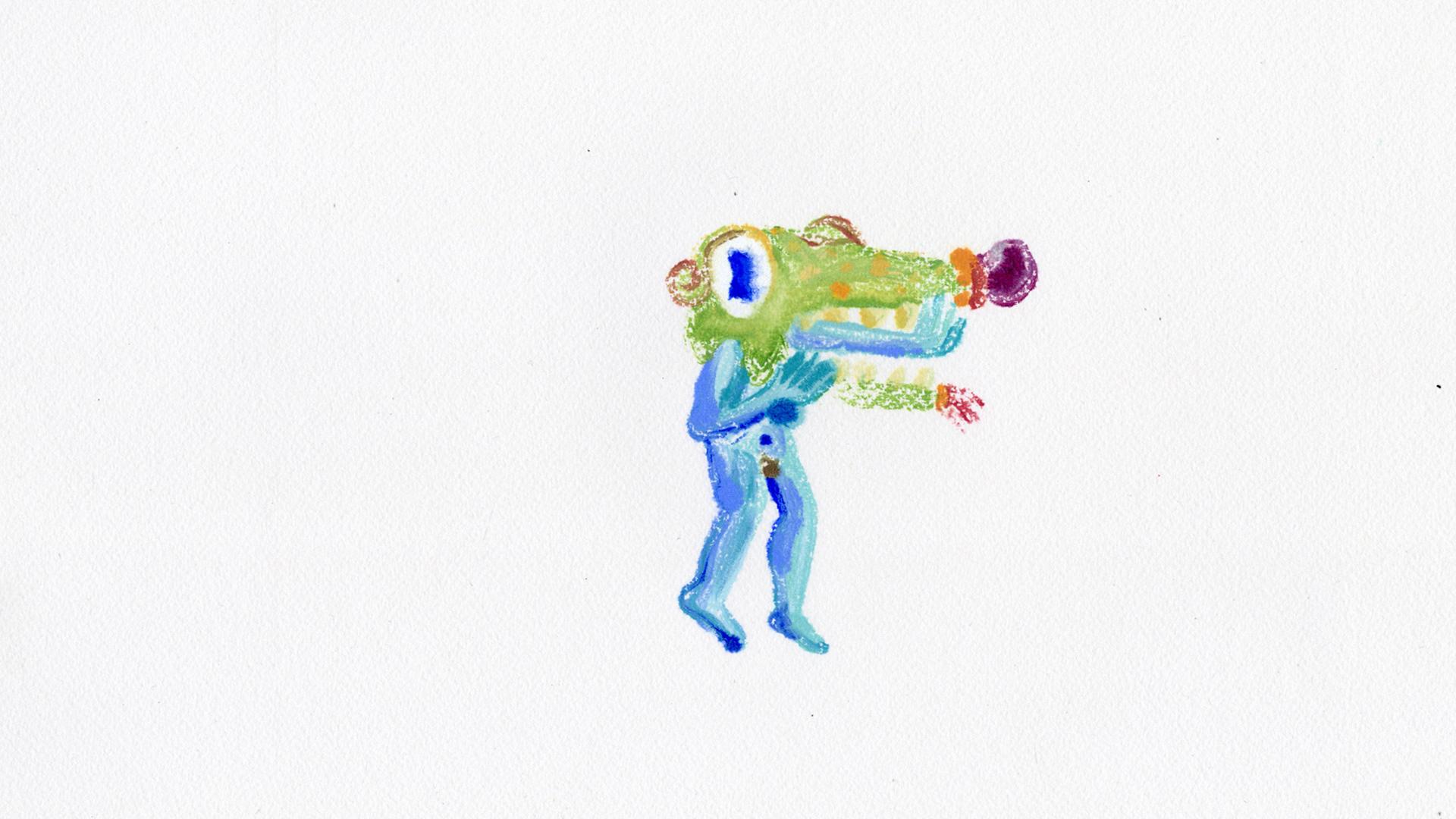


Aviv Benn
MFA ‘18
Aviv Benn’s painting Glass Upon (2024) depicts a figure, multi-limbed and suspended between a moon and a sun, standing sentinel in tension between symbolism and abstraction The floating figure’s penetrating eye, which seems to be the source of its form’s vitality, serves as a focal point, with patterns emanating downward into ambiguous wing-like limbs Animated and restless, the creature engages with its surroundings as though negotiating its own place in an uncertain world. In this and other works by Benn, painterly scenes are populated with wideeyed figures confronting a volatile reality, offering a psychological reckoning through the interplay of vibrant patterns, shifting shapes, and bold colors.
This reckoning echoes, in a different register, the generative instability at the heart of Charline von Heyl’s approach. Her paintings construct meaning through contradiction juxtaposing disparate symbols, gestures, and references in ways that resist resolution. Rather than offering coherent narratives or fixed signs, von Heyl’s canvases stage collisions: between abstraction and figuration, language and image, intention and accident. This refusal to settle opens up an expansive visual field, where meaning is not located but continually reconfigured
In Benn’s work, that instability is transposed into an existential register Her figures emerge from the churn of symbolic forms not to clarify them, but to live within their fragility to make meaning amid disorientation If von Heyl’s compositions unsettle semiotic ground, Benn’s characters are shaped by that very ground’s volatility, their forms charged with the psychic labor of orientation in a world that refuses to hold still.
Selection from the Art Institute of Chicago collection: Charline von Heyl, Interventionist Demonstration (Why-A-Duck?), 2013
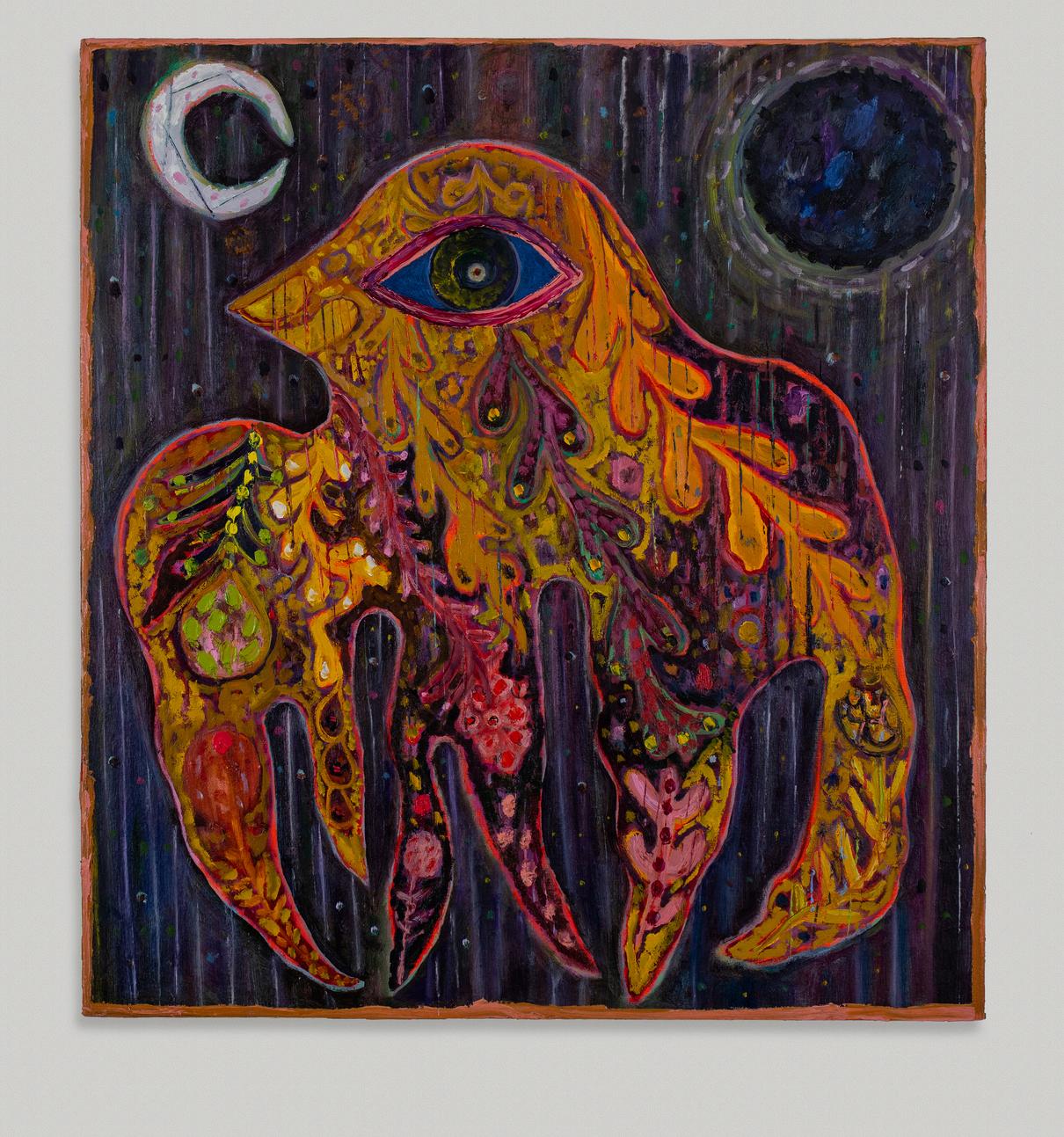
Samantha Bittman MFA ‘10
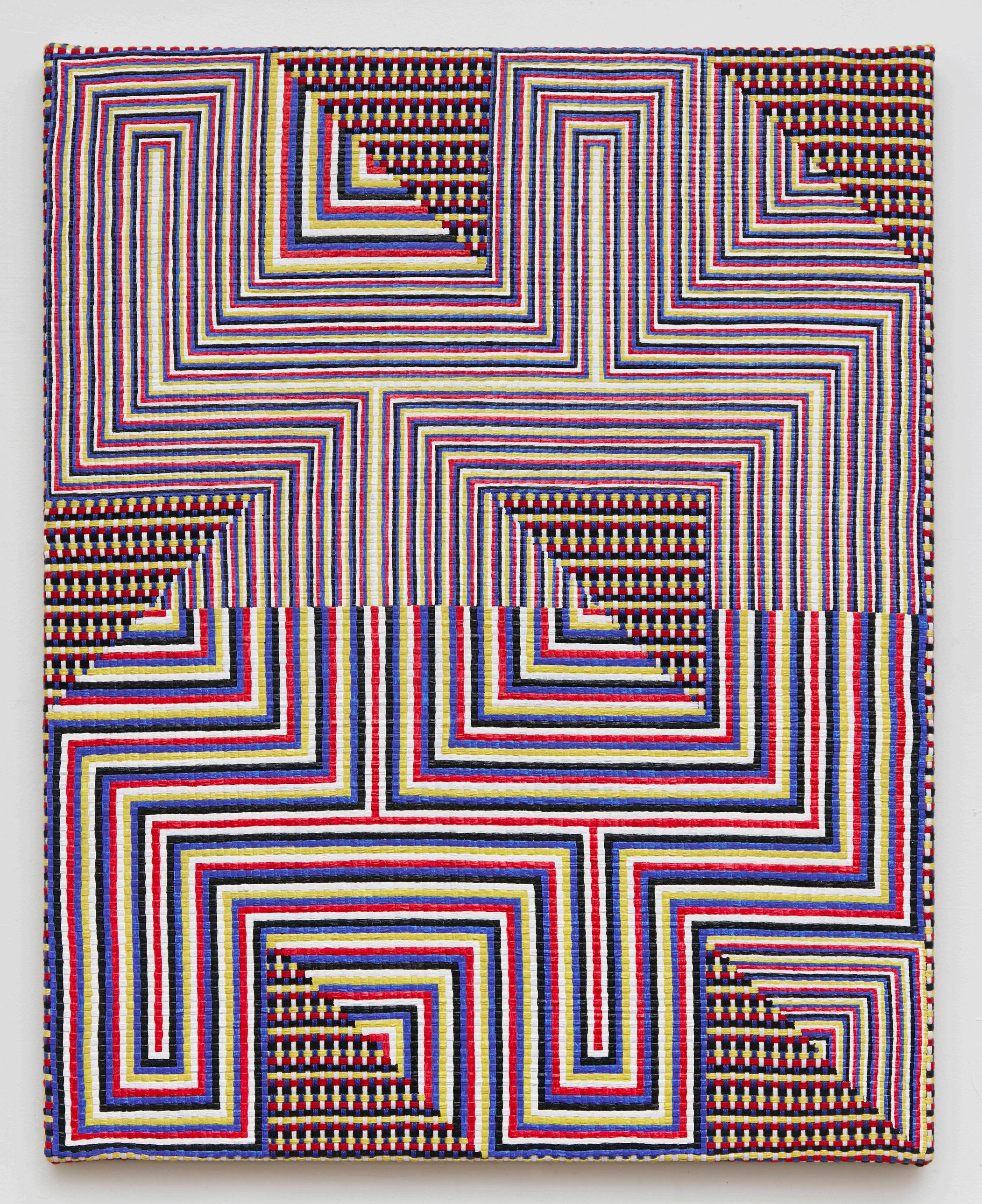
Samantha Bittman’s Untitled (2020) draws viewers into a mesmerizing interplay of precision and tactility. At first glance, the work’s geometric rigor symmetrical lines folding into tight labyrinths of color seems reminiscent of digital schematics or algorithmic patterns Yet, upon closer inspection, the illusion of mechanical perfection dissolves into something far more visceral Handwoven textile stretched taut over a wooden frame betray the labor-intensive process underpinning each rhythmic curve and acute angle The application of acrylic paint adds another layer of tension, masking portions of the woven surface while allowing glimpses of its fibrous texture to pulse beneath
Bittman masterfully juxtaposes the calculated language of geometry with the inherent materiality of weaving, setting up a dialectic exchange between the visual orderliness of form and the physical irregularities of craft.
This tension between the systematic and the sensuous finds a counterpoint in Sol LeWitt’s Wall Drawing #118: 50 randomly placed points connected by straight lines (1971). LeWitt’s conceptual approach abstracts geometry to its purest terms: immaterial, cerebral, and transcendental. The drawing exists less as an object than as a set of instructions, realized anew with each installation. While both artists engage with grid logic and geometric seriality, Bittman’s work resists LeWitt’s near-immaterial idealism Instead, she anchors abstraction within the tangible, invoking the lineage of fiber arts and the embodied knowledge of handwork
~ Giovanni Aloi
Selection from the Art Institute of Chicago collection: Sol LeWitt, Wall Drawing #118: 50 randomly placed points connected by straight lines, 1971

Elijah Burgher MFA ‘04
What is the relationship between decapitation and creativity? Elijah Burgher asks, pondering the myth of Orpheus, the poet, lover, and traverser of the underworld whose fate left him sundered. The juxtapositions contained in Elijah's question (decapitation/creation and thus destruction/formation, expiration/inspiration...) lend it the quality of a riddle. Head of Orpheus responds to that riddle. It's a subtly strange image: the drawing's balanced composition and the calm demeanor of the two nude figures the attentive artist and his languorous lover are in tension with an element of horror: a severed head borne by swirling waters. But it's not only Orpheus's head. It is, Elijah reveals, also the head of Hylas, of Kvasir, and of other mutilated figures, as well as of the artist himself Site of an intense syncretism, the head of Orpheus becomes something of an everyhead And this severed everyhead sings a seductive song from the midst of the silently whorling waters into which the artist's beloved dips his fingers, lost with his companion in a daydream, a folie à deux One may thus wonder: has the image of the severed head been conjured in reverie? Or has the singing head seduced the lovers, luring them to the waters of a dream? But it's not a matter of either/or: the lovers' shared daydream draws forth the severed head even as the head draws the lovers into a little shared madness The coincidence of an artist's inspiration and a poet's expiration resounds with another strange correlation: the linking of decapitation with the psychedelic waters of Paul Gauguin's Mahana no atua (Day of the God), where patches of color seem to shift like blobs in a lava lamp. In the mythic imaginary, water both kills and germinates, dissolving and giving rise to all forms. Water is death and water is life. Water anticipates forms and sustains creation, linking all things by disintegrating each thing. Gauguin's waters are a primordial fundament, a zone of indistinction, the depths of dream and the unconscious, a formless, fluxuous chaos, an amorous realm of fluidity and fusion in which everything comes and comes apart. Another name for this liquid is love, the universal solvent. Love cuts, love liquefies, love dissolves. To lose one's head in the swirling waters of love is to be seduced by the poet's song, inhaling the fermentatious breath of death in the act of conjuring images To draw is therefore to return to the fundament, to sunder oneself, becoming another So what is the relationship between decapitation and creativity? The riddle's solution is dissolution falling apart to come together in a dreamspace where to love is to lose one's head is to draw is to decapitate is to touch the waters of chaos from which all images emerge
~ Jeremy Biles
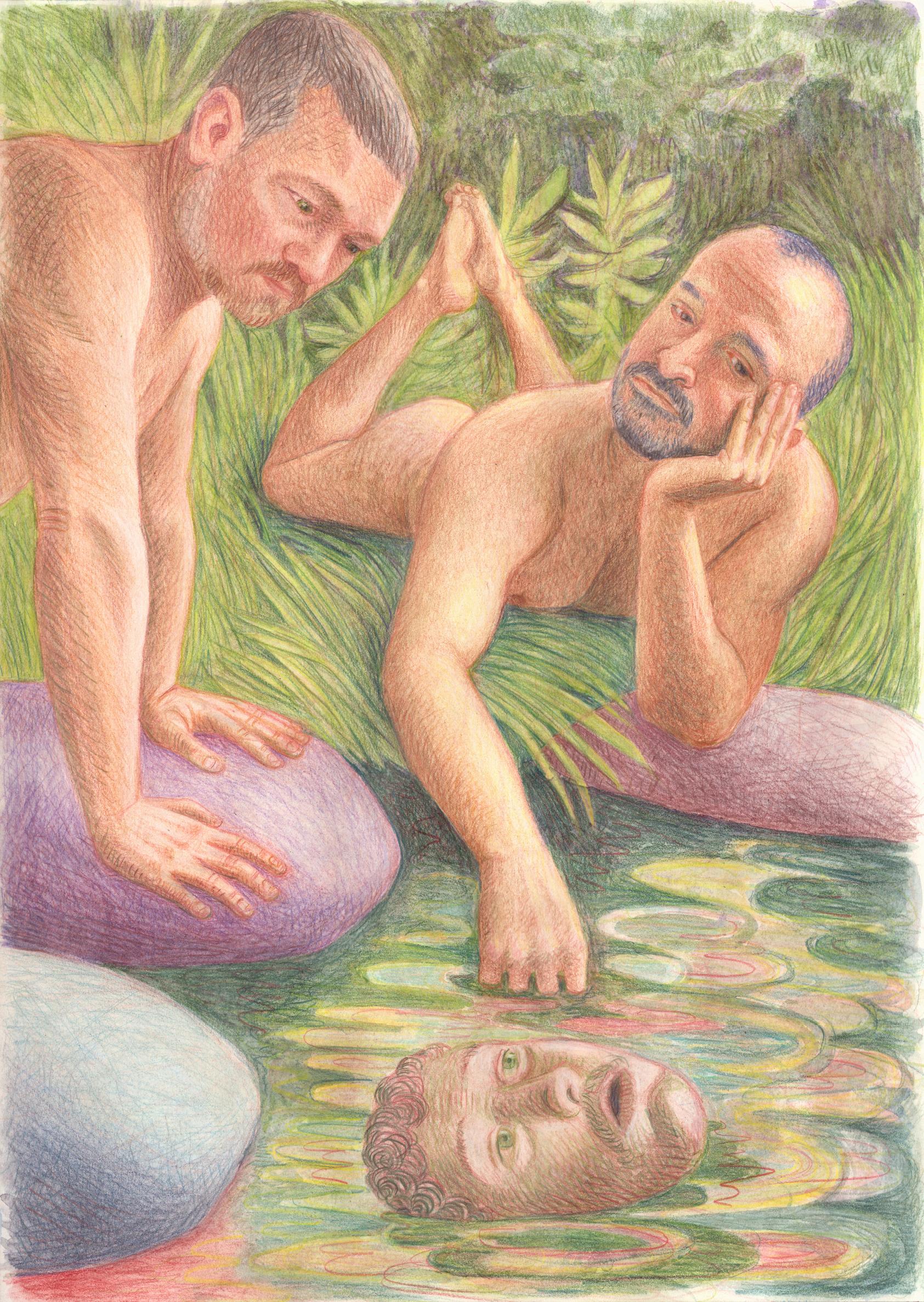


Robert Burnier
MFA ‘16
Matene Mi estos en Ordo, Mia Amiko (Ho Sinjoro), 2022, typifies a working method that Robert Burnier has perfected over the last decade: acrylic color contrasts organized on thin aluminum sheets that are intricately folded, rolled, and crumpled into three-dimensional shapes “Neither painting nor sculpture” or perhaps both painting and sculpture they stage intergenerational conversations with Ferreira Gullar’s “non-objects,” Donald Judd’s “specific objects,” and postwar canons of “expanded painting” that now include Black luminaries such as Alma Thomas, Sam Gilliam and Jack Whitten The work at hand implies a series of inward folds from the corners of a flat sheet painted creamy white such that it resembles paper, that material opposite of metal The folds proceed in a counterclockwise spiral, building the work’s thickness, until a final flap, the only one painted ochre, folds over itself.
Teasing out the yellow nested in such a warm off-white, the ochre helps, in Burnier’s words, to “expand the sensitivity of color” via pairing or relationship. The artist’s selection from the Art Institute, Matteo di Giovanni’s The Dream of Saint Jerome, 1476, also models such contrasts, if we can look past representation to apprehend form. Coral-colored squares comprising the floor in the foreground pop against the dark grey rectangles of the upper two-thirds of the painting, decorating its walled background and yielding a shallow overall space for the figures. Ochre functions as an accent, clashing in different hues, against the coral as the color of four of the figures’ boots. In Saint Jerome’s dream, he is lashed by a heavenly council for preferring Greek and Roman sources to the Christian Bible a curious admission of guilt that nonetheless celebrates the Italian Renaissance’s revival of pre-Christian culture Christ seated in judgment on the far left decenters the vanishing point to the fountain at Jerome’s right, a sign of the destabilizing tension between oppositional modes of belief and representation
Burnier’s title is Esperanto for “In the morning, I’ll be alright, my friend (oh Lord),” a line from Marvin Gaye’s song “Flyin’ High (in the Friendly Sky).” Gaye’s song is also dialectically fraught, oscillating between the misgivings and hope associated with addiction:
“In the morning, I’ll be alright, my friend
But soon, the night will bring the pains
The pain, awful pain”
Esperanto is itself the linguistic site of a failed universalist project, a language made up of all other languages, something like a false or failed synthesis Yet failures haunt us because their dreams were unfulfilled and as such, could someday return when the world is ready
~ Daniel R. Quiles

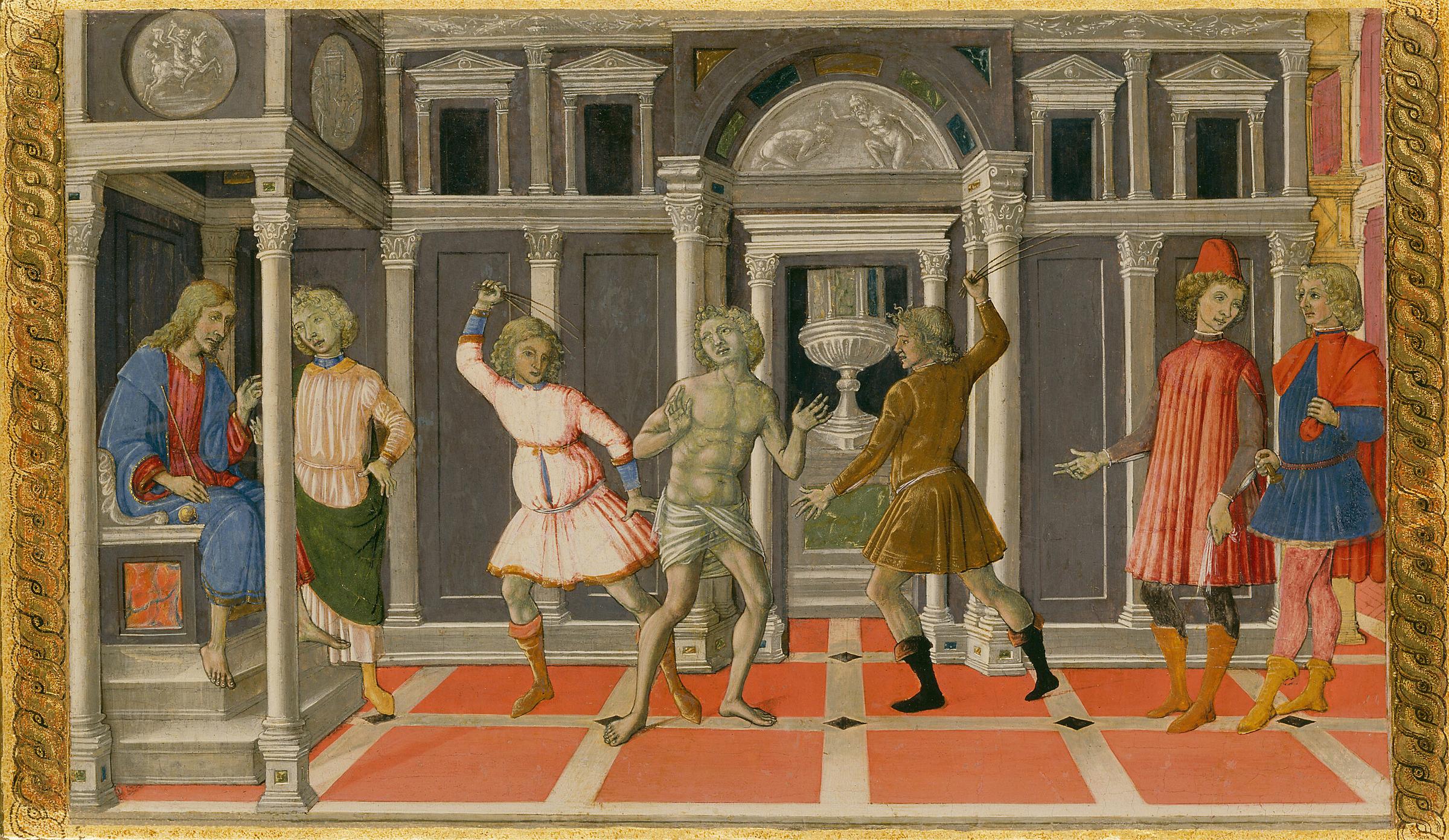

Nik Cho
BFA, MFA ‘24
Nik Cho dreamily renders spaces like bars and banks of bathroom urinals in hot, vibrant warmth played against breathy blues, wicked greens, and flushes of orchid violet Populating these scenes are couples or groups of svelte young men rendered like Yves Saint Laurent fashion plates, each one pulsing with hesitant yearning Checkers, stripes, flouncy drapes, and radiant red grids translate the libidinous narratives of paintings like Cho’s Be Yourself No Matter What They Say, 2024, into flashing arrays of seductive color, pattern, and mood lighting akin to the color drenched vignettes of Barry Jenkins’ 2016 film Moonlight. That David Hockney and specifically Hockney of the 1960s would serve as inspiration for Cho’s work is evident; in fact, the youthful nerd twink Hockney of the late sixties with a taste for color-clashing striped jumpers would fit in with Cho’s tender boys with hands on each other’s thighs.
While it should be noted that many of Hockney’s paintings in the 1960s, after his relocation to Los Angeles, depict naked men in showers (sometimes together) and in bright-and-sunny backyard pools, as well as the bare-assed slumberer in The Room Tarzana, 1967, and a portrait of Christopher Isherwood and his partner Don Bachardy, painted in 1968, the same year as the Institute’s Hockney, the comparably more staid and conservative portrait of renowned art collectors Fred and Marcia Weisman in Hockney’s American Collectors, 1968, nonetheless share some of the ontological propositions that accompany Hockney’s depictions of figures embedded in and continuous with the spaces where we observe them Synthesizing the effects of the wide use of photography on new understandings about painting, with the legacies of abstracted figures from Hopper, Vuillard, Milton Avery, Tamara de Lempicka, and Marsden Hartley Hockney gets to LA amid a swinging sixties reckoning around the inciting flashpoints of Gay Liberation (not to mention protests of the US’s military involvement in Asia in and around Vietnam and organized Civil Rights movements). Sixty years hence, Cho’s paintings proceed from the risks and courage that were called for in that time to imagine, constitute, and inhabit shared spaces of belonging and intimacy like those he depicts.
Matt Morris
Selection from the Art Institute of Chicago collection: David Hockney, American Collectors (Fred and Marcia Weisman), 1968
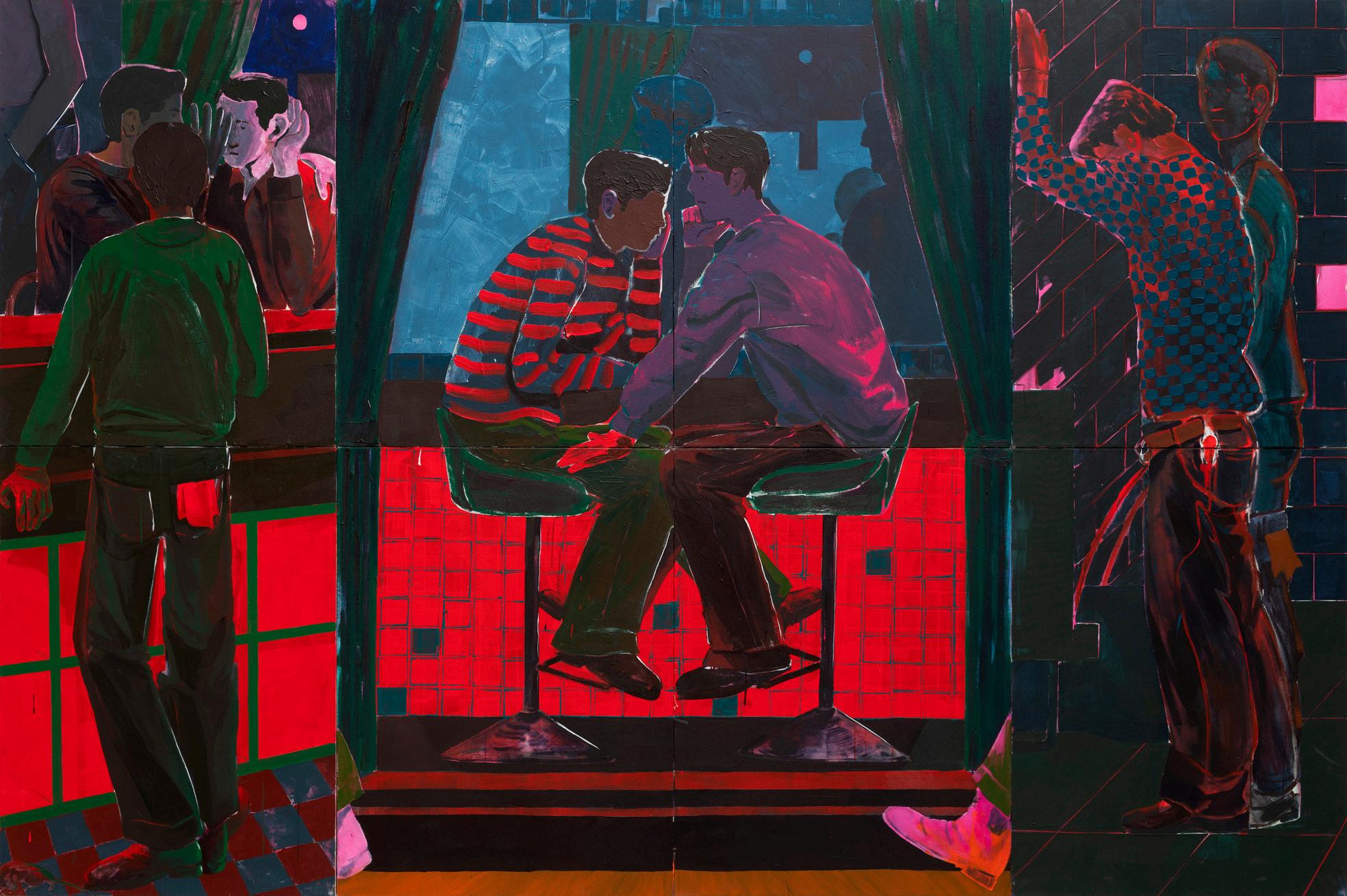
Be Yourself No Matter What They Say, 2024


BFA ‘14
I’ve always loved The Wedding, a tiny yet luminous painting by Jacob Lawrence from 1948. Its presence in the darkened galleries of the American wing brings light and optimism to America's complicated past.
The Wedding is a small painting, yet its colors are bold and its light is luminous. Its figures are rhythmic, and delight in rhyme with their environment Its narrative and scale is accessible Yet it’s not a setting and situation one comes across accidentally, both in its form and presentation this moment is cared for by both the artist and everyone involved in this wedding
I’ve been shaped by Jacob Lawrence’s ability to narrate a scene with such economy His openness and generosity is depicted through his ability to construct and depict scenes of everyday life with such simplicity In my own painting, Library #1, I attempted to weave an image together to depict a moment in time, using color and shape in similar ways.
This is what I’ve yearned for as an artist, to make images that evoke a sense of belonging, specifically a sense of belonging across difference. Jacob Lawrence is painting the African American experience during the great migration and Harlem renaissance; I’m painting multicultural America with all its internal conflicts and all its attempts at tolerance and solidarity.
Like Jacob Lawrence’s The Wedding, I hope that Library #1 can be an invitation to experience a sense of belonging, if only for a moment in time.
~ Alex Bradley Cohen Alex Bradley Cohen
Selection from the Art Institute of Chicago collection: Jacob Lawrence, The Wedding, 1948
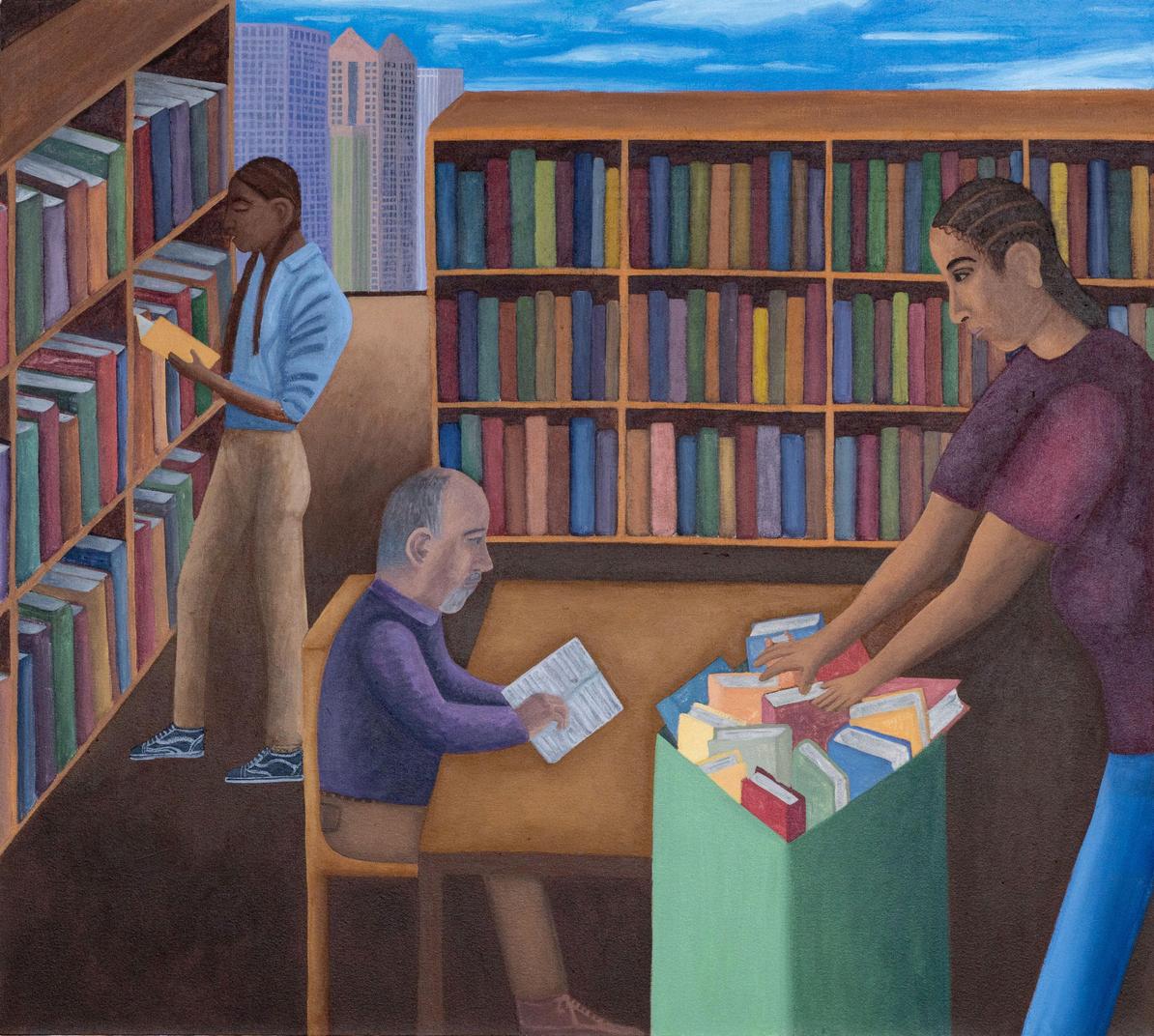


Jeane Cohen MFA ‘18
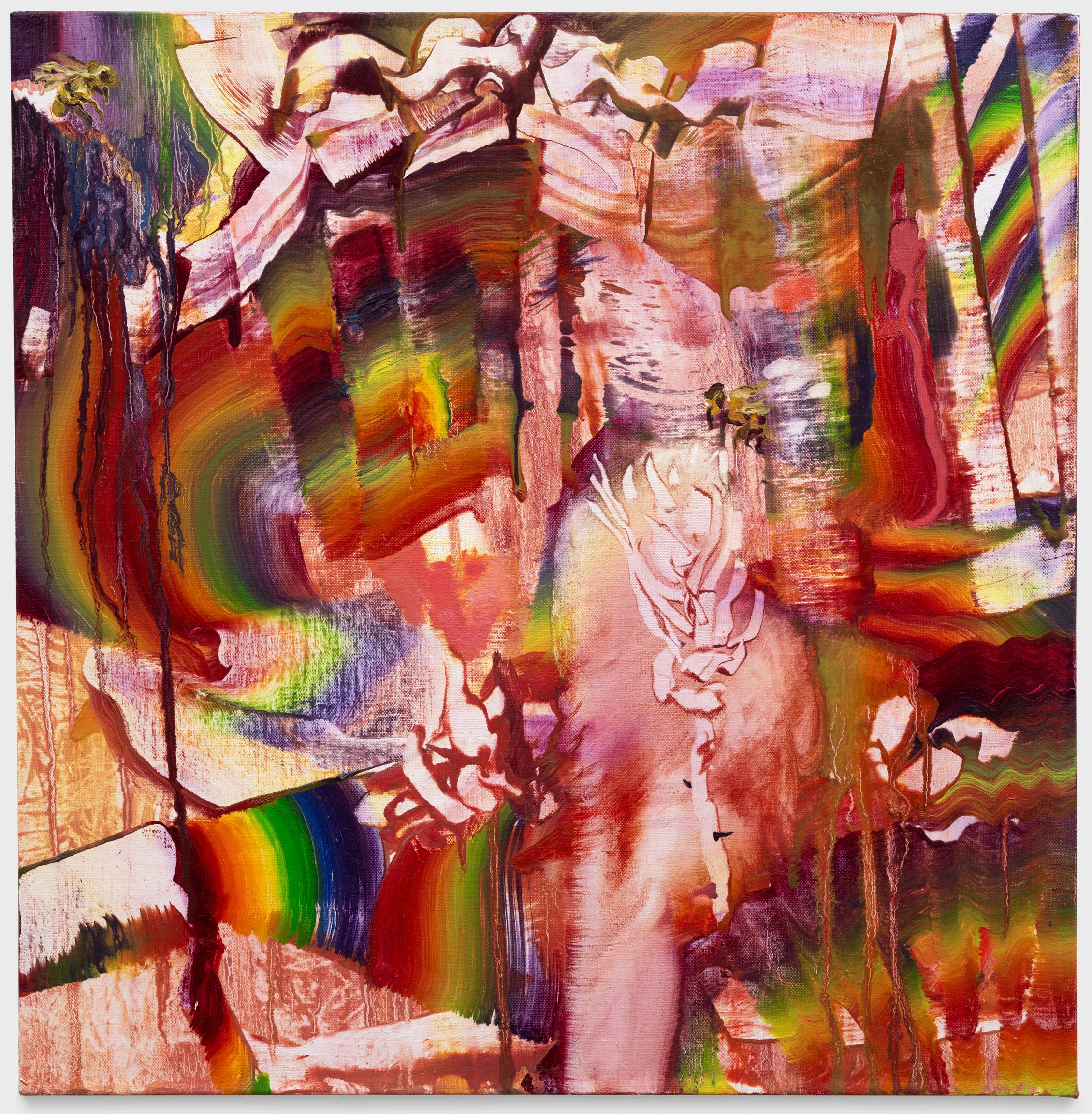
Layers of vibrant pigment cascade across the canvas, eschewing the delicate containment traditionally associated with botanical depiction. Cohen’s Rose Garden (2022) channels the energy of gestural abstraction to deliver a visceral reimagining of floral subject matter, invoking a sense of vegetal becoming roses not as delicate, idealized beautiful forms, but as shifting, dynamic entities, imbued with an elemental vitality that exceeds their visual likeness The artist’s handling of paint rejects decorative prettiness, opting instead for eruptions of color and texture that push the boundaries between growth and decay, chaos and cohesion
This approach finds resonance in Joan Mitchell’s City Landscape (1955), a work whose sweeping, luminous gestures shaped the remit of mid-century abstraction. Like Mitchell, Cohen treats the canvas as a living field a space in which paint encapsulates force, movement, and memory. Cohen’s palette dense crimsons, smudged greens, ephemeral pinks suggests petals, stems, and soil, without ever slipping into overt figuration. Here and there, among the free brushwork, fragments of floral anatomy emerge and dissolve into an organic flow.
In Rose Garden, abstraction frees its vegetal subject from the shackles of western iconography: the roses are stripped of their ornamental veneer, reconstituted as processes of flux and transformation. Cohen’s work inherits Mitchell’s liberatory aesthetic language but extends it toward a deeper inquiry into the essence of the vegetal, where form dissolves into sensation, and the garden blooms outline an unruly, immersive dimension rather than an object to behold
~ Giovanni Aloi
Selection from the Art Institute of Chicago collection: Joan Mitchell, City Landscape, 1955

Paula Crown MFA ‘12
Paula Crown confronts the days that lie between Not the first day That is the Word the first touch, first mark, first sign, the first “in the beginning ” Not the last That’s the hour no one knows, a whitewash when dreams return to dust
Her painting Where Does Time Go? (2016) features churning layers of words, equations, colors, and brush strokes, each demanding attention before sinking below. As soon as I noticed the word “time,” I looked past it – she formed the letters with a negative typeface outlined by choppy strokes of white acrylic paint. She left the linen weave exposed in some areas and filled others with eight flicks of black paint, two blue marks, a red heart, and four more patches of red that vary in thickness and tint. Yet even these human touches struggle to endure.
Crown focused on revealing the destructive force of entropy through mathematics and markmaking. The term “entropy” appears at least once in what seems to be her actual handwriting, the same cursive script she might use to send condolences to a friend. This intimate moment, however, doesn’t reveal more than the impersonal equations Each touch blends emotion with belief
Sure, there’s a bit of René Magritte’s paradoxical give-and-take in any painting that challenges communication or, really, in all art that explores the contradictions of meaning But Crown doesn’t share Magritte’s sense of nihilism After we spoke, she forwarded a poem by David Whyte that resonates with the lament of Where Does Time Go? “I want to know / if you are willing / to live, day by day / with the consequences of love / and the bitter / unwanted passion of your sure defeat.” Here, the holy fall to their knees.
~ David Raskin
Selection from the Art Institute of Chicago collection: René Magritte, The Tune and Also the Words, 1964
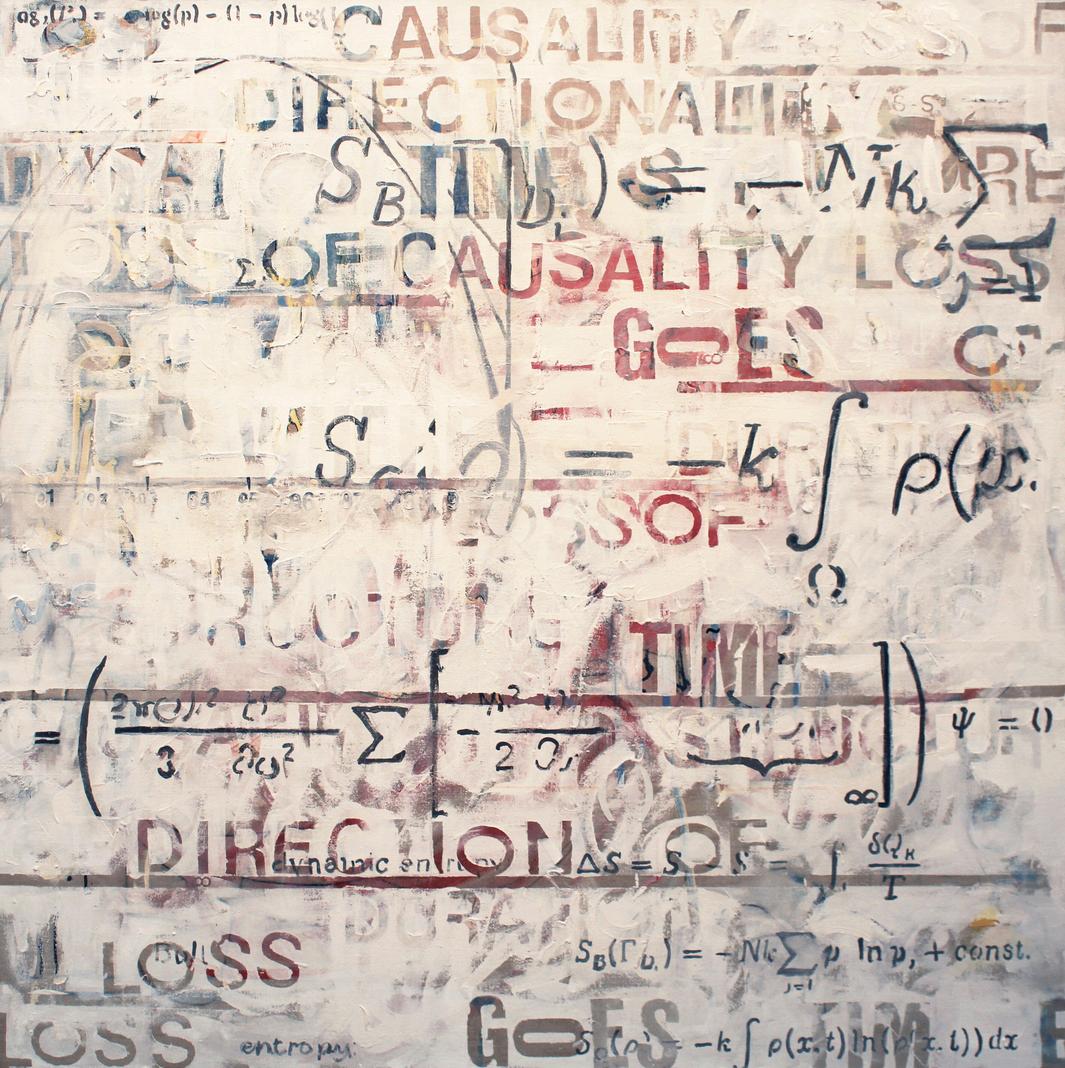
Where Does Time Go?, 2016
Chelsea Culprit
MFA ‘07
Bird’s-Eye View: Chelsea Culprit’s Devil’s Garden Escalante
Chelsea Culprit paints with an awareness of art history’s long shadow while simultaneously guiding us toward an experience of bodies as landscapes. Her work captures lived experience, emphasizing how each body contains a world how a body can become a monument, an archetype Inspired by the sandstone formations of Utah’s Devil's Garden, Devil’s Garden Escalante (2023) portrays dancers transformed into public monuments, imagined as geological formations
For over a decade, Culprit has explored representations of the dancer, the nude entertainer, the sex worker this recurring female figure allowing her work to evolve alongside her own experiences. Her figures have shifted from depicting particular dancers, as in Slow Monday (2014–2016), to becoming monolithic, standing in for others. “They’re like a feminist Mount Rushmore,” she explains of the figures in Devil’s Garden Escalante. Rather than being shaped by artificial adornments like plastic shoes, earrings, and synthetic hair, they emerge organically, built up over time like layers of sedimentary rock.
Having lived in Chicago for many years, Culprit considers the paintings at the Art Institute of Chicago to be her root influence particularly Edgar Degas’ The Star (1879/81), a work she returns to when reflecting on representation. “This is a man painting ballerinas but why?” she asks The painting raises questions: Who is looking at the dancer from this vantage point? Another ballerina? An instructor? A patron? Having trained in tap, jazz, and ballet herself, Culprit wonders whether she is the subject or the artist: “How do I represent myself if all the depictions of me are created by others?”
She approaches artists like Degas, Henri de Toulouse-Lautrec, and Pablo Picasso with an initial appreciation for color, technique, and paint handling fully indulging in their visual pleasure But beyond that, she interrogates their deeper implications: What does this painting mean to me? Where do I situate myself within it? Their aesthetics are inseparable from the power dynamics and socio-political constructs that define bodies in space. These artistic choices are not neutral; they embody the structures that shape representation itself.
Ionit Behar


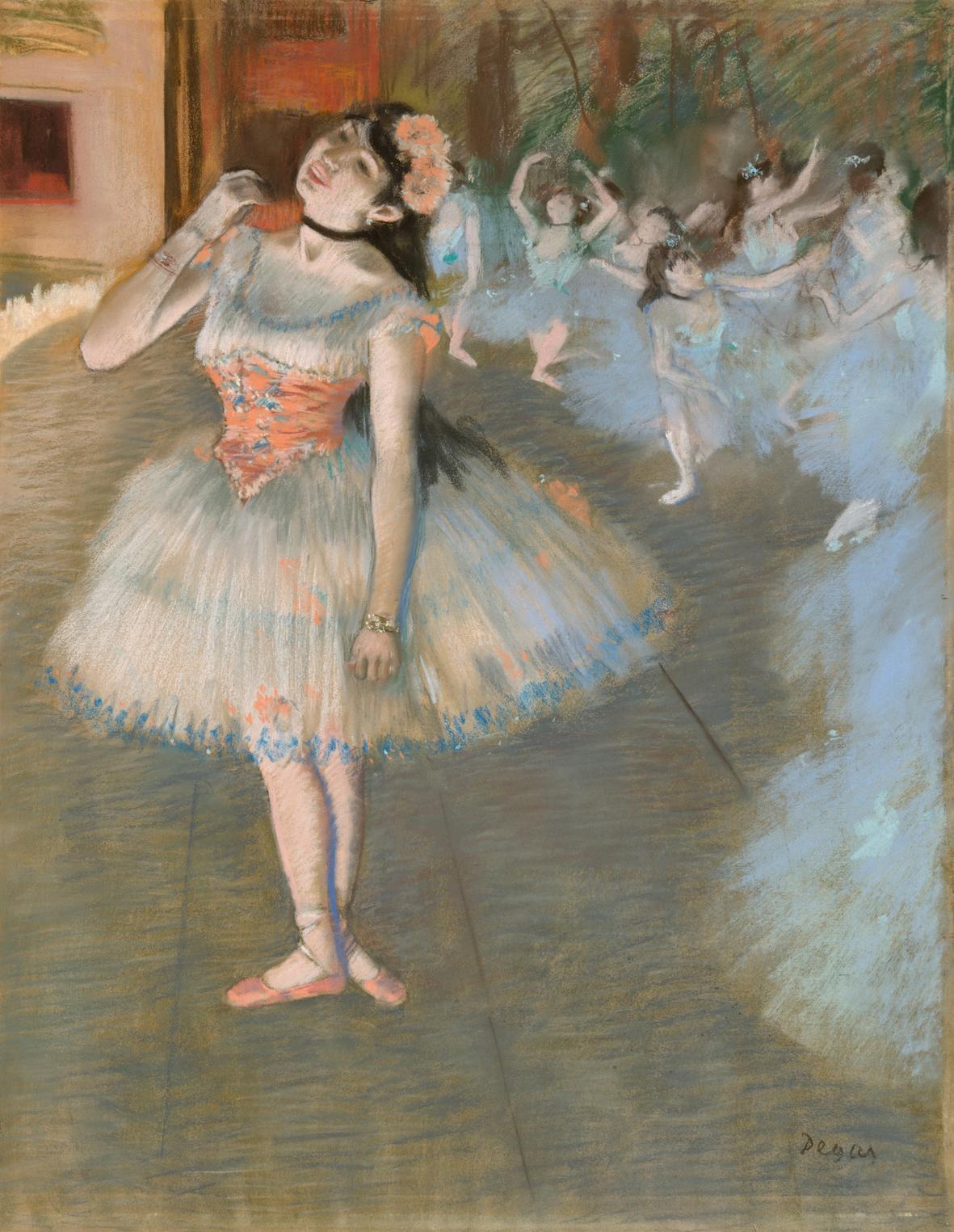
Selection from the Art Institute of Chicago collection: Edgar Degas, The Star, 1879-1881
Tavin Davis MFA ‘23
A quiet, contemplative expanse, where soft pastel hues, thickly textured clouds, and vacant horizons evoke not only the vastness of physical landscapes but also the fragile architecture of solitude. Davis’s restrained brushwork underscores the precarious balance between isolation and introspection, drawing from a deeply personal relationship with the rural vastness of Montana. For Davis, the horizon operates as both boundary and threshold a liminal line imprisoning and preserving, an emptiness that paradoxically shelters the self The layered surfaces of his painting, built from oil and wax, become traces of endurance, marking time in the remote spaces he describes as simultaneously oppressive and sacred
This charged stillness finds an echo in Georgia O’Keeffe’s The Black Place (1943), a canvas encapsulating the vision of the barren New Mexican desert she adored O’Keeffe’s landscape, too, is devoid of human presence; her smooth, rolling forms border abstraction, speaking to the reductive clarity she sought in nature and in herself. For O’Keeffe, the desert was not merely scenery but a sanctuary an external mirror for internal solitude, an arena for self-reckoning and a shelter to retreat.
A trait that aligns the approaches of both artists might lie in their ability to transform the landscape into a terrain of the psyche, where vast emptiness becomes a conduit for reflection. In Davis’s painting, as in O’Keeffe’s, isolation is neither alienation nor loneliness but a heightened presence a solitary encounter that reaches into the depths of more than scientific archaeological registers, revealing a landscape as much of the soul as of the earth.
~ Giovanni Aloi
Selection from the Art Institute of Chicago collection: Georgia O’ Keeffe, The Black Place, 1943
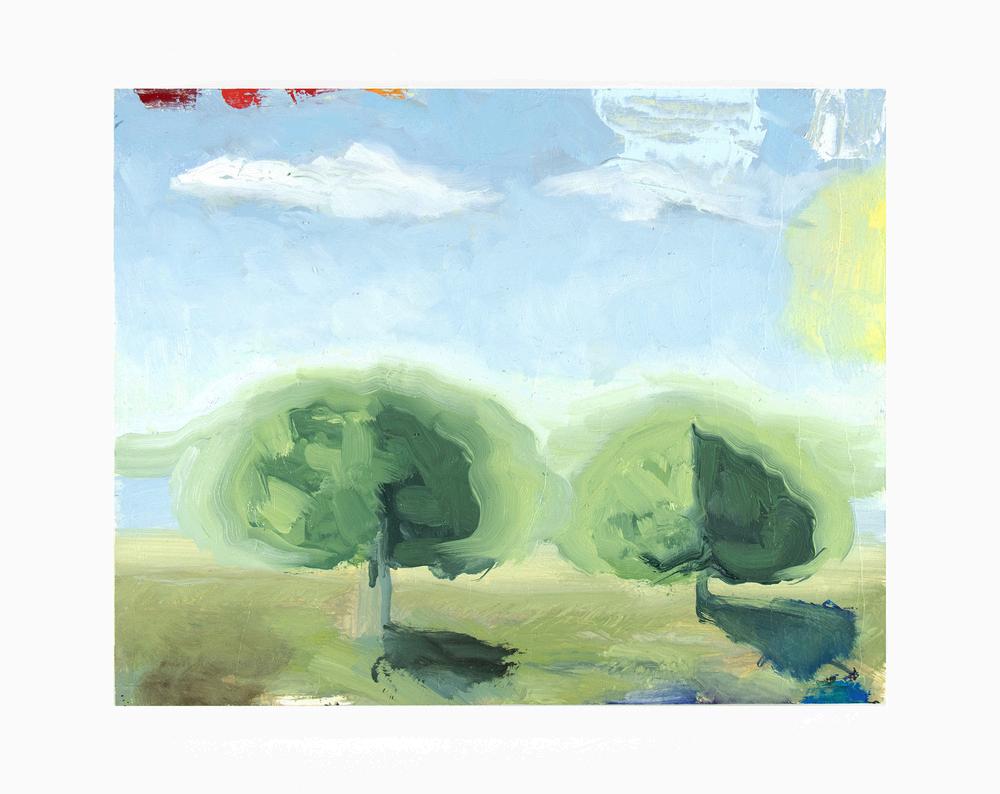
First row, left to right:
Day 68: Good Company, 2024
Day 83, Stone Cold, 2025
Day 71: Everything I've Ever Said, 2024
Second row:
Day 70: November's Actually Pretty Good, 2024
Day 67: The Painting Fell Into My Palette, 2024
Day 85: Care Free and Brain Dead, 2025
Third row:
Day 75: Bite Me (In Iridescent Blue), 2024
Day 49: Every Hour is Happy Hour, 2024
Day 74: Christmas, Texas, Alexander Beetle, 2024
Fourth row:
Day 53: Not Nature, Not Illustration, Not Picturing, Not Culture, Not Observation, Not Memory, Not Fiction, and Certainly Not Ironic, 2024
Day 64: The Worst October (Reflecting on the war in Gaza), 2024
Day 72: Visitor Center, 2024
Fifth row:
Day 73: The Big Rock Candy Mountains, 2024
Day 69: Laughing with a Stupid Face, 2024
Day 82: Behind the Sky, 2025
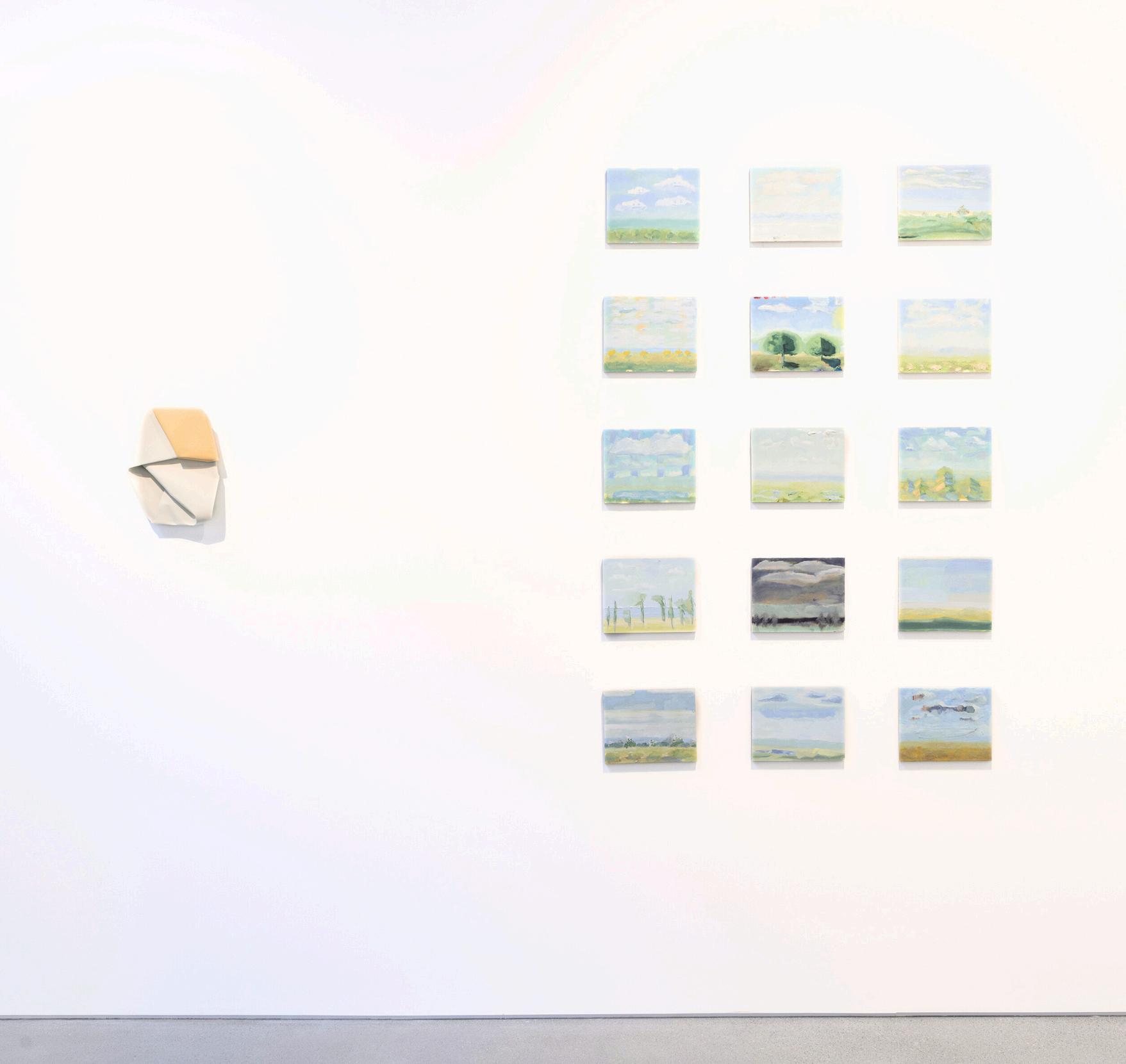
Dana DeGuilio MFA ‘07
“Lovely and ugly like a Tuesday morning”: On Dana DeGiulio’s paintings
Dana DeGiulio’s paintings engage with materiality in a way that feels deeply honest, unpretentious, and direct. They do not strive for grandiosity or self-importance but instead embody a kind of radical humility. Like an open system, these paintings are porous, responsive, and aware of their own limits. There is a kind of disembowelment at play, not in the sense of loss or destruction, but as an intentional refusal to be neatly packaged or resolved. The paintings hold space for doubt, embracing the messiness and unpredictability of material engagement. They are a deconstruction full of possibility, an undoing that carries with it a kind of optimism. In this space, painting is not about coherence but about presence and the physical existence of things This approach to painting rejects traditional notions of mastery; rather than trying to be something fixed or finished, DeGiulio’s work remains fluid Her paintings grapple with the scale of the individual in relation to larger structures “ no one makes anything alone,” DeGiulio explains
Man Ray’s Percolator (1917), housed in the Art Institute of Chicago’s collection, is what DeGiulio calls her “favorite painting ever. ” It is a small, enigmatic work that defies easy classification simultaneously ugly and beautiful, awkward yet eye-catching. For DeGiulio, its appeal lies in this contradiction, in its ability to hold opposing qualities in tension without resolving them. She describes it as being “lovely and ugly like Tuesday morning.” There’s a raw honesty to the comparison, a recognition that beauty isn’t always about polish or perfection but about something more lived-in, more real. Percolator, like DeGiulio’s paintings of roses, skulls, lemons, Judy Garland portraits, and more roses, don’t insist on significance or strive for grandeur; instead, they linger in the space of the everyday, embodying the strange, unglamorous poetics of ordinary but deeply felt experience.
~ Ionit Behar
Selection from the Art Institute of Chicago collection: Man Ray, Percolator, 1917
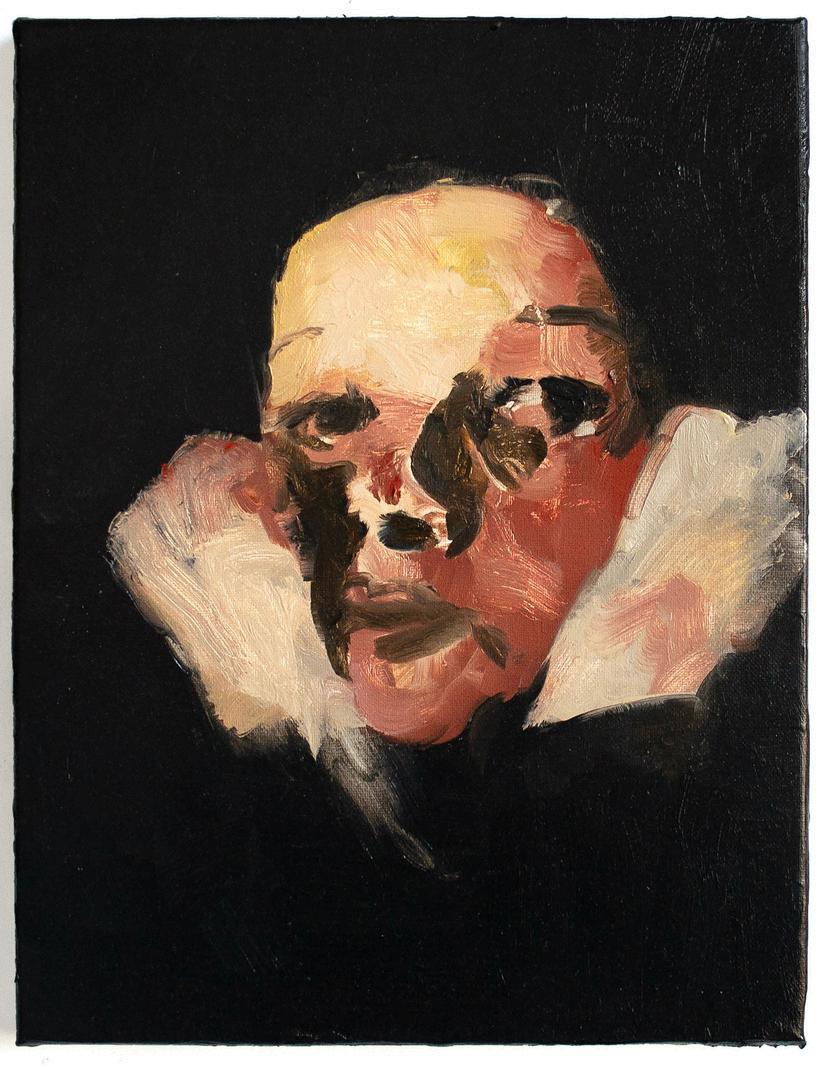
Austin Eddy BFA ‘10
In Sky Above Clouds, O’Keeffe’s iconic skyscape, we see pastel orderly heavens, each cloud like a stepping stone to a shared vision. We recognize it. And yet, it’s better than anything we ’ ve actually seen from the window seat of an airplane. The wind effaces every cloud, changing it by the second, imperfect ovals But O’Keeffe has arrested that slow effacement, we are steady in her vision, we exhale The palette soothes with its serene blues, greys, whites, and pinks The hues of infant clothing, the pillowy softness
In Austin Eddy’s Full Moon, A Summer by the Sea, sea snakes wind through the moonlit sea, the opposite horizon from O’Keeffe’s lit sky And yet the pastels in both paintings reflect each other only Eddy’s mountain range hints at a darker essence. The pinkish halo around Eddy’s moon echoes O’Keeffe’s horizon line. The stony moon ’ s reflection becomes a pale peach in the sea. What’s below the surface in Eddy’s vision creates a full circle with what’s sky-high in O’Keeffe’s.
Maybe Georgia’s heaven is a careful symmetry of cumuli. Maybe Austin’s heaven undulates with seaweed and moonglow.
Eileen Favorite
Selection from the Art Institute of Chicago collection: Georgia O’Keeffe, Sky Above Clouds IV, 1965


Stephen Eichhorn
BFA ‘06
In the aesthetic dissonance these images embody a lush, algorithmic bloom by Eichhorn and John Pfahl’s meticulous intervention on a weathered shed lies a shared meditation on the nature of seeing. Eichhorn’s floral construction, radiant against black, is an orchestration: botanical forms layered, spliced, and re-strung with a precise digital cadence. Lines slice horizontally through the garland, suggesting a latent rational system beneath the organic. Pfahl’s image, Shed with Blue Dotted-Lines, Penland, North Carolina from 1975, feels more reticent, yet no less deliberate. The blue dotted line punctuates the old doors like annotations, suggesting fields or trajectories, gently tampering with the supposed objectivity of the lens. In both works, there is a refusal to take the world at face value. Instead, what’s offered is a reconsideration of the photographic act as one of inscription, of undoing appearances to let artifice and order quietly emerge.
In both, the gesture is not about deception, but about attention Eichhorn and Pfahl do not impose upon the world; they enter into dialogue with it One through a digital baroque, the other through mark-making Their works remind us that an image is never passive It is constructed on intentional choices, cropping, framings, contiguities and interruptions
To see, then, is to intervene And in these subtle interferences floral, chromatic, linear we are drawn into the artists’ patient choreography: not of what is, but of what might be glimpsed when the eye lingers, when vision becomes an act of thought.
~ Giovanni Aloi
Selection from the Art Institute of Chicago collection:
John Pfahl, Shed with Blue Dotted-Lines, Penland, North Carolina, 1975
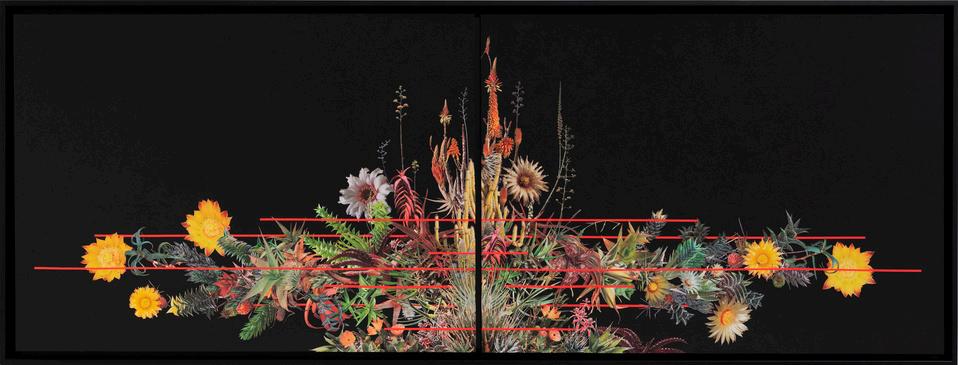
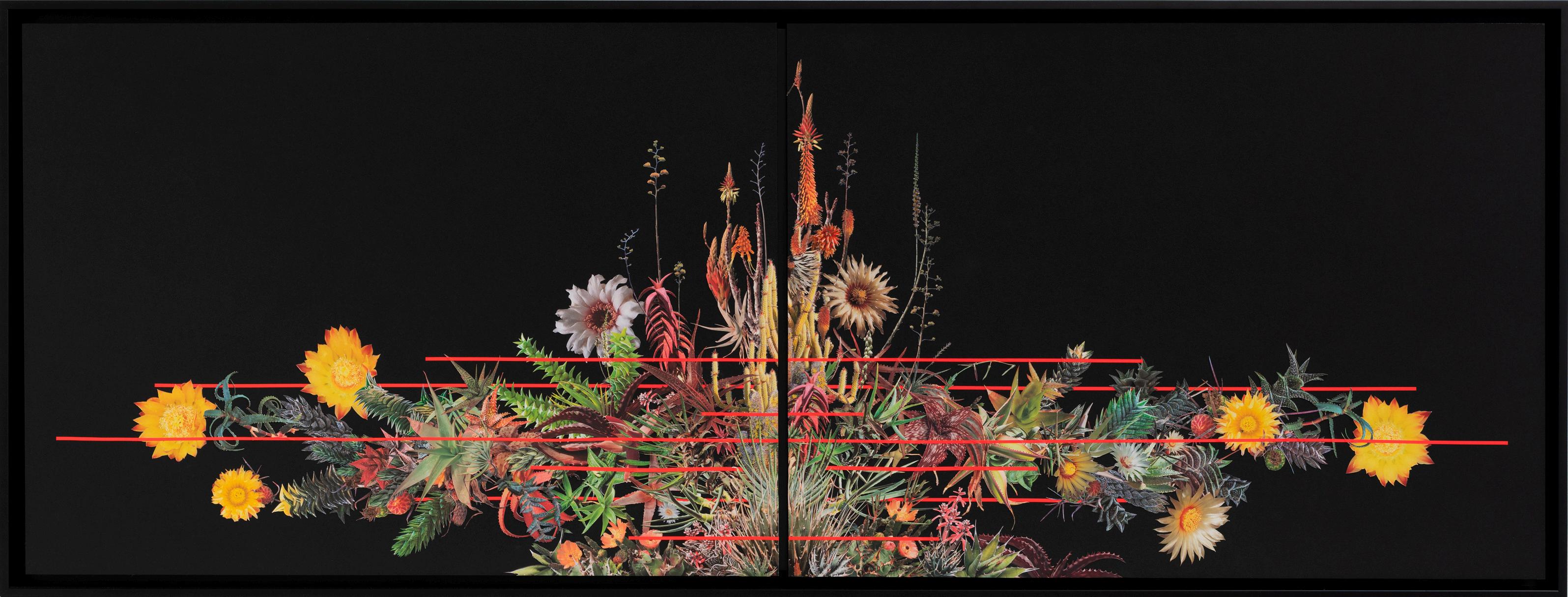

Peter
Fagundo MFA ‘02
In a 2024 interview, Peter Fagundo called painting a place to pose questions and take risks Fagundo engages Matisse’s Bathers by a River (1917) to question and redirect risk
Bathers, Fagundo’s interlocutor, was an unsettling shift for Matisse. In Bathers, Matisse sampled Cubism, and himself layering elements, over time, forcing viewers to look askew. Bathers, completed, differed from the original concept. Experts have concluded that Matisse reconfigured Bathers between 1909 and 1917 by overlaying rigid wide vertical breaks to parse canvas. One vertical column break, eventually black, was a blue river. This palimpsestic foundation undergirded the gradated transformation of a more conventional (i.e., safe) pastoral painting with five nude women into a more-Cubist painting with four nude female figures appearing stone-like. Matisse arrayed female figures, legibly abstracted, in the completed work within a thriving river landscape, with one woman being headless.
Inspired by Bathers, Fagundo’s Bone Machine (2024) also rests upon sampled layers Bone Machine, like Bathers, is parsed, but not with columns Instead, Fagundo’s piece has two curvilinear vertical lines referencing three pairs of curvilinear lines on the right side of Bathers Other more horizontal curvilinear lines intersect with these lines Within the spaces created by intersection are abstracted shapes sampling breasts in Bathers
Notable in Bone Machine is Fagundo’s inserted sample of Helmut Newton’s Viviane F, Hotel Volney (1972). The inset a painting of a photograph within a painting injects sex-gender into Bone Machine but without the risqué edge, making Newton a feminist bogeyman.
Then there’s Fagundo’s tricky titling: Bone Machine. The Pixies have a 1988 album, and Tom Waits a 1992 album, titled Bone Machine. Further, Bone Machine, the painting, was part of a 2024 Fagundo show with his very alive painter son, Jake, titled Ours is the Hand that Slows Time. The title references Zeppelin’s classic “All My Love” (1979) about the death of Robert Plant’s young son.
Putting together Fagundo’s Bathers cite, Newton reference, and titling, one thing is clear: Matisse and Fagundo keep us returning by posing imbricated questions on canvas inviting, and daring, us to reply with venturous angular retorts
~ Patrick Lynn Rivers
Selection from the Art Institute of Chicago collection: Henri Matisse, Bathers by a River, 1909–17

Nicola Florimbi MFA ‘24
A child appears backed against a wall, eyes cast away. The skewed perspective leaves the young child vulnerable; a teacher-student relationship is a power dynamic Nicola Florimbi explores in much of her recent work. The table, with its clean lines and confident angles, asserts itself as more grounded than the human figure. There is a pull to the bottom left corner one that the student gazes away from, but anxiously aware of, as it it may be one of her own psyche’s making.
Conversely, in The White Tablecloth (1731-32) by Jean Siméon Chardin, we encounter a more meditative tableau with its limited color palette and diffused light gently illuminating a delicately rendered tablecloth against a backdrop of almost imperceptible gradient darkness The knife teeters off the table’s edge; a glass lies knocked over The presence of human touch is palpable recent, yet absent leaving only the echo of a scene once lived As much as it invites narrative, the piece remains performative, elevating the everyday to a quietly dignified stage
Objects in Chardin’s painting never feel arbitrarily placed The glass, the food, the knife each element seems to justify the languid slide of the white cloth, as though choreographed to highlight a certain drama. Is this the staging of indulgence, the afterimage of a humble meal, or a ghostly residue of social ritual? In Measure Up, Florimbi’s cluttered desktop signals the precariousness of her mise en scéne, felt to be rushed or overwhelming.
Both interiors suggest containment, though their atmospheres differ entirely. Chardin offers the elegance of the mundane, his still life inviting a kind of imaginative delight the viewer free to speculate on what came before or after. To imagine in Chardin’s still life is titillating; to do so with Florimbi’s painting builds empathy, and possibly prompts a viewer’s own anxious turn inward. Where Chardin’s objects stand in for a quiet human absence, Florimbi renders the psychological residue of presence charged, claustrophobic, and emotionally acute. Hers is a space alive with quiet dread and the urgent desire to ‘ measure up ’
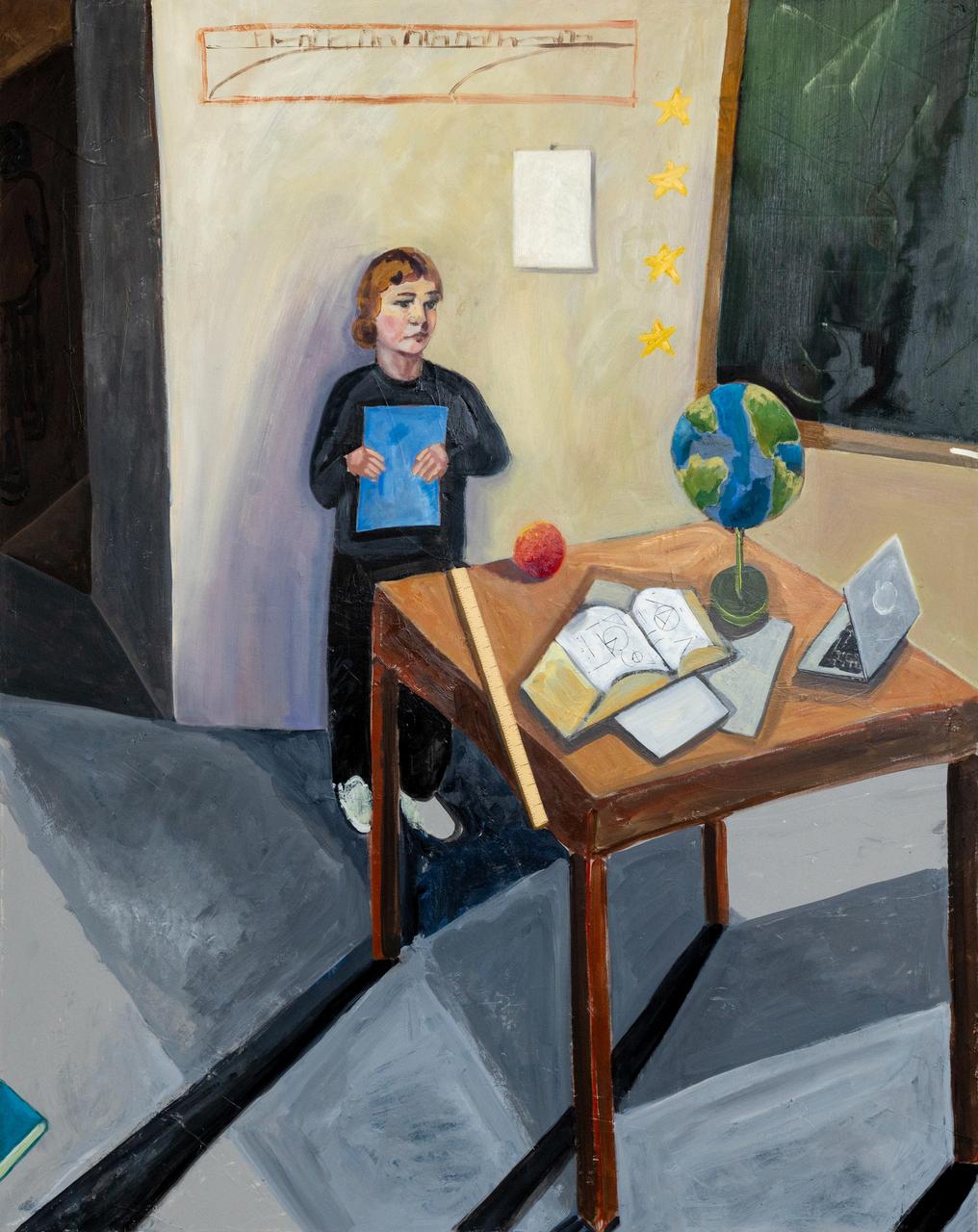
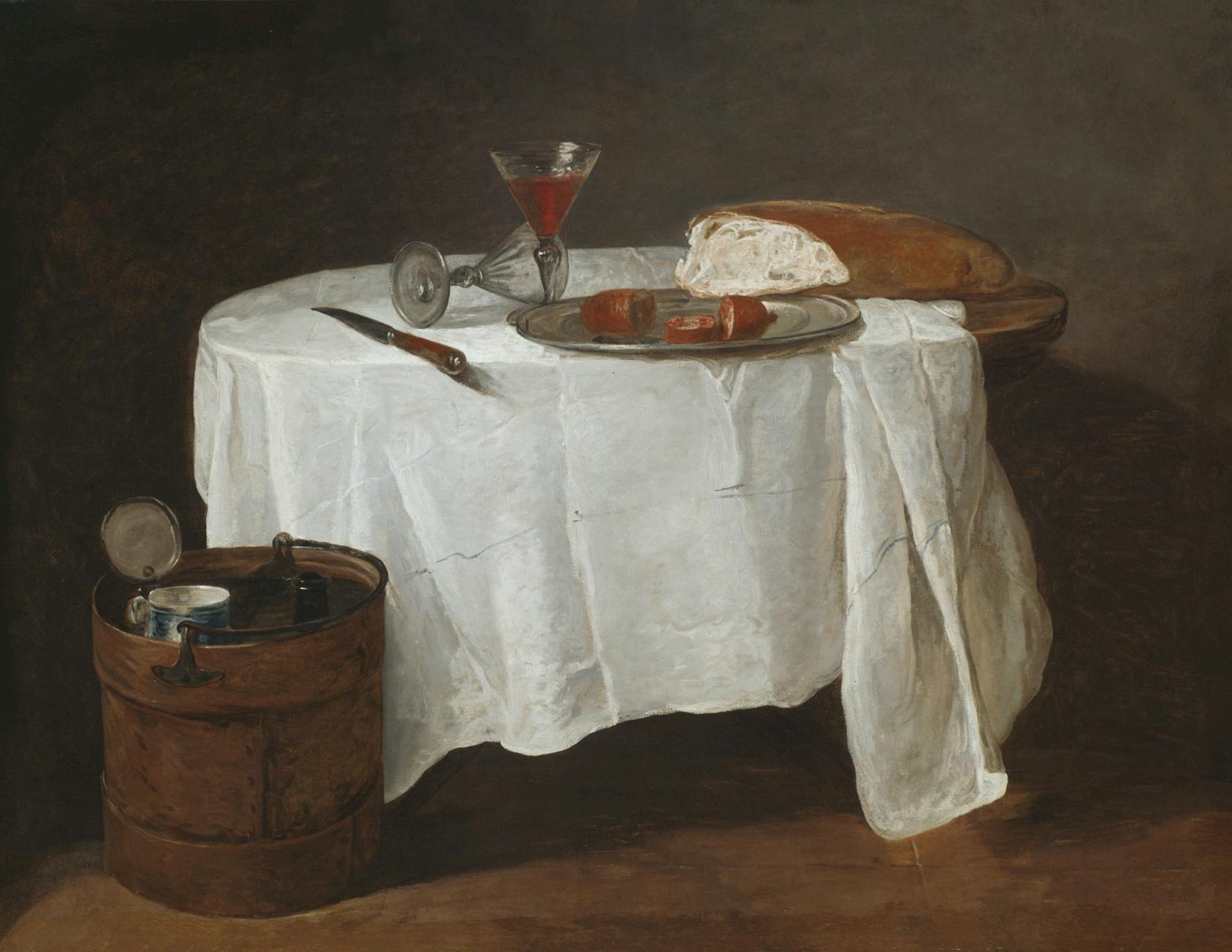

Howard Fonda MFA ‘01
A Ming dynasty vase (1368–1644) sits atop a colonial table covered in a Navajo (Diné) blanket (c 1900) On the wall above, Sorrowing Virgin (c 1490) painted by the workshop of Dieric Bouts hangs alongside an 1864 seascape by Édouard Manet Striped, aubergine-colored wallpaper (c 1915) by the Austrian designer Dagobert Peche frames this central still life. Artist Howard Fonda has created a scene that would be impossible to find outside a museum. Indeed, the artworks in Fonda’s painting are all from the collection of The Art Institute of Chicago. While several of these works hang prominently in the permanent collection, others are located deep within Museum storage. In Fonda’s composition, they break free of their individual collection areas to form an imaginary still life.
In his “Thoughts on Painting,” Fonda writes, “Creating meaning and finding meaning are two different things. I am primarily interested in finding meaning.” Fonda’s practice is less about creating new worlds than it is about delving deeper into our existing one. He accomplishes this by arranging and rearranging what already exists This practice occurs not only on the surface of his canvases, as we have seen, but also in his exhibitions For example, in Fonda’s 2019 show at SPACE Gallery in Portland, Maine, he presented his paintings alongside baskets woven by Wabanaki artists Like in this 2024 painting, the dialogue between Fonda’s brushstrokes and the intricate basket patterns encouraged viewers to seek connections across cultural contexts
A copy of Walt Whitman’s poetry book Leaves of Grass (1855) also sits on the Navajo blanket and beneath a fallen chrysanthemum in this painting. Does Fonda ask us to look for relationships between the Navajo blanket and the indigenous peoples described in Whitman’s poems? Or between the fallen chrysanthemum and Whitman’s realistic descriptions of nature? Celebrated as the father of free verse, Whitman’s presence in the painting invites a more expansive reading. “The value of art is never fixed and is contingent on context,” Fonda has reflected, taking a page from Whitman’s book.
Francesca C. Wilmott, PhD
Selection from the Art Institute of Chicago collection: Paper Design (Wallpaper), 1915, Designed by Dagobert Peche
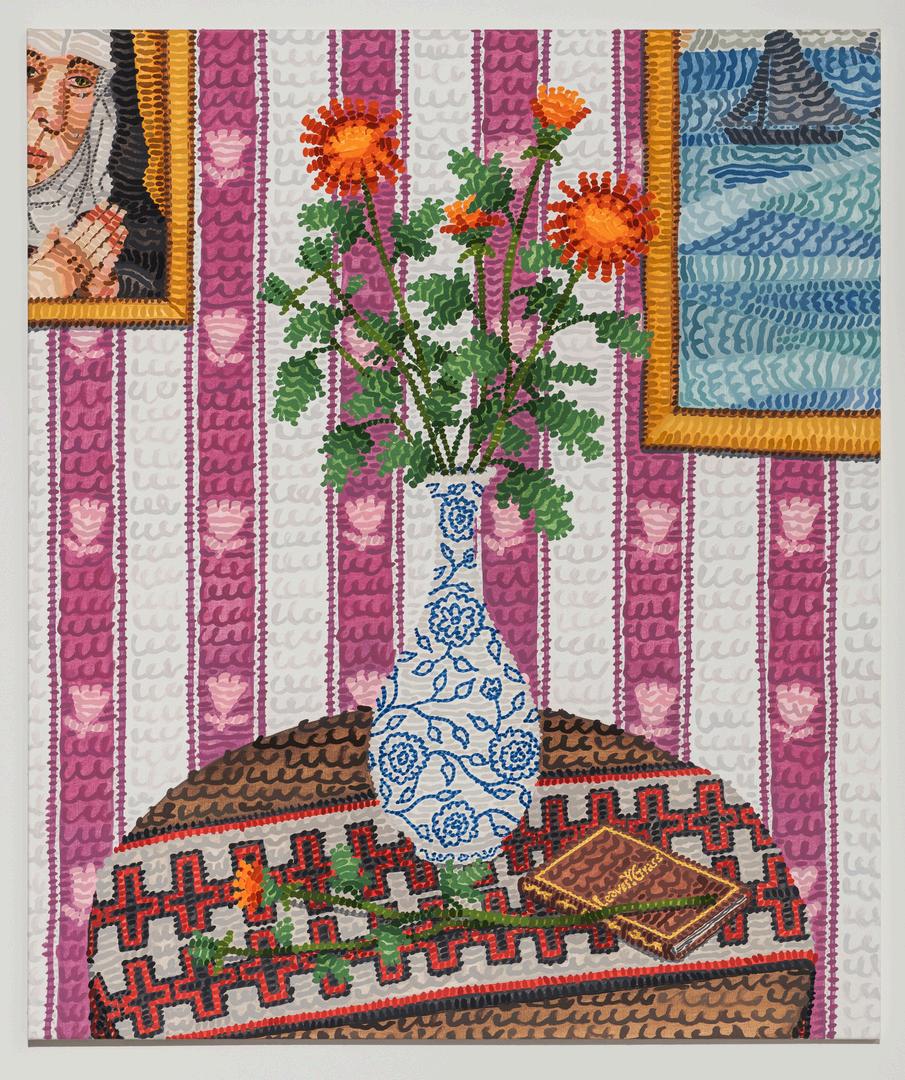
Jae Ford
MFA ‘16
The cleft between form and content is a peculiarly persistent myth in the history of western art The idea stems, I think, from the belief in a resolute distinction between that which is still and that which is in motion, despite all the disputations of this idea by modern physics and ancient wisdom traditions alike Jae Ford’s sculpture Two Streams doesn’t fall for this trap Steel, paint, and resin animate themselves, contouring space in ways that disorient received ideas about painting, drawing, and sculpture. Bodily readings abound a forked tongue, a lithe tail but what holds me closest is how Two Streams makes the space in and around it more real than I had noticed before.
John McCracken’s Red Plank also insists on the meaningfulness of space and material. Despite his historical association with Minimalism’s industrial practicality, McCracken described himself as seeking “ a breathtaking level of beauty,” something Ford can appreciate. Beauty, it would seem, is the tool that can suture the wound separating form from content. Ford’s work sits in the company of other artists who found this out. Artists like Anne Truitt, André Cadere, Scott Burton, McCracken, and Ford have worked to show us that material objects can themselves be stories about our identities, our desires, and our place in the world If they are also beautiful, so be it For if the world is split too cleanly into form and content, who suffers but us? If the “formal” and the “beautiful” are abdicated to a conservative aesthetics, much as the “rural” has been abandoned to the right, we risk missing the richness of reality Two Streams seems to suggest, instead, that an empathetic, expansive politics can only emerge from a real relationship with materials in motion, or what Ford calls the “low hum of form ”
~ Brian T. Leahy
Selection from the Art Institute of Chicago collection: John McCracken, Red Plank, 1969


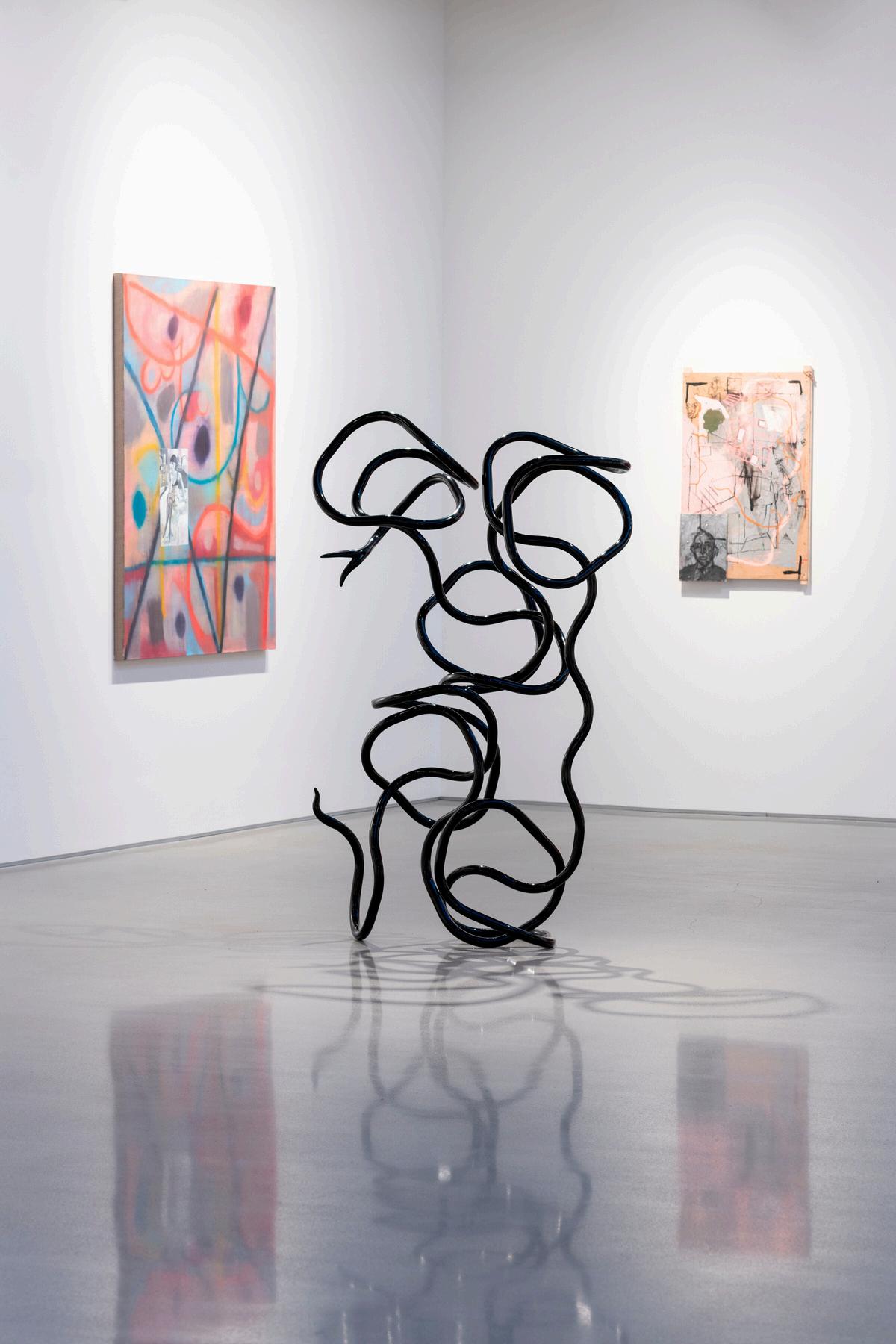
Jonathan Gardner
MFA ‘10
I feel a particular fondness for the permanent collection at the Art Institute of Chicago In fact, seeing Gerhard Richter's Woman Descending the Staircase as a high school student in SAIC's summer pre-college program made me want to be a painter Many years later as a graduate student at SAIC, I spent a lot of time in the museum grappling with doubt, confusion, and roadblocks in my own work. I would look at paintings like Picasso's Nude Under a Pine Tree as I experimented and failed at trying to paint more directly. Other times, I would check out Balthus, De Chirico, and Magritte as I worked through the process of pulling figuration out of my unconscious. Walking out of my studio and into the museum to see these paintings in person was, of course, invaluable during this time.
One important class for me, “Pictorial Structure” with professors Jim Nutt and Richard Hull, included a trip to the museum for every class to visit and discuss one painting in depth. The insights into the compositional structures, paint qualities, color, and every minute formal detail taught me a great deal about how to look at painting and figure out – in a practical, midwestern kind of way – the nuts and bolts of what makes a painting “work ” Magically, Jim Nutt seemed able to point out things that were easily overlooked or hidden in plain sight, but once recognized, seemed as obvious as a stop light
Now that I live in New York, I still carry the influence of a lot of the works I saw in Chicago with me It is foundational to my personal, lived experiences with art
~ Jonathan Gardner
Selection from the Art Institute of Chicago collection: Jim Nutt, Sally Slips Bye-Bye, 1972
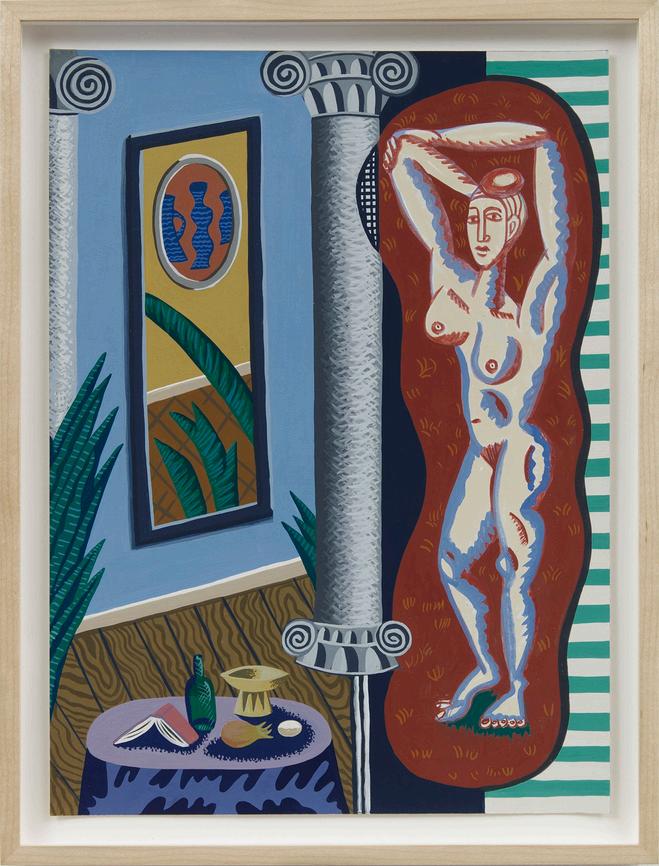
Magalie Guérin MFA ‘11
On a Conversation between Magalie Guérin and Gabriele Münter
Beyond their considerable ability to hold our attention, one way to begin a deeper appreciation of Magalie Guérin’s paintings is to consider what she told the painter Sangram Majumdar in an interview:
I don’t think of [my paintings] in abstract terms. I think of them as constructions of shapes that exist in the world, even though you can’t recognize them. You don’t know what they are, but you sense that they ARE. […] There’s gravity. There’s a ground. A figure-ground relationship. There’s a logical sense of construction.
When Guerin talks about pre-existing shapes, she is referring to the paintings that she is in dialog with in her work In her painting, Untitled (Gabrielle) (2025), Guérin began with Still Life with Queen (1912) by Gabriele Münter (1877-1962), a German Expressionist painter who remains underknown in the United States
In contrast to artists who resort to mimicry, citation, and parody all of which have been considered postmodern responses Guérin takes a different path in which preservation, transformation, and change occur Incorporating these elements, the dialog Guérin establishes is different from painting to painting, meaning she has no formula. While Guérin keeps the essential compositional elements of Münter’s still life, she worked on a larger surface than the original, as well as changed the ration of height to width.
The transformations and changes Guérin made enabled Untitled (Gabrielle) to become an original work, shedding its source. In Münter’s painting, we see the image of a woman in a yellow gown rising above the still life, set against a thinly painted area of rosy pink that is framed by a maroon band, suggesting that what we see is a figure reflected in a mirror. None of this exists in Guérin’s painting, which is made up of an aggregation of distinct abstract shapes that suggest a still life of flowers in a chalice-like shape. There is no figure or reflection. The one commonality they share is a stalk thrusting up from the container, but there is little that otherwise connects them The palette, application of paint, and textures Guérin arrives at are all her own Her painting resembles neither Münter’s nor that of her contemporaries In that regard, she is a complete original
~ John Yau
Selection from the Art Institute of Chicago collection: Gabriele Münter, Still Life with Queen, 1912
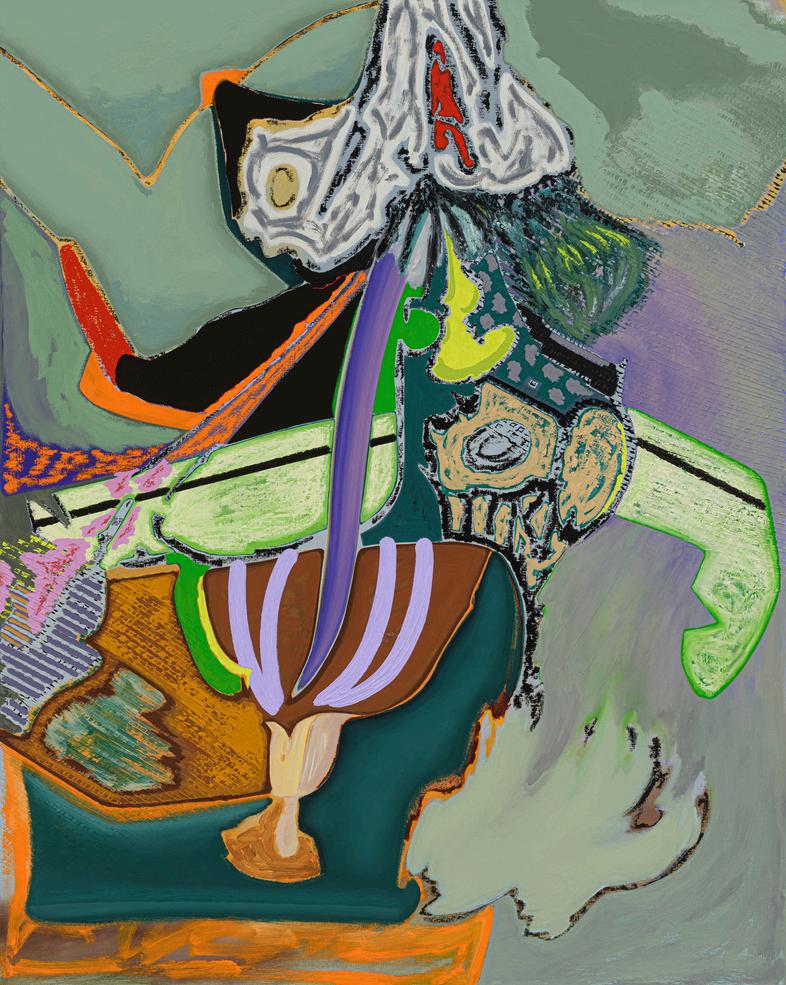
Antonia Gurkovska
MFA ‘11
“Rauschenberg broke the mold of the way I thought about art ” Gurkovska received a traditional arts education in Bulgaria, marked by academic rigor and strict canons. The encounter with Robert Rauschenberg’s work helped her find the courage to break away from this consensus which celebrated figurative art that met set interpretative criteria. It opened a new dimension in which she felt empowered: “It’s okay for an artwork to not have a clear statement and be openended, inducing search, discovery, and exploration. That’s liberating and formative.”
Robert Rauschenberg’s mastery at transforming everyday objects into works of art guided Gurkovska’s production. Collage, layering and assembly became central to her process. Rauschenberg’s 1955 work Closed Circuit is a soundboard for images, materials, and feelings. Its layered structures challenge the scope that an artwork can occupy in the collective space. It defies conventional boundaries by prompting the viewer to literally and figuratively uncover the hidden compartments of a work and engage with the discovery of concealed messages and embedded elements
The close conversation with Short Circuit, one of his earliest combines, underscores the balance between specific artistic choices and outcomes left open to chance In Gurkovska’s Closed Circuit series, she deliberately chooses to construct a grid of nine panels, slightly echoing Rauschenberg’s multi-piece composition. What else becomes part of the artwork? Rauschenberg chose to incorporate the work of his collaborators; originally, one of the cabinets contained a flag by Jasper Johns, with whom he was romantically involved. It was lost and replaced by appropriation artist Elaine Sturtevant.
The artist becomes a curator, seeking textures and materials that shape narratives and personal histories and the artwork becomes an extension of the self and its relationships with the environment. That's where storytelling begins. “It's radically alive, self-generating, and evolving,” remarks Gurkovska, who compares her work to poetry rather than a novel explaining that she finds comfort in the lingering idea of possibility: “To this day, Rauschenberg’s cabinet continues to open doors by revealing new ways of seeing, making, and understanding ”
~ Silvia Beltrametti
Selection from the Art Institute of Chicago collection: Robert Rauschenberg, Short Circuit, 1955
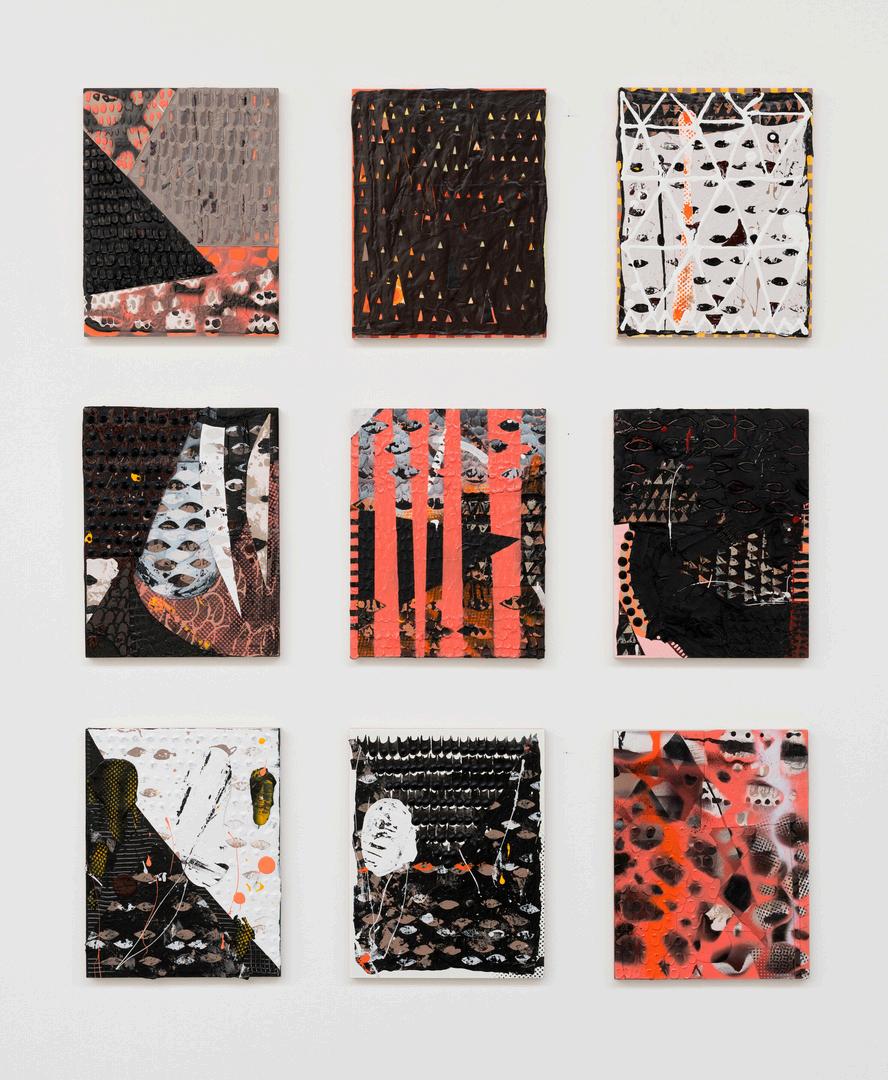
Circuit (1)- (5), 2024-2025
14 x 11 inches each
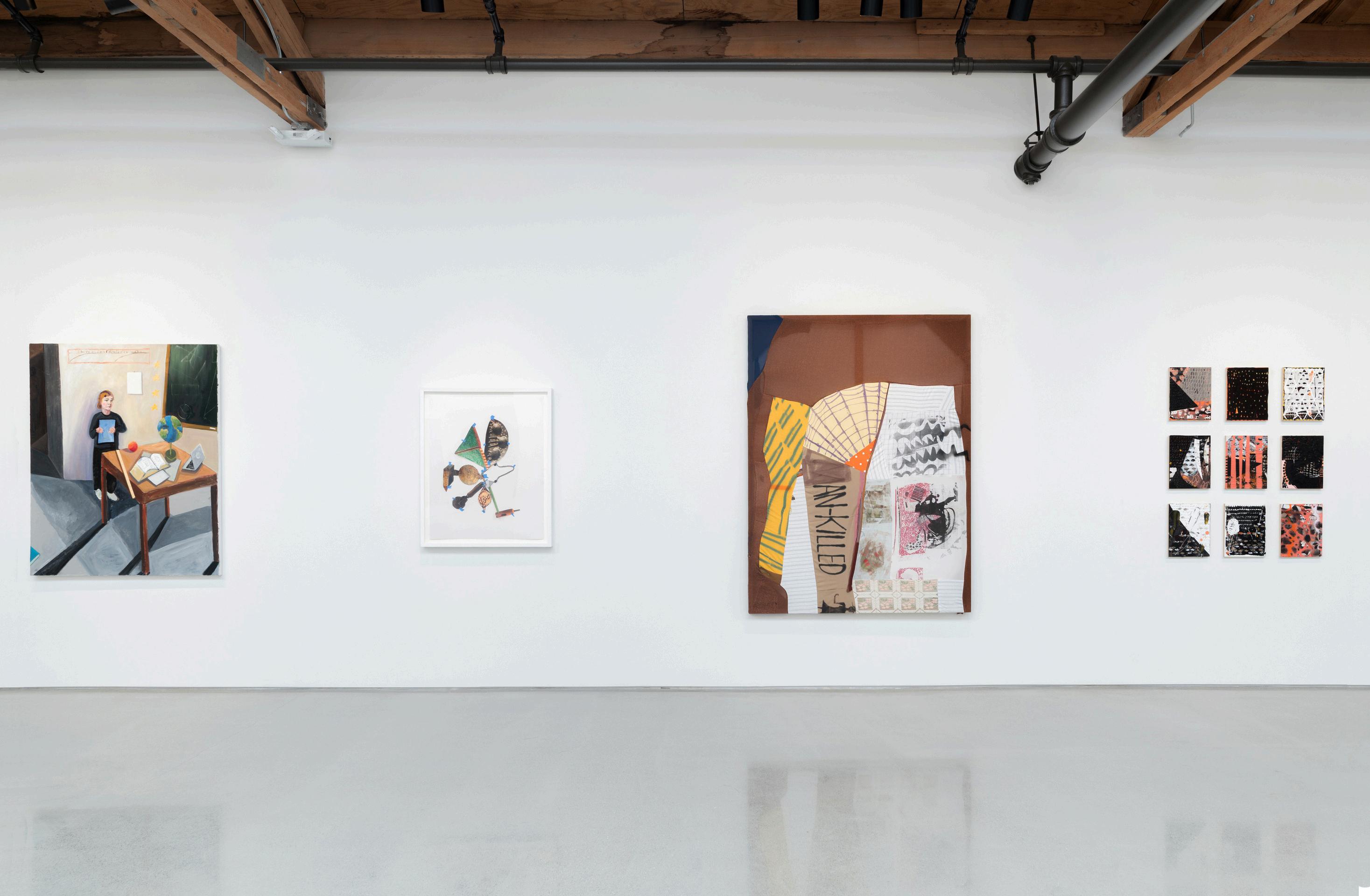

Efrat Hakimi MFA ‘19
The Akhnif, a mid-nineteenth cape from the Siroua Mountains in Morocco, was worn by men and children to protect against the harsh climate of the region. Made by women of the Ait Ouaouzguite people, using a split-tapestry technique, the cape features an oblong orange shape that tapers to points on either side, with a sliver of patterned textile in the center This motif is believed to represent the eye, offering protection against the “evil eye, ” a concept symbolizing the mix of envy and admiration Some sources suggest that the design absorbs the envy embedded in the gaze of others
Hakimi’s photographed collage draws on the tradition of amulets crafted by pregnant women in the region, assembling everyday objects imbued with protective power By photographing items from museum collections, some of which include fragments of Jewish ritual objects, Hakimi weaves these elements into a new form of spiritual safeguard. Using blue painter’s tape to bind the pieces together, she evokes the tactile relationship between objects, creating a visual thread that connects the fragments and their meanings.
Hakimi’s approach to these artifacts offers an intriguing layering of cultural reference and global access. The Akhnif in the Art Institute of Chicago’s collection is one of many iterations of this regional object found in museums worldwide, with the shared eye motif grounding its meaning. Hakimi’s work further explores this network of meanings by printing photographs of the Akhnif and other regional objects, creating new contexts through collages. In Protective Amulet Against Miscarriage, she pulls from various global artifacts to assemble a unique composition, offering a more fluid and interconnected vision of cultural exchange Hakimi’s work bridges local traditions with global networks, creating a space where art, history, and culture continuously resonate across boundaries
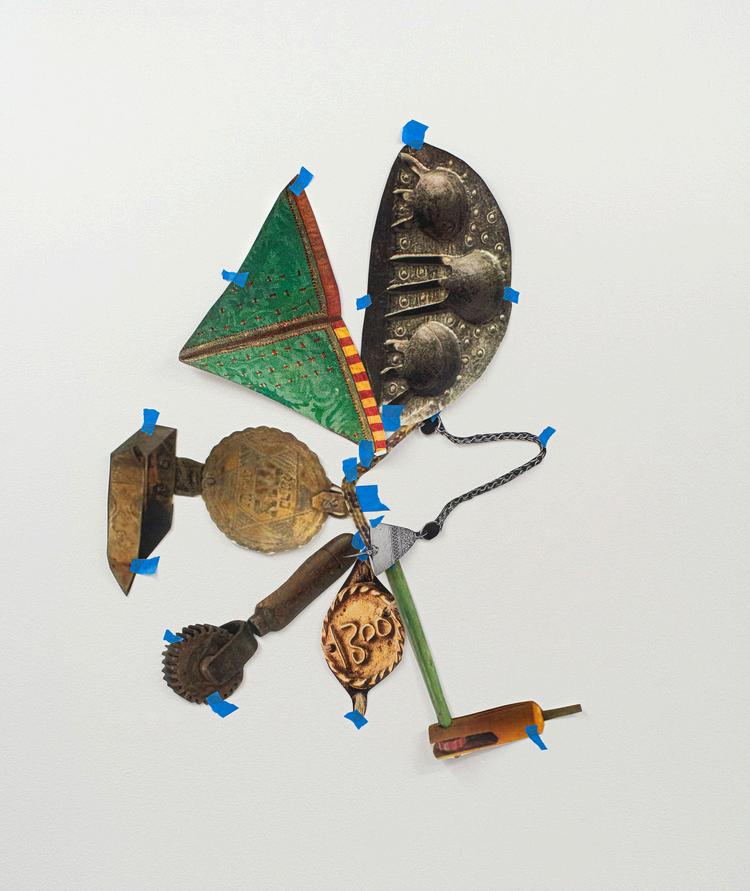
Amulet against Miscarriage (I), 2021
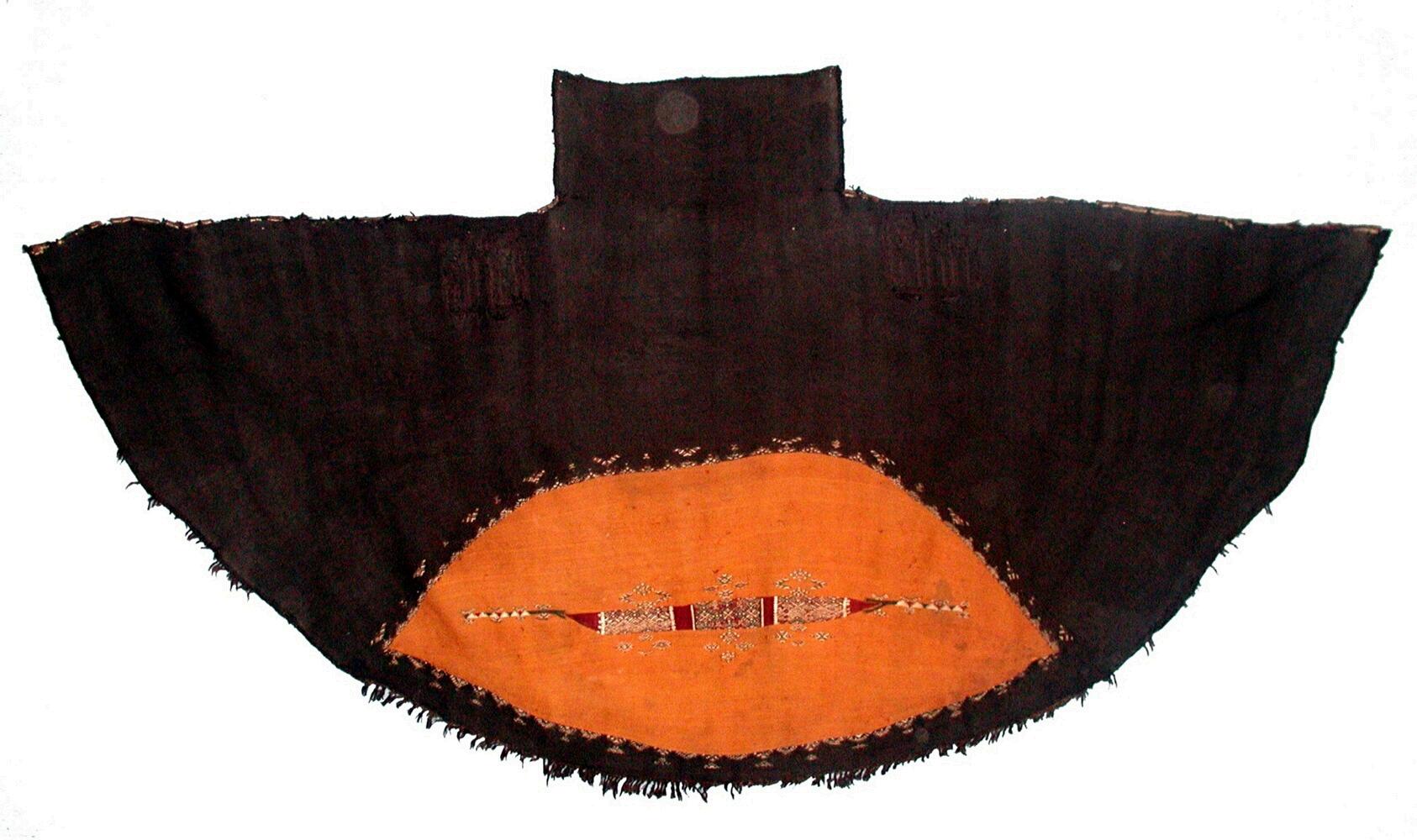

Selection from the Art Institute of Chicago collection: Man’s Cape (Akhnif), Made 1825–1875, Ait Ouaouzguite Confederation
Andrew Holmquist BFA ‘08, MFA ‘14
It’s difficult not to feel a sense of disquiet standing in front of Henri Matisse’s engulfing canvas, Bathers by a River (1909–17) The work’s muted palette and rigid depiction of four individuals speaks to the weight of this period in modern history The figures stand separated, seemingly irretrievably so, poised in various lost attempts to connect with one another. The distance between them is only ever-more delineated by bands of color that appear to encase each of them each person a sculpted form emerging from their block of stone, with only the subtlest of suggestions as to their warmth and humanity.
Matisse noted this work as one of five that were most pivotal in his career, a turning point for the artist in his restless exploration of visual languages. It’s also remarkable in that it spans an eightyear period, completed after the start of World War I. What gardens of Eden did the world lose through our loss of belief in our shared humanity? Loss of our interconnectivity, exchanged for melancholic isolation? The head of a creeping white serpent enters the scene from below, but we know now all that he whispers These snakes in the grass are all around us
It's no surprise that Andrew Holmquist would identify this painting of special importance to him A painter well-steeped in the art historical veins that precede and inform his work, Matisse no doubt looms large The hands of these two painters are never hidden, often chasing the same lyrical line or stroke, never to be repeated Each painterly mark its own moment in time
Holmquist has taken up this subject matter, “the bather,” in a number of works over the years. But none so directly linked to Matisse’s Bathers by a River as Holmquist’s Ocean Bathers (2025). The overall composition of four figures, paced rhythmically across the canvas and in similar poses, all point to the artist’s intentionality. Yet here the landscape is vibrant and lush, the figures more expressive. The palette is consistent with much of Holmquist’s work, radiating a complex spectrum of colors that are both exuberant and soothing at the same time. Matisse’s heavy dark lines are here, too, but only to give slightly more geometric definition to the watery bodies of the figures as they melt into the scene around them.
There is joy in Holmquist’s work, the kind of effortless seeming joy when one gets lost in the moment, when all cares and preoccupations are pushed aside, and one can just be Like Matisse, and many others who came before him, Holmquist’s work speaks to the power of what it means to see and be seen And in 2025, this act of seeing and being seen also speaks to the power of joy as an act of artful resistance
~ Steven Bridges
Selection from the Art Institute of Chicago collection: Henri Matisse, Bathers by a River, 1909–17
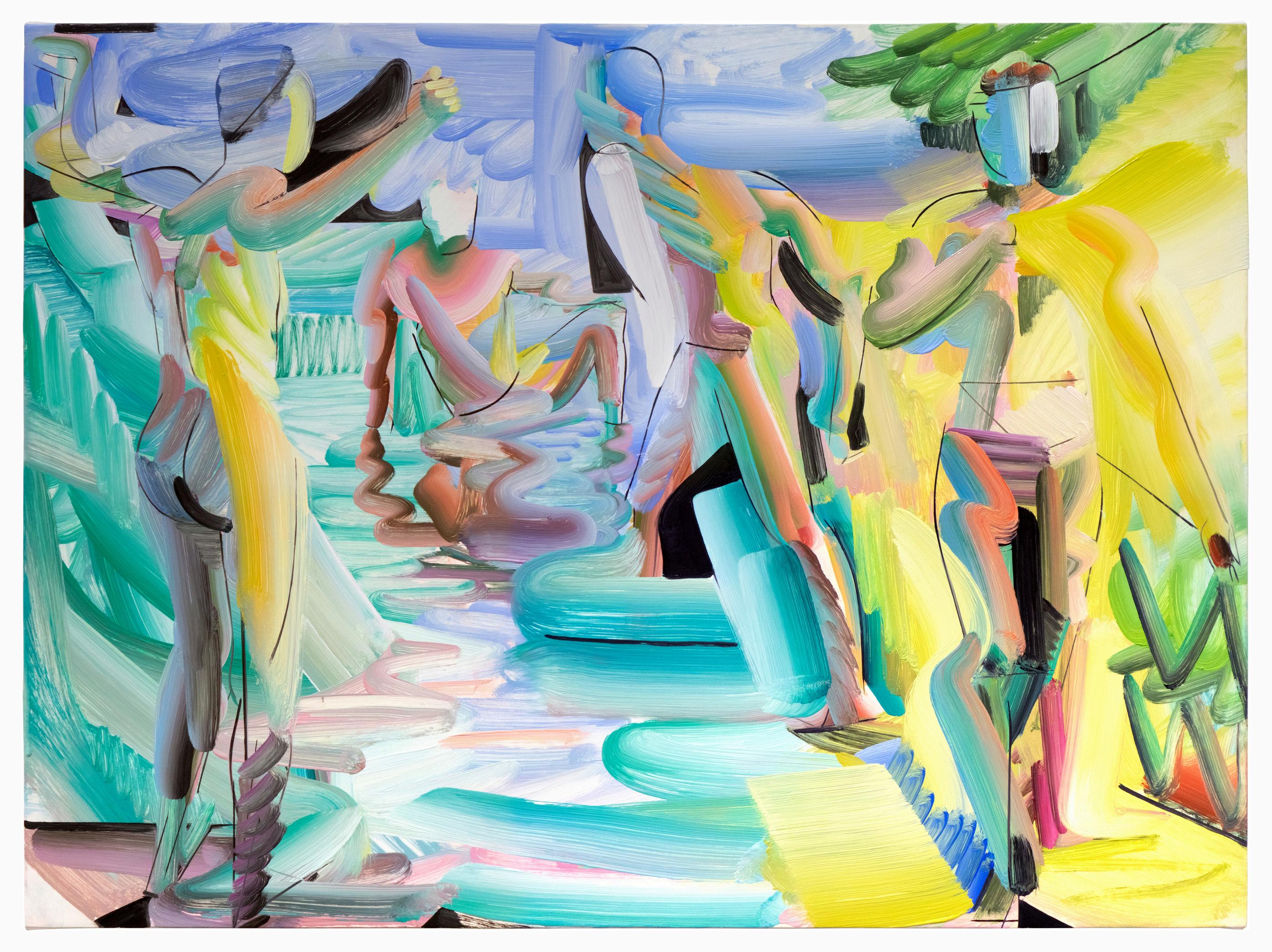


Mika Horibuchi
BFA ‘13
Mika Horibuchi’s Curtain Drawn III literally quotes Adriaen van der Spelt and Frans van Mieris’s Trompe-l’Oeil Still Life with a Flower Garland and a Curtain from 1658. Her painting isolates the gauzy curtain from the original, withholding the lush floral arrangement it once concealed. The gesture is existentialist. By removing the ostensible subject, Horibuchi draws our gaze to the ontological essence of the canvas itself: that delicate threshold between illusion and revelation, reality and fiction.
Horibuchi’s take instantly beings to mind the classical Greek story about Zeuxis and Parrhasius: two painters who competed to deceive the eye. Zeuxis depicted grapes so lifelike that birds flew to the canvas to eat from it. Parrhasius, painted a curtain so convincing that Zeuxis asked it to be drawn aside to see the painting beneath.
Rendered with exquisite care, the curtain acquires a hauntingly mysterious charge Its folds suggest depth but reveal nothing In this way, Horibuchi does not merely mimic trompe l’oeil, she questions its very premise But the philosophical proposition of her painting is further anchored in the tradition of still-life, long associated with vanitas and the fragile temporality of beauty: to arrest time, to prevent the fading of beauty, to preserve moral and corporeal integrity By zooming in on the seemingly less interesting part of the baroque painting, Horibuchi deepens the existentialist baseline, pointing not just to mortality, but to the unknowability of existence itself. The painting thus becomes a meditation on the limits of perception, an unanswerable visual riddle anchored in the phenomenological limitations of the human condition.
Giovanni Aloi
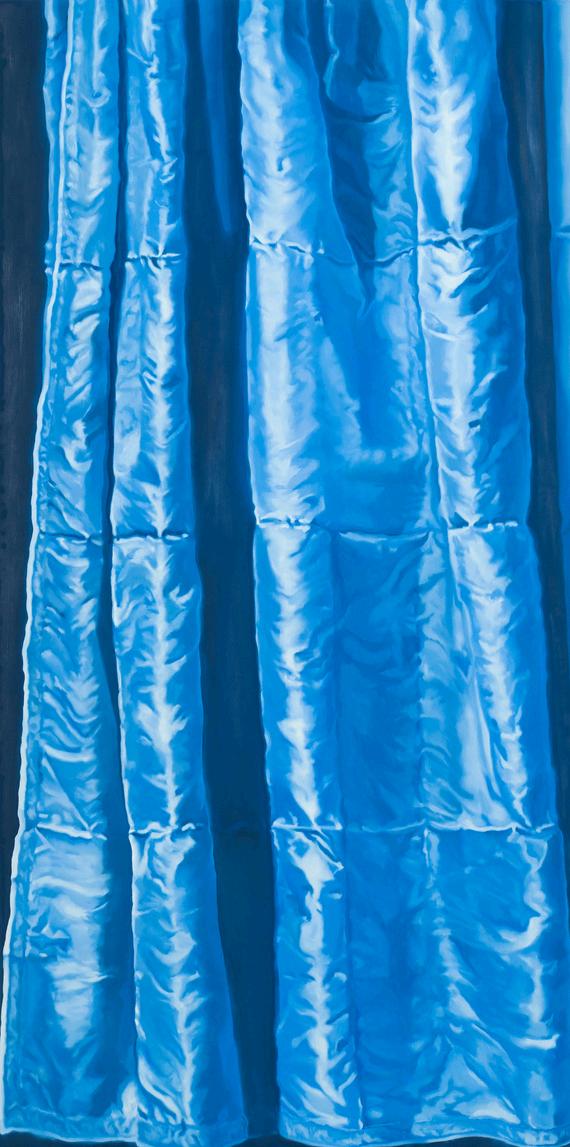
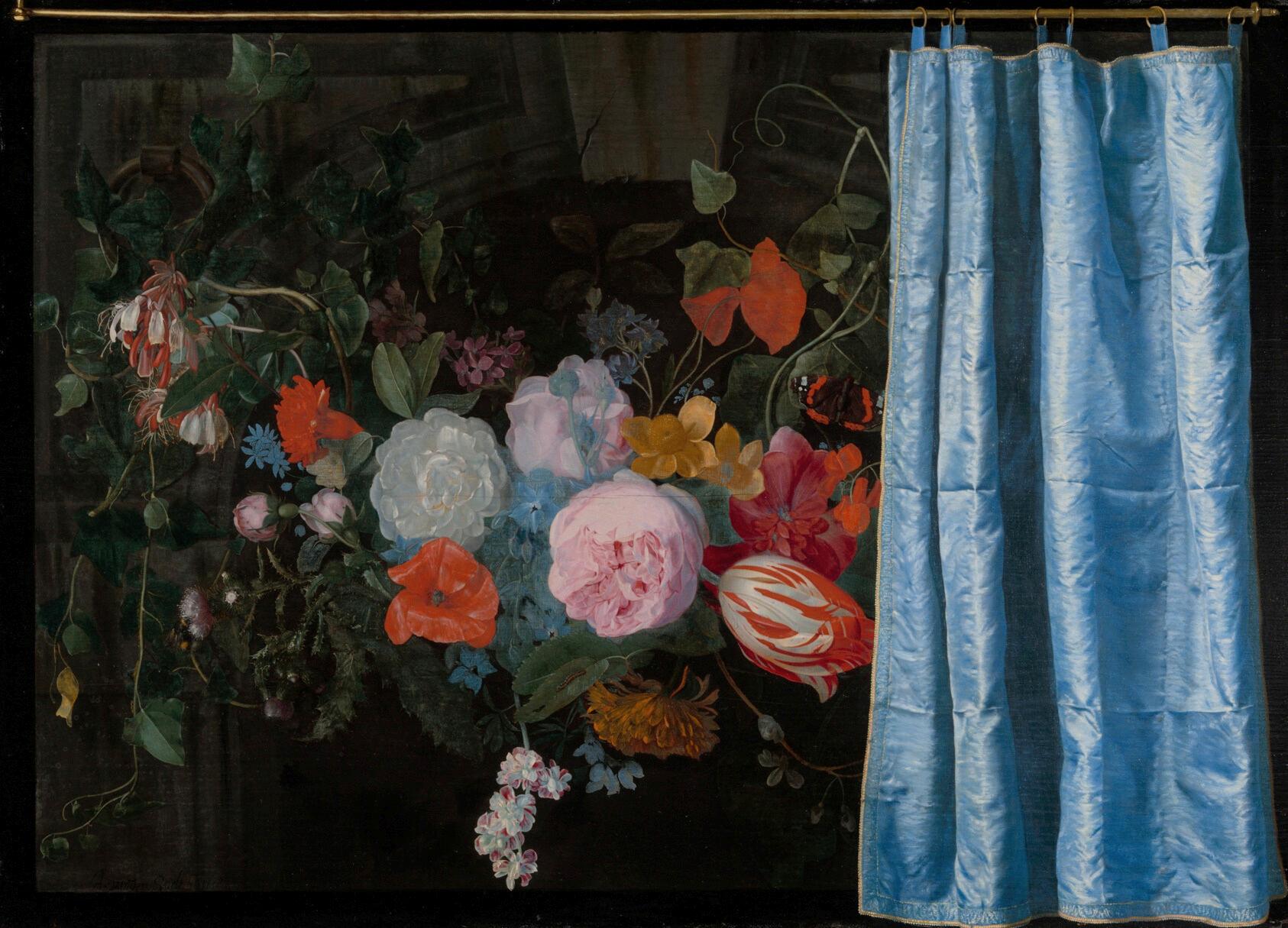


Patrick Dean Hubbell MFA ‘21
Painter Patrick Dean Hubbell (Diné) broadens the parameters of contemporary painting with his unique additive canvas technique and mash-up of art histories in a singular composition. His dynamic paintings overlap geometric patterns with gestural marks, serving an optical buffet that flattens any cultural hierarchy. At the base of the composition, the modernist cube canvas covered with multicolored irregular lines gives a nod to abstract expressionism. Vertical folds of painted canvas cascade over the front of the artwork in a manner much like the iconic togas that once adorned figures of classical antiquity. Designed to hang loosely over one another, each swatch of painting intentionally remains unfixed until it is installed on the wall. For Hubbell, these folds are inspired by Navajo blankets, which function equally as home textiles and body coverings. Spanning centuries of history with these cultural references, Hubbell’s artwork positions Navajo culture literally within the art historical canon.
The handmade works created nearly two-hundred years apart Your Clarity Rises Above All Of My Faults and Germantown Eye-Dazzler have such inherent similarities that they collapse time as well as the art/craft divide Hubbell intentionally paints on canvas rather than weaves his compositions to challenge the intellectual and commercial value assumptions society places on craft versus contemporary painting This spectacular woven rug in the permanent collection of The Art Institute that he cited for this exhibition underscores his reverence for, and the relevance of, traditional Diné textiles to his art practice.
Navajo patterns seen here present a sacred world view and are reclaimed by Patrick Dean Hubbell in his impressively large painting. Both artworks prominently feature zig zag lines representing the lightning bolt. Not only “ eye dazzling”, the beautiful pattern is believed to carry spiritual favor and energy. This chevron has been fully absorbed into popular culture from Charlie Brown’s t-shirt to the logo of a gas station without most people’s awareness of its symbolism or heritage. Hubbell also incorporates red and white horizontal stripes in this painting, which we may read as the flag of the United States of America. Yet, long before the USA existed, the alternating two-color stripe represented harmony and balance between the earth’s elements in Navajo culture Through his paintings, Patrick Dean Hubbell breathes renewed life and context into spiritual Navajo symbols, prompting us to question our assumptions about the origins and meaning of everyday patterns in art, design, and fashion
~ Allison Peters Quinn
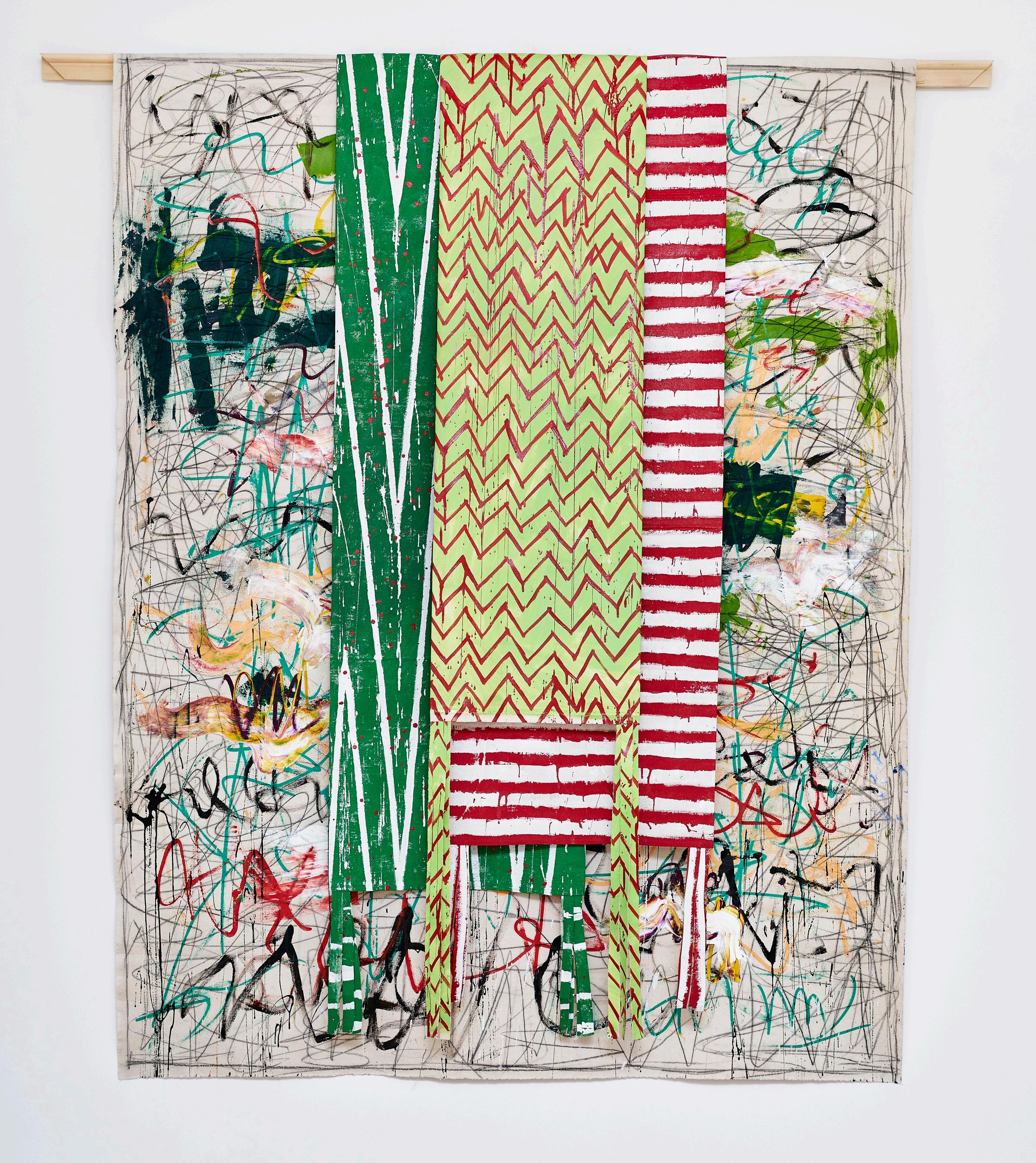

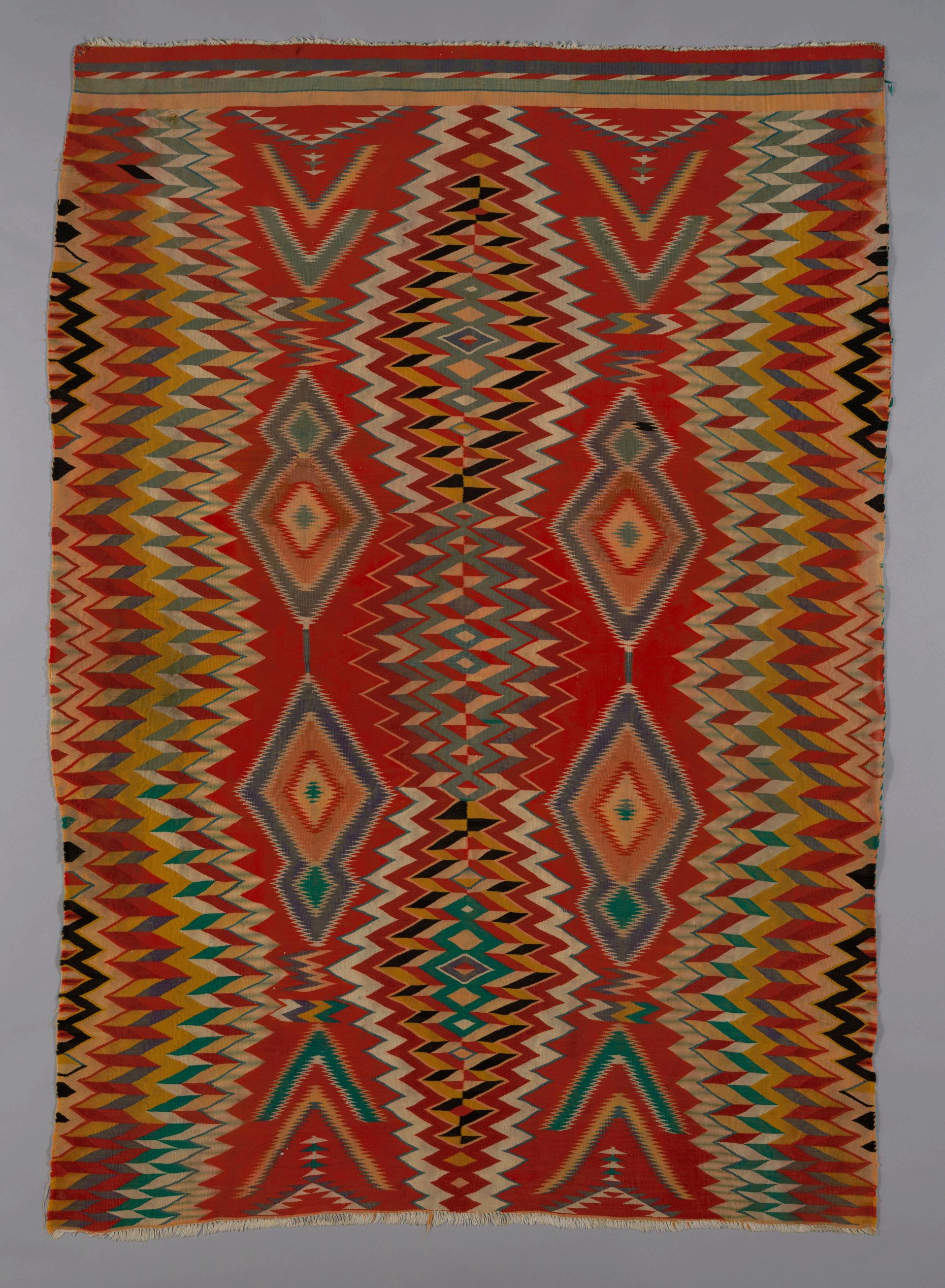
Steven Husby MFA ‘03
Sixty years after Frank Stella’s De la nada vida a la nada muerte (1965) prompted viewers to remind themselves that its illusive triangles and parallelograms were not dimensional shapes but flat, striated lines, Steven Husby’s carefully balanced canvas(es), Untitled (2025), insist that one recognizes that its own repeating semicircles and rounded rectangles are in fact only shapes. Further, as signaled by the parenthetical above, Husby’s larger arch-shaped canvas, built with successive cream-colored half-circles on an amber background, hedges in a separate tower-like center canvas, wresting it back into the rectangular picture plane from which Stella once set it free. And whereas Stella painstakingly sought to obscure the artist’s hand under the reflective sheen of metallic gold, Husby resurrects the visible brush stroke that distinguishes one recurring shape from another. To record these observations is hardly to suggest that the latter’s choices are retrograde, however: Husby’s aims lie elsewhere.
Though both painters engage with the instability of a perceived object-illusion dichotomy, Stella’s early preoccupation with the materiality of painting itself makes way for Husby’s extension of this problem into the contemporary realm of the modular picture An impermeable work, the movement of Stella’s patterned lines suggests that they might extend beyond their roaming border ad infinitum–and to this boundlessness, Husby adds the possibility of physical interchangeability. Thus, in addition to treading a fine [gestalt] line between the recognizable image and the abstract shape, Husby proposes literal, physical incompleteness in suggesting that the work–and thus the image or non-image–possesses myriad configurations. If both works emerge from Stella’s claim that everything which may be known about them may be found on the canvas, then Husby reflects this assertion back from a picture-saturated present.
Barbarita Polster
Selection from the Art Institute of Chicago collection: Frank Stella, De la nada vida a la nada muerte, 1965
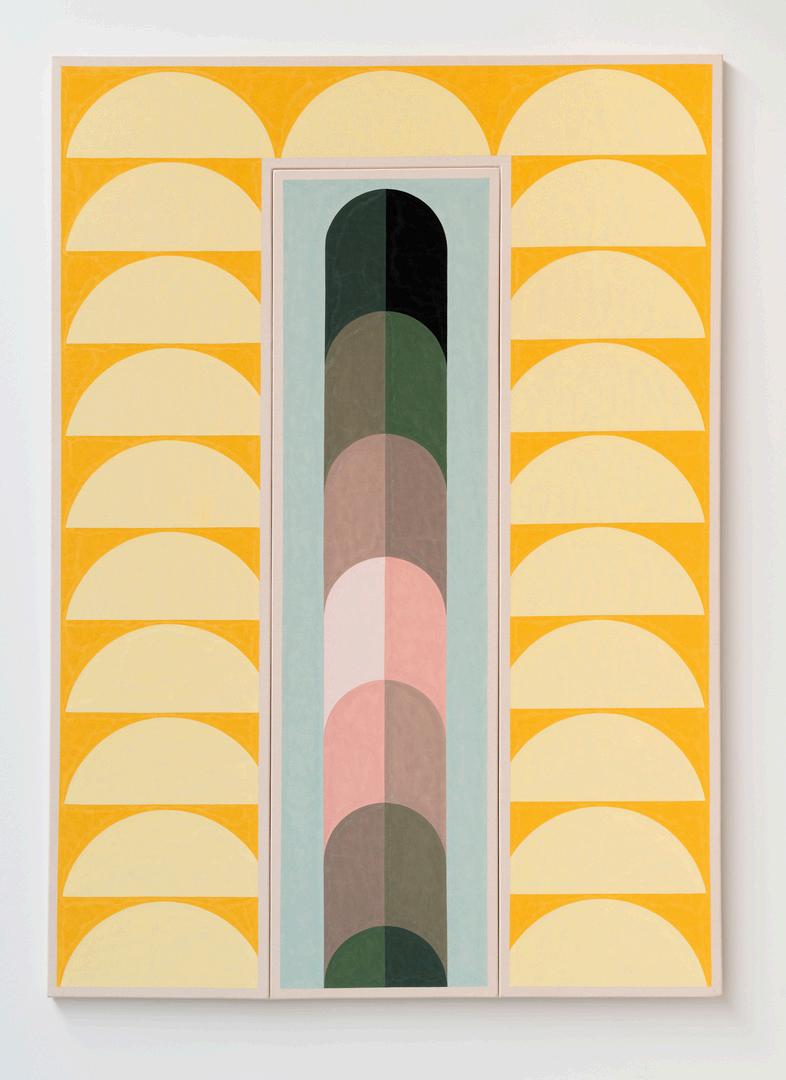


Omair Hussain
BFA ‘18, MFA ‘25
I miscounted the sections of Omair Hussain’s untitled miniature painting It consists of four quadrilaterals, not five He painted it in one shot on an absorbent clay-ground panel using matte gouache, the opaque watercolor medium favored by Henri Matisse for his famous cut-outs Two of Hussain’s shapes are classic orange and red, while the others are yellowish shades of green and blue This chromatic mismatch creates visual tensions and pleasures as we can’t help but judge the uneven composition against our personal sense of wholeness Do the painting’s dynamics satisfy us or not? Hussain’s art poses this question but never provides an answer.
I was also wrong about the blue shape. It isn’t a quadrilateral. It’s a triangle dented along the hypotenuse, where the sharp corners of the other forms press against it. That’s two mistakes. Somehow, Hussain’s painting continues to elude me. I must look and look again. These pieces possess a quality that’s rare in art today. His small paintings have an expansive scale the aesthetic payoff grows with sustained looking and return visits.
Like many before him, Hussain recalls the vastness of Jackson Pollock’s dabs, drips, and dribbles, whether the paint captures Carl Jung’s psychological mysteries, as in The Key (1946), or nothing at all Indeterminacy is a tool of freedom
~David Raskin
Selection from the Art Institute of Chicago collection: Jackson Pollock, The Key, 1946

From left to right:
9
11
12
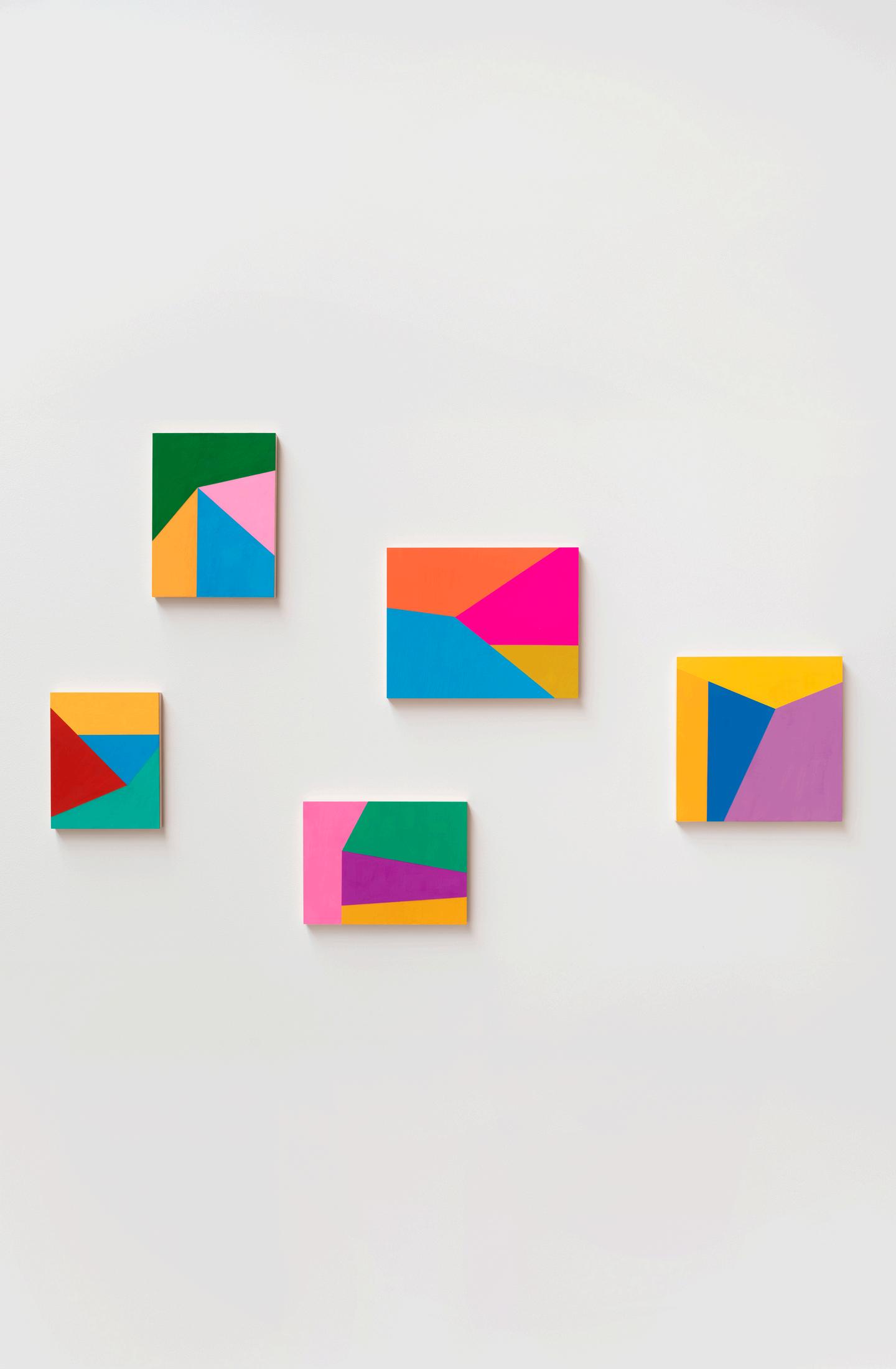


G. D. Johnson MFA ‘25
There’s this painting in the American wing of the Art Institute called Haunted House (1930), painted by Morris Kantor I first discovered this painting in the catalogue for the show “Supernatural America,” years before I moved to Chicago; when I first saw it in person in the American wing, it was almost unreal I always felt it was one of those paintings that I would never actually see in person I was surprised at how different it looked in person; the way the town in the shadows looks in person I feel incapable of describing in words.
I like to think of my work as the collision of worlds, ideas and structures. The two spaces in this painting seem separate but the longer I’ve sat with it the more the two worlds have felt united; the colonial portrait and the painting of a ship evoke another universe besides the town in the shade and the room itself. The figure and shadow invade an empty room, turning it into a container for some strange presence. For me it’s a very lonely painting, the haunting is not really a supernatural one but a metaphor for alienation. It feels like the past of America haunts the room from the colonial portrait. In my work I merge different spaces into each other, trying to create the contradictory melding that happens between the town in the shade and the empty room
~ G D Johnson
Selection from the Art Institute of Chicago collection: Morris Kantor, Haunted House, 1930
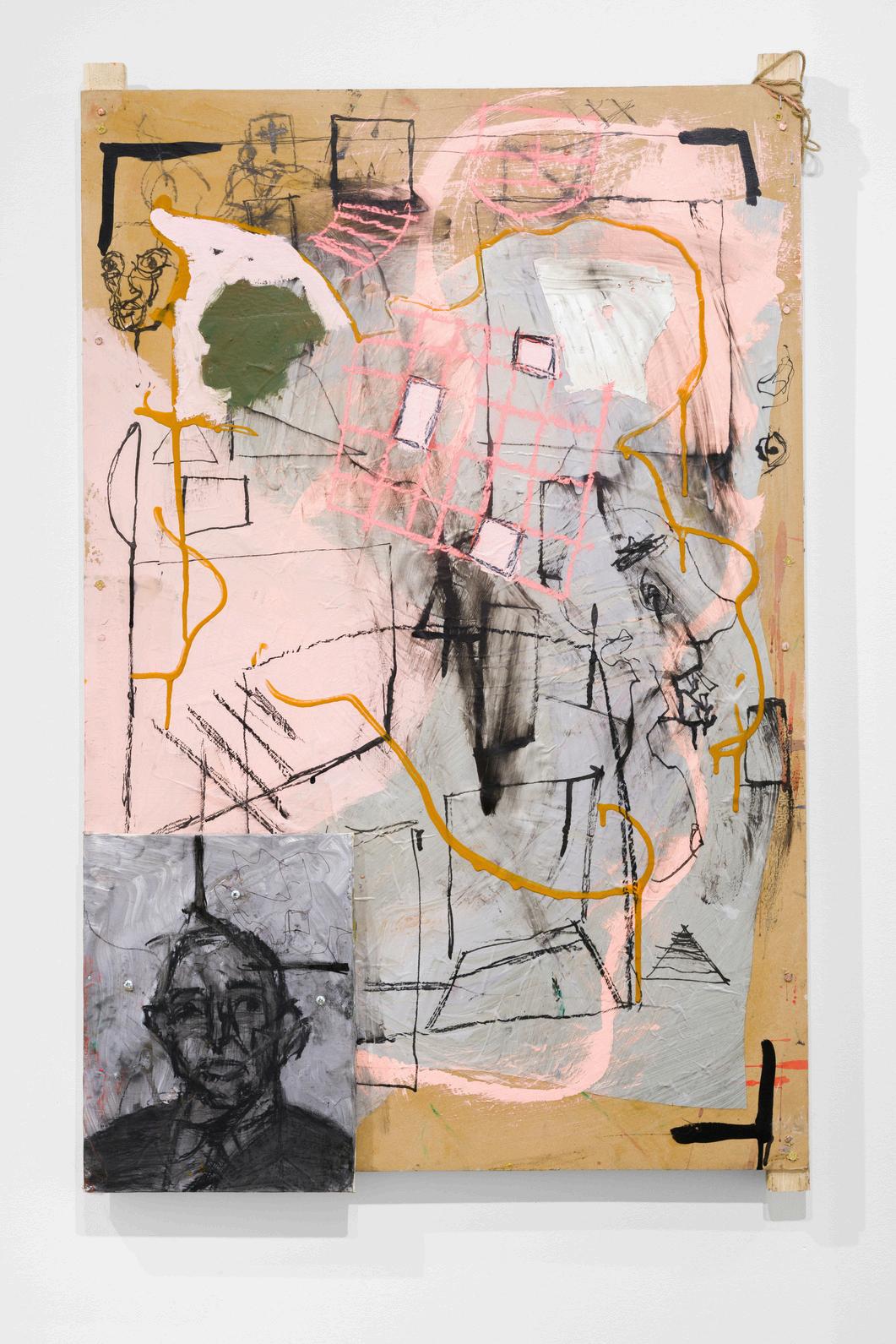
There is a buzzing/my foot feels strange, 2025 Acrylic, graphite, charcoal and metallic paper on wood
38 x 24 x 3 inches
James Kao
MFA ‘06
A post-impressionist painter walked into the head of an anti-style painter. The postimpressionist said to the anti-stylist, “What’s the difference between your paintings and mine?” The anti-stylist replied, “Space!”
Ok, observational painters of the post-impressionist variety, like George Seurat (1859-1891), and observationalists of the anti-style kind, like James Kao, aren’t comedic Painters observing the everyday are not after the rhythmically-timed punchline; they’re aiming for something arising when time stands still Comparing stillness, and difference, in Seurat’s La Grande Jatte (1884) and Kao’s Starlight (2018) points to that something
Seurat’s La Grande Jatte depicts the Parisian leisure class in a waterfront setting with that differentiated class being the object of critique. In this Seuratian world, women wear bustles with one bustled woman grasping a leashed monkey from a colony, umbrellas provide cover from shade, hats pervade when umbrella and shade aren’t enough, and stiff backs perform in lieu of English upper lips. And, lest I forget, one slouched worker coyly tries to fit in and one French horn player with coiled back adds ambiance. All of this in a casually rigid social space marked by social distancing before “social distancing.”
In the Kaoian world that is Starlight, village (not city) and woods are differentiated and severed by water a river. But along with Kao’s fishy fish in the river are animals presumably from the woods and human-like figures presumably from the village. Throw in a few cameos by characters in Kao’s earlier work: duck decoys and maybe a duck duck, oranges on tables, and housing structures (perhaps one of them Wittgenstein’s village house?) Ultimately cluttered details emerge above the fray in the river Details are so layered especially in the river space that the detailing obscures difference to accentuate difference
Seurat and Kao separated by spacetime observe and paint together in entangled ways
~ Patrick Lynn Rivers
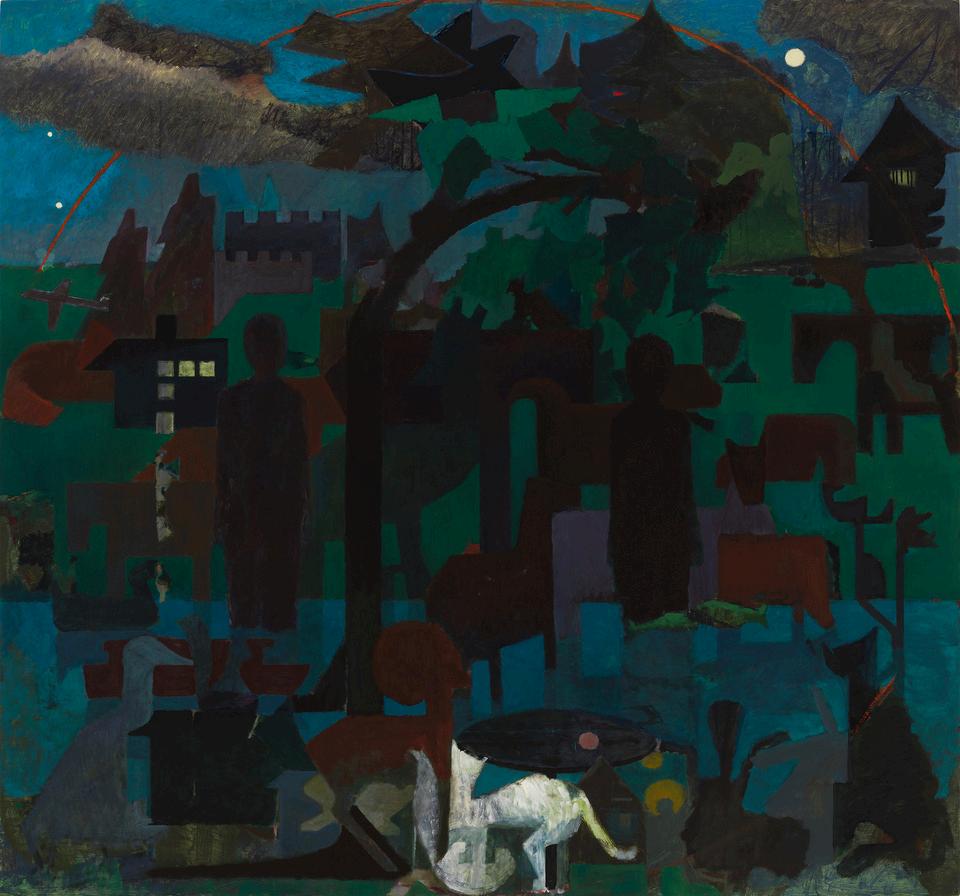


Selection from the Art Institute of Chicago collection: Georges


Em Kettner MFA ‘14
I’m always looking at the ground, scanning for slight dips and slopes, cracks and bumps As a person with a mobility disability, I have to stay vigilant to sense these subtle shifts through my shoes Often I’ll rely on a companion who can link arms and match my stride It’s a common but deeply tender form of support two friends moving side-by-side
Years ago, we walked in tandem like this through the museum. Something glinted on the floor of a tall display case. We looked down and two blue beaded slippers were looking back up.
Shoes serve a humble function: a layer of protection for treacherous terrain. But this pair is also dazzling, talismanic lavishly adorned for a leader. Rows of glass beads form a dozen intersecting geometric designs that flicker in the light. The slippers preserve and ornament a particular range of motion: a frayed toe, a worn heel, sunken soles. They conjure the absent wearer, and are further animated by faces stitched atop each foot. The expressions are mesmeric but curious, commanding but sweet.
These slippers provide a material record of manifold layers of support: the beadwork bolsters the cloth armature; the shoe protects the wearer; the wearer guides their community They convince me that humble objects can be celebratory, playful, exquisite, and sacred
My sculptures also celebrate networks of support In The Tots, figures intertwine to form a composite body – a group of friends or a family that moves in unison Their limbs are wrapped in a patterned costume to embellish and protect those points of connection. Woven inside their shared torso are four floating faces, with several sets of eyes looking always at the ground.
~ Em Kettner
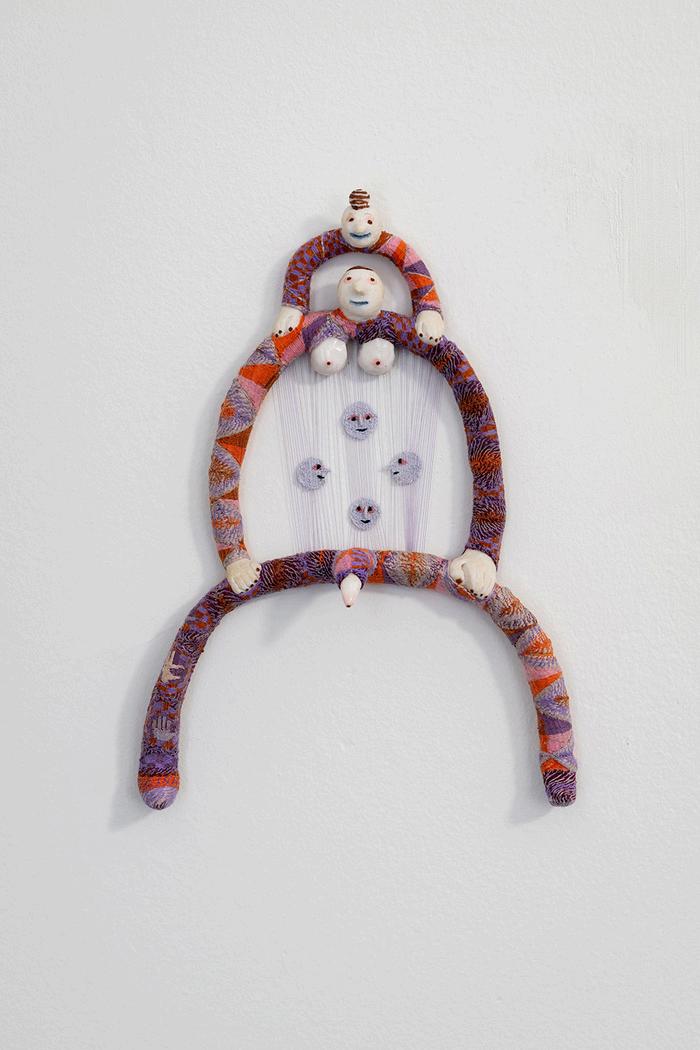

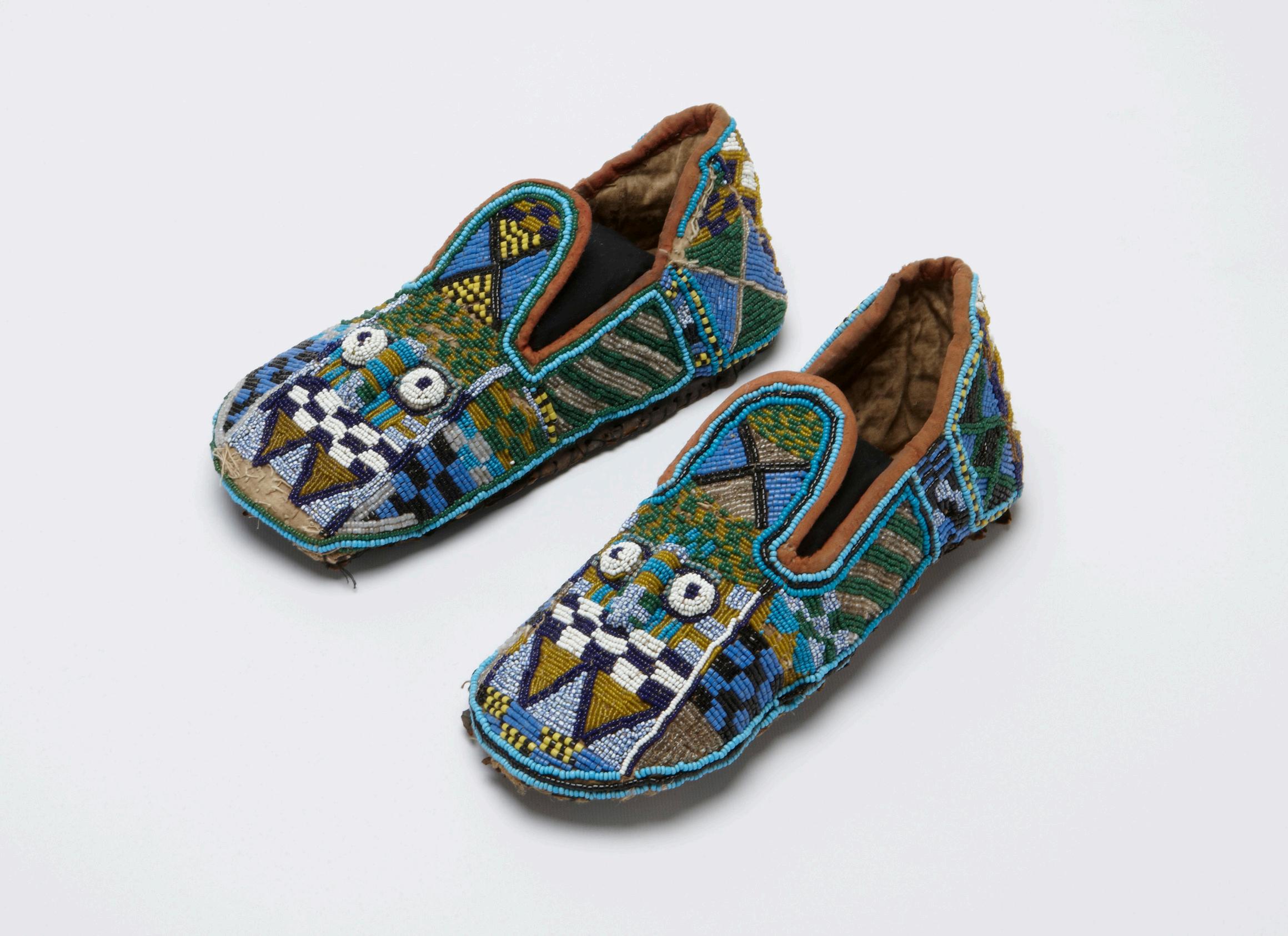
Selection from the Art Institute of Chicago collection: Slippers (Bata Ileke), 1875-1925, Yoruba
Minami Kobayashi MFA ‘18
Author John Rewald described Pierre Bonnard’s myth as if there ever were “such a thing as the exquisiteness of banality,” it could be found in the artist’s exquisite sensibility and use of recollected light. An Edenic landscape in an unnaturally wide panoramic scene encloses purplish-azures tinted in sun-licked yellows and greens of sky reflected onto the earth, and earth onto mortal creatures in Earthly Paradise, 1916-20 The horizon no longer divides but curves planes as seen from the top of a hill In an entirely active canvas framed in flora and fauna, a male and female subject pivot our vision to the sublimity of light at dusk, pooling at the center of frame Assimilated into Prussian blue topiary to the left, a man gestures towards the painterly aspect of nature To the right, a milky white-skinned nude woman lies with her arms raised in surrender. Ambient blue light echoes in elements hidden across the field; wild game and a marsupial observer on the ground, and an exotic bird in the tree overhead. Bonnards brush conveys a strange yet beautiful shared psychological reverberation between darkening skies, trees, and bodies approaching nightfall.
It is well known that many French impressionists were indebted to Japanese printmakers and artists, as several incorporated strategies like windows as compositional frames, providing silent witness to lives inhabited in private spaces. Drawing on the dramatic tendencies between interior and exterior worlds, Minami Kobayashi thinks through color, presenting a vivid oil on linen canvas, In a room on a high floor, 2024. Framing an exterior view of Istanbul as seen by the artist from her room “ on a high floor,” the artist treats a historically European medium with the same dexterity she has come to be known for in egg tempera works Shells of translucent Japanese ‘Compose Blue,’ a kind of turquoise, meet subtle hints of lilac and yellow in threefourths of the upper quadrant of frame, depicting an atmospheric overhead view of the city A translucent white tablecloth reflects and diffuses the vividness of perfectly formed clouds Beneath, a pearly pug pokes his head to gaze right across an immaculately rendered perspectival mustard-tiled floor A pair of white Japanese platform sandals lie casually strewn before an ornate wrought iron balcony, their relaxed disposition mirroring Bonnard’s disenchanted Eve. What is most peculiar about Kobayashi’s composition are the reddish-brown rooftops, directly referencing Bonnard’s View of Rooftops at Cannet, 1941. Over 1500 miles and 80 years apart, their likeness can be rooted in the arrangement of dying green-leaved tulips in the same position as a thick leafy presence between Bonnard’s famed rooftops. The only marker of time and distance? A diminutive white line, a vapor trail, left behind by an aircraft cruising above the Bosphorus.
Pia Singh
Selection from the Art Institute of Chicago collection: Pierre Bonnard, Earthly Paradise, 1916-20
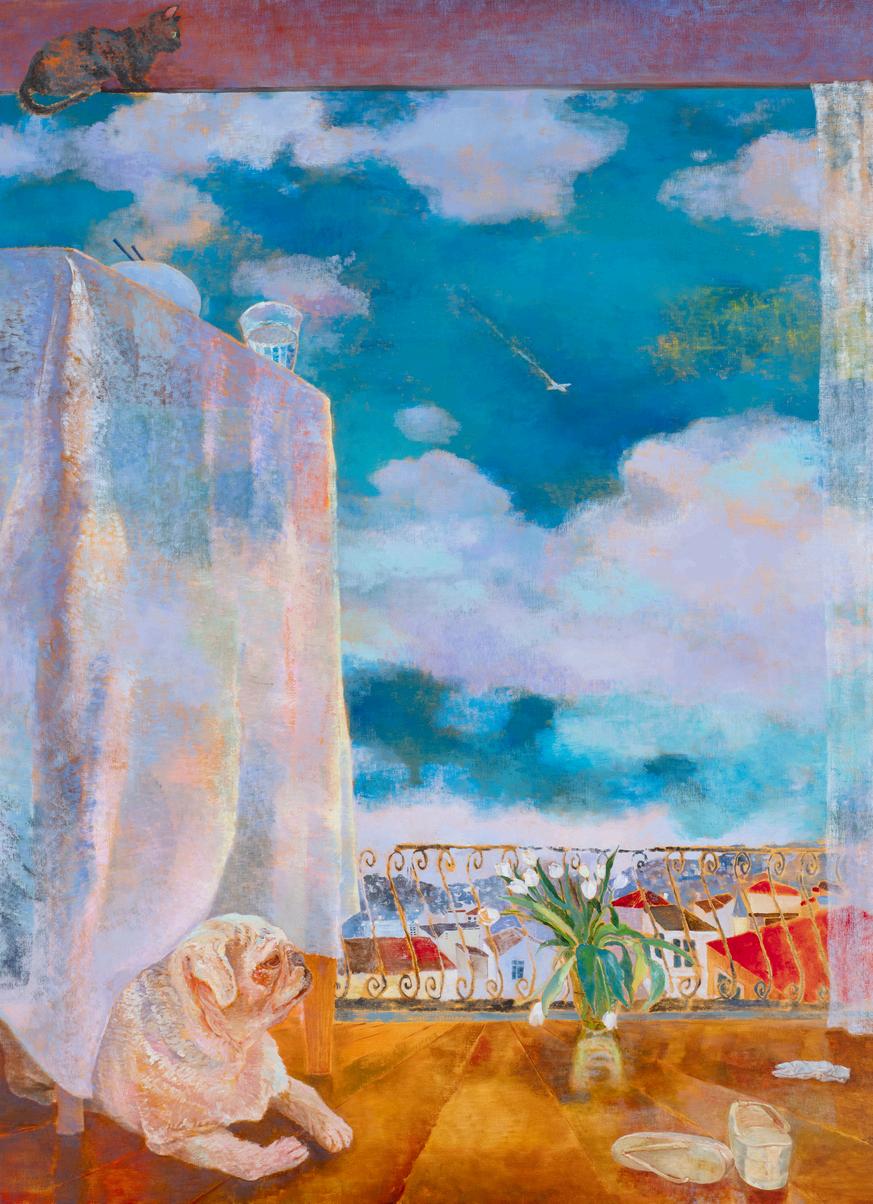
Meredith Kopelman
Post-Bacc ‘20, MFA ‘22
In Fishing Boats with Hucksters Bargaining for Fish (1832-42), J.M.W. Turner’s differentiated brushwork delicate in some passages, forceful in others translates natural light into a presence that feels almost volatile. His modulation of paint density allows sea and sky to collapse into one another, eroding the line between elements. Here, surface is a veil through which to peer; paint becomes a means of immersion, pulling the viewer inward with a realism shaped not by precision, but by sensation Turner does not depict a moment so much as recreate its flux light refracting, water shifting, wind moving across the sky
Meredith Kopelman’s painting Anything But (2024) pulses with a similar charge, though its energy rises from a distinctly contemporary plane Where Turner’s surface dissolves into atmosphere, Kopelman keeps hers assertively intact. Paint is laid down in bold, independent gestures confident swaths of color that map vertical thrusts and lateral drifts, tracking the eye across the canvas rather than through it. The image is not something to enter, but something to engage at eye-level: graphic, compressed, and built of tension. A distant boat offers a visual anchor, but never quite settles the scene.
Both artists make movement their subject, yet the nature of that movement feels shaped by time, context, and intent. Turner paints a world in flux, his surfaces dissolving into vapor and sea spray, drawing the viewer into the environment’s shifting center. Kopelman, by contrast, constructs her image from the surface out its motion unfolding laterally, rhythmically, with a charge that stays on the skin of the canvas Direction becomes a matter of perception: does the eye travel through the scene, or across it? In both cases, sensation takes form, but the kind of presence each painting conjures ephemeral or emphatic, immersive or insistent offers a different way of feeling one ’ s way through the storm
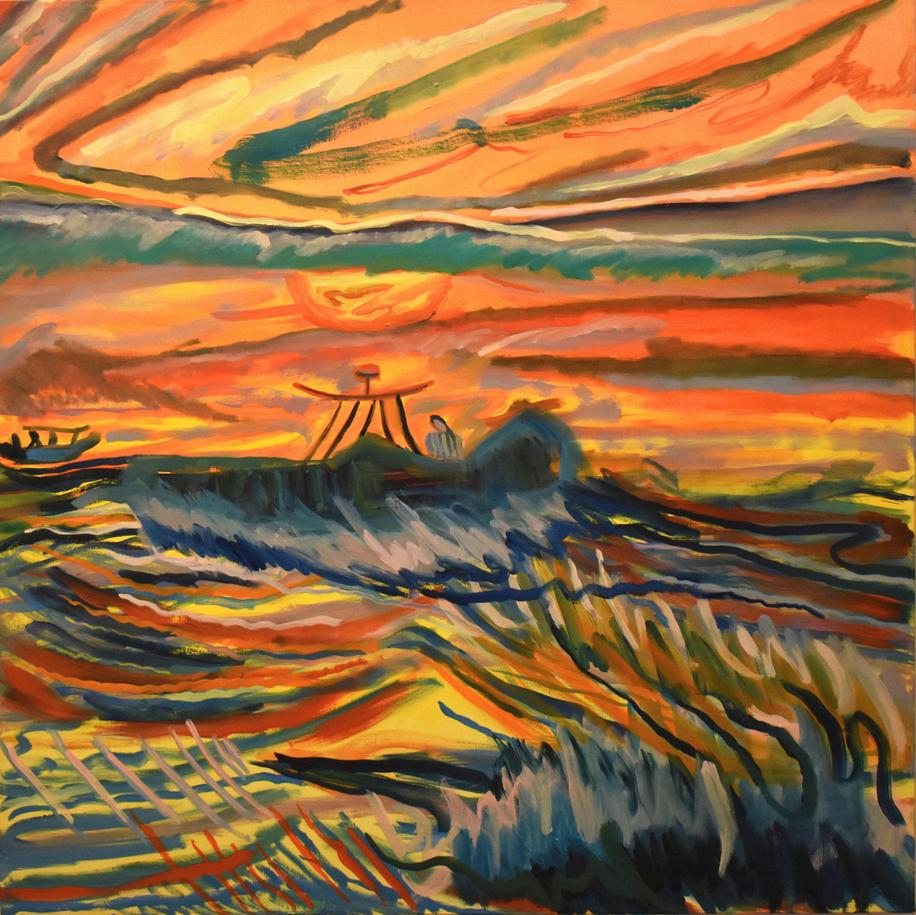
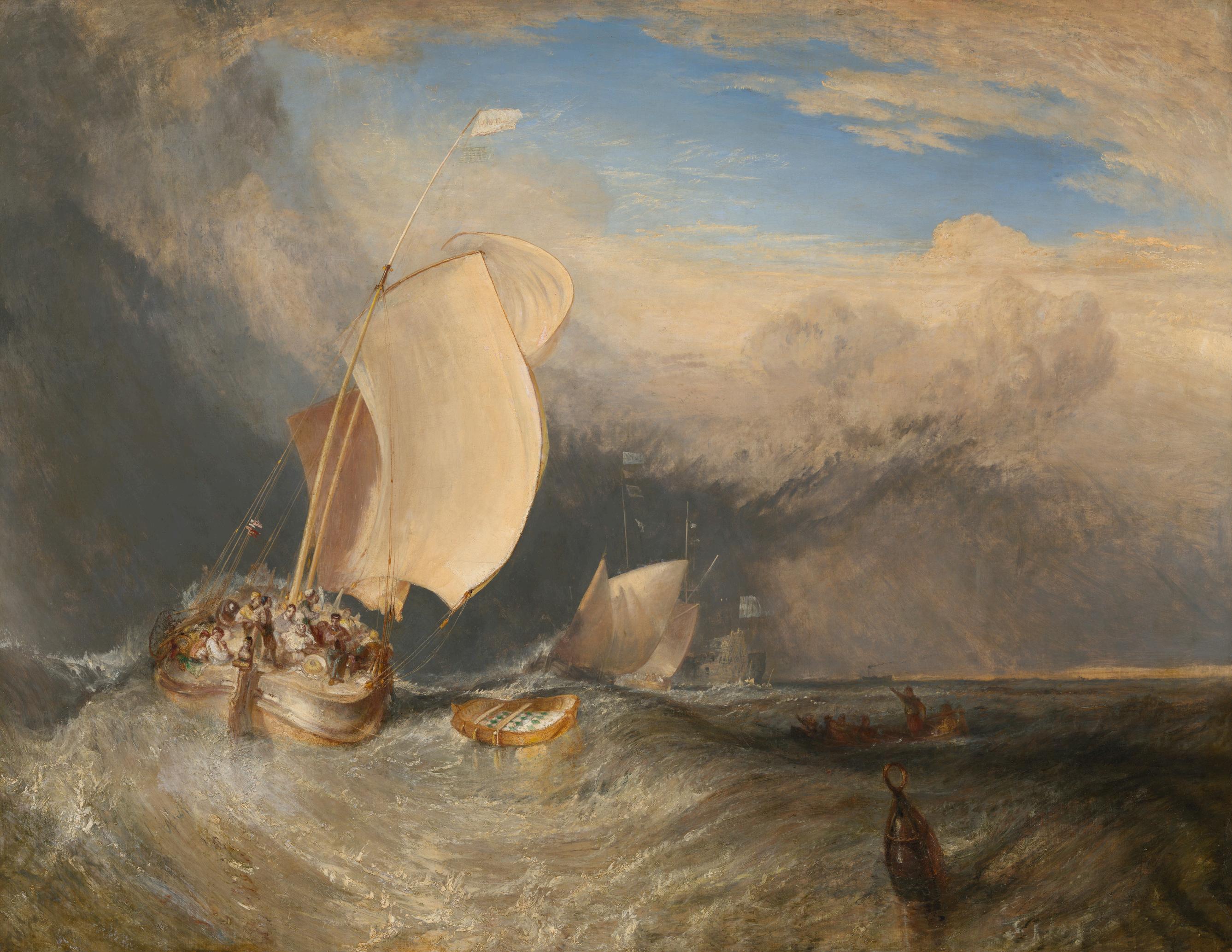

Selection from the Art Institute of Chicago collection: JM W Turner, Fishing Boats with Hucksters Bargaining for Fish, 1832-42
David Leggett
MFA
‘20
David Leggett abuts collage, quotation, and painterly gestures that emphasize surface and color in order to craft cuttingly ironic punchlines critical of authority, power, and the produced realities of racial category. An earlier era of minstrelsy haunts the cartoon imagery and stylistics that Leggett deploys in order to test how the overtly pictorial and more latently formal features of metonym, stereotype, and abstraction contribute to widely held assumptions based on skin color, perception of class, and similarly pernicious projected taxonomies. In A hard head makes a soft ..., 2025, the brown shade that predominates the painting’s buckling, patchwork surface passes into the linework illustrating a child and admonishing elder, so that the material substance of these figures is continuous with the field on which they are displayed This sly formal move signals to the constitutive roles performed by Black populations in the construction of America’s landscape, industries, and cultural economy inscribed with threats of domination either implied or explicated, as in the painting’s title (colloquial warning for a butt whooping to punish stubbornness); the black, green, red of Pan-African solidarity spelling “I Brought You Into this world And I can Take You Out” in felt appliqué; and a vintage McDonald’s ad featuring what appears as a Black father and son, captioned with the assurance that their “Golden brown” fries are for “Everybody,” ending with the ominous claim, “WE DO IT ALL FOR YOU.”
The legacies from which Leggett acts are built from artists critical not only of the exclusions of a white supremacist art world, but also some of the uneasy, instrumentalizing ways Blackness has been strategically included in dominant cultural narratives. Kerry James Marshall developed his use of figures rendered in black pigments as a means of contesting problems of representation, invisibilities, and equally fraught visibilities. His large 1994 canvas Many Mansions enlists tropes of history painting, decoration, ornament, and strategic abstraction to deconstruct some of the ‘separate but equal’ mythologies carried with Jim Crow, integration, and systemic racism the impacts of which are actively harmful to this day Marshall and Leggett both use incisive images, historical citation, and well-timed humor as rhetorical moves to confront not only the tragic failures of humanist idealism but also the gatekeeping, ghettoization, and marginalization that characterize painting as a shared cultural practice
~Matt Morris
Selection from the Art Institute of Chicago collection: Kerry James Marshall, Many Mansions, 1994
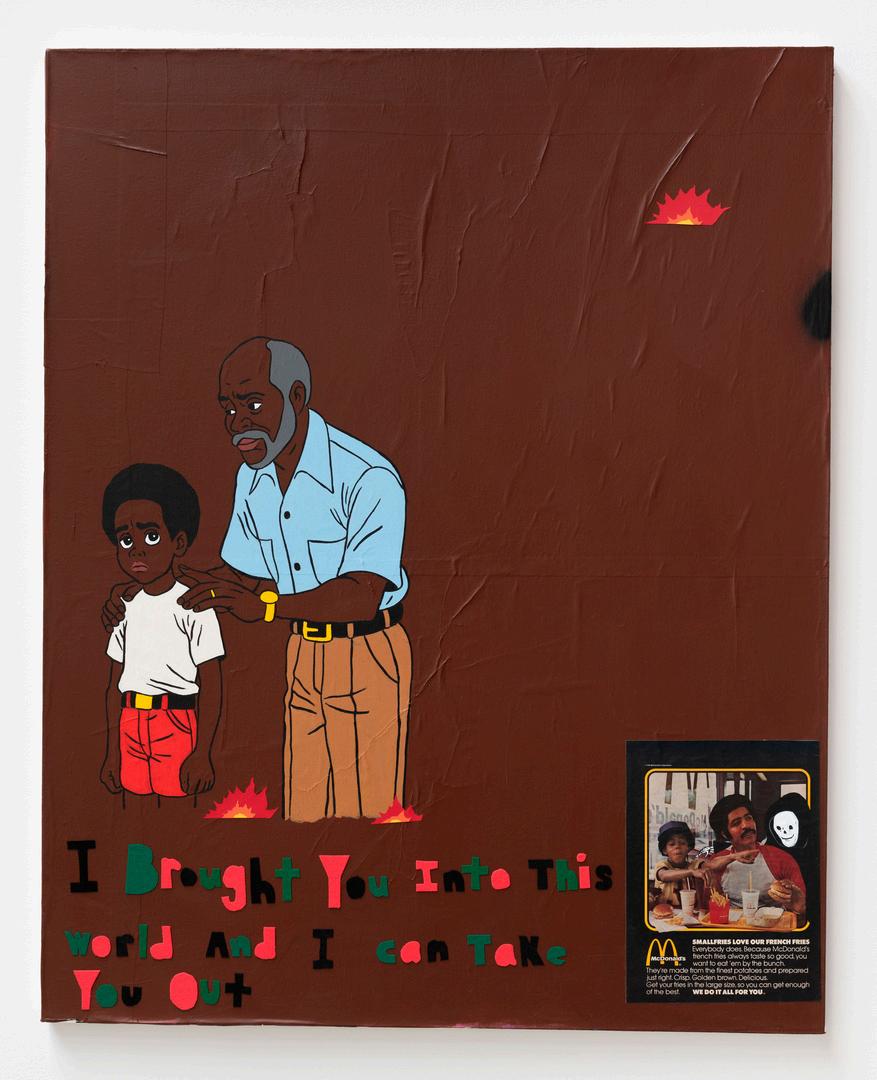
Tony Lewis BFA ‘10, MFA ‘25
Setting Tony Lewis’ Thing (2023) alongside Stuart Davis’ Ready-to-Wear (1955), a work in the permanent collection of The Art Institute, draws attention to language itself as one of culture’s oldest readymades. Davis’ title urges one directly to the turn-of-the-century origin of this notion in advertising culture, as the phrase “ready-to-wear” then indicated the novelty of clothing available for purchase right off the rack. Not long after its appearance, the phrase found itself embedded in the artistic canon, and thus proved readily available for use by Lewis and Davis both. Indeed, the two artists refine a vocabulary and syntax culled from popular culture, found and invented language, and written symbols. This calculation does not ensure clarity, however. Though Davis restrains his lively angular forms to a limited number of iterations, the color blocks seem to remain largely indeterminable as recognizable forms, with the exception of perhaps an x-like intimation of scissors in the top right corner of the composition Similarly, Lewis’ balanced elliptical shapes appear to glob around each other, legible primarily as luminous abstract forms, held together by a central graphite figure
It should be noted, however, that in addition to gleaning vocabulary from the surrounding world, both Lewis and Davis craft works which pull from the ready-made symbolism of their own oeuvre. Thus, one might conclude that Lewis’ graphite figure builds upon the artists’ preceding explorations of Gregg shorthand, a system of pen stenography which translates phonetic sounds into script, thus allowing the title-gesture “thing” to duplicate the objectifying power of Davis’ “readymade.” Likewise, Davis’ use of red, white, and blue would be no accident with his other works in mind, as he had long since made clear his dedication to his belief in American democratic values in the face of European fascism. What these artists maneuver most effectively, then, is the actual enactment of shifting power dynamics of attention and legibility as they each model within their own parameters a politics of visibility, identity, and circulation.
~ Barbarita Polster
Selection from the Art Institute of Chicago collection: Stuart Davis, Ready-to-Wear, 1955
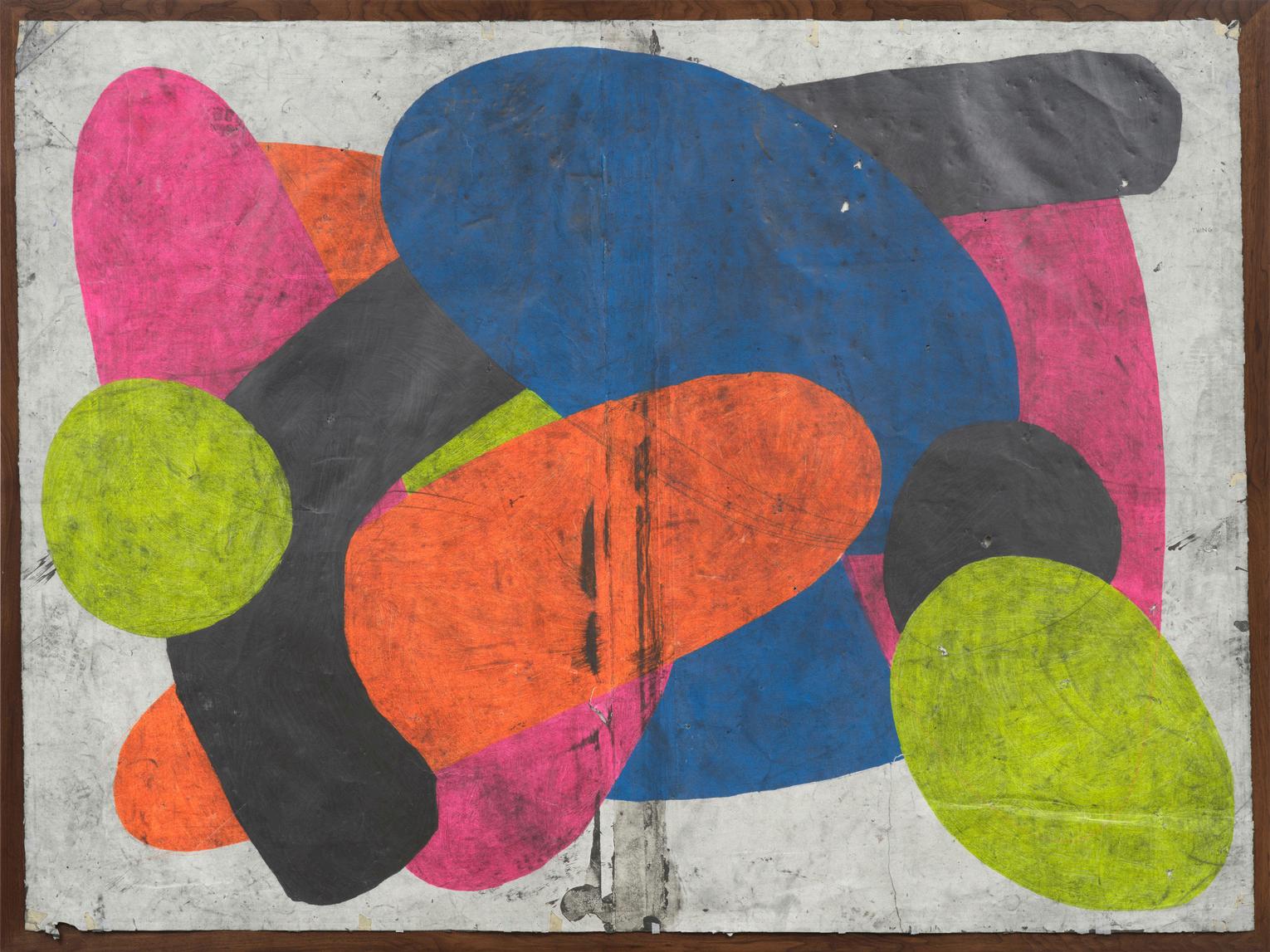
Graphite, pencil, and colored pencil on paper
75 5 x 100 5 x 1 inches, mounted on panel
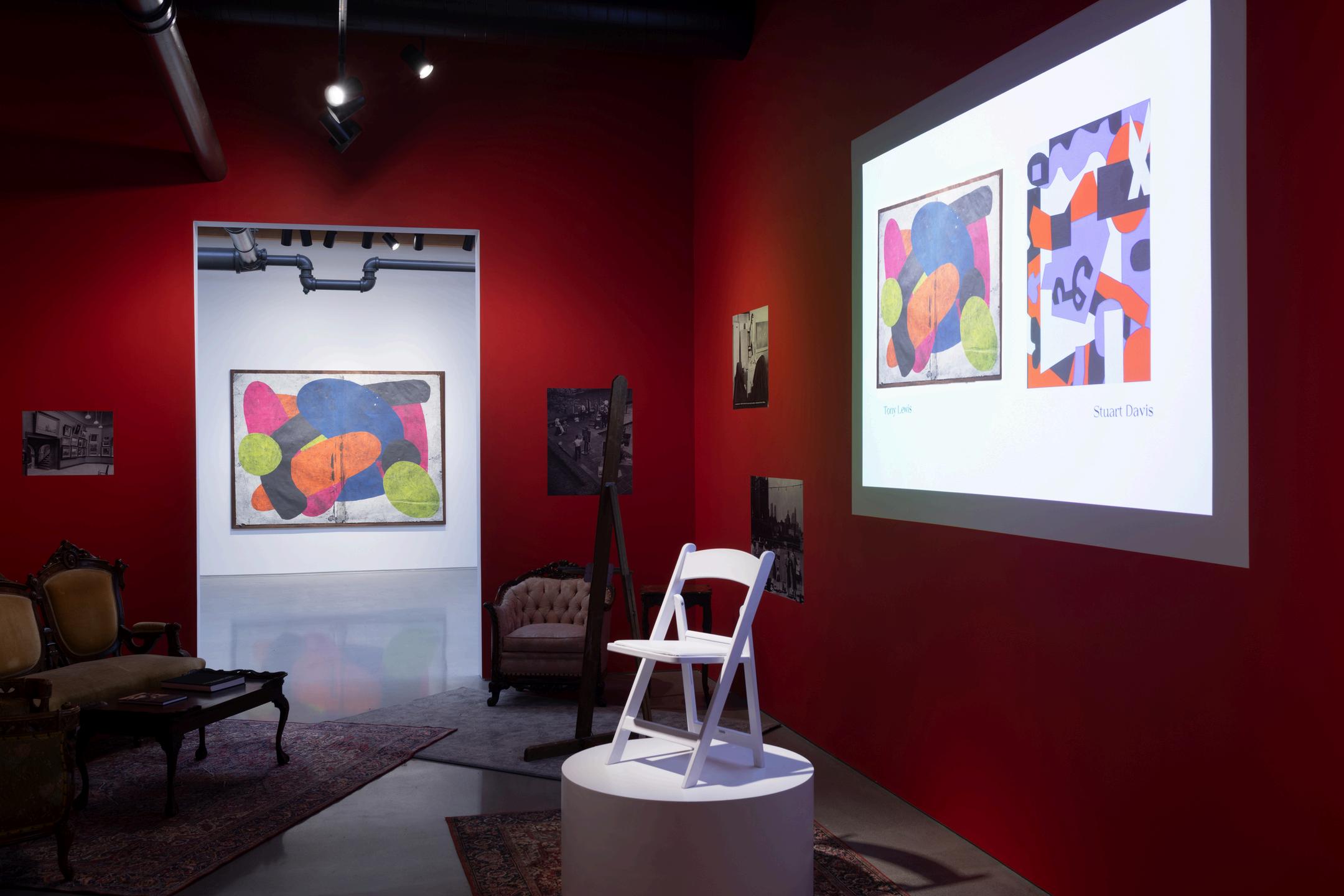

MJ Lounsberry
MFA ‘23
MJ Lounsberry’s Springtime in Love pictures a liberated leaping figure, enveloped in swells of soft yet assertive color less posed than exhaled. Like Matisse, Lounsberry avoids realism in favor of affective space where form is shaped by hue, temperature, and touch. Henri Matisse’s Poésies (1932), an etching of a woman ’ s animated body, included in a book of poetry, may appear far removed from his early Fauvist period Yet, with rhythmic lines and pared-down forms, there is a sensibility forged decades earlier
Fauvism’s expressive color and liberation from naturalism live on in these drawings not in hue, but in spirit The human figure is rendered through sweeping, calligraphic contours, capturing not anatomical precision but a felt sense of movement, intimacy, and grace. Even in his later, more restrained work, Matisse treats the body less as an object than as an emotional atmosphere open, vital, and in tune with the soul.
Lounsberry’s use of color is intuitive, even euphoric, suggesting not only flesh and light but mood and memory. And while Matisse’s figures often reflect an idealized, generalized humanity, Lounsberry’s bodies are self-possessed, unapologetically feminine, and unmistakably contemporary.
What does it mean for a gesture born in the radicalism of Fauvism to echo through such different historical and social terrain? Can the emotional truths of early modernism still be accessed, even transformed, in the hands of a new generation? For both Matisse and Lounsberry, the body emerges not as a fixed form, but as a site of becoming a surface onto which longing, joy, and sensuality are projected If style evolves, can spirit remain constant?
Selection from the Art Institute of Chicago collection: Henri Matisse, Poésies, 1932

Wangari Mathenge MFA ‘21
Edward Hopper’s Nighthawks (1942) is one of those most beguiling works of art Its enigmatic qualities are exactly what make it so powerful, so magnetic; your eye continually searching a space that feels both desolate and serene There is detail and equally weighted obscurity The more you attempt to decipher its coded messaging, more questions than answers emerge It is the space between things, between people, that speaks most audibly: the quiet scream of loneliness Like the distance between letters or lines in a poem, when the poet takes a beat, a breath that is the space created by Nighthawks.
It is fitting then, that Wangari Mathenge would direct our attention to this painting when considering her own practice. Her work creates its own sense of time, its own pacing, reclaiming space specifically for Black women who have historically been left out of the frame. Such is the case with Our Time (2024). Here, the frame of the canvas can barely contain the seated Black female figure. Here, she is the poet, taking a beat, a breath.
Mathenge offers us this point of intimate reflection, a moment out of time, defining “ our time.” But still that sense of togetherness suggested by the “ our ” feels tenuous Like the figures in Nighthawks, one can feel the space between the figures in Mathenge’s painting, despite their closeness Sometimes there is still a great loneliness in being together with someone, which only seems to heighten the feeling of being alone It pulls us down, our eyes down, our shoulders down, our chest and breath down, deep
In this way, with their obvious differences aside, perhaps these two works have more in common than not. It is after all an especially human emotion and experience, loneliness. They are moments we sometimes feel most alive, aware of ourselves and the vulnerabilities that shape us just as much as our power and strengths. We are complex beings, and Mathenge gives us this opportunity to look within and to brush up against the experiences of Black women, especially those of the African diaspora and the many subjectivities such an existence creates. Our Time is a quiet time, and one that I wish to hold onto, to stay a little longer.
Steven Bridges
Selection from the Art Institute of Chicago collection: Edward Hopper, Nighthawks, 1942

Kristoffer McAfee
BFA ‘20
Kristoffer McAfee reactivates the tension found in Thomas Arndt’s Two Sailors in a Parade (1987), decades later, in his 1960 Time Capsule (2025). In Two Sailors in a Parade (1987), Thomas Arndt asks what it means for a national symbol to unite and divide in the same breath. The photograph captures a moment of tenuous unity: two young men one Black, one white jointly carrying an American flag through a public street. The image reads as both documentary and symbolic, its central motif a shared gesture that quietly unsettles. The flag, stretched taut between the two, operates less as a celebration of shared identity than as a visual hinge linking the figures while subtly emphasizing the sociopolitical rift between them. Arndt’s framing suggests that even gestures of collectivity are never without tension, particularly within the charged optics of race, patriotism, and visibility
McAfee’s painting is a sculptural reworking of the American flag overlaid with text, residue, and allusion If Arndt’s flag is a document of the present, McAfee’s becomes a repository layered with fragments of history, language, and critique His intervention is less observational than declarative: the surface of the flag refuses to resolve into unity, instead becoming a palimpsest of rupture and reckoning. Yet rather than offering a single message, McAfee’s work invites closer inspection what is being preserved, and what is being exposed?
Across generations and media, both artists expose the labor demanded of national symbols and the weight they bear in the visual field. The interplay of text, figure, and form, reframe iconography through aesthetic and cultural vocabularies. Whether through photographic tension or sculptural inscription, these works ask: how does one hold space for critique within the frame? How might a symbol resist flattening, and instead become a site for ongoing negotiation?
Selection from the Art Institute of Chicago collection: Thomas Arndt, Two Sailors in a Parade, 1987
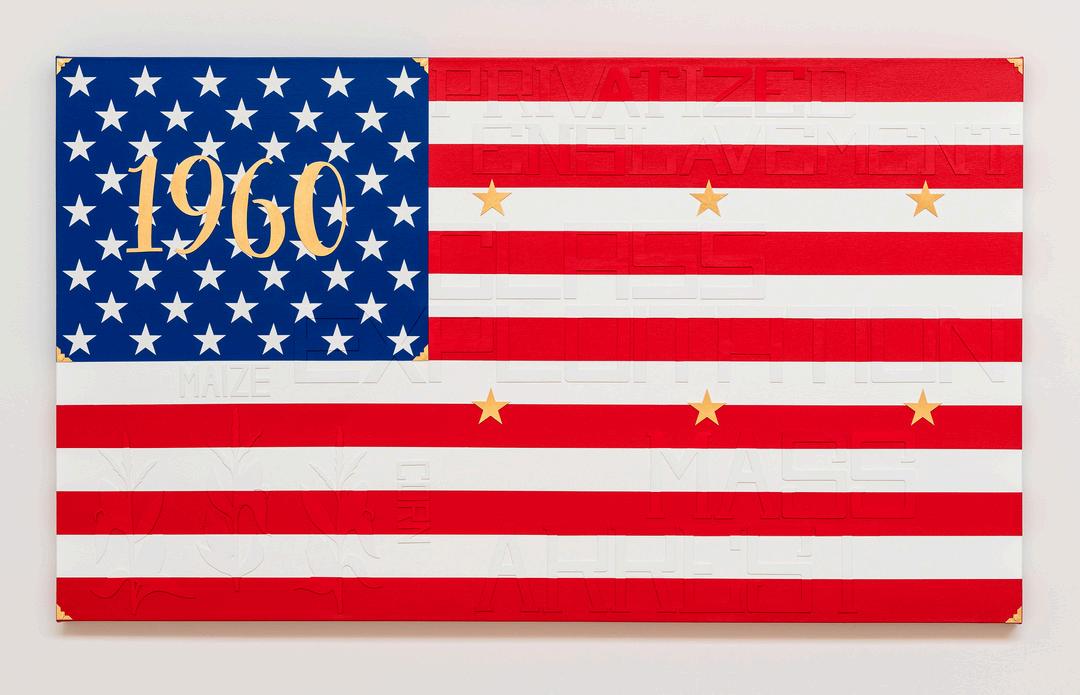
Rodney McMillian
Post-Bacc ‘00
Horace Pippin’s Cabin in the Cotton asks the viewer to read race not through figuration, but through hue, structure, and atmosphere. Pippin compresses distance: the cabin and fields rendered in deliberate planes of brown, green, and gray seem to hover in shallow space, resisting the depth of mythologized landscape painting. His brushwork doesn’t romanticize; it locates labor, survival, and racial presence within the color fields themselves. Subjectivity, here, is both seen and felt in the land. As Rodney McMillian has noted, this is one of the rare instances in which Blackness both formal and lived is fully acknowledged within the canon of American painting.
McMillian’s own photographic work engages Blackness differently: not through the landscape, but through the object, and the violence done to it His series begins with a found bust, discarded on the streets of Los Angeles plaster, painted gold, then crudely overpainted in black An artist’s attempt at racialized form becomes a grotesque echo of minstrelsy In McMillian’s hands, the bust is photographed with classical formality, cloaked in velvet, and repeatedly reproduced Each print is labeled as an “original,” flattening notions of authorship and identity. Unlike Pippin’s careful composition, McMillian’s intervention emerges from accident, tragedy, and cultural debris. His work doesn't depict Blackness; it confronts the viewer with the ways it is distorted, discarded, and commodified.
Together, these works assert Blackness not as subtext but as overt presence rendered through materials deeply embedded in Western art history. Pippin’s Cabin in the Cotton speaks fluently in the language of American landscape painting, yet refuses its idealizations. Through flattened space and modulated fields of color, he reclaims the genre to center Black life and labor. McMillian, too, adopts classical tropes a bust, a velvet backdrop, the visual grammar of portraiture but his use of photography, replication, and the grotesque interrupts their authority. Where Pippin inserts narrative through paint, McMillian exposes distortion through form Both artists operate within inherited visual lineages, but their work unsettles those legacies, making Blackness not only visible but structurally integral What appears familiar a rural scene, a stately bust is rendered newly unstable, charged with the weight of what those forms have historically excluded

Unknown #22, 2006
unique C-print
39 x 31 inches, framed
Courtesy of the artist and Vielmetter Los Angeles


Selection from the
Isabella Mellado MFA ‘23
Relief of a Falling Warrior, an ancient marble sculpture in the collection on the Art Institute of Chicago, caught painter Isabella Mellado’s attention immediately. In her quest to give shape to her mystical characters, she is constantly seeking inspiration from Greco-Roman art and mythology.
Mellado’s vibrant painting Boreas (2024) features Boreas, the personification of the north wind, who appears floating mid-canvas in the same reclining pose as the falling warrior. But whereas the Trojan warrior is depicted dying to protect his homeland, Mellado’s subject is suspended in an in-between space, drawing the viewer into a wonderous afterlife, hinting to a space that can be reached through a spiritual journey.
Boreas represents change just as the north wind is typically a herald for the arrival of a new winter season This carries uncertainty: will we get through it, will we survive, in what form? Mellado embraces the uncertainty of life’s most existential questions through the very act of creation In her composition she explores the balance between the generative nature of life, the human need to seek control over it and the ultimate dance with mortality and surrender Her bold stroke and electric color palette infuse courage in view of what comes next
Figuratively, one common element stands out: the dignity of a mature body but while the body in the ancient relief is clearly male, Mellado leaves that detail open-ended in her creation, her Boreas is gender neutral. This ties to Mellado’s strong and purposeful visual exploration of queerness. In her unique way, by anchoring her portrait of the God of change to a context that explores gender identity, Mellado is prompting global intercultural conversations that are ambitious and fulfilling.
In contrast to the Art Institute relief, which is one of many Roman copies of a Greek prototype, Mellado’s interpretation of Boreas is highly original. Whereas the dying warrior at the Temple of Aphaia provided a source for countless sculptures in antiquity, Mellado elevates the iconography her character by turning it into a distinctive icon of which she is the sole creator
~ Silvia Beltrametti

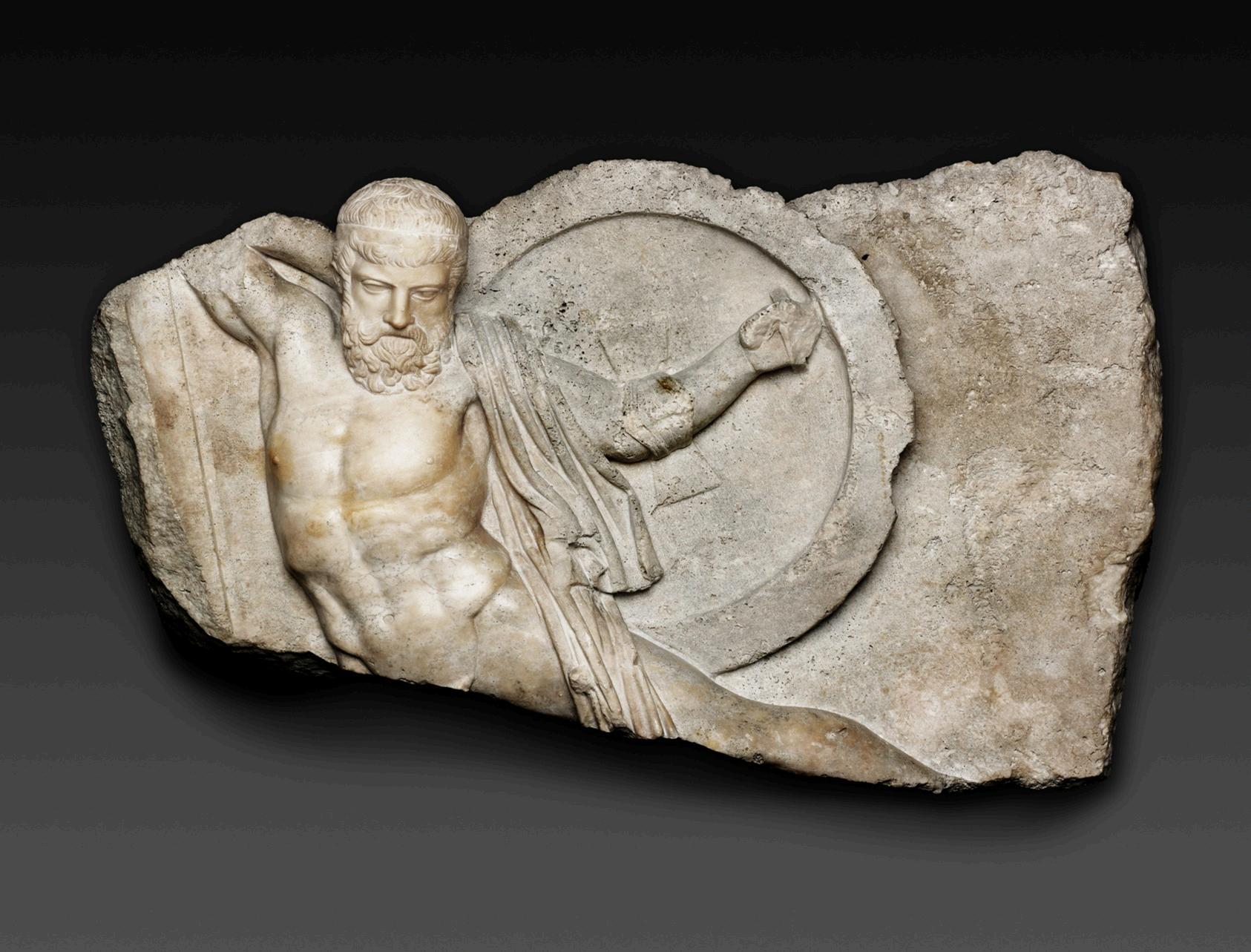
Selection from the Art Institute of Chicago collection: Relief of a Falling Warrior, 101-200 CE, Ancient Roman

Emily Miller MFA ‘25
In referencing a work that strongly reverberated for me during my time as a student, I selected Still Life Reviving by Remedios Varo. I draw a kinship between this work and my piece A Sunlit Absence in the shared exploration of mysticism, circularity, and cosmic order, the ritualistic and alchemical, surrealism, nature, and fragility. When I visited Varo’s exhibition, “Science Fictions,” at the Art Institute of Chicago, I witnessed her seamless fusion of the physical world and the metaphysical. Both of our artworks explore circular and orbital compositions, creating a sense of movement and interconnectedness. Where Varo depicts natural materials such as exploding pomegranate fruits, I hand carve and paint ostrich eggshells with ostrich egg tempera that I mix myself Her fearlessness in pioneering material experimentation continuously inspires me and guides my own interrogation of the perpetual transformation of matter as it relates to life, death, and whatever is in between
~ Emily Miller
Selection from the Art Institute of Chicago collection: Remedios Varo, Still Life Reviving, 1963

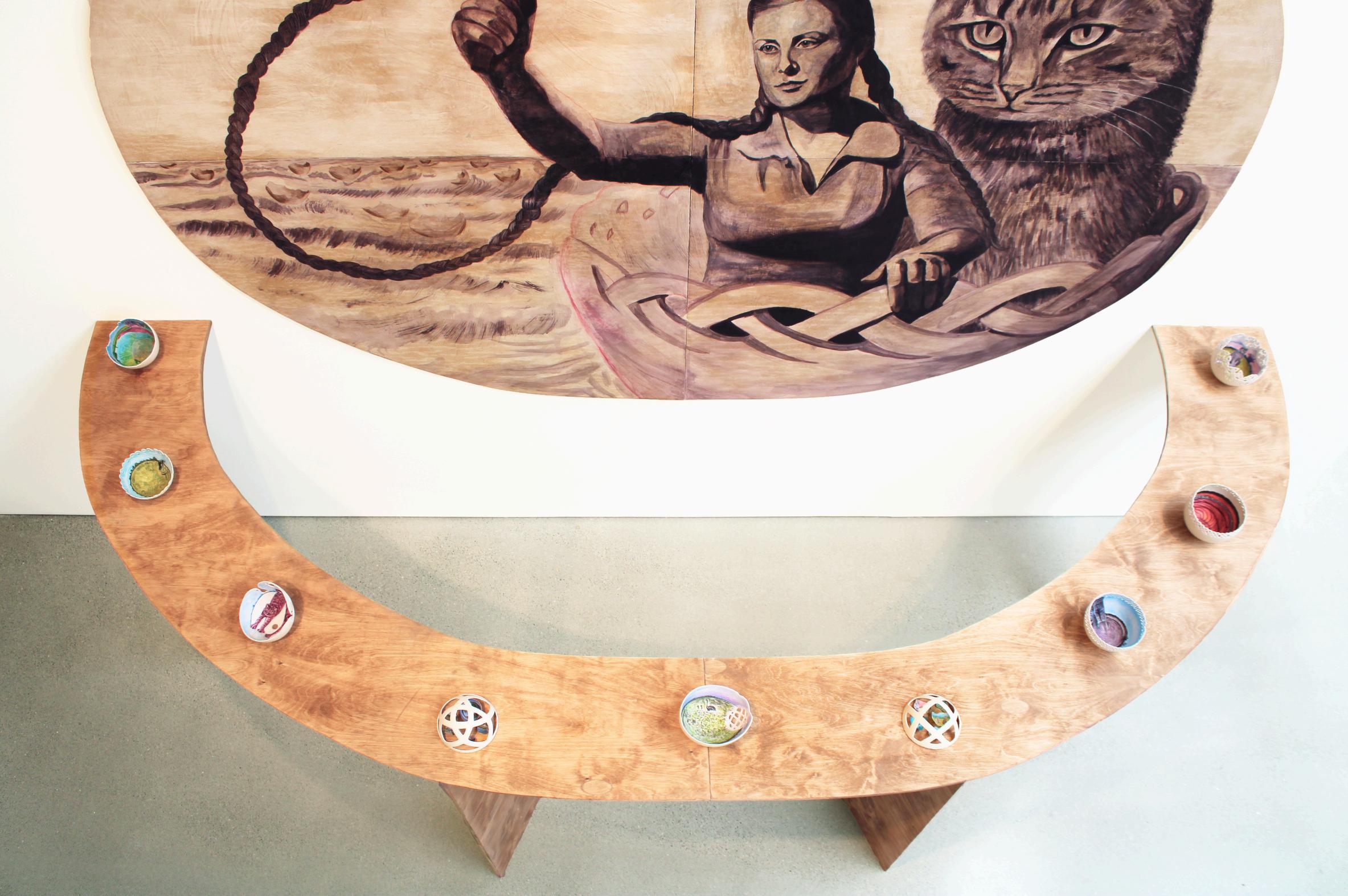


Jeffly Gabriela Molina
MFA ‘16
In Feelings (2023) and Untitled #12 (1977) respectively, Jeffly Gabriela Molina and her predecessor, Agnes Martin, tenderly prod the relationship between figure and ground into the affective realm, edging a general sense of groundlessness into literal questions of transparency and stability Martin’s carefully ruled lines mark narrow columns and broad rows, the line weight shifting delicately under the weight of the artist’s hand as it moves across the canvas The cloudy surface beneath the linework likewise bears subtle gradations in value, somehow evoking both separate planes between the two elements, as well as intimate touch A similar smoky ground continues behind the two figures at the center of Molina’s work before easing downward, expanding beneath the wall-moulding into red-checkered floor tiles a movement that upends any firm sense of ground as the gridded surface beneath the feet of the figures reveals itself to be as transparent as the figure on the right. Still, Molina gestures toward steadiness, as the embrace of one ghostly figure supports and reinforces her duplicate. This fortifying gesture interrupts the otherwise symmetrical balance that exists in each of the two paintings, even though the presence of Molina’s second figure suggests that all of the components needed for such a sturdy equilibrium readily stood present. In this way, Molina draws a subtle underline beneath the relationship of intimacy to stability, even despite or perhaps especially in the face of an oscillating ground.
~ Barbarita Polster
Selection from the Art Institute of Chicago collection: Agnes Martin, Untitled #12, 1977
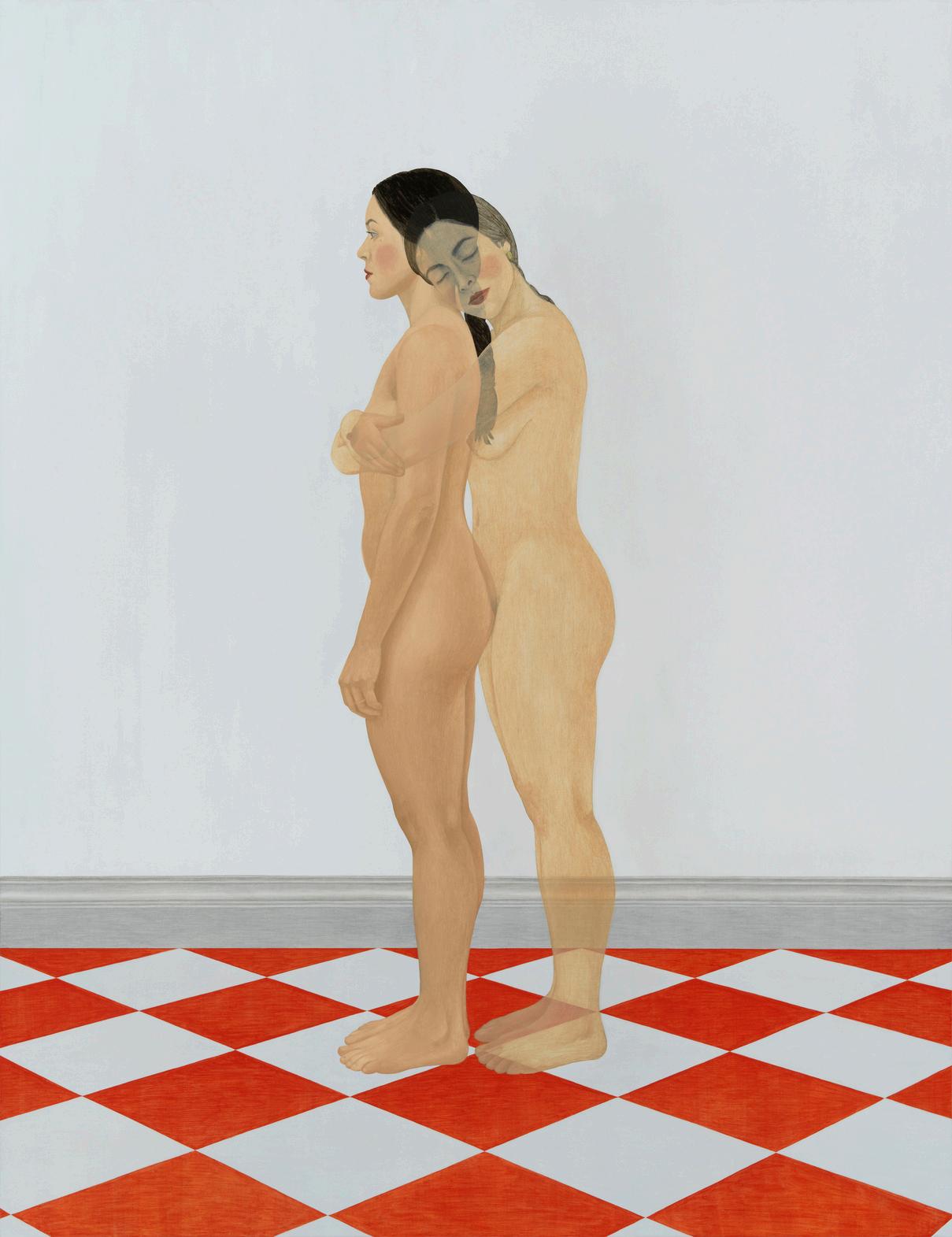
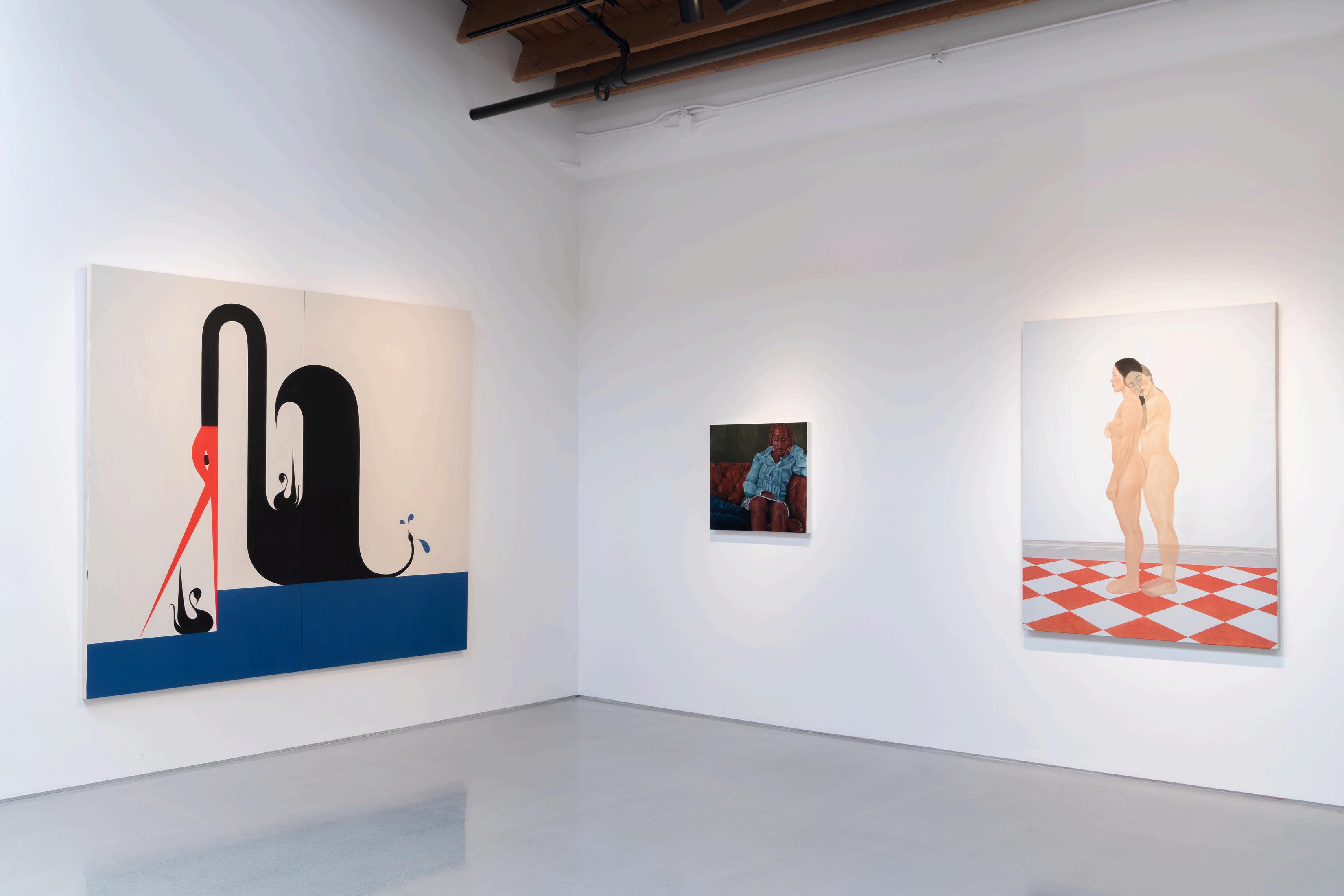

Aliza Nisenbaum MFA ‘05
In Aliza Nisenbaum’s Marisol’s Nighttime Porch a low, light-orange parapet behind the figure cuts the distant brick wall at right angles, delineating the enclosure That which can be contained is contained. The potted trees surrounded by vines may at some point suffer their embrace, but for now all is in harmony. The animated figure is centered in the space and in herself. As the light dims, casting shadows on the plants, a single hand, fingers dabbled with color, points down to the earth like a mudra.
In Rufino Tamayo’s 1941 painting Woman with a Bird Cage, the protagonist’s strong body is a sculpture at once Cubist, pre-Colombian, Modernist, and architectural. One long arm extends to open the cage door, which is already slightly ajar. A bird tips forward, ready to leap from its perch; there is anticipation. While the decorative curves of the railing let the outside in and turn the inside out, the thin vertical bars of the cage slice the angular, salmon-colored, stucco building across the street A pulled-back curtain frames the cloudless sky
In each painting, the hair of the figure is long, luxurious, and fashionable for its time In the work by Rufino Tamayo, however, there is tension between voluptuousness and restraint History and indigeneity are present in both paintings, conveyed in the bold planes of color that define the expressions of the women at the center of each Racial identity is more deliberate in the Tamayo––the artist was of Zapotec descent. The elongated ear and earlobe and the distinct slope of the nose could signify Mayan features. The protagonist smiles at the bird, a portent of a longed-for freedom to come.
Tamayo’s palette is subdued in flat tones of the earth; Aliza Nisenbaum’s palette is raucous. Liberated. The figure on the porch turns confidently toward the viewer, neither to please nor to attract. Tropical foliage dances in multiple directions, holding up a luminous, blue, twilight sky that is an analogue for the figure’s dress and jacket that are so vibrant they create a garden within a garden––more exuberant and playful than nature herself.
~ Carol Becker
Selection from the Art Institute of Chicago collection: Rufino Tamayo, Woman with a Bird Cage, 1941
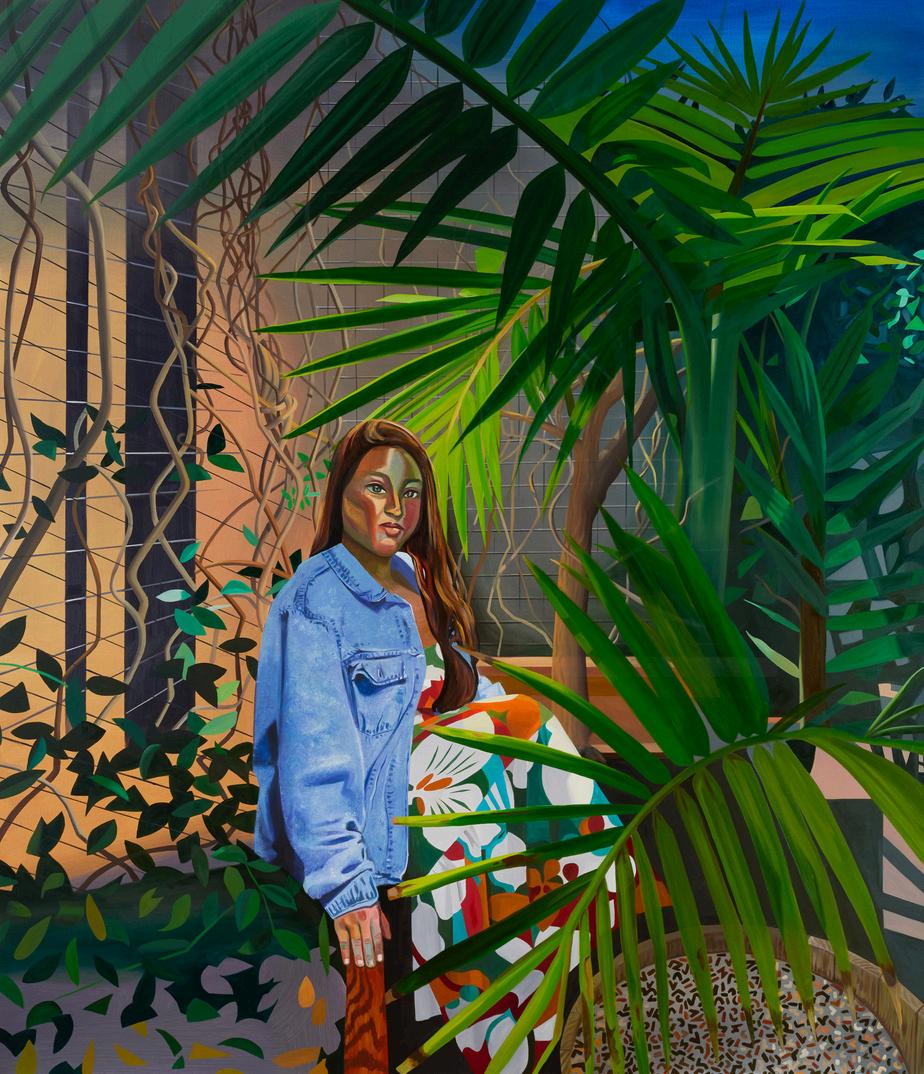
Angel Otero BFA ‘07, MFA ‘09
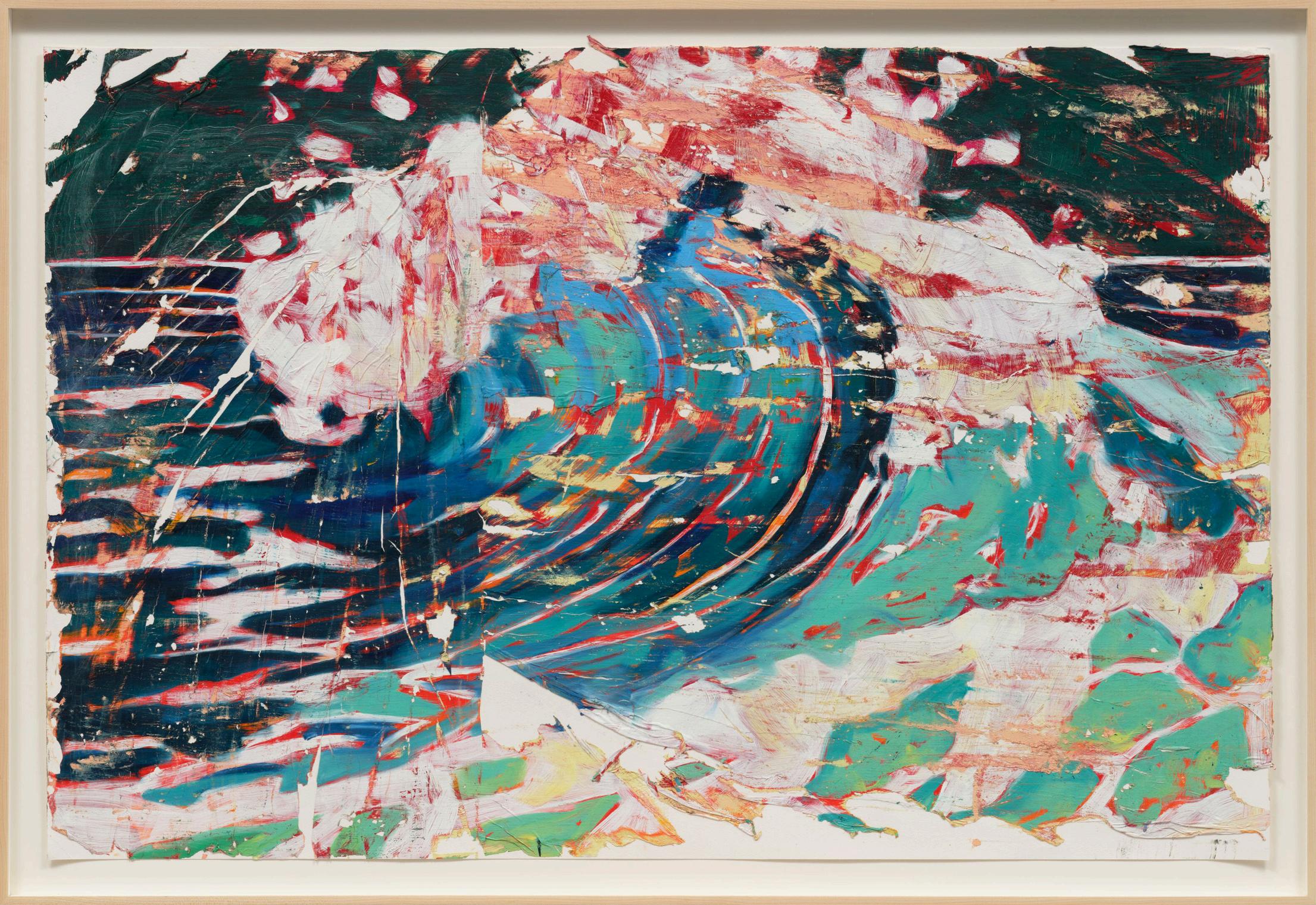
Willem de Kooning and contemporary artist Angel Otero are connected in that their painterly approaches are both intensely process based Since the Post-War period, there has been a considerable explosion of new and different methods of painting Imagine any given rule that once governed what constitutes a painting and shred it, grind it, scrape it, pulverize it, piss on it. The meaning and power of signification in painting is not limited to a singular idea of what it is or should be, but rather how it can or could be.
I went to graduate school with Otero and still remember the power of his paintings from that period. It was then that he started to move away from the earlier paintings of houses propped up on shaky stilts, suggestive of the vernacular architecture of island life and its relationship to the stormy conditions of his native Puerto Rico. I remember being enamored with those paintings too, but when he started to work with the remnant oil skins in his studio, everything changed. The oil skins were cut and prepared for application to a new canvas, carrying the memory of their making like our skin holds all remnants of our lives so far lived: the points of pleasure, the aches and pains, the scars and their healing
Throughout his career, de Kooning moved between figuration and abstraction, perhaps contradictorily at times holding both in the same space He was also well-known for his intensive approach to layering his paintings, only to then work them down, scraping off areas to reveal the depths beneath De Kooning’s Excavation (1950) embodies this process and his playful oscillation between disfiguration and pure abstraction, opening the body, the space, pouring out its physical and psychological dimensions.
In Otero’s work Traveling (2025), a different kind of force exerts itself on the painterly plane. Whereas de Kooning’s work travels down, inwards, seemingly gutting the painting from within, Otero’s work moves across the plane, the oil skins and fragments of fabric swirling in a kind of vortex. Their palettes also differ dramatically. De Kooning’s now yellowed white is pierced by the infrequent emergence of a more colorful underlayer. But Otero’s use of color is itself more an excavation of how color affects our senses and minds. Aquamarines and teals are swallowed by deep blues and greens. Strokes of white and cream reminiscent of de Kooning’s now-aged painting overlay and interact with cuts of red beneath
There is a storminess to both paintings, an acknowledgement of the great, sometimes unnamable forces that shape our lives as well as a desire to know and grapple with these forces, to travel with and mine the very well of existence
~ Steven Bridges
Selection from the Art Institute of Chicago collection: Willem de Kooning, Excavation, 1950
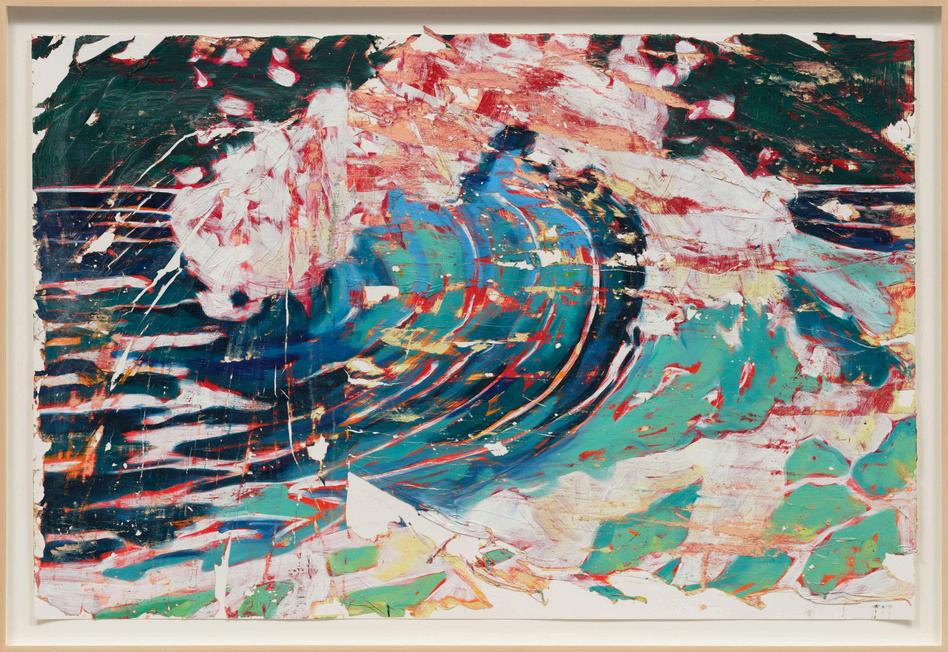
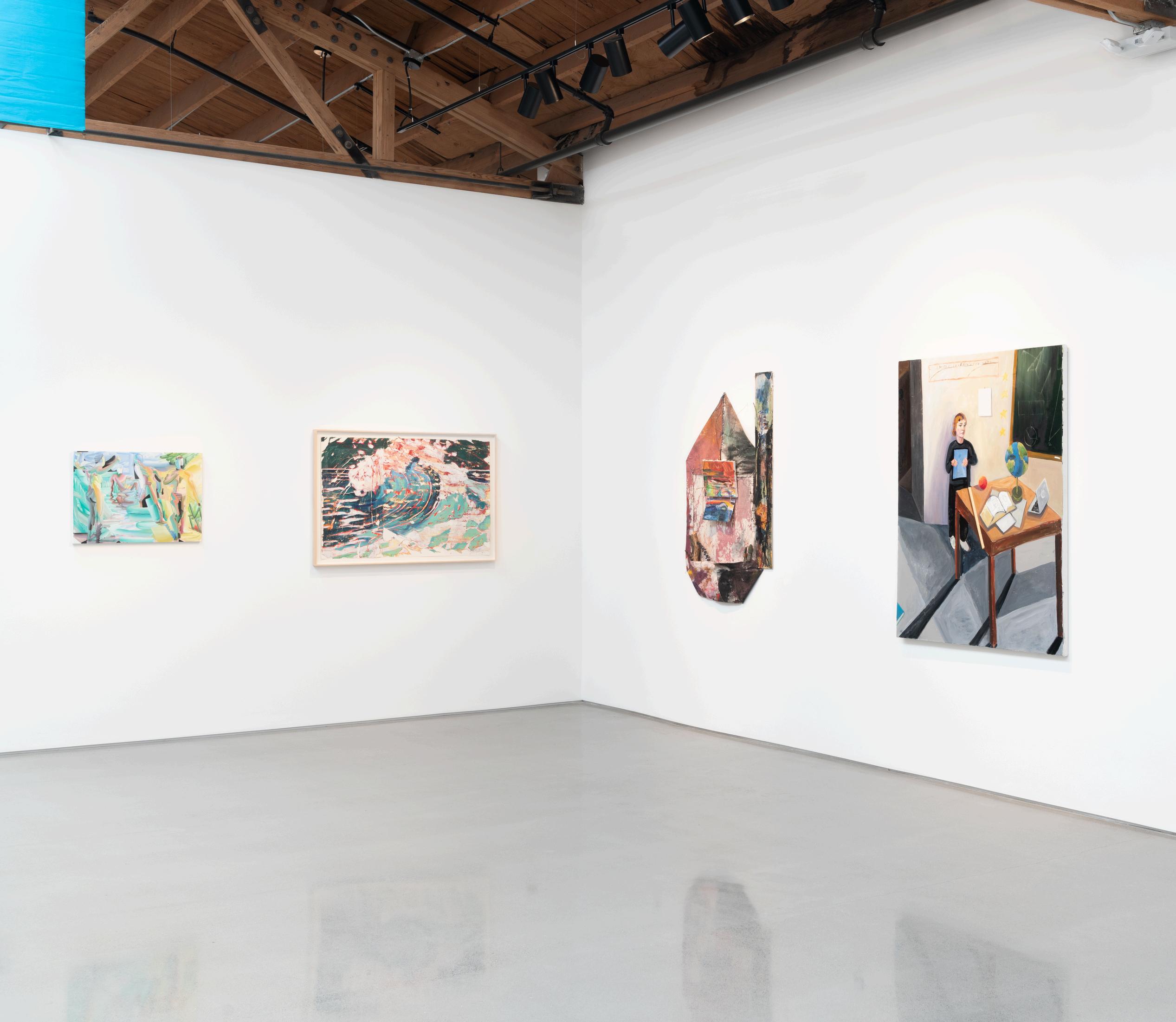

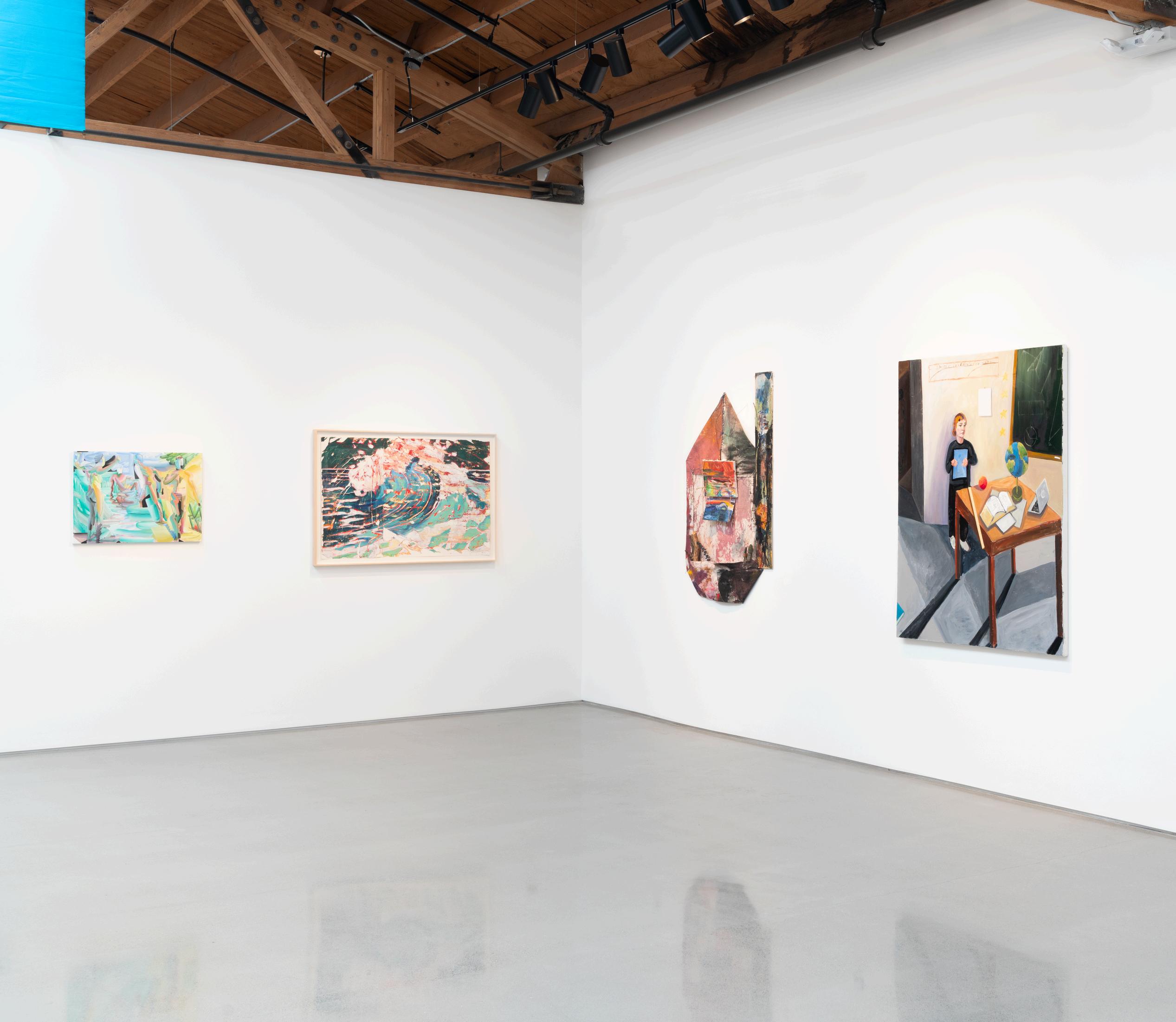

Ruth Poor MFA ‘22
There are twelve known versions of Saint Francis Kneeling in Meditation by El Greco. The Art Institute of Chicago is lucky enough to have one. Even luckier is the placement of a padded bench in front of the painting. We as viewers are invited to meditate as well. For me, the experience generates energy and warmth, like ripples from an invisible source I sit and contemplate memory and my body in relation to the painting
Ripple
I remember the pain of prolonged kneeling On the San Damiano floor
Ripple
The clicking of a rosary And the soft utterance of the Lord’s Prayer. Ripple.
My extremities tingle as they fall asleep And makes me think that I am disintegrating into the universe.
As I draw, the marks appear in short, controlled movements and then bloom into sweeping, lyrical strokes. Again and again, I circled around the drawing. Whether it be painter or saint, the role of repetition beats strong. I wonder about El Greco painting the subject over and over and if successive time, he was able to inch closer to The Source.
Ripple
Fra Danielle said we would meet God on the mountain And He appeared as a stag with a crown of thorns
~ Ruth Poor
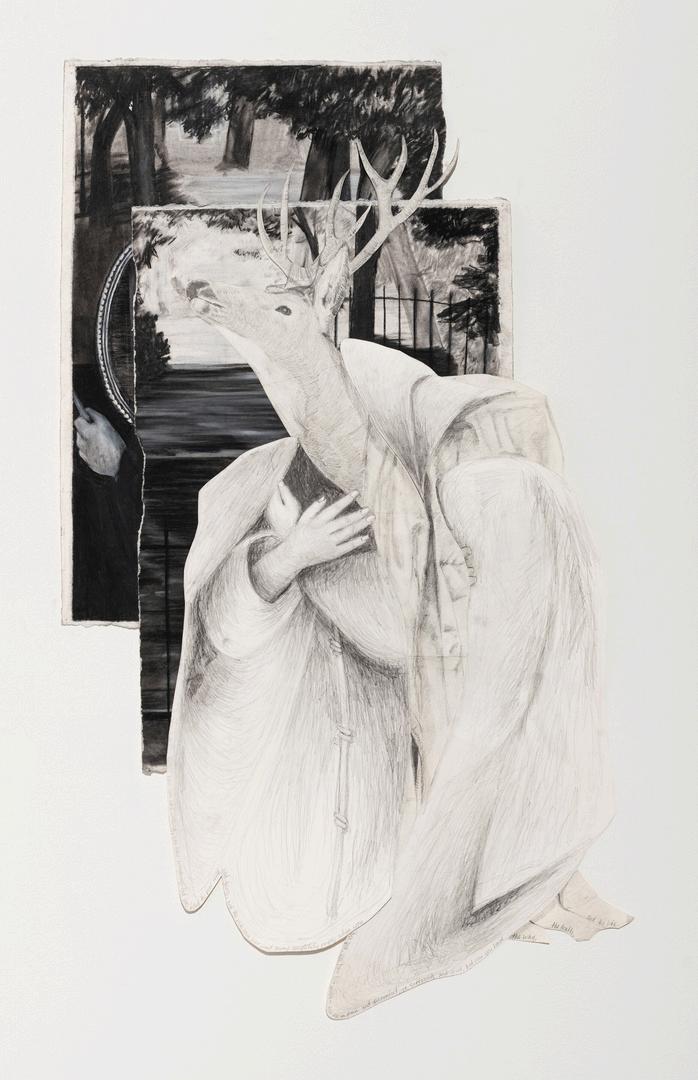

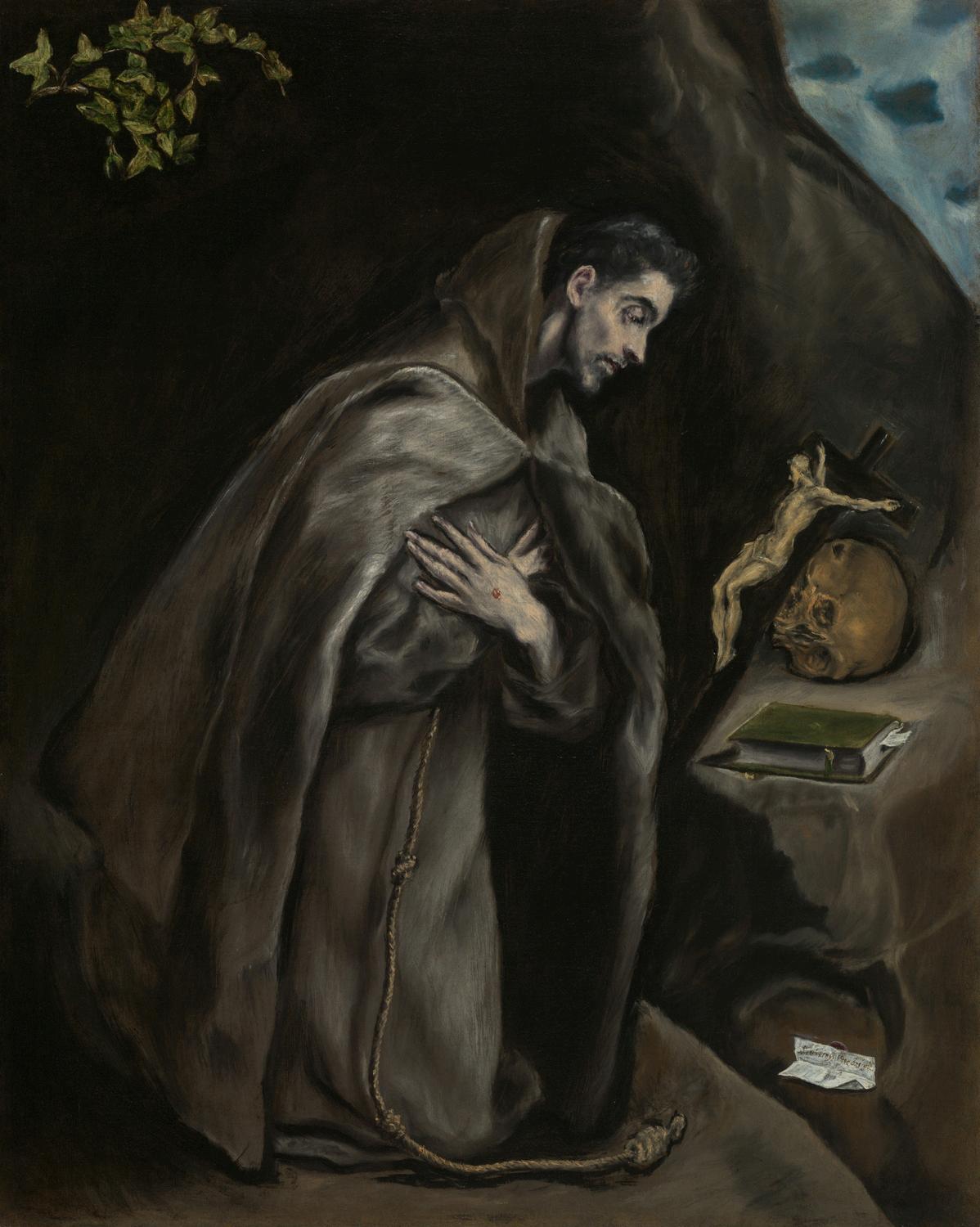
Selection from the Art Institute of Chicago collection: El Greco, Saint Francis Kneeling in Meditation, 1595-1600
Kaveri Raina MFA ‘16
The chromatic, quasi-graphic shapes Kaveri Raina presses into and through the coarse weave of her burlap substrates are often sampled from a personal iconography that includes Hindu mythological characters and museological cultural inventories, among other imbricated lexicons. There is a political inflection to the pareidolia of her compositions; seeing suggestions of figures and faces within the fragmented, interlocking forms of her paintings proposes that the project of abstraction might come to expand who is humanized, what traditions are made to matter, and how normativities might be wrested into undoing. Raina’s fevered graphite gyrations are redolent of portals, divine appearances, and moments of transformation culled from dream, fantasy, and myth Within cultural even anthropological arcs with the rises of collective action and falls of civilizations, Raina’s Vortex to Hover II (2019) is poised as a catastrophic threshold, an event horizon humming between ruddy earth tones and cool patches of respite
Taking Joan Miró as precedent, Raina associates the convulsions of her process and image banks to a Surrealist who enlisted oblique figural abstractions into his means of describing not only the automatism and dream analysis popularly practiced among his milieu, but also emergent conditions of political freedom that struggled against the devastations of the first World War and the rise of authoritarian dictators. In Miró’s The Policeman, 1925, amorphous white ghosts tower above typical adult height. The policeman at left stares out from under furrowed brows, caught literally red handed with an alarming cadmium slap parallel to the viewer. It’s perhaps impossible to apprehend the formal and conceptual implications of Miró’s painting without the perniciousness Althusser would come to assign the ideological state apparatus nor the violence of law enforcement it has long sanctioned. So too do Kaveri Raina’s modes of pressure, spread and penetrate, while tensions between sides speak to conditions of power.
~ Matt Morris
Selection from the Art Institute of Chicago collection: Joan Miró, The Policeman, 1925

Autumn Ramsey
BFA ‘05, MFA ‘13
Autumn Ramsey’s passion for pastiche blends criticality and indulgence into delicate renditions of dangerous liaisons that challenge the binarisms of surface/depth, past/present, and subject/object Ramsey examines ornamental motifs, flora, fauna, and such pictorial bromides as the odalisque in order to trace and re-trace the underlying psychologies that reinforce society’s fashions, tendencies, and default assumptions In mapping the intricate violences that have historically drawn the notion of ‘ woman ’ close to that of object, Anne Anlin Cheng writes that the female figure “offered a scopic pleasure that centered on her textual thickness: her material, synthetic affinities Her appeal does not derive from her naked flesh but from her decorative (and projected ontological) sameness to the silk, damask, mahogany, and ceramics alongside which she sits.” Ramsey’s cosmetic provocations such as the small Untitled, 2013, in which a curvaceous nymphian nude is sketched in oils with graceful economy, atop subtle flashes of underpainting centering on a pool of periwinkle glaze offer open-ended glyphs to a discourse of voracious, erotic gazing embedded in a history of painting.
An inquiry like Ramsey’s, that takes no position as stable while feasting on an iridescent rhapsody of signs, echoes the mindset which pervaded over the Années folles in Left Bank Paris of the 1920s. Ramsey has much in common with artists of that milieu whose aesthetic restlessness reckoned with tradition and modernity while crisscrossing between art, décor, fashion, and design among them, Marc Chagall, Marie Laurencin, and Tsugouharu Foujita The Art Institute is in possession of Foujita’s 1926 Head of a Woman, a breathy, undulating ink sketch that emphasizes full-moon eyes contoured with arabesque lashes peering over a pillowy hand cupping a cherubic chin in soft ponderance For all of her successive subjugations under the gender wars and World Wars of the early twentieth century, Foujita nonetheless figures this young woman archetypically as a herald of modernity, with all of the uncertainties and abstractions that entails The femme futurity Foujita here anticipates is reincarnated in Ramsey’s keen investigatory approach to painting as medium and history.
~ Matt Morris
Anne Anlin Cheng “Ornamentalism: A Feminist Theory for the Yellow Woman ” Critical Inquiry No 44 (Spring 2018) Print, p 416
Selection from the Art Institute of Chicago collection: Tsugouharu Foujita, Head of a Woman, 1926 1
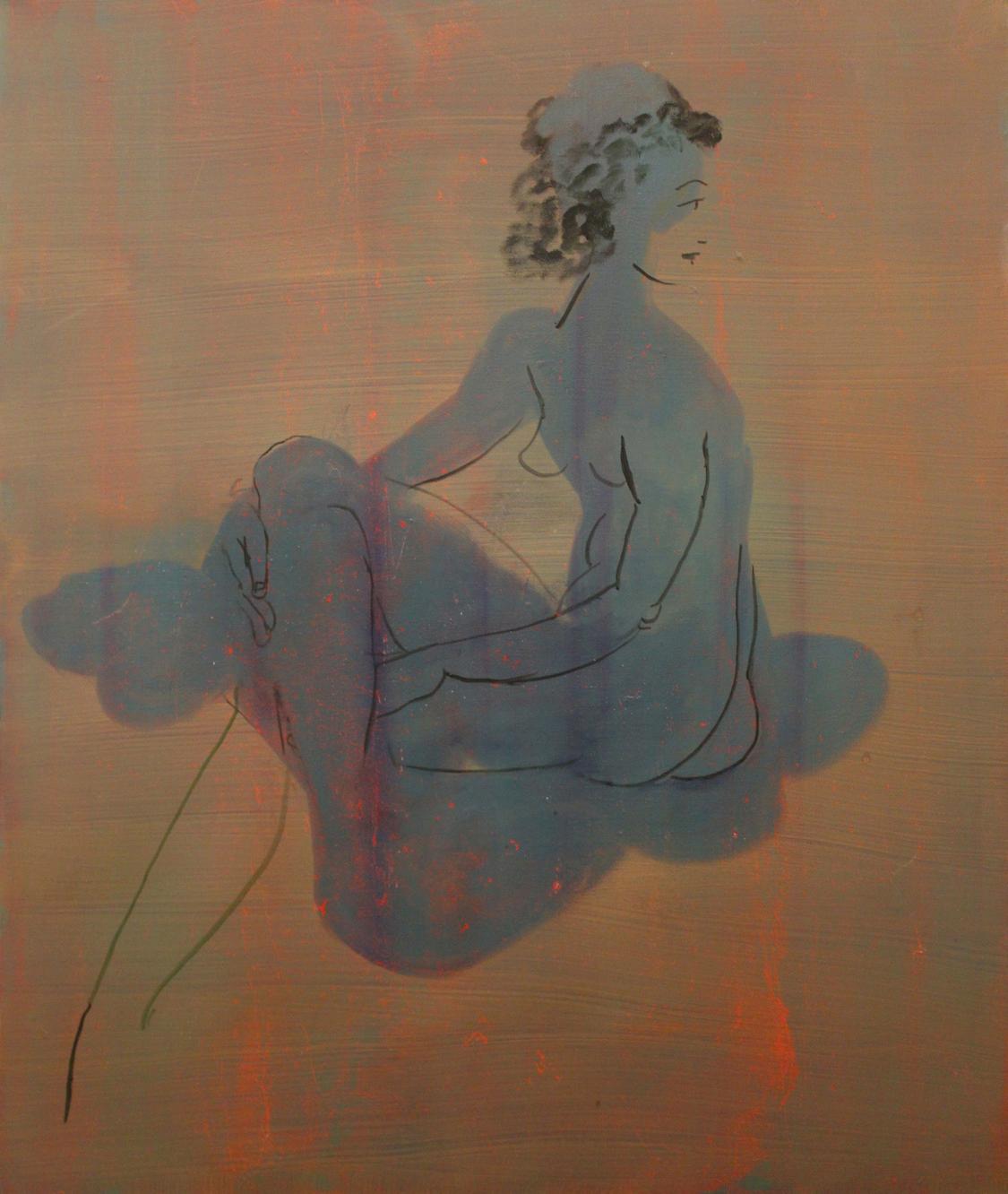
MFA ‘13
Celeste Rapone and Gerturde Abercrombie’s portraits both expose the painter’s counter stance to a fully possessed self. Instead of positioning self-composure, they relay personas that are confident in their doubt of such a thing.
The two artists work in different eras, the 1940s and the present, but Self Portrait of My Sister (1941) by Abercrombie, and Outsider (2024), by Rapone, similarly deploy aspects of surrealism to circumvent traditional portraiture Abercrombie goes so far as misguiding and actively confusing the viewer, with mention of a sister that she doesn’t have, in the title The subject of Rapone’s painting is equally veiled and obscured She is situated as outside of or beyond the viewer’s right to her definitive identity Just as the titles are purposefully distorted, the imagery also offers illogical depictions of bodies with distended appendages, in both notably elongated, missequenced arms and fingers And the neck that stretches in length beyond expectations in the Abercrombie painting is also worth noting Such elongations signal aspiration perhaps for these women, but it comes at the cost of their composure. Disaggregation is evident in Rapone’s painting as well, through the use of text (“I VOTED” and “Swell”), objects (a water bottle), and geometric design motifs (checkerboard) that combine with and embed onto the body. Given the dejected mien of her outsider, this extra incoming information unbalances, unsettles, and directly thwarts the subject’s ideal composure. In effect, both paintings offer formal contexts in which idealistic and symmetrical proportions are abandoned. They adapt the viewer to a countervailing system of confident excesses disproportions and circumventions away from a reputable and well composed subject in their paintings.
~ Romi Crawford Celeste Rapone
Selection from the Art Institute of Chicago collection: Gertrude Abercrombie, Self Portrait of My Sister, 1941
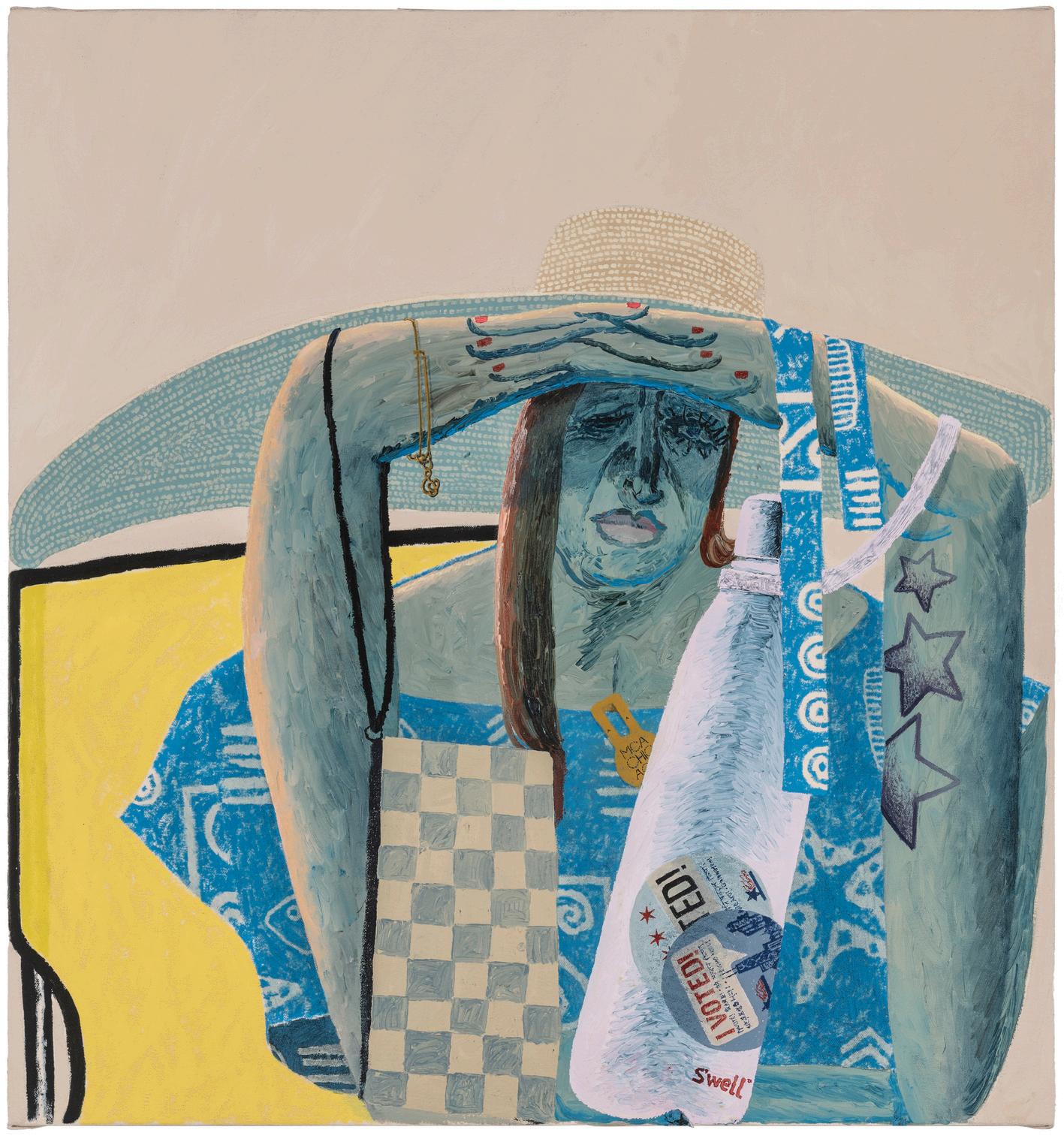
Josh Reames
MFA ‘12
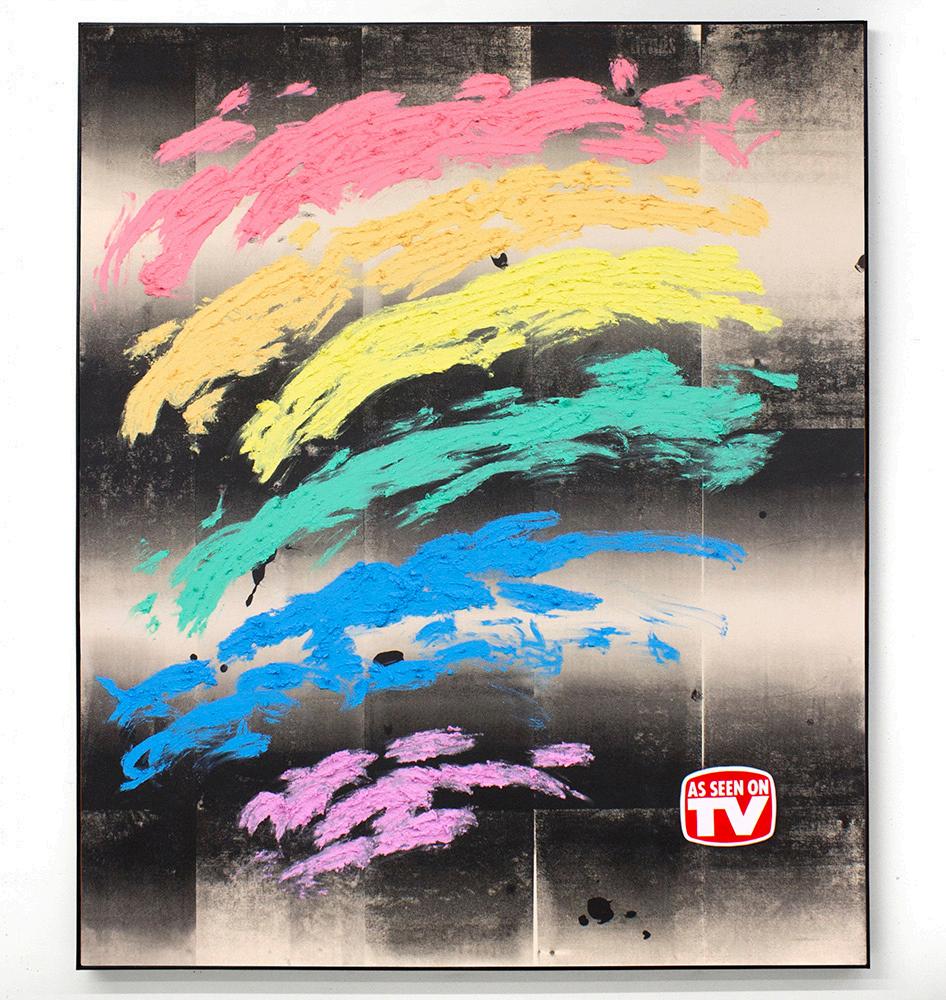
Between Josh Reames’ Under the Bright Light and Bruce Nauman’s Clown Torture, discomfort functions as a deposition of fragmented reality
Reams borrows motifs from a digital age and flattens them on one surface, with no emphasis on any particular reference Painterly neon strokes in Under the Bright Light adopt a graffiti-like presence atop a surface that need not remind the viewer of aggravating breaks in entertainment programming a reliance on, or possibly hypnosis from, entertainment at every turn.
Nauman’s Clown Torture consists of four looped videos on stacked monitors in a room with sound emanating from each to a chorus of chaos and confusion. The sequences show clowns in inescapable conundrums humorous in one setting, but horrifying in aggregate. Nauman’s work crossed mediums incessantly, and distorted the viewer’s perception and expectations.
Nauman’s clowns, trapped in a cycle of absurdity and suffering, become objects of exploitation, their vulnerability rendered almost foreign. Their entrapment critiques the spectacle itself, turning the act of watching into a passive transaction The grotesque in Nauman’s work remains external
In contrast, Reames’ Under the Bright Light shifts discomfort from the external to the internal, urging viewers to confront their own entrapment within contemporary culture His chaotic compositions, filled with fractured symbols and fragmented imagery, reflect the inescapable tether to the digital world and overwhelming consumption. Unlike Nauman’s work, where the clowns are distant, Reams’ chaos mirrors our own reality, embodying the fragmentation and grotesque excesses that define digital culture.
In this mirror, we begin to see ourselves not as passive observers, but as active participants in the spectacle. The spectacle is no longer foreign, but something we willingly engage in, enmeshed within the systems we ’ ve created.
Selection from the Art Institute of Chicago collection: Bruce Nauman, Clown Torture, 1987

Clare Rojas MFA ‘02
The Ceremonial Knife (Tumi), crafted by the Chimú civilization between 1100 and 1472 on the north coast of Peru, exemplifies the rich symbolic language embedded in ritual objects. Fashioned in gold with turquoise inlay, the knife’s semicircular blade and crowned figure form a silhouette at once ornamental and animate. Thought to be used in ceremonial or sacrificial contexts, the Tumi is often associated with healing or divine mediation, its figure typically interpreted as a deity or ruler endowed with protective power. The inlay of turquoise precious and luminous enhances the figure’s gaze, imbuing the object with personhood and presence.
In Clare Rojas’ Protective Mother, a large swan bows its long neck, reaching downward with a bright red beak toward a small chick The scene is rendered with clarity and color, yet resists sentimentality, channeling a kind of stoic guardianship Visually, the curvature of the swan ’ s neck and the contrast between bold, flat hues recall the form and stylization of the Chimú knife particularly in how each central figure becomes both icon and protector Rojas’ work is steeped in folkloric imagery, using animals and archetypes to convey care, feminine strength, and intergenerational bond
Placed in conversation, these two objects one an ancient tool, the other a contemporary painting engage in a shared symbolic logic. Each transforms a recognizable figure into a vessel of cultural meaning, employing reduction and symmetry to communicate a protective force. Whether maternal or divine, the figures are guardians, shaped by the needs of their respective communities. The Chimú knife, with its gaze cast outward, and Rojas’ swan, bending inward in an arc of care, each distill complex ideas of watchfulness, responsibility, and power into a singular, unforgettable form.


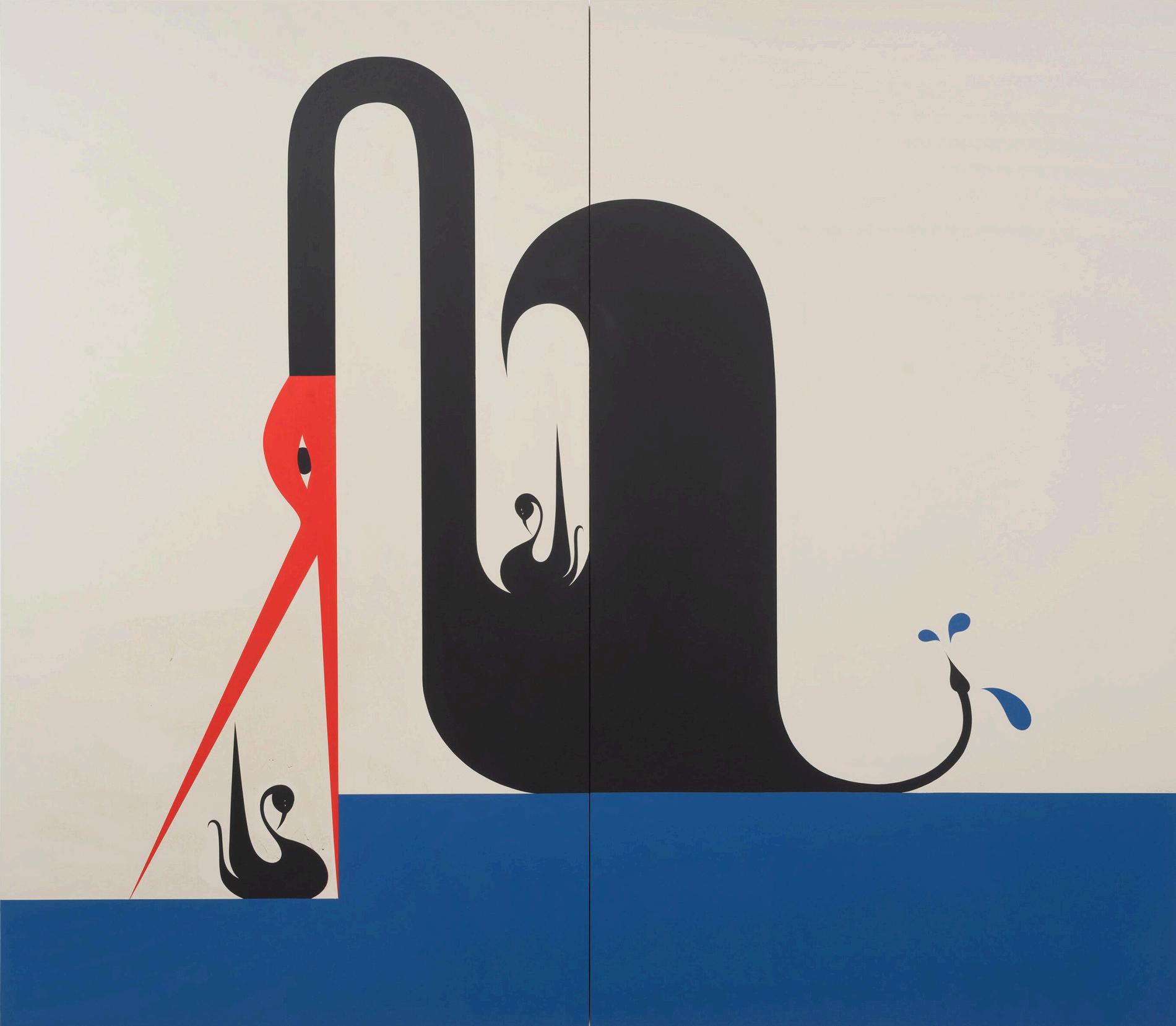
Sterling Ruby BFA ‘02
In tracing a connection between Sterling Ruby’s DR (6493), 2017 and Ivan Albright’s Into the World There Came a Soul Called Ida, 1929-30, is the matter of flesh While Albright’s treatment of flesh is over wrought (carefully dimpled, fastidiously hued, and realistically congealed), Ruby’s is less literal and more loosely rendered in a line sketch Even with spare information it is expert enough to insinuate the sag of skin The passage of time is implicated in both art works, which succeed at mapping and even suspending an inglorious phase just prior to an irretrievable youth and an inevitable old age. And both works suggest the let downs of the aging process. The ennui of it all is palpable. A scene of frenetic scribbles which seemingly weigh down and ultimately efface the head in Ruby’s drawing represents this. As does the mocking hand-mirror, a symbol of the desire to gaze at the self in Albright’s painting. Inferred in these works is the impossibility of triumphing over the flesh. They also propose that the artist is no less responsible for sugar coating or stalling this reality through the magic of their form. These works together announce a potential of that which is antithetical to regimes, aesthetics, and myths that situate beauty. As a pairing these works capture the equally potent principle of abjection, exposing it as also relevant and equally pertinent to the task of art making.
~ Romi Crawford
Selection from the Art Institute of Chicago collection: Ivan Albright, Into the World There Came a Soul Called Ida, 1929-30

19 375 x 16 375 x 1 5 inches, framed
Charlotte Saylor MFA ‘25
Disparate materials capture an ephemerality of memory, place, medium, and sensation in Houseboat The piece resists capture, flitting between material resonance and visual allusion, for which it seems inevitable to slip into nostalgia Beautifully, the piece itself seems to be caught in its own making, brushes stored in the hull.
Henri de Toulouse-Lautrec’s At the Circus: The Bareback Rider (Au Cirque: Écuyère) is a dynamic scene that almost sings. Toulouse-Lautrec, a frequent visitor of the Cirque Fernando, often captured the fleeting, electric spirit of live performance. A related painting, Equestrienne (At the Cirque Fernando), depicts a clown holding a paper hoop; here, it may be that the tambourine-like structure functions as a surrogate for that hoop a frame the bareback rider has just leapt through.
As brushstrokes glide in a circular motion, the musical potential of the tambourine seems not just rendered, but released an echo of rhythm made visible Toulouse-Lautrec’s flowing and uninhibited lines, particularly in his depictions of Parisian nightlife and entertainment in the 1890s, reflect a distinct bohemian freedom, one rooted in gesture and sensation more than form
Saylor’s assemblage holds a quiet harmony between object, shape, line, and color, suggesting a kind of visual music Both works capture motion and sound as sensations ephemeral, partial, and alive resisting containment, even as they are delicately framed

Houseboat, 2024
Oil and molding paste on stretched canvas, oil on wood panel, masking fluid and acrylic on loose canvas, encaustic on wood, paintbrushes, wire, yarn, thread, netting, pins, a needle, twine, eucalyptus, bark, sticks, and a shell
57 x 37 x 3 inches
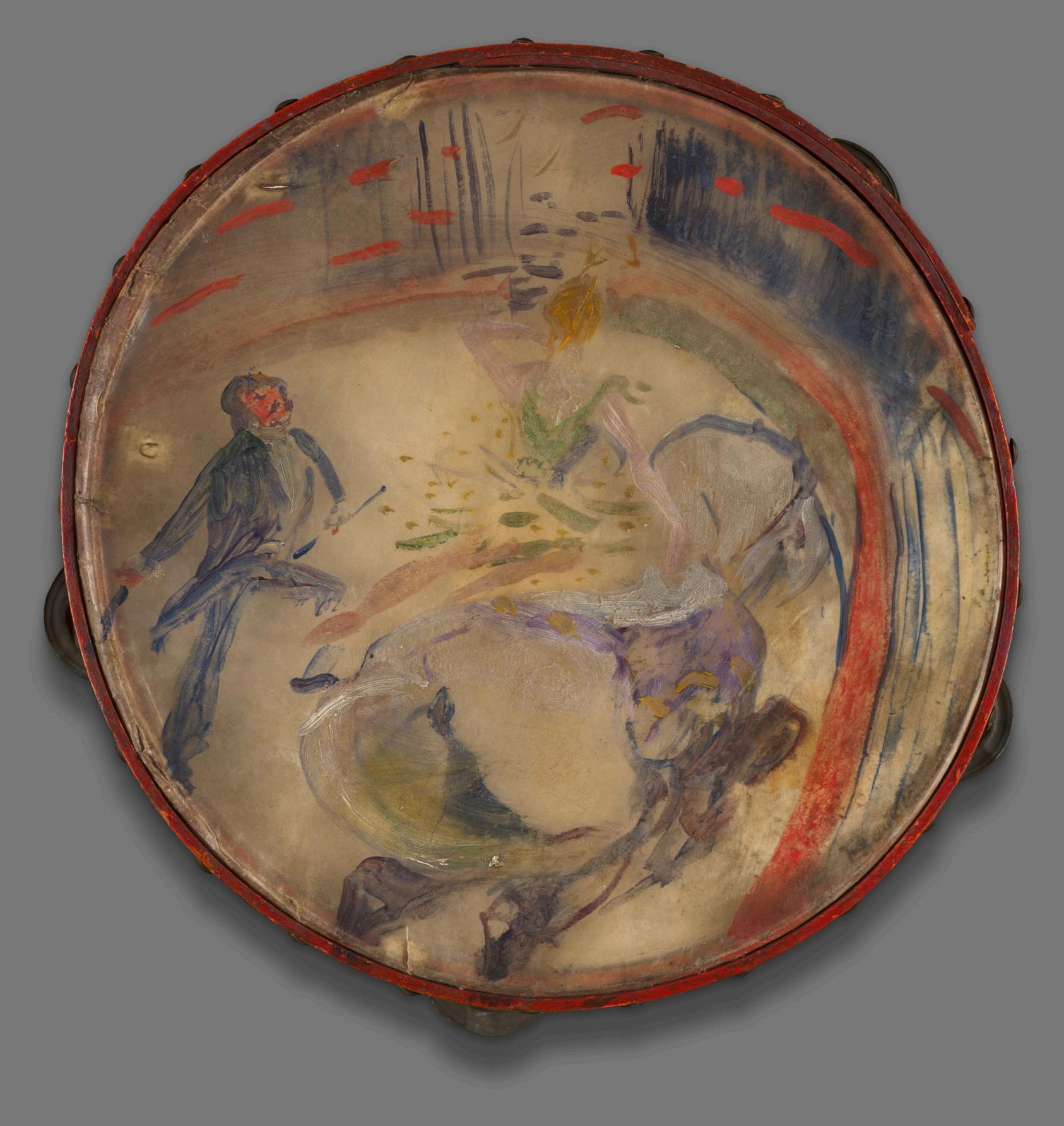

Claire Sherman
MFA ‘05
Vibrant colors interspersed with white lines and vacuous shadows populate works by Claire Sherman as she creates carefully constructed immersive environments that provoke all of our senses. Her large paintings are seductive portals that transport us to a distinct place and time plucked from an elusive memory of a meditative walk in the forest or a childhood exploration in nature We can almost hear the tree frogs and crickets, smell fermenting leaves, and wonder at the feeling of being small in relation to the natural world around us
Bathed in warm dappled light, Moss and Branches illuminates the earth’s floor, causing us to consider the magical mycelium connecting under our feet Sherman uses a dramatic perspective that heightens theatricality and grounds the viewer within the composition Her ability to playfully render the power of sunlight reminds us that we are not in control of this fleeting moment, as described in the first stanza of Robert Frost’s poem Sitting By A Bush In Broad Sunlight :
When I spread out my hand here today, I catch no more than a ray To feel of between thumb and fingers; No lasting effect of it lingers.
Claire Sherman chose David Hockney’s memorable portrait painting, American Collectors (Fred and Marcia Weisman), 1968, from the Art Institute’s collection A painter’s painter, Hockney can switch between abstraction and realism with great ease This earlier painting demonstrates a heightened attention to daylight, shadow, and nature that pairs nicely as a counterpoint to Sherman’s approach Although Hockney’s slick, flattened style is the opposite of Sherman’s abstraction, his attention to detail in the vegetation, on the pebbles of the patio floor, or in the intense blue of the Los Angeles sky, influence painters like Sherman to enjoy looking closely at every detail, especially the elements surrounding the subject to set an engaging and dramatic scene.
~ Allison Peters Quinn
Selection from the Art Institute of Chicago collection: David Hockney, American Collectors (Fred and Marcia Weisman), 1968

Sumakshi Singh
MFA ‘03
While the 16 Columns installation in the Art Institute’s Tadao Ando Gallery asserts a commanding presence dense, immovable, and architectural in its weight Sumakshi Singh’s weavings offer a counterpoint: a spatial intervention that is no less structured, yet entirely more permeable Singh’s installation hangs lightly within that same spatial context Her four copper zari panels woven with traditional techniques yet rendered in nontraditional transparency appear to float Hovering just shy of the floor and suspended from the ceiling, they hold their shape delicately, forming shifting thresholds rather than boundaries
The sixteen concrete pillars, conceived by Ando as a tribute to rational form, impose a rhythmic order on the gallery’s open plan. Their solidity frames and fragments the viewer’s path, inviting a kind of reverent movement, as if walking through a temple. Space becomes disciplined, defined.
While Sumashki’s weavings do not block the viewer’s passage, they refract and filter light, casting subtle shadows that echo the geometry of Ando’s columns but with a softness and ephemerality that invites lingering. Their presence is ghostly, but not absent offering a kind of lyricism that responds to the brute materiality of the columns not in opposition, but in poetic dialogue.
In Singh’s work, structure is not fixed but activated by light, by time, by the viewer’s own perceptual drift Line becomes a tool not only of drawing, but of destabilization Her weavings don’t just occupy space; they unsettle its terms, reconfiguring how it is felt and known Where Ando monumentalizes stillness, Singh conjures presence through uncertainty The installation becomes a temporal hinge a quiet, surreal folding of tradition and perception, where the boundary between object and environment dissolves into something at once tactile and unreal
Selection from the Art Institute of Chicago collection: Tadao Ando, the Ando Gallery, 1992

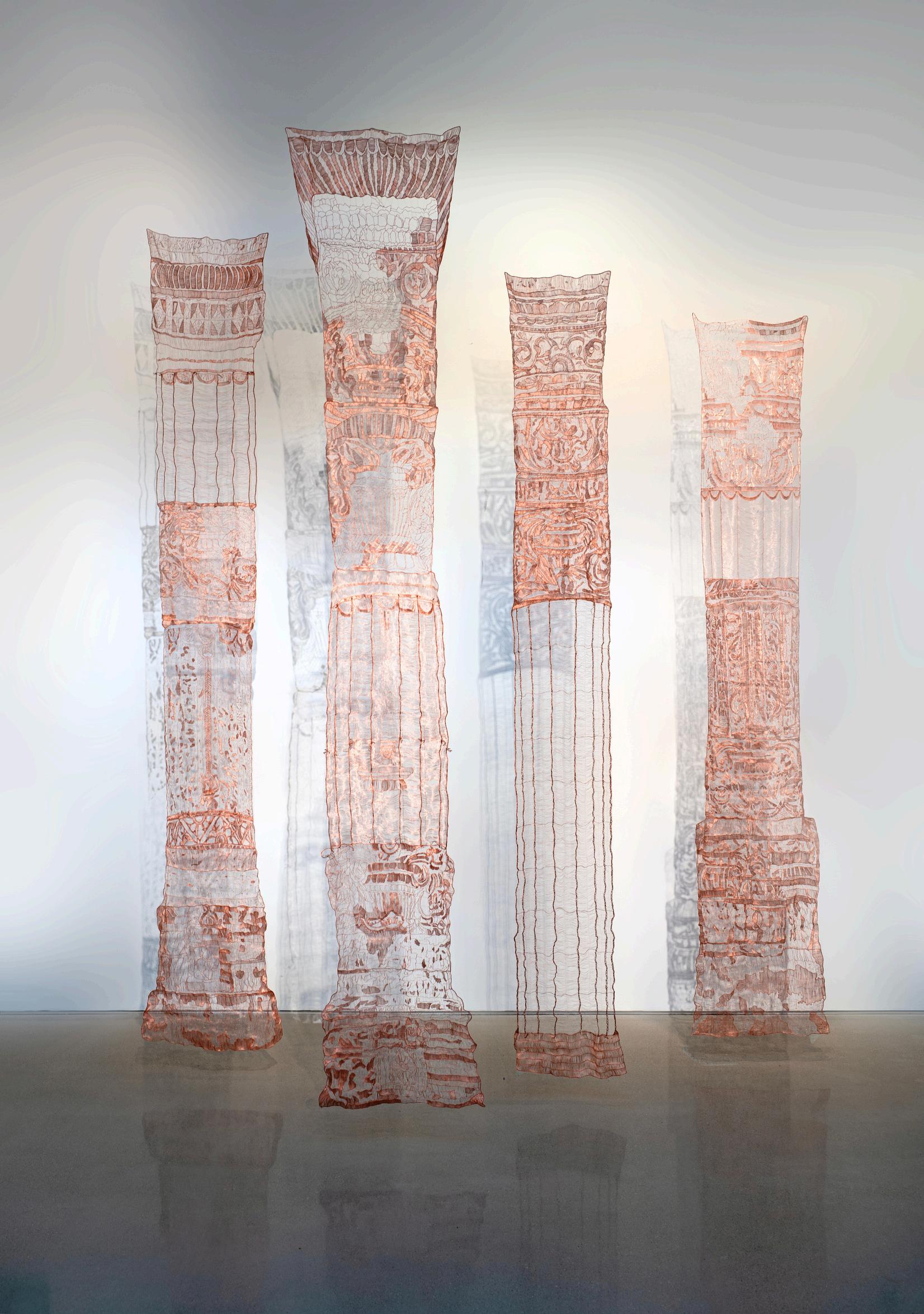
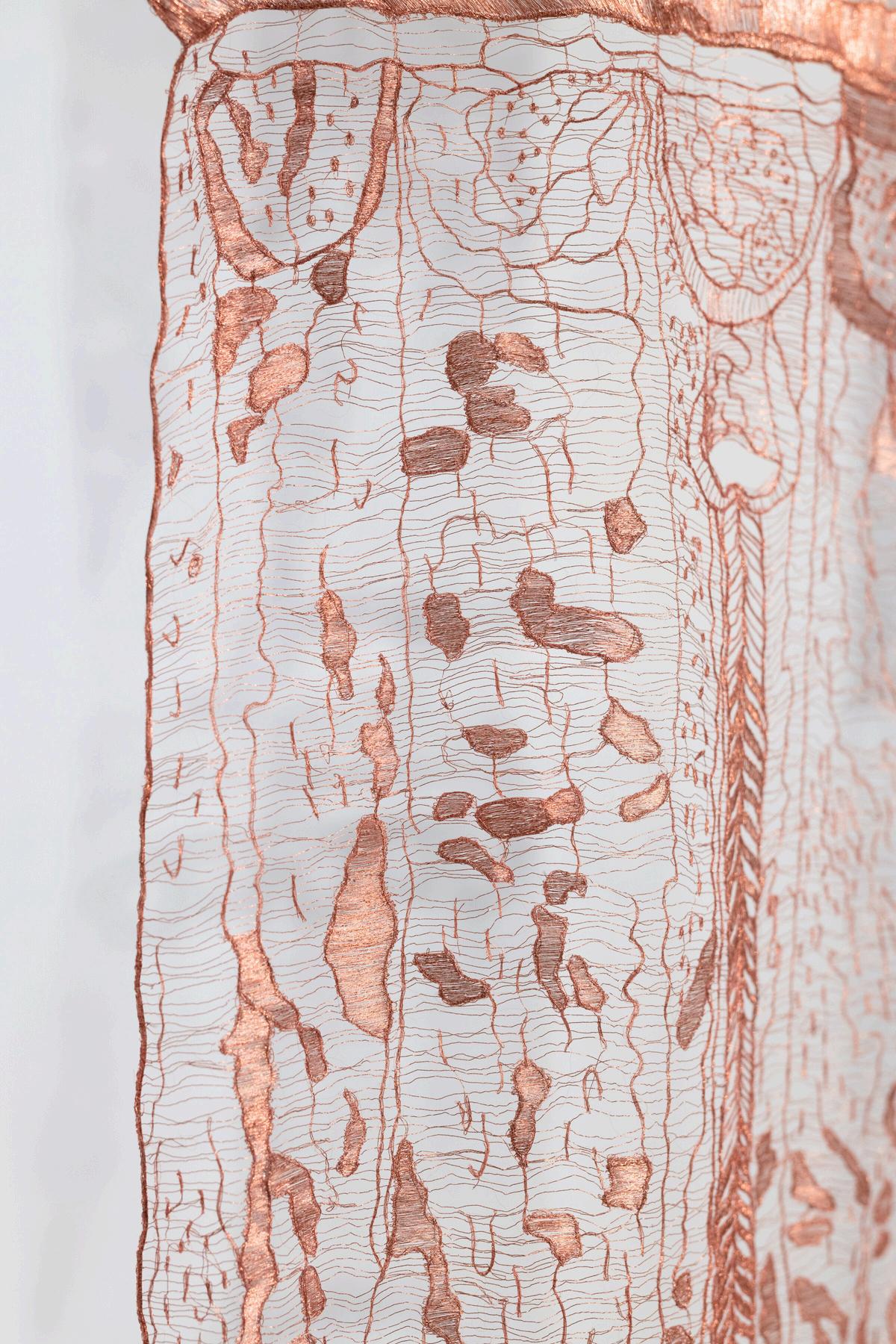
Support Structure 1, 2024
Approx. 115 x 24 inches


Support Structure 2, 2024
Approx. 120 x 24 inches
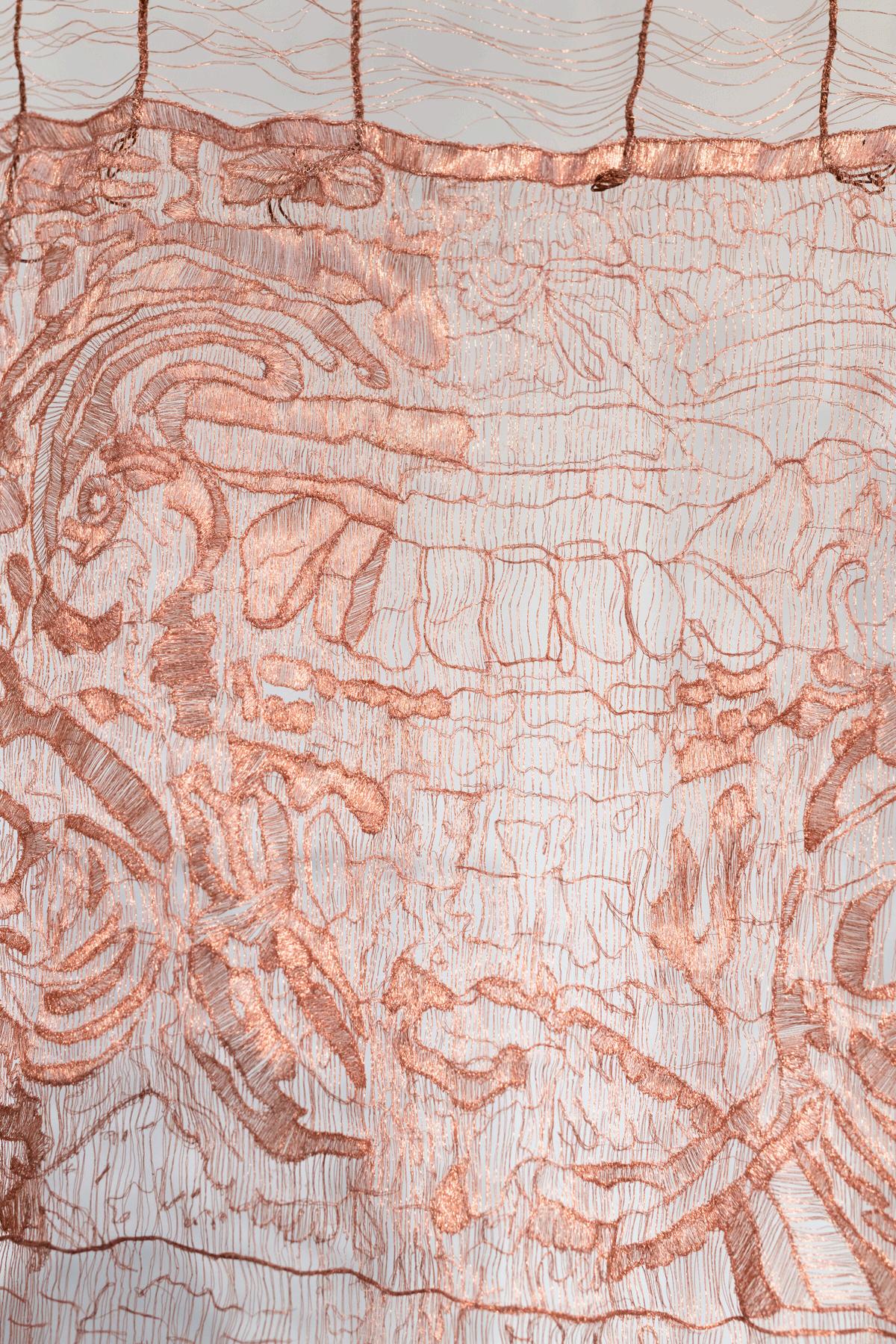
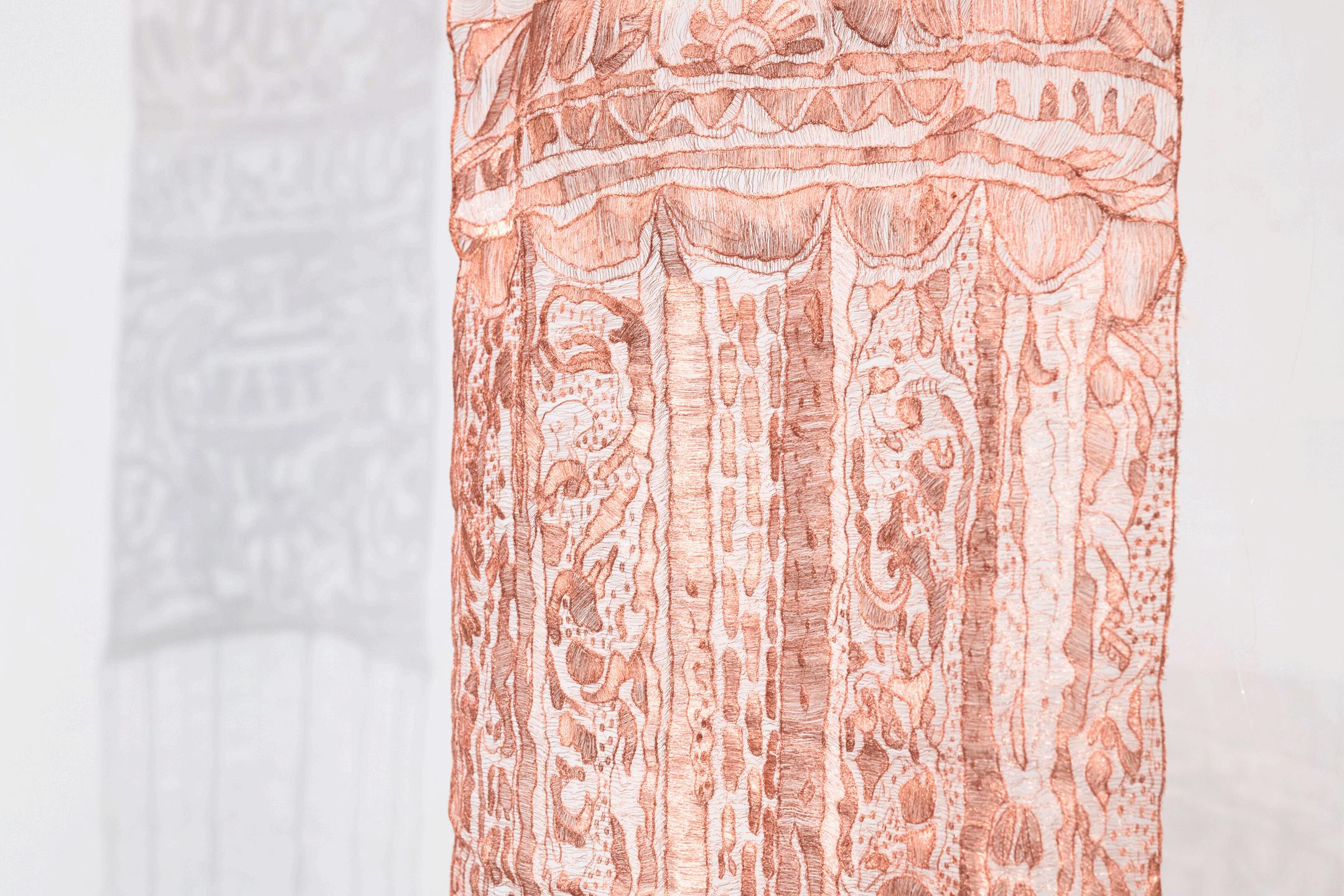
Support Structure 3, 2024
Approx. 120 x 24 inches


Support Structure 4, 2024 Copper Zari
Approx. 96 x 24 inches

Cameron Spratley
MFA ‘21
Cameron Spratley’s tactics of juxtaposition and remix are excited by the push and pull of mixed messages. Presaged by the esoteric marginalia of illuminated manuscripts, the coded subterfuge of Jasper Johns’ all-American riddles, and the abstracted Black figures of Lorna Simpson not to mention the subcultural aesthetics of punk, hiphop, and street fashion Spratley’s collaged paintings edge globalized post-Internet media storms toward cunning disarray In Dust2dusT, 2021, a trinity of figures are arranged along the border of the canvas, interfiled with the word DU-S-T (or starting to decipher from a different spot, S-T-U-D) spelled out in saturated hues: top center is the surreal document of notorious procurer and author Robert Beck, a k a Iceberg Slim, shown in this image masked and appearing on the Joe Pyne Show for an interview in 1968 Elsewhere a defaced image that might be a shirtless Tupac Shakur and another of the back side of bodybuilder Ronnie Coleman populate the black-and-white checkerboard field of the composition. This sign chain is strung across an apparatus of collaged images of enlarged threaded screws, a metal bat, a switchblade, and the moniker “Black Moses” scripted in Gothic type.
Spratley’s bricoleur tendencies signal to the legacies of trickster god artist David Hammons. Since the 1960s Hammons has arranged material artifacts that attest to the interstices of race, class, gender, and national identity into coy Conceptual affronts. Spratley likewise works into the evidencing power of images, how they circulate through systems of consumption, and the effects of their rhetoric The spaces of public life and city streets have frequently served as context for Hammons’ presentations, alongside more conventional art institutional space Whatever the site, it is always enlisted in the substance and meaning of the work, as in the video Phat Free, 1995/99, which shows the artist’s nocturnal sojourn, kicking a metal bucket down an empty sidewalk Hammons’ and Spratley’s practices share an investment into the analysis, criticism, and satire of cultural representations of Black men particularly those defined by psychoerotic projections of virility and violence within white supremacist fantasies of domination and desire
~ Matt Morris
Selection from the Art Institute of Chicago collection: David Hammons Phat Free, 1995/99
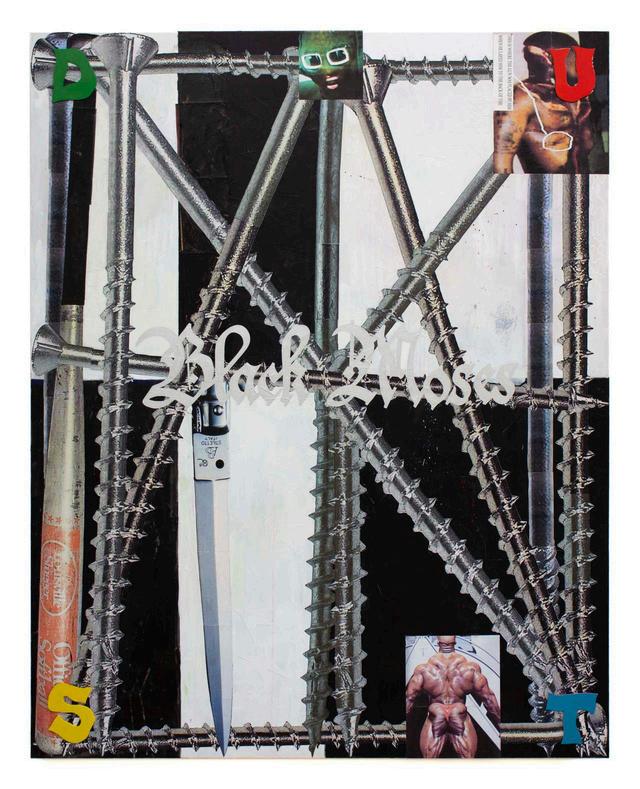
78
Keer Tanchak
MFA ‘03
Sometimes new art resembles the old art it emulates If I look closely, Keer Tanchak’s painting has some Vuillard touches, like the view into another room with lush palm tree patterned wallpaper
But in other places there’s no resemblance Keer says the strange silhouette is like one of the figures in the Vuillard. I can’t see that, especially when Keer informs me the figure “might be in a terrible state of mind.” Keer’s figure is more Kara Walker, or even the devil in Post Tenebras Lux. She says the “thin arc of gray ceiling” is like the “unreasonably dark strip of grey sky” in the Vuillard, which “taunts” the viewer.
Visible influences are fun to trace, but private connections are more intriguing. Does Sargent’s Daughters of Edward Darley Boit look like Velazquez’s Las Meninas, as many people seem to think? One of my current students says her round ceramic pots owe their style to Sailor Moon.
I don't see the Vuillard connection, or not much of it, and I’m a professional. But I can’t doubt it, and because I’m a professional, it’s my job to try to understand Most of the Vuillard links are subterranean they are enabling rather than eloquent but some, like the green velvet settee and the palm decorations, bob to the surface
A more interesting question here is about the anxiety of influence The famous book of that name has prompted two generations of critics to imagine that artists are forever locked in Oedipal battles, like Norman Mailer and Germaine Greer or Picasso and Velazquez But there”s another kind of influence, a gentler and more thoughtful kind, where the earlier artist speaks to the imagination of the later one, and the later one answers with references and quotations instead of struggles and distortions.
Years ago I taught a course where students copied paintings in the Art Institute, and that's where I met Keer. She copied our small Watteau, and she did it beautifully and apparently easily and with a great facility. Over the years we ’ ve kept in touch, and I’ve seen how Watteau comes and goes in her art. Vuillard, too has been an intermittent presence in her work, appearing as a strip of sky, a windowless interior, or a patterned fabric.
Whenever he is present, he emerges easily There’s no anxiety, no struggle for dominance This kind of influence is rare Schubert was like that about Beethoven: brief echoes come and go in his compositions without any special fanfare This is what I like about Keer’s work: it is thoughtful and gentle about the past, and it may or may not resemble what it admires
~ Jim Elkins
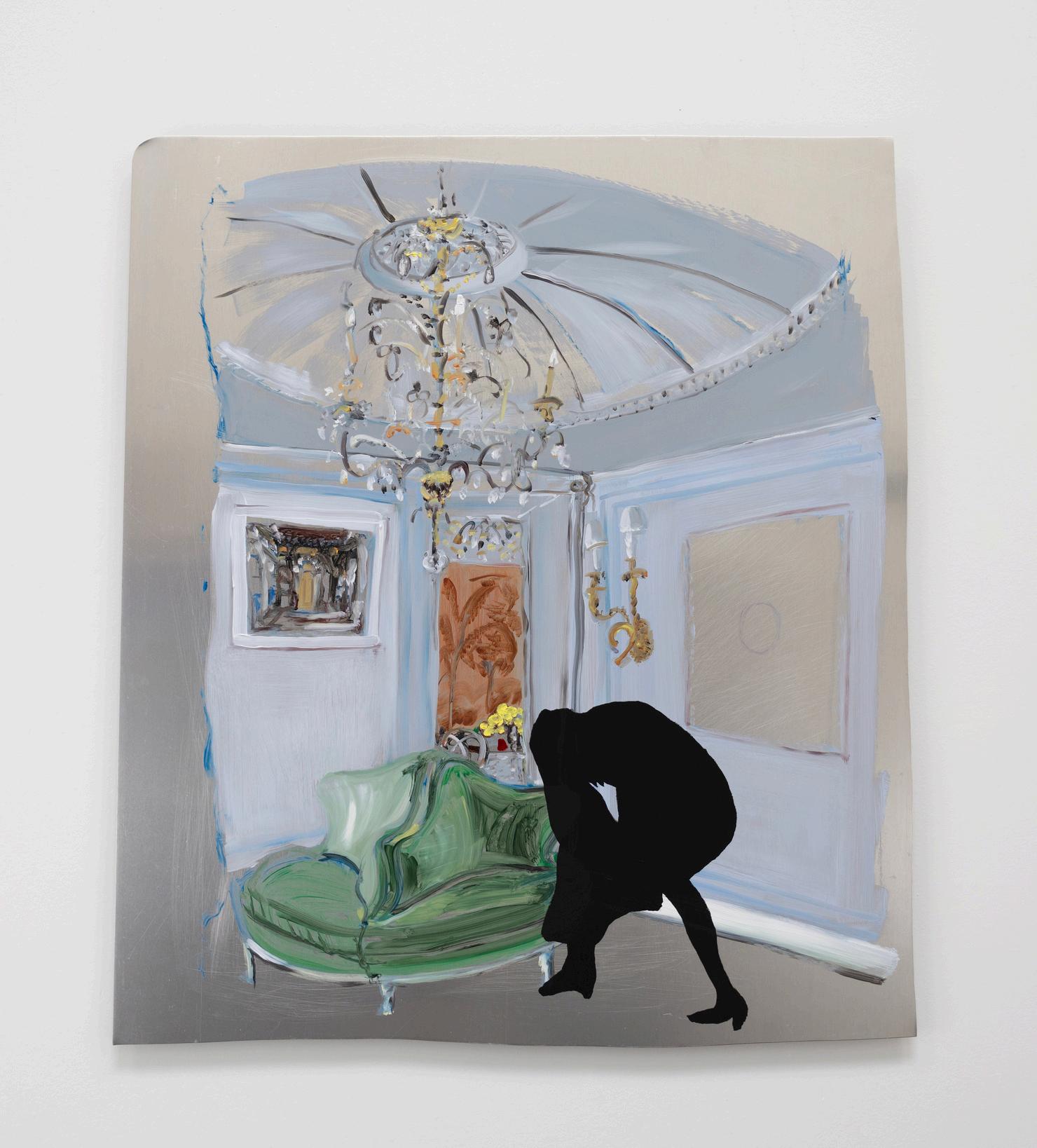
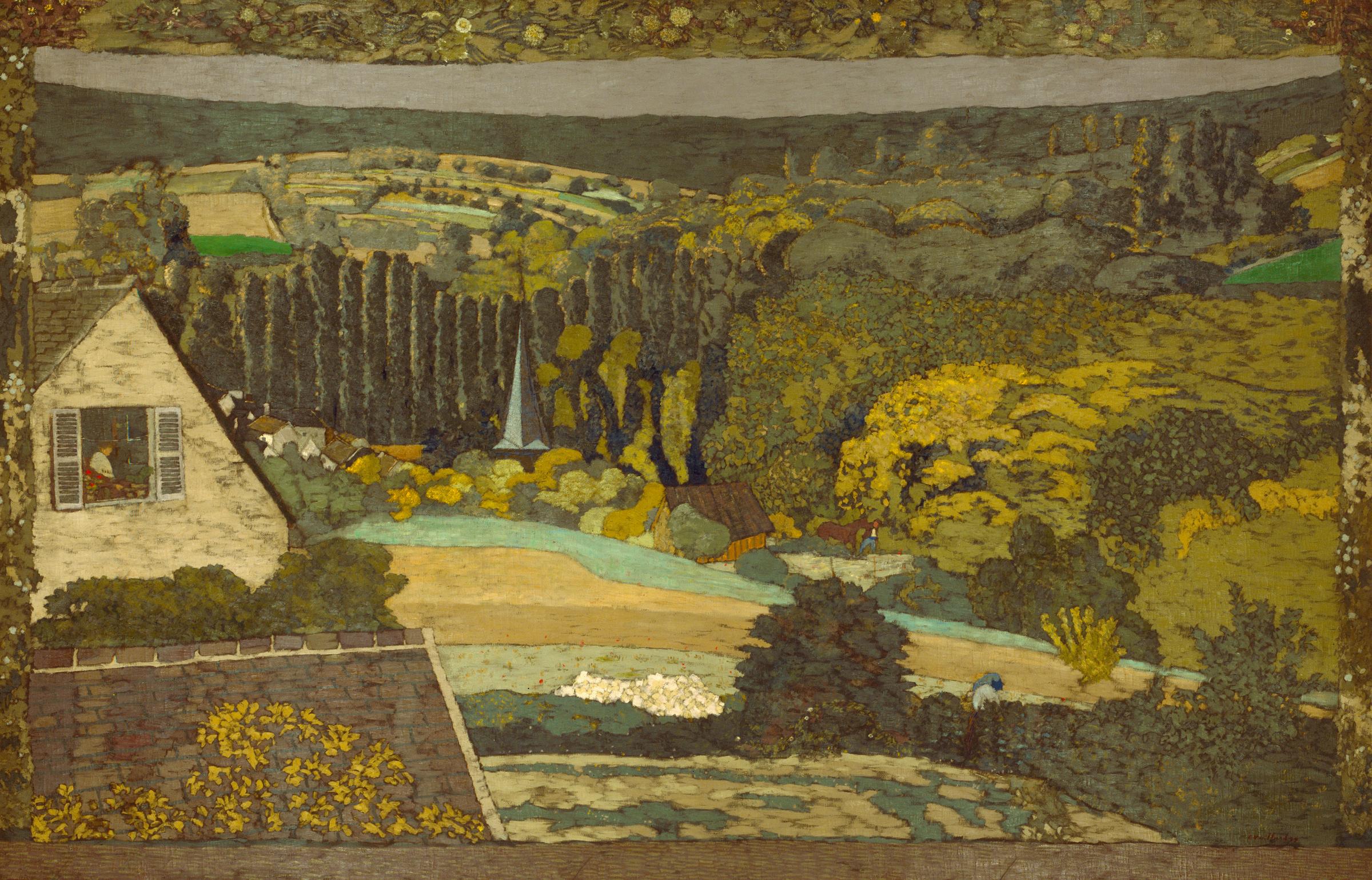

Selection from the Art Institute of Chicago collection: Édouard Vuillard, Landscape: Window Overlooking the Woods, 1899
Sebastian Thomas MFA ‘23
When The Life of Christ and the Virgin altarpiece was commissioned by Pedro López de Ayala in 1396, its style was already considered out of date. Harkening back to earlier manuscript illumination, his altar piece was designed to emulate the past and impress with its colossal scale and rich materials. I share a similar desire in looking back at art and make my own materials in the studio. The paint is a tweak of an old casein recipe that I create out of cottage cheese and borax The ground is a traditional chalk gesso that traces back to 10 century BCE Egyptian tomb painting Like Pedro’s altarpiece, I want my viewer to feel impressed, but rather by the intimacy of scale Clad in their intricate heraldry, the work depicts knights in miniature, charging each other in a midnight battle I hope a moment of grace and empathy can exist for those who are thrown into life before our time and have died because of it What would the past have to say about us? th
~ Sebastian Thomas
Selection from the Art Institute of Chicago collection: Retable and Frontal of the Life of Christ and the Virgin, 1396, Spanish

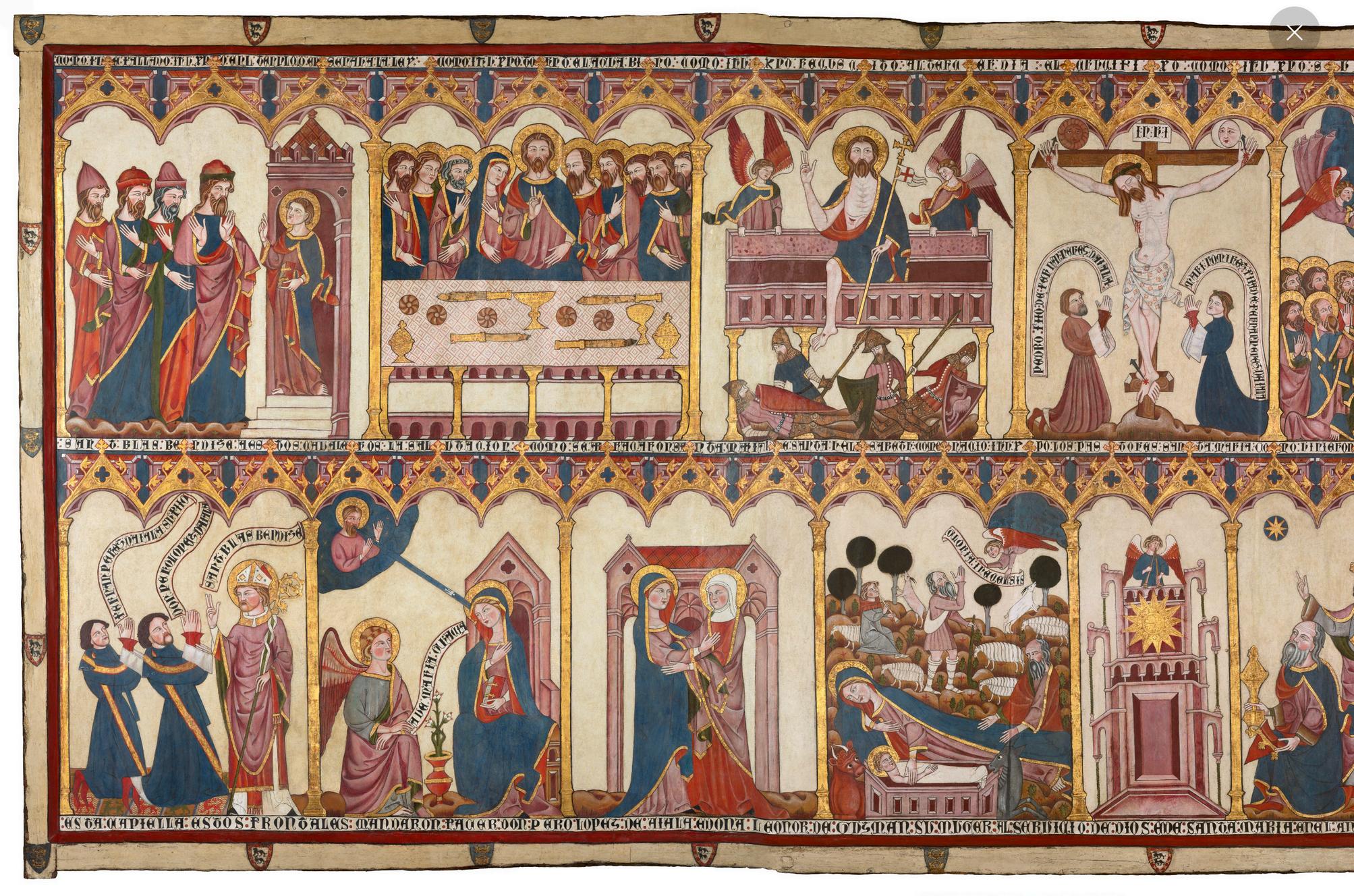

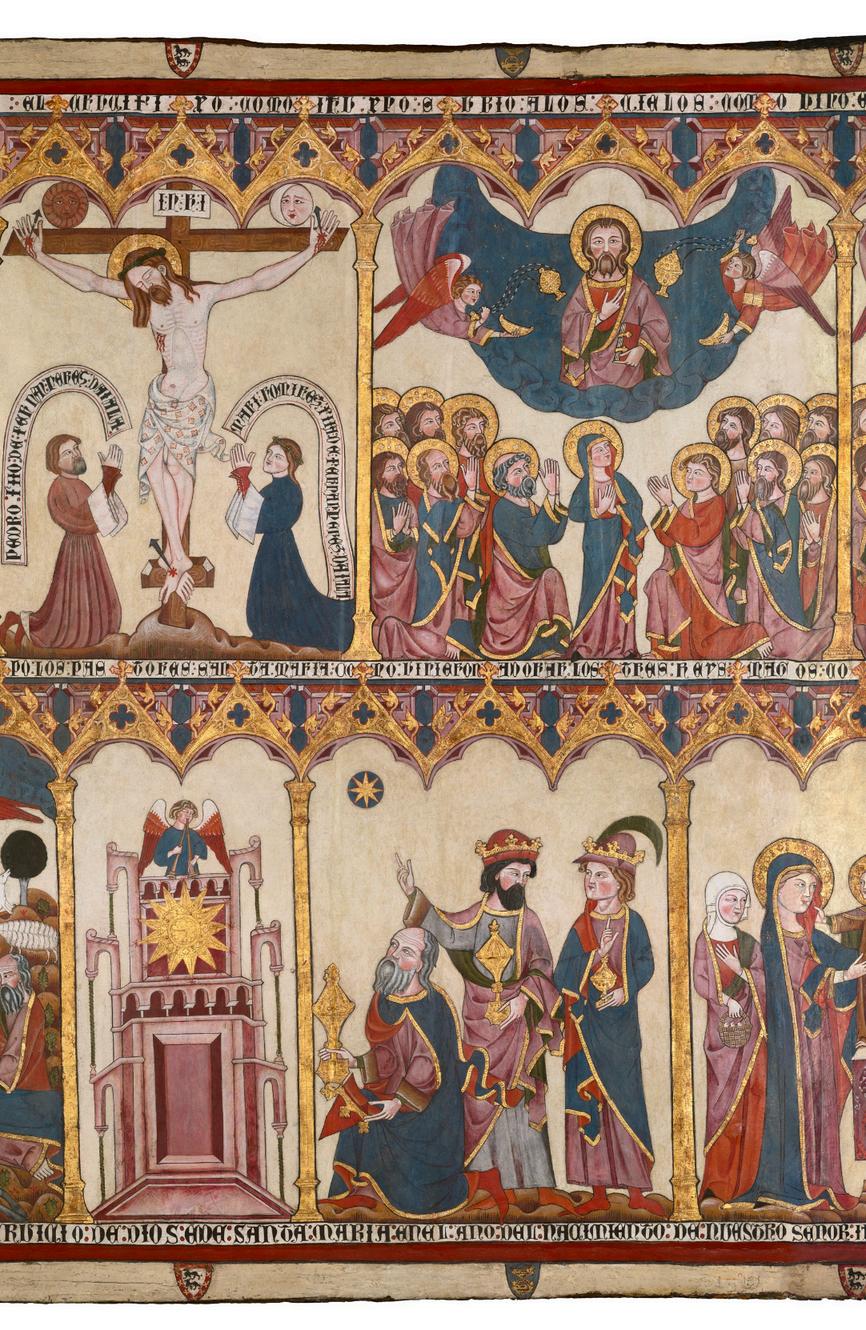
Alice Tippit
MFA ‘13
Scores of matchsticks construct a tight part. Other matchsticks spill downwards, making the syncopated light and shadow of coiffed hair Hairpins, strings, and coins complete the visage: a woman ’ s face, bejeweled for an evening out in 1920s Paris Francis Picabia’s will-they-won’t-they play of collaged materials ask the viewer to hold multiple visual and social meanings simultaneously Match, or hair? Hairpin, or nose? Coin, or earring?
Alice Tippit’s work poses similar questions Abstracted forms conjure visual jokes, illusions, and allusions to hold signification in suspense Usually, I can spot the jokes in one of Tippit’s paintings after a minute or two, but that doesn’t stop me from looking for longer. We like being fooled. Even once you know how the magic trick works, you want to see it again. Why? Because the feeling of sense suspended Dadaism at its finest resuscitates our perception.
Yet Stone is the most ambiguous of Tippit’s paintings I’ve seen. I can’t quite figure it out. Am I looking at a face, as in Picabia’s painting? A Roman helmet? Eyes, or ovaries? Animal, vegetable, or mineral? The undecidability of Stone makes me look again and anew. I try looking askance, softening my eyes, searching my memory for a form that fits the pun I’m expecting. The confident attributions of representational intention that I want to make elude me. Perhaps you see what I don’t. Or perhaps elusion by elision is the point.
~ Brian T Leahy
Selection from the Art Institute of Chicago collection: Francis Picabia, Untitled (Match-Woman I), 1920
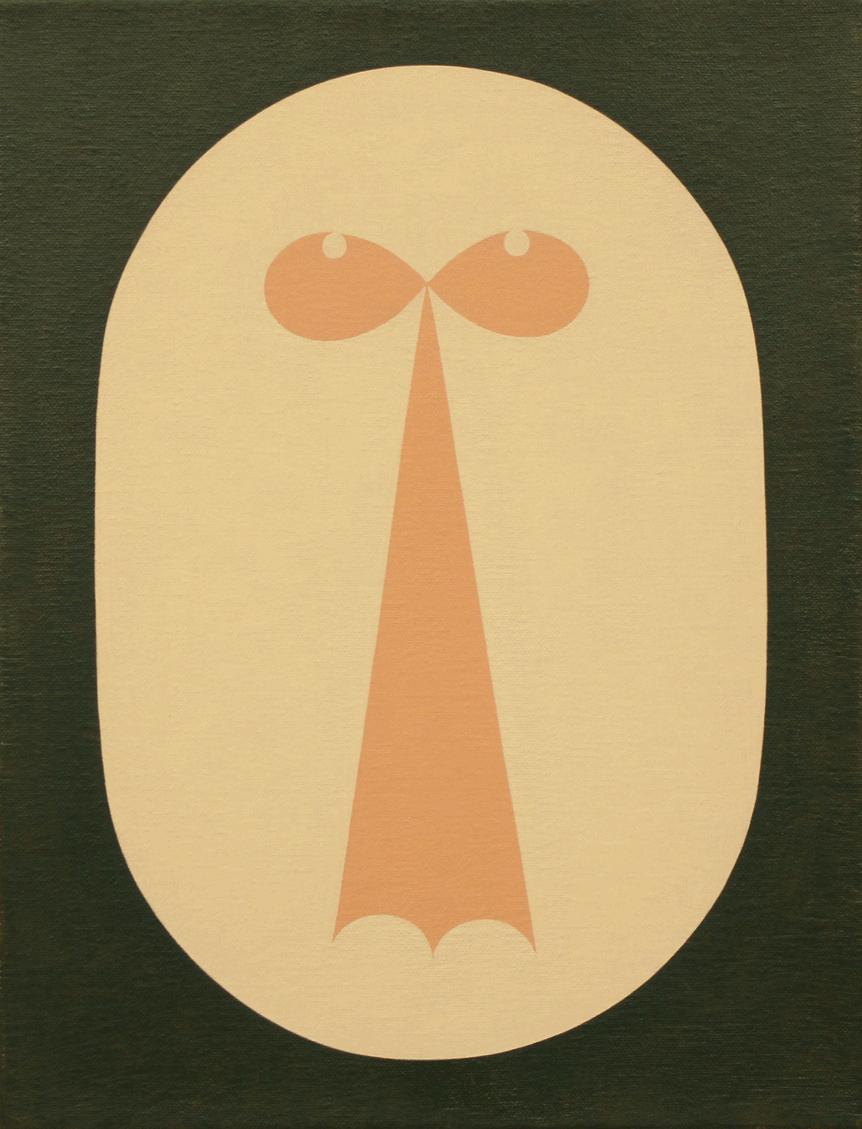
Orkideh Torabi
MFA ‘16
Katsushika Hokusai, the longest living 19th-century Japanese painter and printmaker, was known not only for borrowing from a wide range of disciplines like theater, craft, advertising and differing schools of art, but for often obscuring central narratives, as seen in Self Portrait as Fisherman, 1835 What appears to be a light-hearted caricature of himself as an old man, wellworn from a day of honest work, gives way to an introspective scene of play between natural elements Stray calligraphic lines suspended above the horizon line form a serene flow The fisherman’s smooth face and supple spine lean back in contemplation, crooked knees and bent toes seasoned by worldly burden yet, he smiles with a pipe tucked under the corner of his lip A light blue wash shared between the neck and shoulder of his kimono and the sea hint at the promise of bounty, perhaps wealth in the weight of fish, that can come and go with the tide. Hokusai’s ever-changing wonder and reverence for the forces of nature are palpable in calmness of the breezes that shape destiny.
Orkideh Torabi’s subjects, similarly, never fully explicate their condition. In You Made It! (2021), two male figures speak against an abundant pumpkin patch. The surfaces of their skins share flaming oranges and reds with a fully-ripened pumpkins that throw steep shadows across a valley of verdure landscape. Torabi’s crimsons bleed from a floral drape, spread between the legs of a young peasant, who gazes upward to the counsel of an animated ‘pari’, a folkloric angelic and demonic figure wearing a red tee with plaid breeches The pari’s hands embrace the blush, contemplative young man, his shortened moustache and darkened hair making him identifiable as a jester or despot, curling his left index finger to meet his thumb in an effort to persuade the youth of perhaps an “optimal moment” to harvest Cupping his left knee, the wound man seems dumbfounded, perplexed, as he is surrounded by a simple composition of equidistant fully ripened ‘kadu’ (pumpkin) Torabi binds her characters in a vegetal pattern that function as both narrative and decoration, as the folkloric tale of ‘Kadu Qelqelezan’ comes to mind. Her characters contemplate how to embrace or escape, one ’ s fate on this mortal plane.
~ Pia Singh


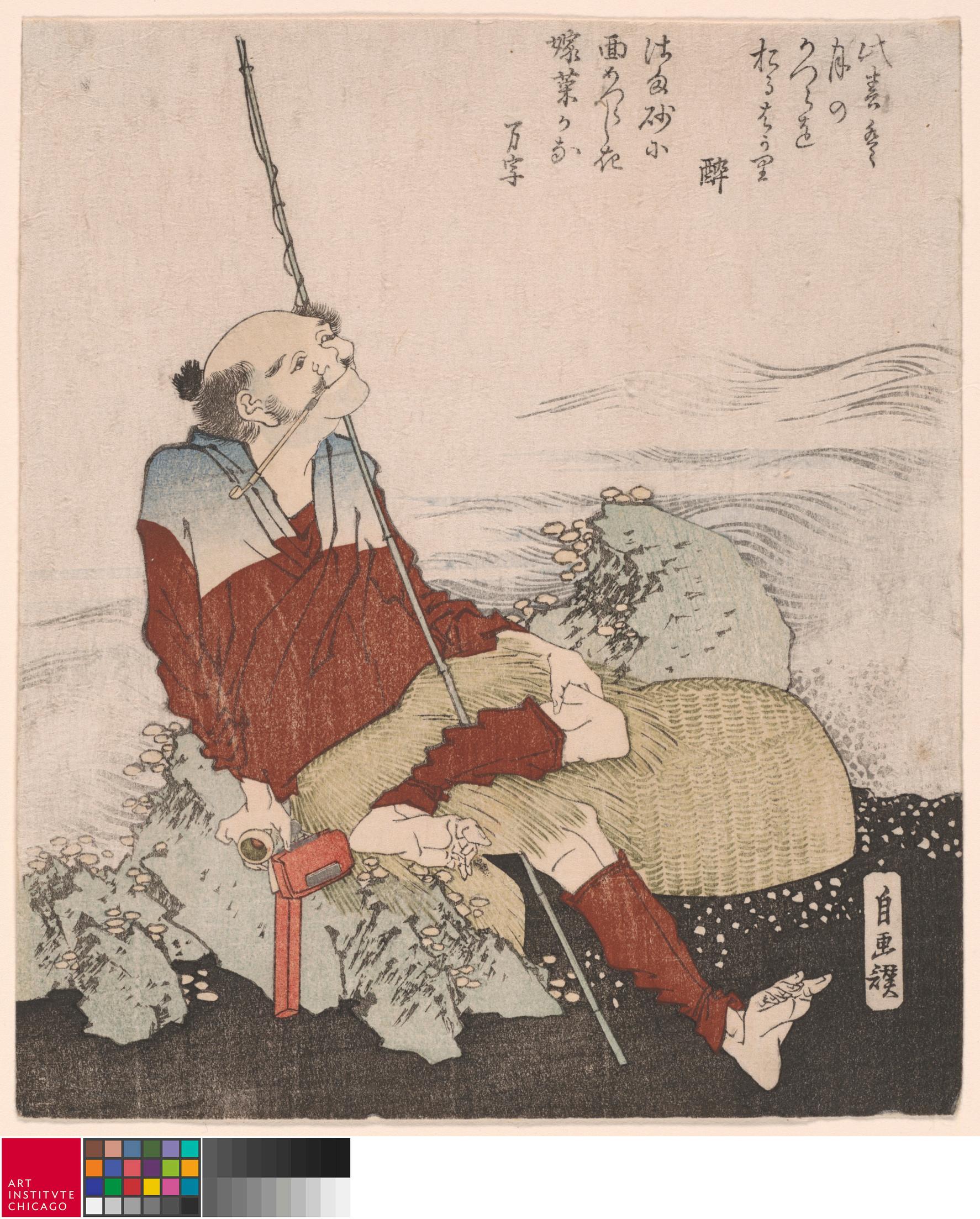
Selection from the Art Institute of Chicago collection: Katsushika Hokusai, Self Portraitas Fisherman, 1835
Pedro
Trueba Ramírez MFA ‘25
The object I chose as a key inspirations for me is the Barcelona Chair (model MR 90), designed in 1929 by Ludwig Mies van der Rohe. I was drawn to this piece because of the many connections I found between this chair, my life, and my current work. Both of my parents studied architecture at UNAM in Mexico City, and Mies van der Rohe was a major reference for them. Growing up, architecture played a significant role in my surroundings, and later, arriving in Chicago, I found myself immersed in his structures the Minerals and Metals Building, IIT Chapel, and the Chicago Federal Center, among others These buildings became part of my everyday life, sometimes blending so seamlessly into my routine that I barely noticed them That sensation of something becoming an essential yet understated part of a space is exactly what I aim for in my own work
When I saw the Barcelona Chair at the Art Institute of Chicago, especially in its striking orange hue, it immediately resonated with me. My work revolves around objects in a room their presence, their purpose, the dynamics they create, and the stories they silently hold. The Barcelona Chair, as a Bauhaus and modernist icon, is still widely produced and, for many, is simply a chair to sit on. Yet, like Mies van der Rohe’s buildings, it does more than just serve a function it integrates, complicates, and enhances the space it inhabits. That is what I strive for in my paintings and installations: to create something that becomes part of a place, subtly altering and expanding the viewer’s everyday experience. And, of course, the AIC’s Barcelona Chair is very orange very much like my paintings.
Being able to visit the Art Institute of Chicago whenever I feel the need to explore, reflect, or even when I’m lost in my own process, has been invaluable While my work is housed within the Painting and Drawing Department, I have always felt drawn to objects and rarities things that exist beyond the canvas The museum, with its vast collection, allows me to wander, discover, and engage in unexpected dialogues between my work and the pieces I encounter More than just a source of influence, the AIC reveals hidden aspects of my own practice things I had not yet articulated or understood
– Pedro Trueba Ramírez
Selection from the Art Institute of Chicago collection: Ludwig Mies van der Rohe, Barcelona Chair (model MR 90), 1929
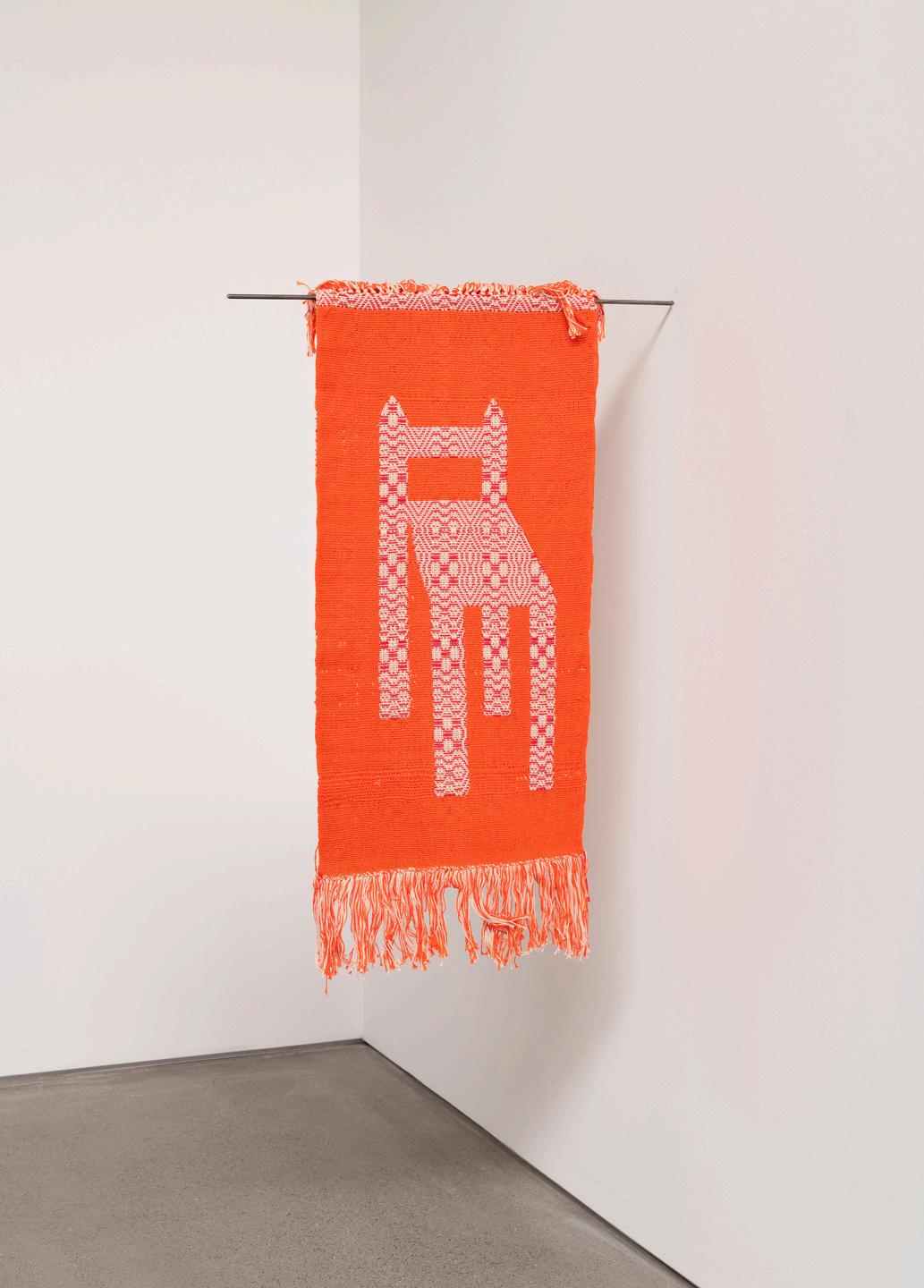

Cody Tumblin
MFA ‘13
I first discovered Bob Thompson’s work at the Art Institute of Chicago. The Descension (1961) was a small, colorful painting framed in dark wood, set in an out-of-the-way corner of the modern wing. I stood with my face inches from the surface for some time, my eyes dancing around the dense tangle of collage-like figures vividly painted in bold, luminous hues. His hand was present in each short, patient brushstroke no flourishes or painterly illusion, just pure color lovingly shaped into human forms with a small brush. It struck me at first as a relatively modest painting, simple in its intention, with a touch of humor and sincere delight. But the longer I looked, the more I felt it held something quietly miraculous This single quiet moment planted in me a lasting devotion to Thompson’s work one that still teaches me
~ Cody Tumblin
Selection from the Art Institute of Chicago collection: Bob Thompson, The Descension, 1961
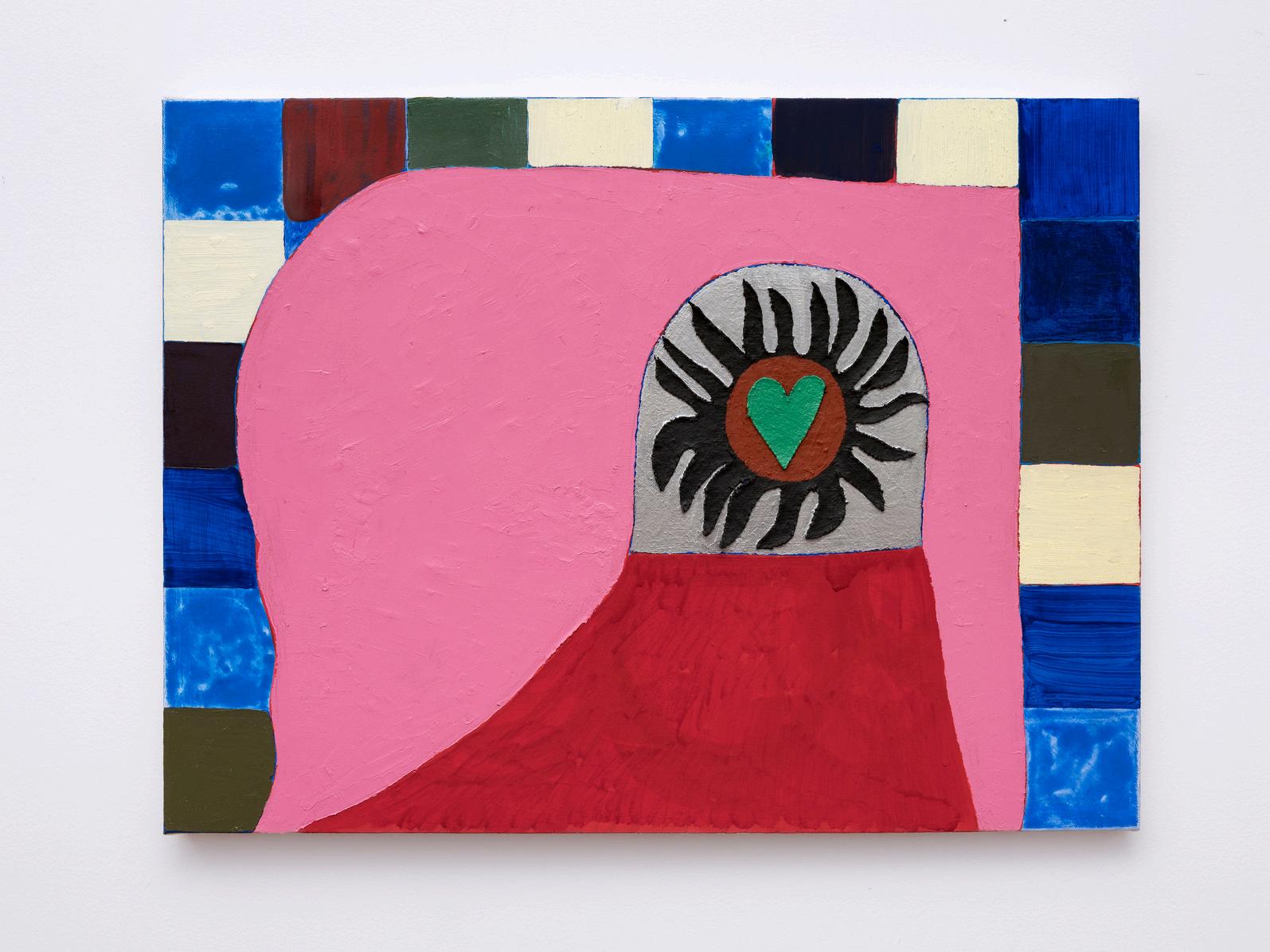
Omar Velázquez
MFA ‘16
In Georgia O’Keeffe’s work, Black Rock with Blue Sky and White Clouds, 1972, a high noon light shines on the rock, casting a dark shadow beneath it. It’s perched on a pedestal, a Western, Doric stand that elevates the mineral world, proves that the natural shape of stone is high art She saw the essential in the abstract forms of nature, the nuance of light, shape, and color The central whitening in the rock might be its spirit, it is womb-shaped Is the light a sign of the rock’s spiritual interior, or is it just a surface reflection?
Omar Velázquez expands the landscape He adds a face, disgruntled, to the classic rock shape The sun slants from the left to right, casting a minor shadow on the stone, but the sun shines golden on the lower rocks. Is the day dawning? The pink clouds seem to say so. The egret points at the rock, seems to demand something of it. The rock is perched precariously, its human face etched with confusion, or perhaps it’s a Taino deity embodied in the mineral. What does the egret say to it? How long until the waterfowl takes flight?
Eileen Favorite
Selection from the Art Institute of Chicago collection: Georgia O’Keeffe, Black Rock with Blue Sky and White Clouds, 1972
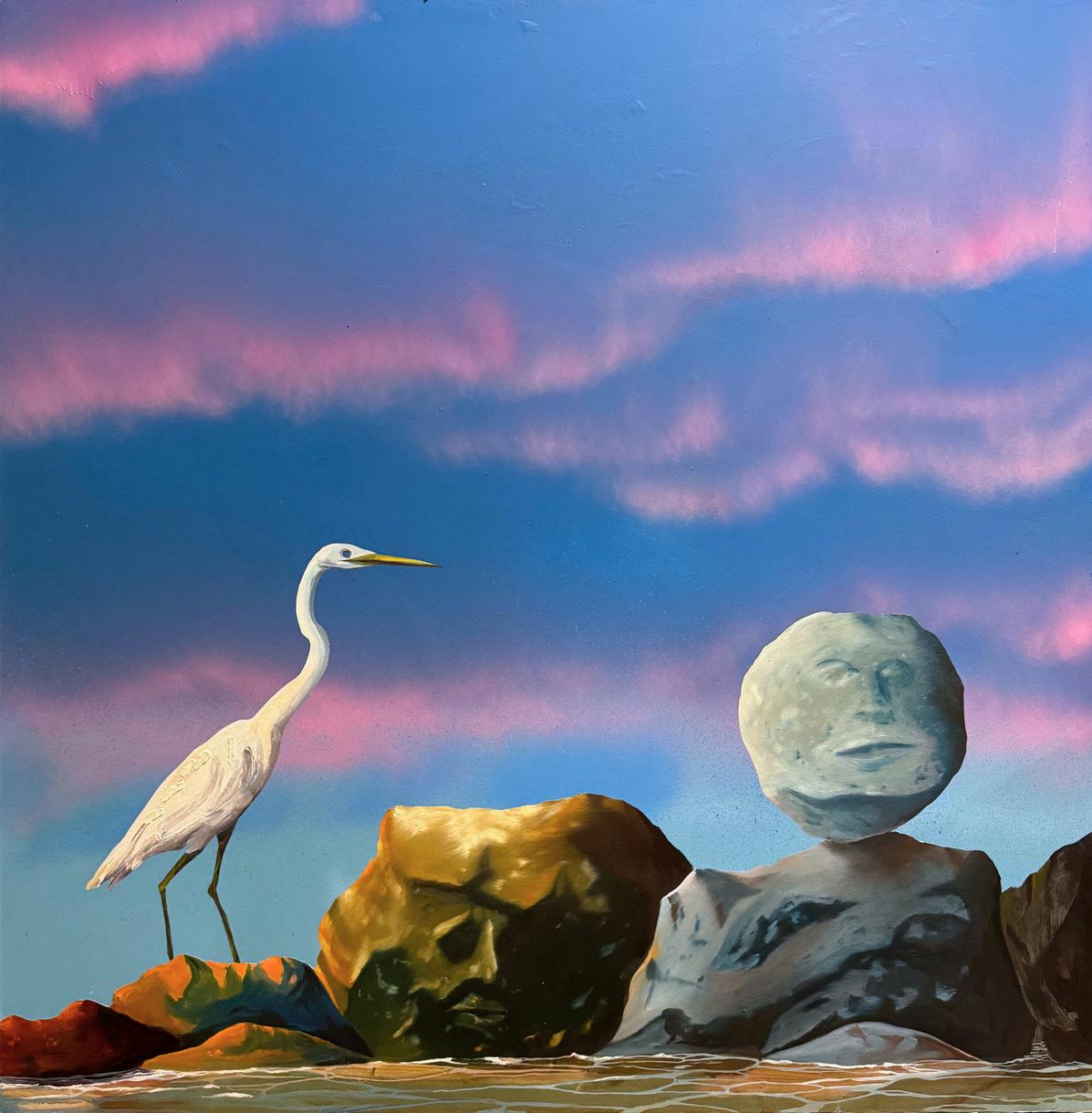
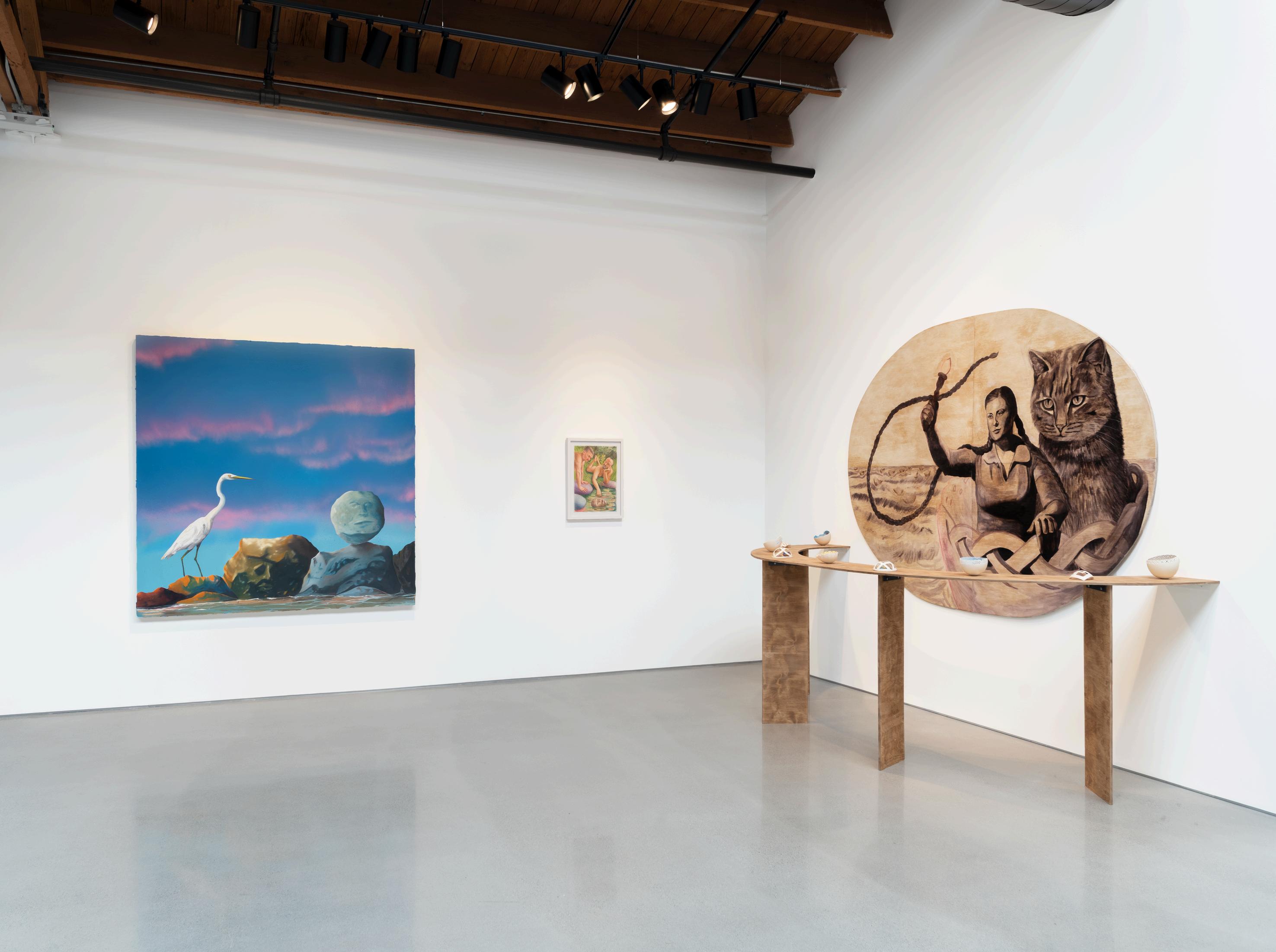


Jonathan Worcester MFA ‘24
Jack Whitten’s paintings always seem to be a transmission from elsewhere, an image that attempts to coalesce through the static. This despite the fact that the resulting canvas appears as such not because of an abiding interest in representation, but as the byproduct of a measured, mechanical process. Nevertheless, Whitten remained well aware of the relation of his paintings to the photographic, and it appears that Jonathan Worcester takes up a similar line of thought. Both painters invest themselves in material processes which bind the trace of an object to the work’s surface, just as the photograph indexes the reflection of light off of its subject at its precise moment of capture. In Khee II (1978), Whitten records the silhouettes of objects placed on the floor beneath the work by pulling a raked tool across the gesso-and-pigment-lined canvas. The tines of the “developer” tool record pitch and shape while releasing pale patches of color to blur across the painting’s face Though Worcester’s process is perhaps more obscured, Ogive (2024) reflects shimmering layers of patterned cerulean and violet dots whose cupped edges suggest the lifting of a mesh-like material Like Whitten, Worcester’s marks give way to the spectral impression of another image as the fields of pattern produce moiré interference Thus, if Whitten captures “photographically” the precise studio moment in which the tool is drawn across the canvas, Worcester records several “photographs” superimposed
What is perhaps most significant, however, is the fact that through their processes, these painters create only pattern: shapes, stripes, and dots. Thus, Whitten and Worcester deftly maneuver the moment when pattern itself coheres into or collapses out of image. Further, what may be photographic about the process capturing a precise indexical trace does not necessitate image: that one may envision an additional, ghost-like coalescence instead points to a latent quality of the image captured within the material.
~ Barbarita Polster
Selection from the Art Institute of Chicago collection: Jack Whitten, Khee II, 1978



Hiejin Yoo
BFA ‘14, Post-Bacc ‘15
Hiejin Yoo’s painting opens outward with urgency A hand parts a dense curtain of greenery to reveal a storm-swept field beyond, where wind bends tall grass beneath a turbulent sky. At the center, an open window anchors the composition, offering a direct yet uneasy threshold between interior and exterior, presence and absence. Yoo’s visual language is highly stylized bold colors, elastic forms, expressive brushwork but what animates the scene is its psychological charge. The gesture of reaching out into the landscape suggests more than curiosity; it reads as a search for clarity in an unstable world. The image oscillates between looking out and being pulled in, staging the moment where perception slips into imagination.
The conceptual influence of Alex Katz’s Yellow House 2 ripples through her canvas. Katz’s work is known for its compositional restraint and atmospheric precision. In Yellow House 2, a central window curtained, closed acts as a quiet focal point, withholding the view beyond His flattened surfaces and spare details create a sense of suspended anticipation, a portal that is present but unreadable
If Katz builds mystery through absence, Yoo responds by making that mystery visible Her painting takes the implied elsewhere of Katz’s scene and floods it with movement, agency, and emotional weather Where Katz resists narrative resolution, Yoo leans into it not to explain, but to extend. In doing so, she transforms the closed portal into an open threshold, inviting the viewer to step across.
Selection from the Art Institute of Chicago collection: Alex Katz, Yellow House 2, 2001



Molly Zuckerman-Hartung MFA ‘07
Dye, silkscreen, spray paint stitched together with an almost diaristic urgency. These sewn fragments, in Hartung’s mixed media work culled from both synthetic and organic textiles enact a kind of embodied realism, one that speaks less to representation than to lived experience. The work resists the distanced gaze; it pulls the viewer close, into a layered and intimate materiality where memory and immediacy converge. Each element feels salvaged, not merely for its visual resonance, but for its physical and emotional weight what Jorge Luis Borges might call an “invisible reality,” one stitched from the irreducible textures of time, loss, and perception.
This radical proximity to life and its artifacts finds an unexpected kinship in Henri Matisse’s Woman before an Aquarium (1921–23) In Matisse’s work, material reality is stylized, distilled through decorative pattern and contemplative stillness into a suggestive and highly modernist flatness The woman's gaze, anchored in the transparency of the fishbowl, gestures toward the inner life of things the quiet yet vivid presence of matter, the confinement and solitude of the self Hartung expands this inquiry, collapsing painterly flatness into a collage of existential intensity. Her approach, thus proposes a subtle flicker where representation can also entail inhabitation, offering a realism forged from immediacy and imperfection.
~ Giovanni Aloi
Selection from the Art Institute of Chicago collection: Henri Matisse, Woman Before an Aquarium, 1921-23
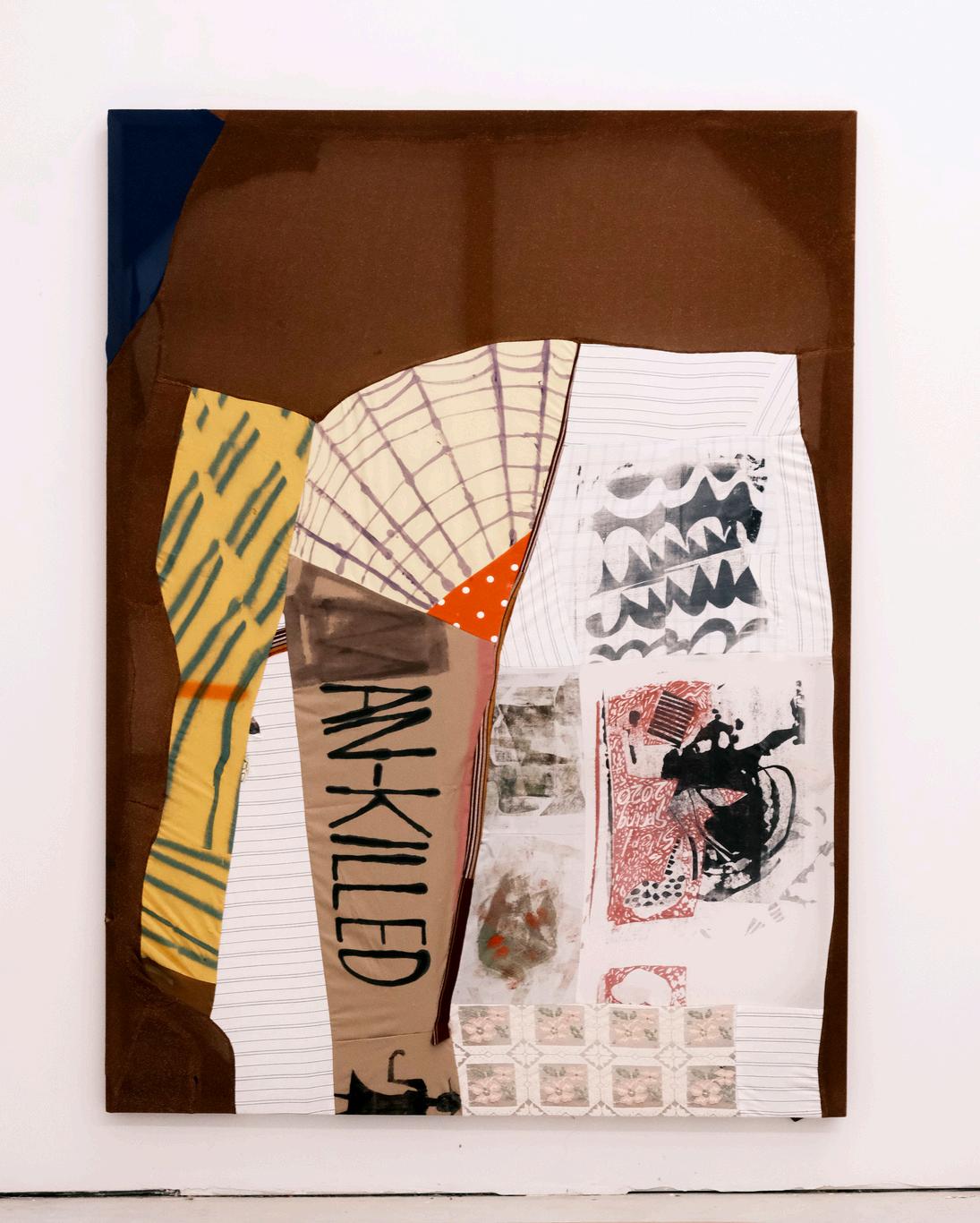
One Lives Several Lifetimes in the Space of an Hour, 2025
Ink, dye, spray paint, silkscreen and oil paint frottage on various textiles, sewn
77 x 58 inches
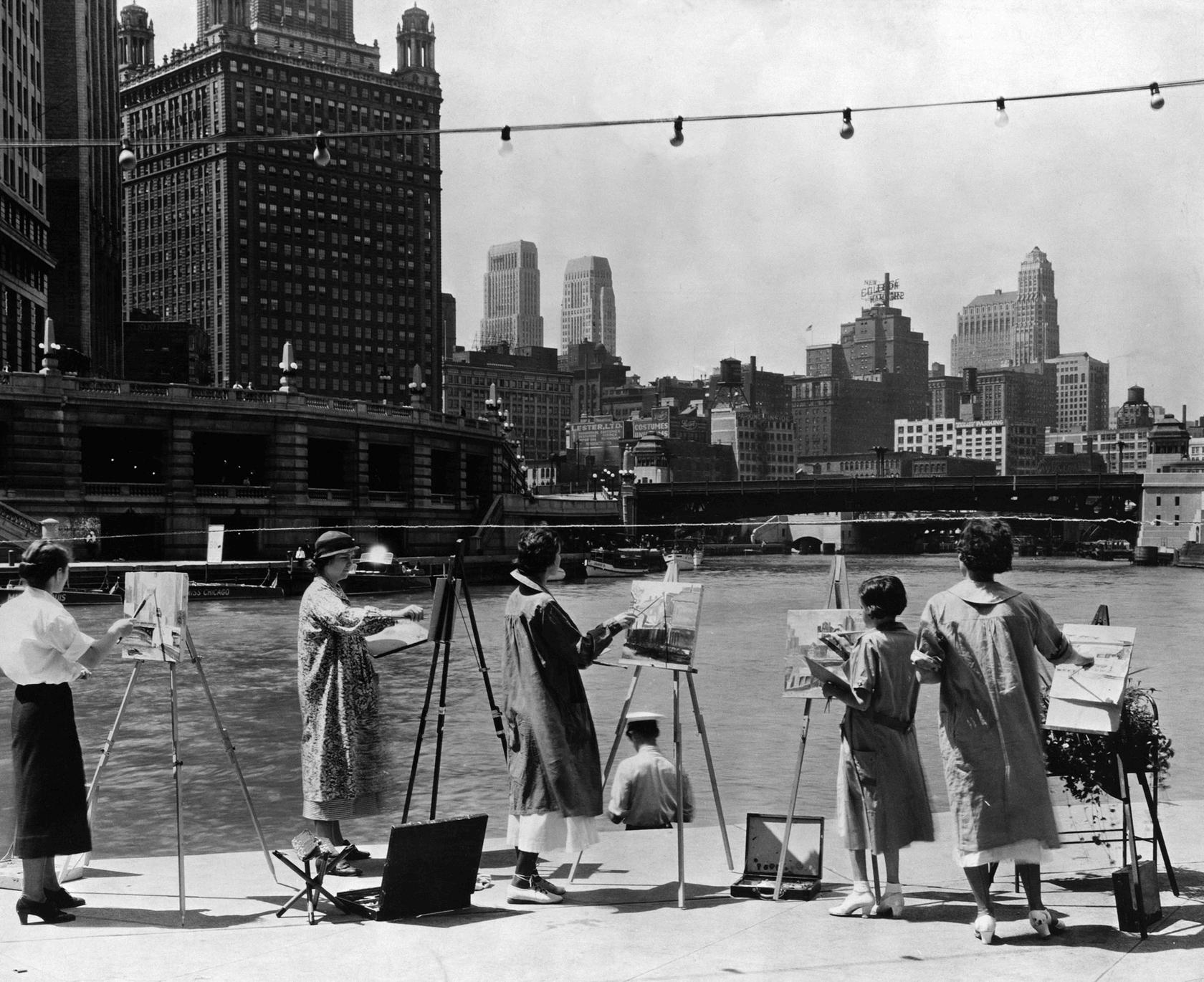

Elissa Tenny is president emerita of the School of the Art Institute of Chicago (SAIC), and the first woman to lead the School She was president from 2016–2024, and provost from 2010–16 Previous to her tenure at SAIC, she was provost and dean at Bennington College in Vermont and served in a variety of roles at The New School in New York City She has served as chair of the board of the Association of Independent Colleges of Art and a member of the Executive Committee of the board of SNAPP (Strategic National Arts Alumni Project). Tenny holds a Doctor of Education from University of Pennsylvania, Master of Arts in Media Studies from The New School, and a Bachelor of Arts in Business Administration from Stockton University
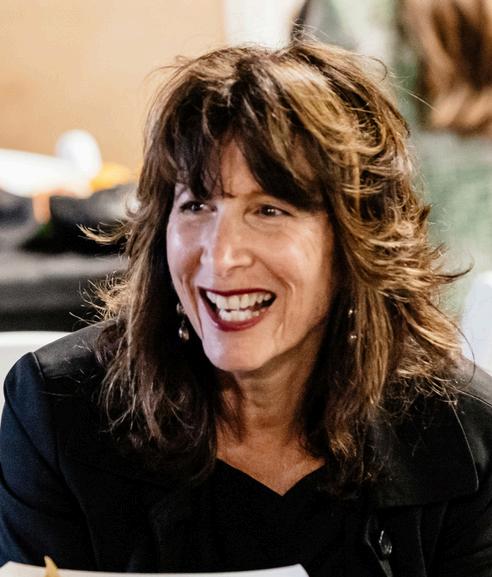
Lisa Wainwright is a professor in the Department of Art History, Theory and Criticism at the School of the Art Institute of Chicago and Dean of Faculty and Vice President of Academic Affairs Emerita Recently, she was appointed Chair of the Painting and Drawing Department Dr Wainwright has authored numerous articles in books and international professional journals, as well as developed an extensive list of exhibition catalogues, and curated multiple exhibitions. She has published and lectured on topics from Robert Rauschenberg and the history of the found object in art, to contemporary art and feminism, as well as on the subjects of education and creativity. Dr. Wainwright received her Bachelor of Arts, cum laude, from Vanderbilt University, and earned both a Masters and a PhD from the University of Illinois
Dr. Giovanni Aloi (he/him) is an author, educator, and curator specializing in the representation of nature and the environment in art He earned a PhD in Natural History and Contemporary Art from Goldsmiths University in London He is the Editor in Chief of Antennae: The Journal of Nature in Visual Culture Aloi is the author of Art & Animals (2011), Speculative Taxidermy: Natural History, Animal Surfaces, and Art in the Anthropocene (2018), Why Look at Plants? The Vegetal Emergence in Contemporary Art (2019), Lucian Freud – Herbarium (2019), and the editor of Posthumanism in Art and Science (2020), Vegetal Entwinements in Philosophy and Art (2023), Estado Vegetal: Performance and Plant Thinking (2023), I’m Not an Artist:ReclaimingCreativityintheAgeof InfiniteContent (2025), Lawn (2025) Aloi has contributed to BBC radio, PBS TV, worked at Whitechapel Art Gallery and Tate Galleries in London, and currently is USA correspondent for Esse Magazine. He has curated exhibitions in the US and Europe and is coeditor of the University of Minnesota Press series ArtafterNature.
Carol Becker is Professor of the Arts and Dean Emerita, Columbia University School of the Arts. Prior to her time at Columbia, she was Dean of Faculty and Senior Vice President for Academic Affairs at the School of the Art Institute of Chicago. She received her PhD in English and American Literature from the University of California, San Diego. She is the author of numerous articles and several books including: The Invisible Drama: Women and the Anxiety of Change; The Subversive Imagination: Artists, Society, and Social Responsibility; Zones of Contention: Essays on Art, Institutions, Gender, and Anxiety; Surpassing the Spectacle: Global Transformations and the Changing Politics of Art; Thinking in Place: Art, Action, and Cultural Production and most recently a memoir/essay entitled Losing Helen She lectures widely and globally and works closely with the World Economic Forum on issues of art, culture and leadership She also serves on their World Arts Forum Foundation Board
Ionit Behar is the Curator at DePaul Art Museum (DPAM), Chicago. Recent exhibitions at DPAM are Selva Aparicio: In Memory Of (2024); Life Cycles: DePaul Art Museum Collection (2023); A Natural Turn: María Berrío, Joiri Minaya, Rosana Paulino, and Kelly Sinnapah Mary (2022); Solo(s): Krista Franklin (2022); Claudia Peña Salinas: Quetzalli (2021) and co-curated LatinXAmerican (2021). Recent independent projects include Del Otro Lado (2023) with BeharXSchachman (a large-scale public art project at O’Hare International); 50 años (50 years since the military coup in Uruguay) (2023) at SUBTE, Montevideo; Nelly Agassi: No Limestone, Nor Marble (2022) at the Chicago Cultural Center. Previously she was the Curator of Collections and Exhibitions at Spertus Institute, Chicago and Research Assistant for the exhibition Hélio Oiticica: To Organize Delirium at the Art Institute of Chicago. Behar holds a Ph D in Art History from the University of Illinois at Chicago, an M A in Art History, Theory, and Criticism from the School of the Art Institute, and a B A in Interdisciplinary Arts from Tel Aviv University
Dr Silvia Beltrametti is Senior Lecturer in the Department of Art History, Theory and Criticism at the School of the Art Institute of Chicago She received a Bachelor of Laws degree from the University of London and her Doctorate in Jurisprudence from the University of Chicago. Her doctoral thesis explores the legal boundaries of the international trade of antiquities. Her areas of
research and teaching include matters related to intellectual property in the creative industry and the intersection of art, the art market, and the law all areas in which she has also published widely The recipient of numerous awards and grants, Dr Beltrametti has served as a Consultant at the UNESCO Cultural Heritage Protection Treaties Section, and has recently joined the International Council of the World Monuments Fund
Jeremy Biles (PhD, University of Chicago) teaches courses on religion, philosophy, and art in the Department of Liberal Arts and the Department of Photography at the School of the Art Institute of Chicago. He is the author of EcceMonstrum:GeorgesBatailleandtheSacrificeof Form; co-editor of Negative Ecstasies: Georges Bataille and the Study of Religion; co-author of The Abyss, or Life Is Simple; an editor at the Religious Studies Review; and a founding member of the International Congress for Infrathin Studies, a group investigating the relations between surrealism and religion.
Steven L. Bridges is a museum director, curator, art historian, and writer based in Lansing, Michigan. Currently he holds the position of Interim Director & Senior Curator and Director of Curatorial Affairs at the Eli and Edythe Broad Art Museum at Michigan State University (MSU Broad Art Museum) His present research and curatorial interests focus on the intersection of social, racial, and environmental justice, as well as the relationship between art, geopolitics, and scientific inquiry Most recently at the MSU Broad Art Museum, Bridges curated the major exhibition COMPLEX DREAMS (2024–25) by artist Esmaa Mohamoud, the inaugural project in the museum ’ s new Signature Commission Series His writing has been published in various publications, including the CSPA Quarterly, Seismopolite, Art & the Public Sphere, Dispatch, Live Arts Almanac, and Art & Education Papers, as well as exhibition catalogues and other online and print media. In 2017 he was named a curatorial fellow at the FACE Foundation.
James Elkins grew up in Ithaca, New York. He earned a BA degree (in English and Art History) from Cornell University. For the last twenty-five years he has lived in Chicago; from the University of Chciago, he got an MFA in painting, and then switched to art history, got another graduate degree, and went on to do the PhD in Art History, which he finished in 1989. Since then, he has been teaching in the Department of Art History, Theory, and Criticism, at the School of the Art Institute of Chicago. Some of his books are exclusively on fine art (WhatPainting Is,WhyAreOurPicturesPuzzles?). Others include scientific and non-art images, writing systems, and archaeology (The Domain of Images, On Pictures and the Words That Fail Them), and some are about natural history (How to Use Your Eyes) Recent books include What Photography Is, written against Roland Barthes’s Camera Lucida; Artists with PhDs, second edition; and ArtCritiques:AGuide, third edition
Eileen Favorite received a 2021 Illinois Arts Council Award for nonfiction Her essay “On Aerial Views” was named a Notable Essay in the Best American Essays 2020, and won First Place in the 2019 Midwest Review’s Great Midwest Writing Contest. Her first novel TheHeroines (Scribner) was named
a Best Debut Novel by The Rocky Mountain News, and has been translated into Finnish, Italian, Russian, Czech, and Korean The audio version was nominated for best recording by the American Library Association Her work has appeared in many publications, including Chicago Magazine, Essay Daily, Fiction Southeast, The Chicago Tribune, Triquarterly, The Rumpus, The Toast, Chicago Reader, Poetry East, and Diagram She's been nominated for a Pushcart Prize for both fiction and nonfiction She has an MFA in Writing from the School of the Art Institute of Chicago, where now teaches, and where she received the Karen and Jim Frank Excellence in Teaching Award in 2020
Michelle Grabner is a Wisconsin-based artist, writer, and curator. She co-curated the 2014 Whitney Biennial and was the Artistic Director for the inaugural 2018 FRONT International: Cleveland Triennial for Contemporary Art. Her practice spans a variety of media including drawing, painting, and sculpture, and finds a creative center in operating across platforms and towards community. Her work has been the subject of several national museum surveys. She is presently represented by James Cohan, New York and Green Gallery, Milwaukee, among others. Grabner is the Crown Family Professor of Art and the Senior Chair of the Painting and Drawing Department at the School of the Art Institute of Chicago where she has taught since 1996. She has also held teaching appointments at The University of Wisconsin-Madison, Cranbrook Academy of Art; Milton Avery Graduate School of Arts Bard College; Yale University School of Art; and the Skowhegan School of Painting and Sculpture, Maine
Brian T. Leahy is an art historian, writer, and assistant professor at Montana State University Billings His current book project traces the historiographic impact of publicity materials on contemporary art in North America and Europe from the late 1960s through the 1980s. He received his PhD from Northwestern University, an MA in Modern and Contemporary Art History, Theory, and Criticism from the School of the Art Institute of Chicago, and a BA in studio art and religious studies from Davidson College.
Margaret MacNamidhe came to SAIC on a Fulbright scholarship; she now teaches in the School (in the Department of Art History, Theory, and Criticism). She has also taught at the University of Chicago, DePaul University, the American University of Paris, and University College Dublin. Her MA and PhD are from the Johns Hopkins University, and her BFA is from NCAD (the National College of Art and Design) A member of Dublin’s Temple Bar Gallery and Studios for many years, her paintings and drawings are in the collections of Joseph Masheck, New York, the Government of Ireland (National Concert Hall, on permanent display), Allied Irish Banks, and the Venté Museum, Tokyo Her specialities (in the painting of 18th and 19th-century France) led to a widely reviewed 2015 book on Delacroix and an innovative essay (in nonsite, 2014) on Rose-Period Picasso Her current research into global pedagogical traditions of drawing and handwriting is fuelled by an interest in the human hand’s capabilities (most recently reflected in a special issue of The Journal of Visual Art Practice that she edited).
Matt Morris is an artist, perfumer, and writer based in Chicago. Morris has presented artwork internationally including Andrew Kreps, Margot Samel, and Tiger Strikes Asteroid, New York; Musée de la Fraise and Ruschman, Berlin, Germany; Netwerk Aalst, Aalst, Belgium; Krabbesholm Højskole, Skive, Denmark; / Slash, San Francisco, ILY2 and Cherry & Lucic, Portland, OR; CA; DePaul Art Museum, Ruschman, LVL3, and Queer Thoughts, Chicago, IL; Mary + Leigh Block Museum of Art, Evanston, IL; Elmhurst Art Museum, Elmhurst, IL; and the Contemporary Arts Center, Cincinnati, OH Morris has contributed to Artforumcom, Art Papers, ARTnews, Flash Art, Fragrantica, Sculpture, The Seen, and X-TRA additional writing appears in numerous exhibition catalogues and artist monographs. Chapters of Morris’ writing are included in the anthologies
Olfactory Art and the Political in an Age of Resistance, Routledge; and Atem / Breath, De Gruyter, with Dr. Dorothée King. Morris is a transplant from southern Louisiana who holds a BFA from the Art Academy of Cincinnati and earned an MFA in Art Theory + Practice from Northwestern University, as well as a Certificate in Gender + Sexuality Studies. Morris is an Adjunct Associate Professor at the School of the Art Institute of Chicago.
Barbarita Polster (b. Cleveland, OH (1987); l. Chicago, IL) is an artist, writer, and current Ph.D. student at Northwestern University (Comparative Literary Studies, affiliation with Dept of Spanish & Portuguese; Graduate Certificate in Critical Theory) Written contributions and publications include Artforum, The Brooklyn Rail, Artspiel, Wrong Life Review, and Shifter She has previously served as faculty at both the School of the Art Institute of Chicago and North Park University, Chicago, IL
Daniel R. Quiles is an art critic as well as an Associate Professor of Art History, Theory and Criticism at the School of the Art Institute of Chicago. His academic research has focused on Argentinean conceptualism as well as broader questions related to new media and politics in Latin American art. He is currently an Associate Professor of Art History, Theory, and Criticism at the School of the Art Institute of Chicago, where he teaches courses on the theory and history of postwar art of the Americas. His research has appeared in academic journals such as Art Journal, Hispanic Research Journal and ARTMargins. He is also an art critic who has written for Artforum, Art in America and Mousse, among other publications. In 2017 he published a book-length conversation with Jaime Davidovich as part of Fundación Cisneros' interview series with Latin American artists.
Allison Peters Quinn is a curator, writer, and administrator committed to facilitating civically-oriented art projects and dynamic conversations on art and culture Her essays and interviews addressing the historical relevance of contemporary artists’ practices have appeared in art anthologies, journals, and catalogs including The United Colors of Robert Earl Paige (2025, University of Minnesota Press), Stockyard Institute: 25 Years of Art and Radical Pedagogy (DePaul Art Museum, 2023), Service Media: Is it Public Art or Art in Public Space (Green Lantern Press, 2013) During her tenure as Director of Exhibition & Residency Programs at Hyde Park Art Center, she organized hundreds of exhibitions and created publications for dozens of emerging and established contemporary Chicago-based artists. She earned a BA at the University of Wisconsin – Madison and a MA at the Center for Curatorial Studies, Bard College
College. Quinn is currently the Executive Director and Chief Curator of the Elmhurst Art Museum.
David Raskin, Ph D , is the Mohn Family Professor of Contemporary Art History at the School of the Art Institute of Chicago, where he teaches art history and ekphrasis Raskin has participated in the Bread Loaf Writers’ Conference and four Kenyon Review Writers Workshops He tells stories about art that integrate the personal moment of encounter and art-historical scholarship He is best known for Donald Judd, a Yale University Press monograph supported by NEH, ACLS, and Wyeth Foundation for American Art fellowships He has also contributed to exhibition catalogs from the Tate Modern (London), Moderna Museet (Stockholm), MCA-Chicago, Ludwig Museum (Köln), Stedelijk Museum (Amsterdam), and Ca’ Pesaro (Venice). He is a past Editor-in-Chief of caareviews.org, a publication of record of the College Art Association. His creative writing has appeared in The Pinch, Air/Light, and JMWW.
Patrick Lynn Rivers is a political scientist and professor at the School of the Art Institute of Chicago who, along with Kai Wood Mah, co-directs the design research practice a.field (www.afield.ca). Rivers is the author of Governing HateandRaceintheUnitedStatesandSouthAfricaandSituatedPracticesin Architecture and Politics (with Mah) as well as numerous peer-reviewed articles appearing in diverse journals like Critical Studies in Media Communication, the Journal of Film and Video, the South African Law Journal, Space and Culture (with Mah), Interventions: International Journal of Postcolonial Studies (with Mah), and the Journalof ArchitecturalEducation (with Mah)
Pia Singh is an independent curator and writer in Chicago, IL Born in Bombay, India, where she has served as the Associate Director of Volte Gallery, Singh’s focus on durational practices informs her repertoire as an arts consultant to South Asian 501(c)3 organizations in Chicago. As an independent curator, she has organized solo and group exhibitions at Heaven Gallery, Julius Caesar, Aspect/Ratio (Engage Projects), Ads Donna, and Northeastern Illinois University Art Gallery. She is currently working on a two-person presentation at NONSTNDRD, in Sauget IL. Singh’s academic research centers community engaged arts practices at the intersection of contemporary art and design thinking, challenging structural and pedagogical hierarchies within and outside of which artists forge pathways toward systemic change. As a Kurtich scholar and SAAS-FEE Curatorial resident, she has spent time in Berlin furthering her research on the field. She also serves as a visiting critic and curator for several academic programs across the Midwest. Her writing has been published by Sixty Inches from Center, Chicago Reader, NewCity, Brooklyn Rail, Tussle Magazine, Hyperallergic, Cultured Magazine, ArtIndia, and Frieze, alongside other regional publications
Mechtild Widrich is Department Chair of Art History, Theory, and Criticism at the School of the Art Institute of Chicago She works on the intersection of contemporary art and architecture: she researches and teaches on art in public space and the question of the public sphere, on performance art and its mediation, and on aesthetic theory. Widrich earned a Master in Philosophy from the Art History Institute at University of Vienna, and a PhD from the Department of Architecture, Massachusetts
Massachusetts Institute of Technology. She held positions at the University of Basel, the ETH Zurich and at the Universities of Vienna and Zurich, before joining SAIC in 2015 Additionally, she is an Affiliate Scholar at the Nanovic Institute for European Studies at the University of Notre Dame for 2023-25 Received awards include: 2022-23 University of Notre Dame Institute for Advanced Study; 2018 University of Chicago Hong Kong Center; 2018 SAIC Literary Lions Award for Art Historical Research; 2016 NTU Centre for Contemporary Art Singapore She is a recipient of fellowships from the Charlotte Newcombe Foundation, the Max-Planck Institute for the History of Science, the Fulbright Foundation, and several fellowships from MIT
Francesca Wilmott, currently Curator at the Crocker Art Museum in Sacramento, CA, earned her Ph.D. at The Courtauld Institute of Art in London, where her dissertation, Far Out California: A New Regionalism (1966–1976), focused on artists Stephen Kaltenbach, Gladys Nilsson, and Mike Henderson. Wilmott previously held curatorial positions at the Manetti Shrem Museum of Art at the University of California, Davis and The Museum of Modern Art, New York. Her writing has appeared in Artforum, A World History of Women Photographers (Thames & Hudson, 2022), and Yoko Ono: One Woman Show (MoMA, 2015), among other publications. She holds a dual M.A. in Modern Art History, Theory, and Criticism and Arts Administration and Policy from the School of the Art Institute of Chicago
John Yau is a poet, fiction writer, art critic, and publisher of Black Square Editions, a press devoted to poetry, fiction, essays, translations, and artist’s books His collaborations with artists were the subject of a traveling exhibition, Disguise the Limits, organized by Stuart Horodner for the University of Kentucky Art Museum. Diary of Small Discontents: New & Selected Poems 1974-2024 is forthcoming from Omnidawn Press. He has written monographs on Catherine Murphy, Thomas Nozkowski, Liu Xiaodong, A. R. Penck, Jasper Johns, and Philip Taaffe. His book of essays, Please Wait by the Coat Room: Reconsidering Race and Identity (2023), received an American Book Award. He has received the Jackson Prize for Poetry and the Rabkin Award for his criticism. He writes regularly for the online magazine Hyperallergic and lives in Beacon, New York
Acknowledgements
Secrist | Beach extends heartfelt thanks to the many enthusiastic collaborators who contributed to the realization of this ambitious, wide-ranging exhibition.
As we close out the inaugural year of our reimagined gallery program, Master Class stands as a powerful reflection of our mission: to cultivate meaningful partnerships and to craft an engaging experience that serves as proof that it is possible to infuse the imperatives of a commercial gallery with the spirit of a Kunsthalle.
The curatorial framework pairing nearly seventy contemporary artists with their historical counterparts from the collection of the School of the Art Institute of Chicago illuminates the enduring relationship between the museum and the school, and the essential role historical works play in shaping the trajectory of contemporary art practice
In collaboration with our guest curators and the broader Chicago arts community, we were proud to expand the reach of this exhibition through thoughtful programming; these efforts underscore our post-pandemic commitment to connectedness, community, and the irreplaceable experience of engaging with visual art in-person
Among many, we’d like to especially thank our guest curators, Lisa Wainwright and Elissa Tenny, along with each of the participating artists as well as their galleries: Baldwin Gallery, Nicelle Beauchene Gallery, Blum Gallery, Corbett vs. Dempsey, Exhibit 320, Frestonian Gallery, François Ghebaly, Half Gallery, Hauser & Wirth, Nina Johnson, Anton Kern Gallery, M. LeBlanc, Monique Meloche Gallery, Morán Morán, PATRON Gallery, Povos Gallery, Andrew Rafacz, Roberts Projects, Jessica Silverman, Twelve Ten Gallery, Vielmetter Los Angeles, Western Exhibitions, and Zolla Lieberman.
Thank you to our guest essayists for their thoughtful insights on the connection between artists spanning the centuries: Lisa Wainwright (“Home Court Advantage”) and Michelle Grabner (“Work”), Dr Giovanni Aloi, Carol Becker, Ionit Behar, Dr Silvia Beltrametti, Jeremy Biles, Steven L Bridges, Romi Crawford, James Elkins, Eileen Favorite, Brian T Leahy, Margaret MacNamidhe, Matt Morris, Barbarita Polster, Daniel R Quiles, Allison Peters Quinn, David Raskin, Patrick Lynn Rivers, Pia Singh, Mechtild Widrich, Francesca Wilmott, and John Yau
The School of the Art Institute of Chicago by Thomas C Buechele and Nicholas C Lowe served as a valuable reference and source of archival images during the development of this exhibition. We are grateful to the School of the Art Institute of Chicago for their generous access to archival materials, and to the Art Institute of Chicago for the use of public domain works from their permanent collection. These historical images enriched the exhibition and catalogue to underscore the enduring dialogue between past and present in the Chicago art community.
